The Lost Caverns of Ixalan Release Notes
The Release Notes include information concerning the release of a new Magic: The Gathering set, as well as a collection of clarifications and rulings involving that set's cards. It's intended to make playing with the new cards more fun by clearing up the common misconceptions and confusion inevitably caused by new mechanics and interactions. As future sets are released, updates to the Magic rules may cause some of this information to become outdated. Go to Magic.Wizards.com/Rules to find the most up-to-date rules.
The "General Notes" section includes information about card legality and explains some of the mechanics and concepts in the set.
The "Card-Specific Notes" sections contain answers to the most important, most common, and most confusing questions players might ask about cards in the set. Items in the "Card-Specific Notes" sections include full card text for your reference. Not all cards in the set are listed.
GENERAL NOTES
Card Legality
The Lost Caverns of Ixalan cards with the LCI set code are permitted in the Standard, Pioneer, and Modern formats, as well as in Commander and other formats. At release, the following card sets will be permitted in the Standard format: Innistrad: Midnight Hunt, Innistrad: Crimson Vow, Kamigawa: Neon Dynasty, Streets of New Capenna, Dominaria United, The Brothers' War, Phyrexia: All Will Be One, March of the Machine, March of the Machine: The Aftermath, Wilds of Eldraine, and The Lost Caverns of Ixalan.
New The Lost Caverns of Ixalan Commander cards with the LCC set code are permitted in the Commander, Legacy, and Vintage formats.
The Treasure Trove is a 20-card supplemental mini-set found within Draft Booster and Set Booster displays. These twenty artifacts are returning fan favorites and have the set code LCC.
Special Guests cards are previously printed cards from a variety of backgrounds visiting the set. You never know who or what will make an appearance! There are 18 Special Guests cards in The Lost Caverns of Ixalan. They have the set code SPG.
Treasure Trove cards, Special Guests cards, and Commander cards with set code LCC that have been previously printed continue to be legal in formats they were previously legal in. That is, they are legal in any format wherein a card with the same name is permitted.
New cards from the Jurassic World™ Collection with set code REX are permitted in the Commander, Legacy, and Vintage formats. They are not permitted in the Standard, Pioneer, or Modern formats.
Go to Magic.Wizards.com/Formats for a complete list of formats and their permitted card sets and banned lists.
Go to Magic.Wizards.com/Commander for more information on the Commander variant.
Go to Locator.Wizards.com to find an event or store near you.
New Keyword Ability: Craft
Returning Mechanic: Transforming Double-Faced Cards
There are plenty of treasures (not to be confused with Treasures) in Ixalan's network of underground caves, but just like Ixalan itself, many of these treasures are more than they seem on the surface. With the right materials, innocuous discoveries can be turned into powerful artifacts. You won't have to do years of research to figure out which materials to use; the craft keyword will give you the recipes you need!
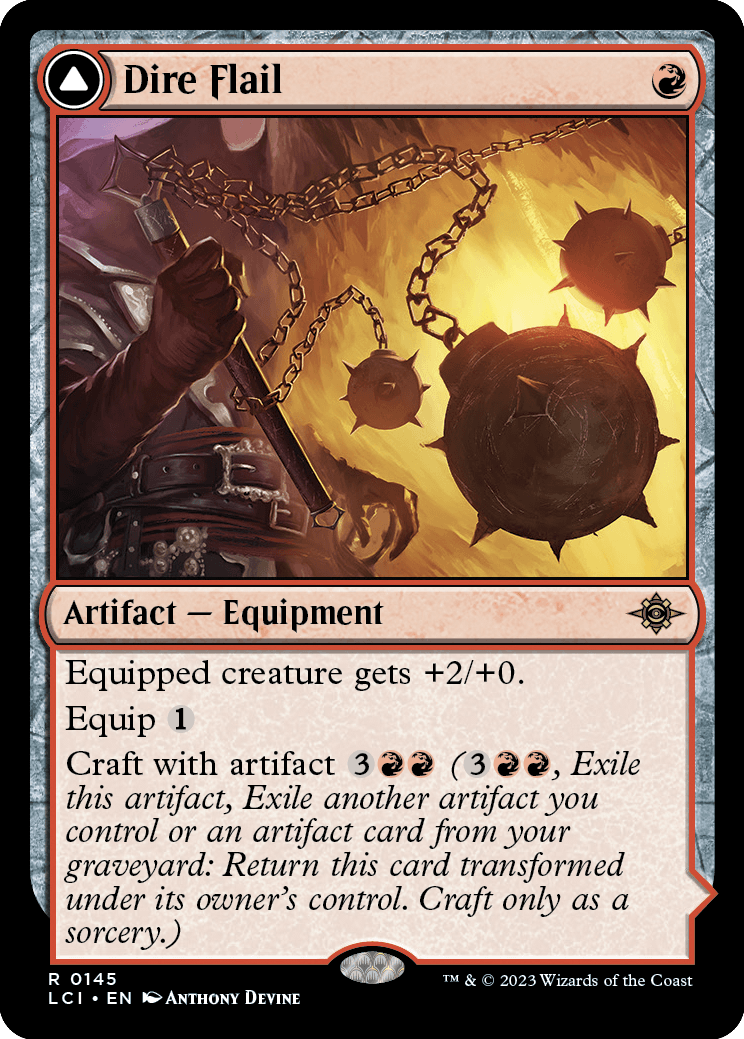
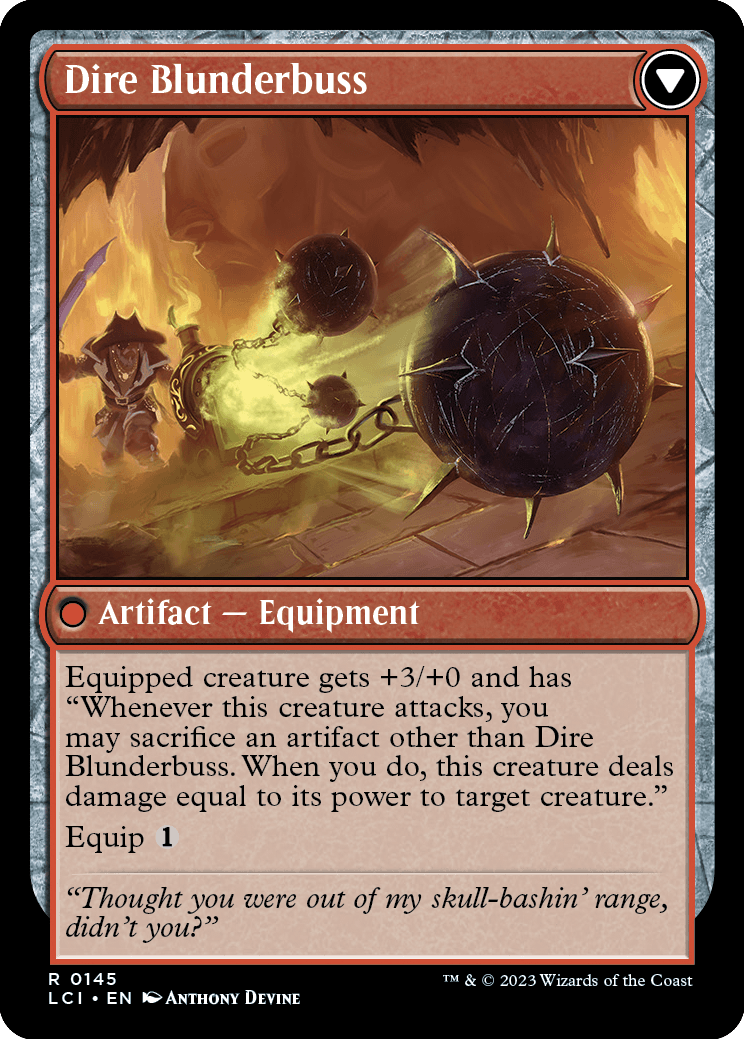
Dire Flail
Artifact — Equipment
Equipped creature gets +2/+0.
Equip
Craft with artifact (, Exile this artifact, Exile another artifact you control or an artifact card from your graveyard: Return this card transformed under its owner's control. Craft only as a sorcery.)
////
Dire Blunderbuss
Artifact — Equipment
Equipped creature gets +3/+0 and has "Whenever this creature attacks, you may sacrifice an artifact other than Dire Blunderbuss. When you do, this creature deals damage equal to its power to target creature."
Equip
- Craft abilities are activated abilities with costs that have a mana component as well as an additional "materials" component.
- Craft abilities are written "Craft with [materials] [mana]", which means "[Mana], Exile this permanent, Exile [materials] from among permanents you control and/or cards in your graveyard: Return this card to the battlefield transformed under its owner's control. Activate only as a sorcery."
- The back faces of some cards with craft refer to cards "used to craft" it. This refers to the cards exiled as part of the cost of the craft ability of the front face. Those cards are considered to be "used to craft" that permanent as long as they remain exiled and the permanent remains on the battlefield, even if the permanent's controller changes or some of its characteristics change (because of a copy effect, for example.)
- If the materials required include multiple objects, you may exile some of them from among permanents you control and the rest from among cards in your graveyard. You don't have to choose all permanents or all cards from your graveyard.
- You may exile tokens you control as part of the materials required. However, because they aren't cards and won't stay in exile, any abilities that refer to what you "used to craft" the back faces won't refer to anything.
- If a card that isn't a transforming double-faced card becomes a copy of a card with craft, it'll stay in exile if you activate the craft ability. It won't return to the battlefield.
Double-faced cards haven't changed since the last time we saw them. Here is some more info:
- Each face of a transforming double-faced card has its own set of characteristics: name, types, subtypes, abilities, and so on. While a transforming double-faced permanent is on the battlefield, consider only the characteristics of the face that's currently up. The other set of characteristics is ignored.
- Each transforming double-faced card in this set is cast face up. In every zone other than the battlefield, consider only the characteristics of its front face. If it is on the battlefield, consider only the characteristics of the face that's up; the other face's characteristics are ignored.
- The mana value of a transforming double-faced card is the mana value of its front face, no matter which face is up.
- The back face of a transforming double-faced card usually has a color indicator that defines its color. Colorless back faces, such as lands, do not.
- A transforming double-faced card enters the battlefield with its front face up by default, unless a spell or ability instructs you to put it onto the battlefield transformed or you cast it transformed, in which case it enters with its back face up.
- If you are instructed to put a card that isn't a double-faced card onto the battlefield transformed, it will not enter the battlefield at all. In that case, it stays in the zone it was previously in. For example, if a single-faced card is a copy of Dire Flail, exiling it as part of the cost of its craft ability will cause it to remain in exile.
New Keyword Action: Discover
Discovery is an exciting pursuit. You never know what you'll find! Well, you might know, actually, because the discover keyword action allows you to dig into your library and cast something for free.
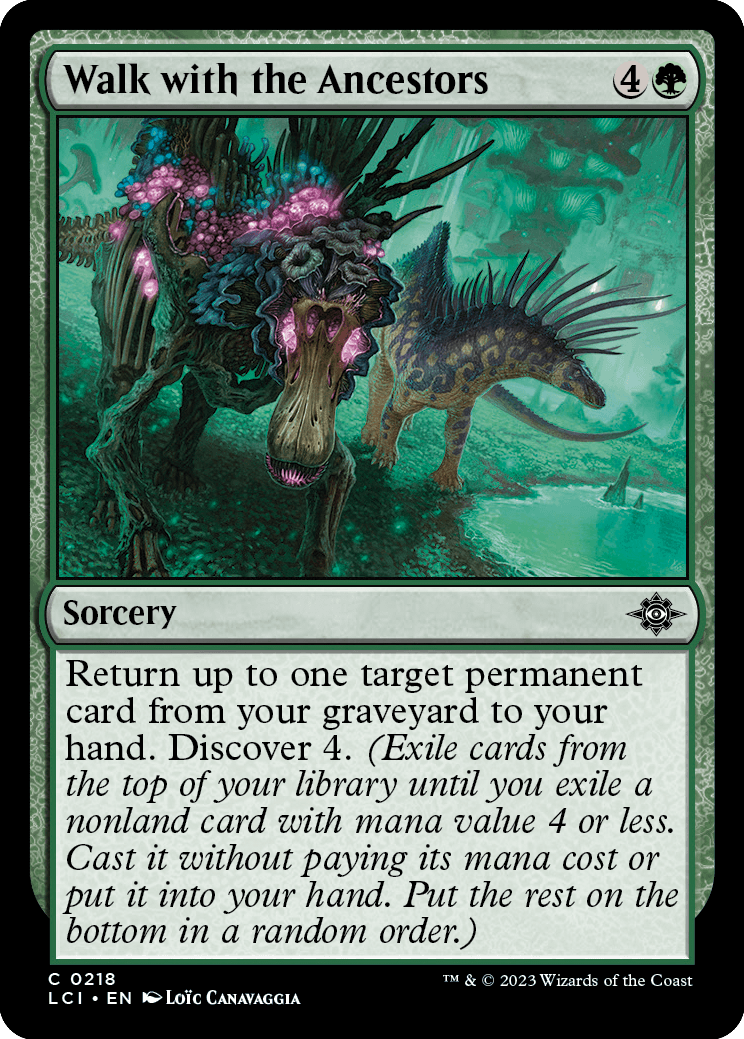
Walk with the Ancestors
Sorcery
Return up to one target permanent card from your graveyard to your hand. Discover 4. (Exile cards from the top of your library until you exile a nonland card with mana value 4 or less. Cast it without paying its mana cost or put it into your hand. Put the rest on the bottom in a random order.)
- "Discover N" means "Exile cards from the top of your library until you exile a nonland card with mana value N or less. That card is the "discovered" card. You may cast that card without paying its mana cost if the resulting spell's mana value is less than or equal to N. If you don't cast it, put that card into your hand. Put the remaining exiled cards on the bottom of your library in a random order."
- A spell's mana value is determined only by its mana cost. Ignore any alternative costs, additional costs, cost increases, or cost reductions.
- When you discover, you must exile cards. The only optional part of the ability is whether you cast the exiled card or put it into your hand.
- You exile the cards face up. All players will be able to see them.
- If you cast a spell "without paying its mana cost", you can't choose to cast it for any alternative costs. You can, however, pay additional costs. If the spell has any mandatory additional costs, you must pay those to cast it.
- If the discovered card has in its mana cost, you must choose 0 as the value of X when casting it without paying its mana cost.
- If you can't cast the discovered card (perhaps because there are no legal targets for the spell), you'll put it into your hand.
- Some spells and abilities that cause you to discover may require targets. If each target chosen is an illegal target as that spell or ability tries to resolve, it won't resolve and you won't discover.
- The mana value of a split card is determined by the combined mana cost of its two halves. If discover allows you to cast a split card, you may cast either half (as long as its mana value is less than or equal to the effect's discover value) but not both halves.
- If you discover an adventurer card, split card, or modal double-faced card, you might be able to cast that card with either set of characteristics depending on the effect's discover value. For example, if you discover 4 and reveal Galvanic Giant (an adventurer card from Wilds of Eldraine with a mana value of 4), you could cast Galvanic Giant, but not Storm Reading (its Adventure, which has a mana value of 7). If you discover 7 and reveal Galvanic Giant, you could cast either Galvanic Giant or Storm Reading.
New Ability Word: Descend N / Fathomless Descent
New Mechanic: Descended
The deeper you go into the caves under Ixalan's surface, the more exciting the finds will be. Of course, the further you descend, the more dangerous things become. Descend is a new rules term that refers to times that a permanent card is put into your graveyard from anywhere.
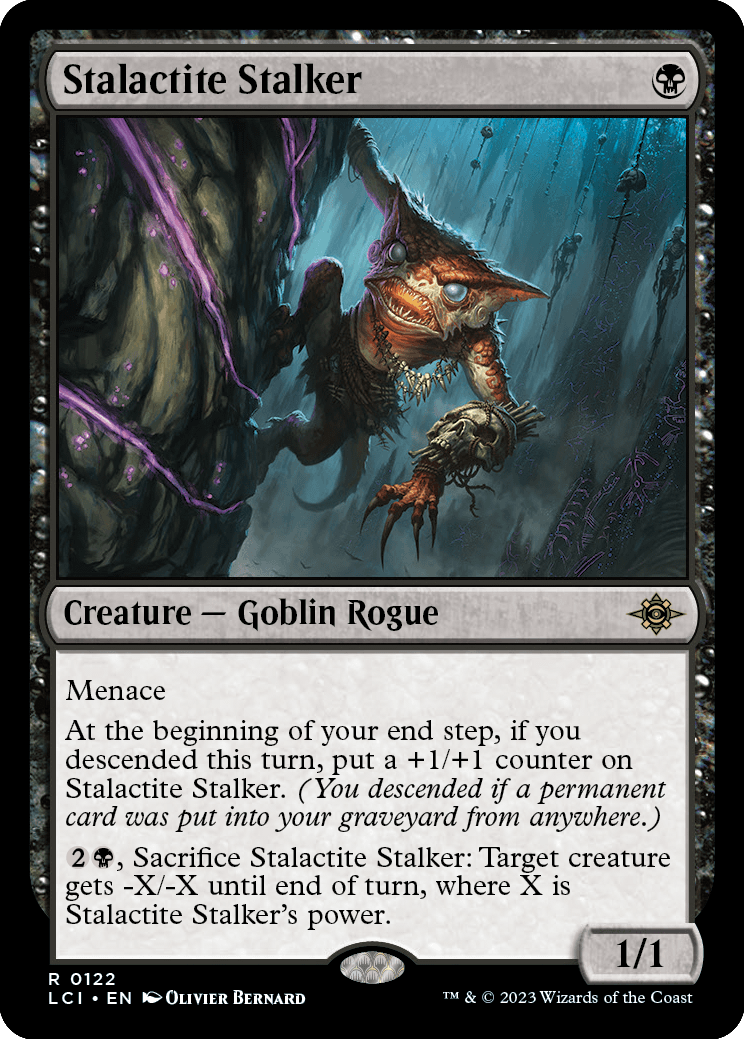
Stalactite Stalker
Creature — Goblin Rogue
1/1
Menace
At the beginning of your end step, if you descended this turn, put a +1/+1 counter on Stalactite Stalker. (You descended if a permanent card was put into your graveyard from anywhere.)
, Sacrifice Stalactite Stalker: Target creature gets -X/-X until end of turn, where X is Stalactite Stalker's power.
- Some cards refer to a player who has "descended this turn." This means that a permanent card has been put into that player's graveyard from anywhere this turn.
- Some cards refer to the number of times a player descended this turn. Those cards care about the number of permanent cards put into that player's graveyard from anywhere this turn.
- In either case, it doesn't matter if those cards are still in that player's graveyard.
- A permanent card is an artifact, battle, creature, enchantment, land, or planeswalker card. Tokens are not cards, and while tokens are put into the graveyard before ceasing to exist, that action doesn't count as a player having descended.
- Multiple cards have abilities that begin with "At the beginning of your end step, if you descended this turn." These cards don't need to have been under your control at the time you descended. For example, if a permanent card is put into your graveyard during your first main phase and you cast Stalactite Stalker your second main phase, its ability will trigger at the beginning of your end step.
- Abilities that begin with "At the beginning of your end step, if you descended this turn" will trigger only once during your end step, no matter how many times you descended this turn. However, if you haven't descended this turn as your end step begins, the ability won't trigger at all. It's not possible to put a permanent card into your graveyard during the end step in time to have the ability trigger.
Descend N and fathomless descent are ability words used to highlight abilities that care about how many permanent cards are in your graveyard at any given moment, no matter when they were put there.
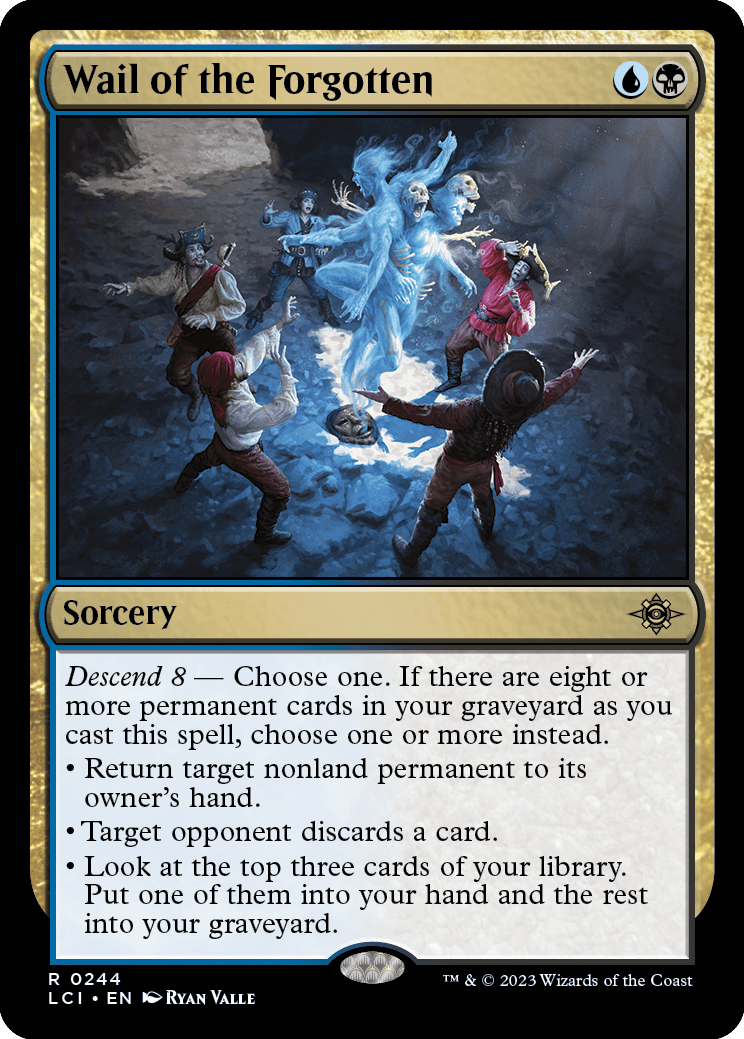
Wail of the Forgotten
Sorcery
Descend 8 — Choose one. If there are eight or more permanent cards in your graveyard as you cast this spell, choose one or more instead.
• Return target nonland permanent to its owner's hand.
• Target opponent discards a card.
• Look at the top three cards of your library. Put one of them into your hand and the rest into your graveyard.
- Cards with the ability word "descend N" have abilities that care if you have at least N permanent cards in your graveyard.
- Cards with the ability word "fathomless descent" have abilities that care how many permanent cards are in your graveyard.
- Some descend triggered abilities include intervening "if" clauses (i.e. "if you have [four or eight] permanent cards in your graveyard" in the middle of the ability). Each of these abilities checks your graveyard at the moment it would trigger to see if it does. If you don't have the required number of permanent cards in your graveyard at that time, the ability doesn't trigger at all. If it does trigger, it will check again as it tries to resolve. If you don't have the required number of permanent cards in your graveyard at that time, the ability won't resolve and none of its effects will happen.
Returning Keyword Action: Explore
The explore keyword first appeared in Ixalan, and while we saw the surface of the world in that set, it's time to explore a whole new biome.
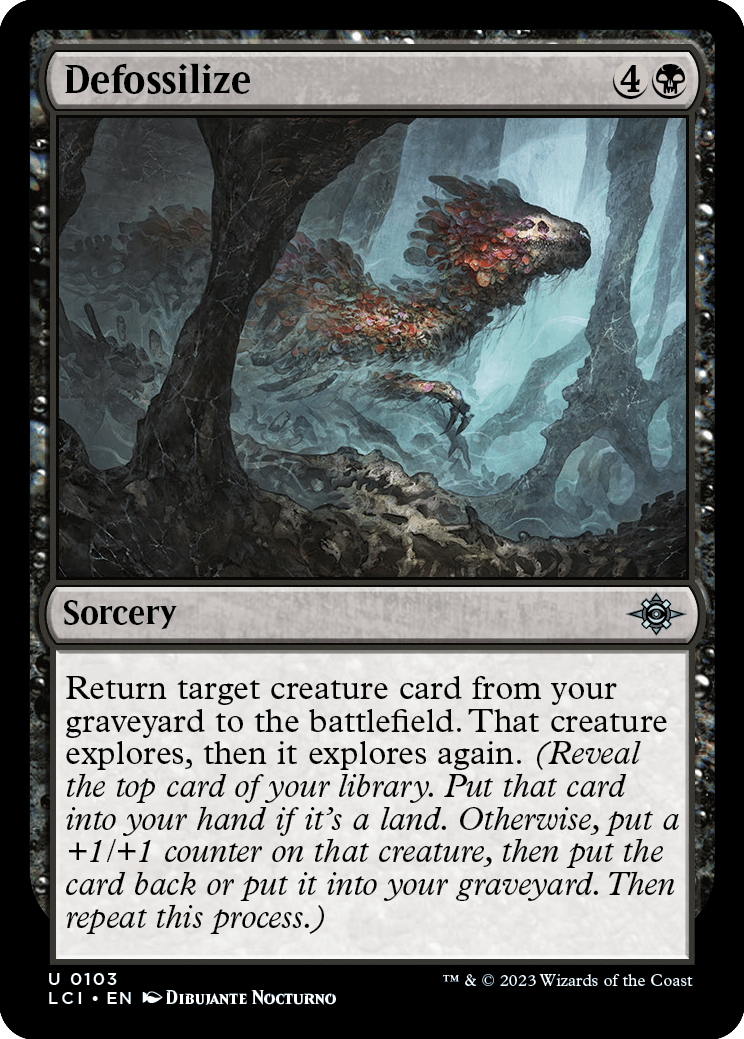
Defossilize
Sorcery
Return target creature card from your graveyard to the battlefield. That creature explores, then it explores again. (Reveal the top card of your library. Put that card into your hand if it's a land. Otherwise, put a +1/+1 counter on that creature, then put the card back or put it into your graveyard. Then repeat this process.)
- If an ability instructs a creature to explore, its controller reveals the top card of their library. If it's a land card, they'll put it into their hand. Otherwise, they'll put a +1/+1 counter on that creature, then choose to either leave that card on top of their library or put it into their graveyard.
- Once an ability that causes a creature to explore begins to resolve, no player may take any other actions until it's done. Notably, opponents can't try to remove the exploring creature after you reveal a nonland card but before it receives a counter.
- If no card is revealed, most likely because that player's library is empty, the exploring creature receives a +1/+1 counter.
- If a resolving spell or ability instructs a specific creature to explore but that creature has left the battlefield, the creature still explores. If you reveal a nonland card this way, you won't put a +1/+1 counter on anything, but you may put the revealed card into your graveyard. Effects that trigger "whenever a creature explores" trigger as appropriate.
- Some spells or abilities might cause a creature to explore multiple times in a row. If you reveal a nonland card when a creature explores and leave it on top of your library, then the creature explores again immediately afterwards, you'll reveal the same card again.
- In some unusual cases, noncreature permanents may explore. For example, if the creature card returned by Defossilize is somehow not a creature once it's on the battlefield, it can still explore. You'll take all the same actions, and you may end up putting a +1/+1 counter on the permanent. (Note that some effects target a creature, and those effects would still require a legal target to have it explore.)
New Mechanic: Map Tokens
Need help venturing into the unknown? What if I told you the unknown could be a little more … well, known? Maybe you'd like a map?

Sentinel of the Nameless City
Creature — Merfolk Warrior Scout
3/4
Vigilance
Whenever Sentinel of the Nameless City enters the battlefield or attacks, create a Map token. (It's an artifact with ", , Sacrifice this artifact: Target creature you control explores. Activate only as a sorcery.")
- Map tokens are a kind of predefined token. Each one is a colorless artifact with the artifact subtype Map and the ability ", , Sacrifice this artifact: Target creature you control explores. Activate only as a sorcery."
New Mechanic: Finality Counters
Bringing someone (or something) back from the grave isn't always easy. Sometimes it's a one-time deal, and that's where finality counters come in.
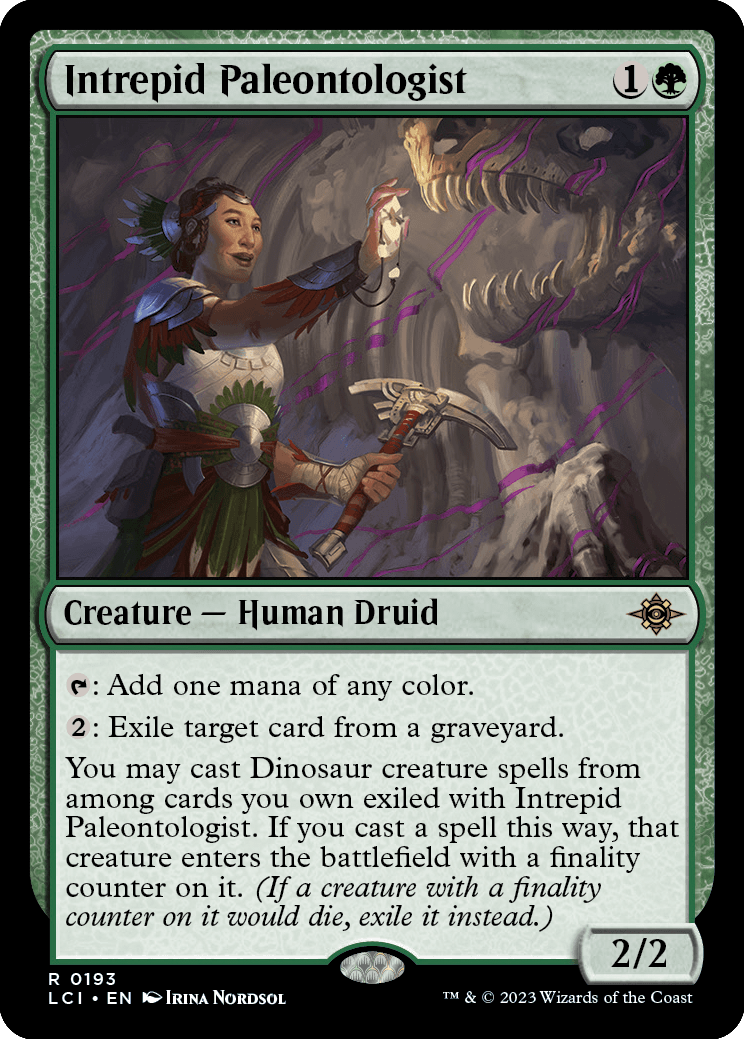
Intrepid Paleontologist
Creature — Human Druid
2/2
: Add one mana of any color.
: Exile target card from a graveyard.
You may cast Dinosaur creature spells from among cards you own exiled with Intrepid Paleontologist. If you cast a spell this way, that creature enters the battlefield with a finality counter on it. (If a creature with a finality counter on it would die, exile it instead.)
- Finality counters work on any permanent, not only creatures. If a permanent with a finality counter on it would go to a graveyard from the battlefield, exile it instead.
- Finality counters don't stop permanents from going to zones other than the graveyard from the battlefield. For example, if a permanent with a finality counter on it would be put into its owner's hand from the battlefield, it does so normally.
- Finality counters aren't keyword counters, and a finality counter doesn't give any abilities to the permanent it's on. If that permanent loses its abilities and then would go to a graveyard, it will still be exiled instead.
- Multiple finality counters on a single permanent are redundant.
Returning Land Cycle: Restless Lands
Wilds of Eldraine introduced the first five members of this cycle, and five more are present in The Lost Caverns of Ixalan.
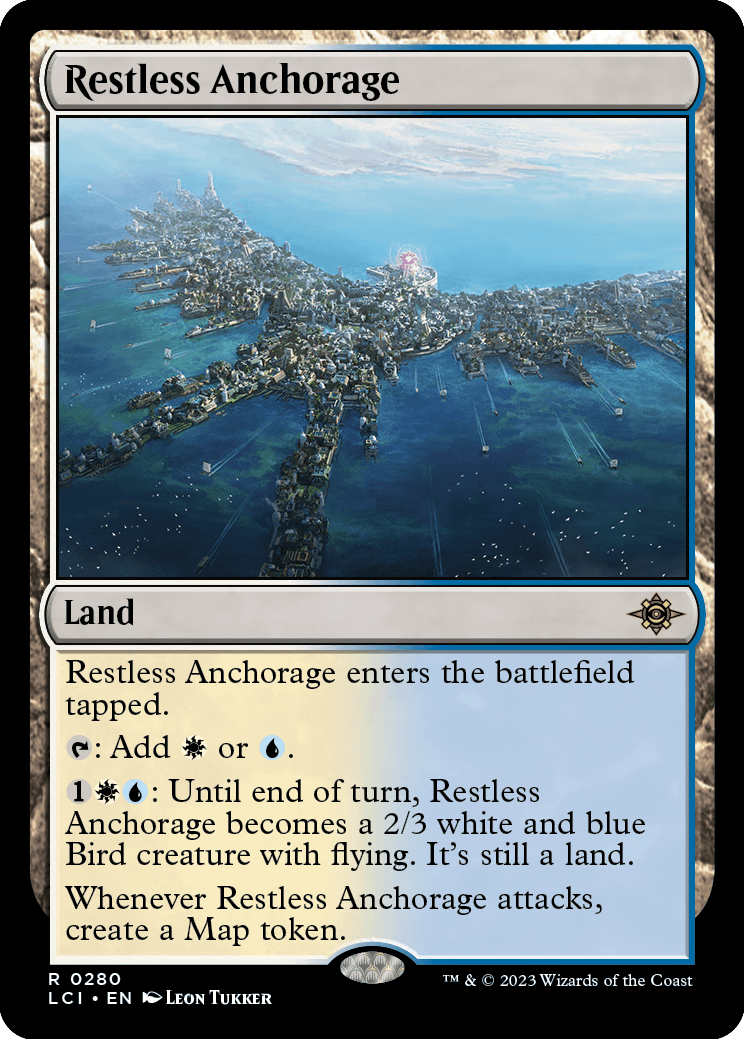
Restless Anchorage
Land
Restless Anchorage enters the battlefield tapped.
: Add or .
: Until end of turn, Restless Anchorage becomes a 2/3 white and blue Bird creature with flying. It's still a land.
Whenever Restless Anchorage attacks, create a Map token.
- If one of the lands in this cycle becomes a creature because of an effect other than its own ability, its last ability will still trigger whenever it attacks.
- If one of the lands in this cycle becomes a creature but you haven't controlled it continuously since your most recent turn began, you won't be able to activate its mana ability or attack with it that turn.
THE LOST CAVERNS OF IXALAN MAIN SET CARD-SPECIFIC NOTES
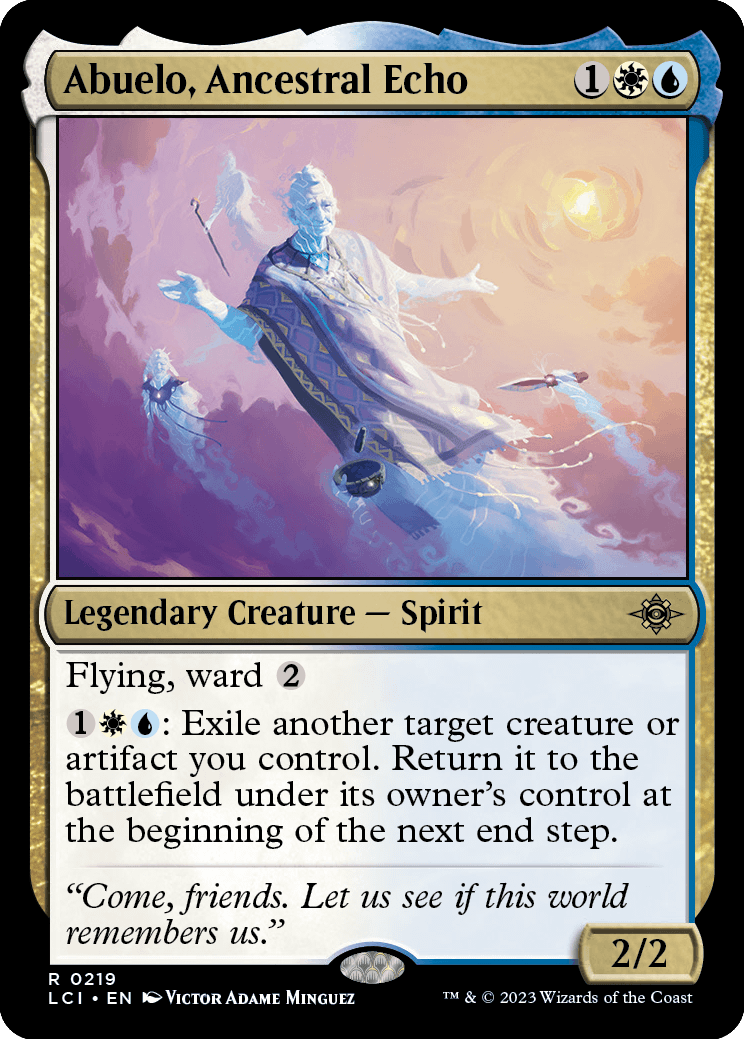
Abuelo, Ancestral Echo
Legendary Creature — Spirit
2/2
Flying, ward
: Exile another target creature or artifact you control. Return it to the battlefield under its owner's control at the beginning of the next end step.
- If a token is exiled this way, it ceases to exist and won't return to the battlefield.
- The exiled card will return to the battlefield at the beginning of the next end step even if Abuelo, Ancestral Echo is no longer on the battlefield at that time.
- If a double-faced card is exiled this way, it will return with its front face up, no matter which face was up when it left the battlefield.
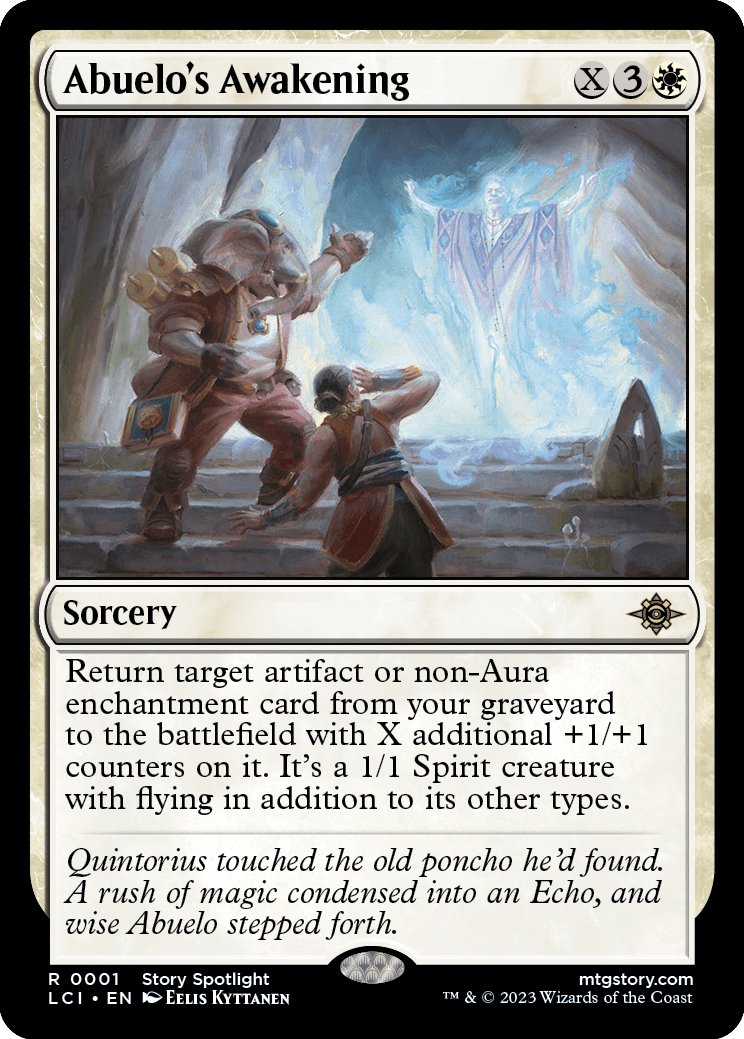
Abuelo's Awakening
Sorcery
Return target artifact or non-Aura enchantment card from your graveyard to the battlefield with X additional +1/+1 counters on it. It's a 1/1 Spirit creature with flying in addition to its other types.
- An artifact creature card or enchantment creature card returned this way will have base power and toughness 1/1.
- An Equipment that's also a creature can't be attached to anything. You can activate its equip ability, but it won't become attached.
- If another effect causes one of the returned permanents to become a creature and sets its base power and toughness as it does so, that creature will have that power and toughness; it won't be 1/1. Notably, crewing a Vehicle does not set its power and toughness, so a Vehicle will remain a 1/1 if you crew it.
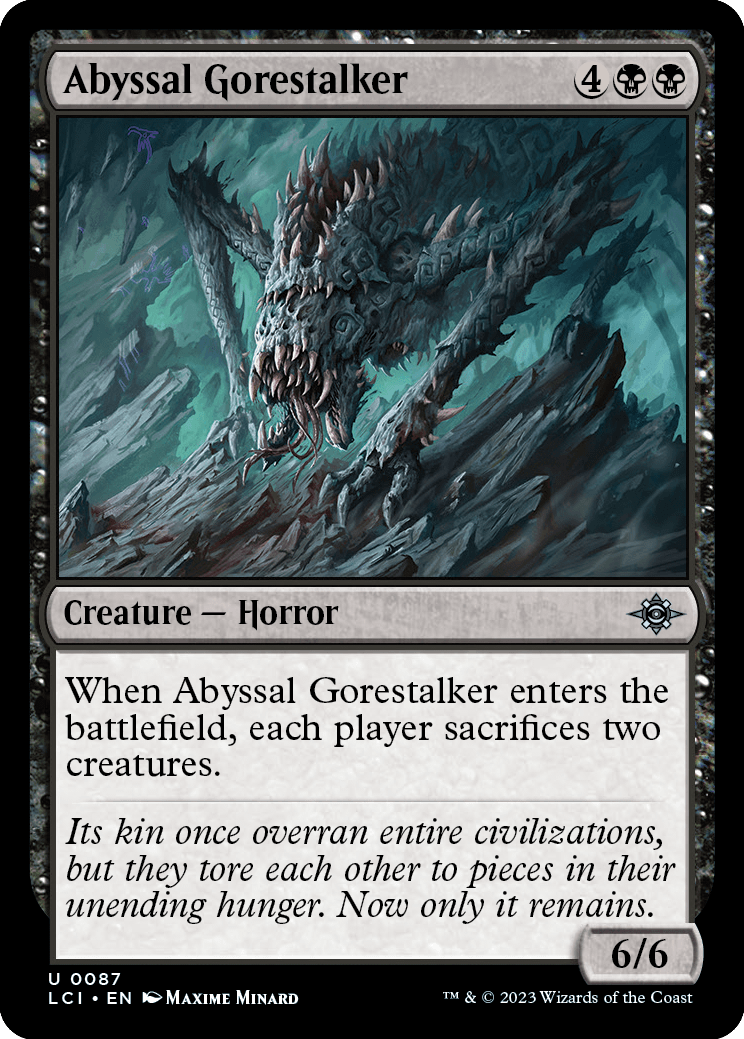
Abyssal Gorestalker
Creature — Horror
6/6
When Abyssal Gorestalker enters the battlefield, each player sacrifices two creatures.
- As the enters-the-battlefield ability resolves, first the player whose turn it is chooses which two creatures they are going to sacrifice, then each other player in turn order does the same. Players will know the choices of previous players when making their choices. Then all creatures are sacrificed by their controllers simultaneously.
- If a player controls only one creature as the ability resolves, they must sacrifice it.
- You may sacrifice Abyssal Gorestalker to its own ability. If it is the only creature you control or one of two creatures you control, you must sacrifice it.
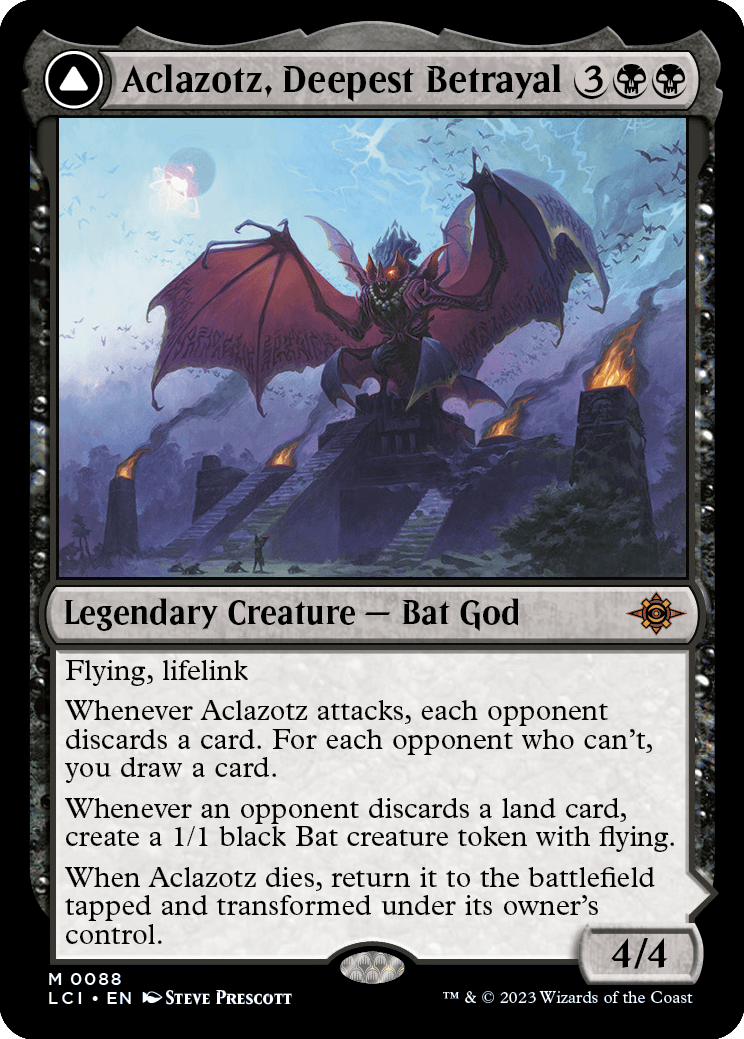
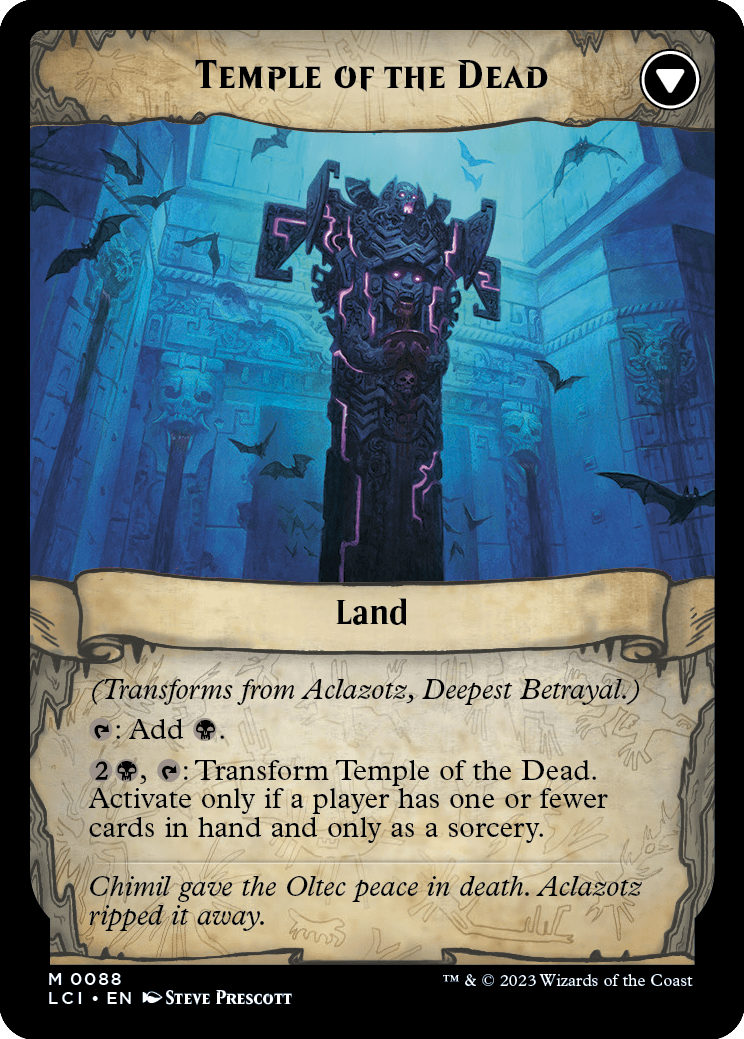
Aclazotz, Deepest Betrayal
Legendary Creature — Bat God
4/4
Flying, lifelink
Whenever Aclazotz attacks, each opponent discards a card. For each opponent who can't, you draw a card.
Whenever an opponent discards a land card, create a 1/1 black Bat creature token with flying.
When Aclazotz dies, return it to the battlefield tapped and transformed under its owner's control.
////
Temple of the Dead
Land
(Transforms from Aclazotz, Deepest Betrayal.)
: Add .
, : Transform Temple of the Dead. Activate only if a player has one or fewer cards in hand and only as a sorcery.
- If a card that isn't a transforming double-faced card is a copy of Aclazotz, Deepest Betrayal, it won't return to the battlefield when it dies.
- The last ability of Temple of the Dead will resolve even if you have two or more cards in hand at that time.
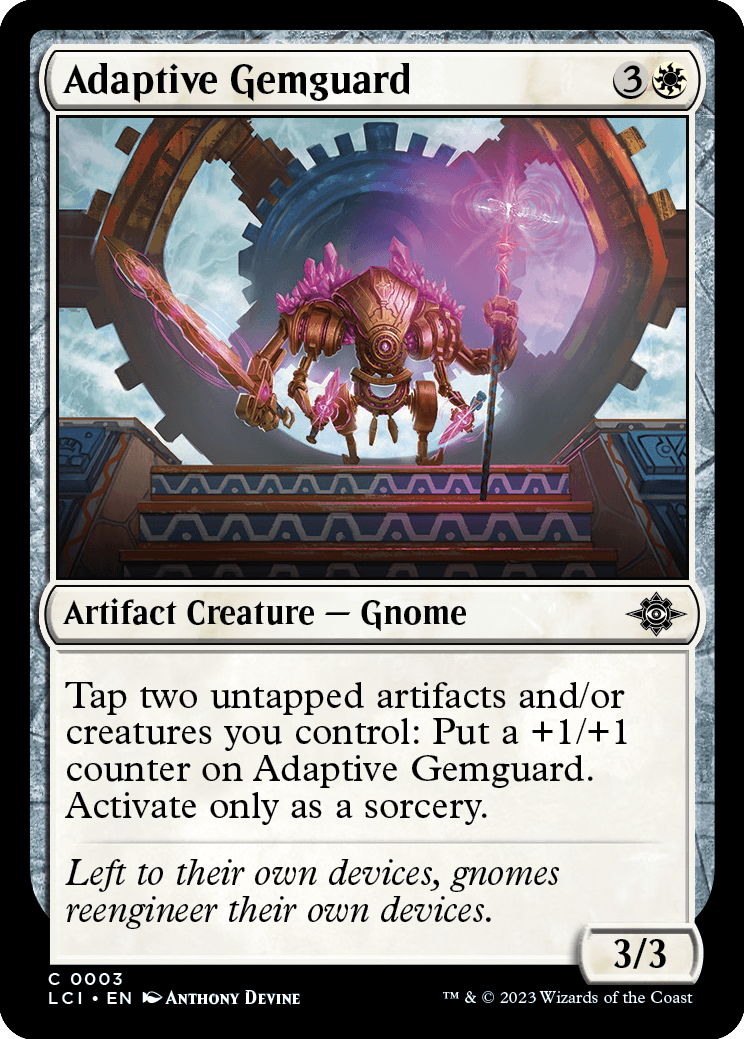
Adaptive Gemguard
Artifact Creature — Gnome
3/3
Tap two untapped artifacts and/or creatures you control: Put a +1/+1 counter on Adaptive Gemguard. Activate only as a sorcery.
- You can tap any two untapped artifacts and/or creatures you control, including Adaptive Gemguard itself and other creatures you haven't controlled continuously since the beginning of your most recent turn, to pay the cost of Adaptive Gemguard's activated ability.
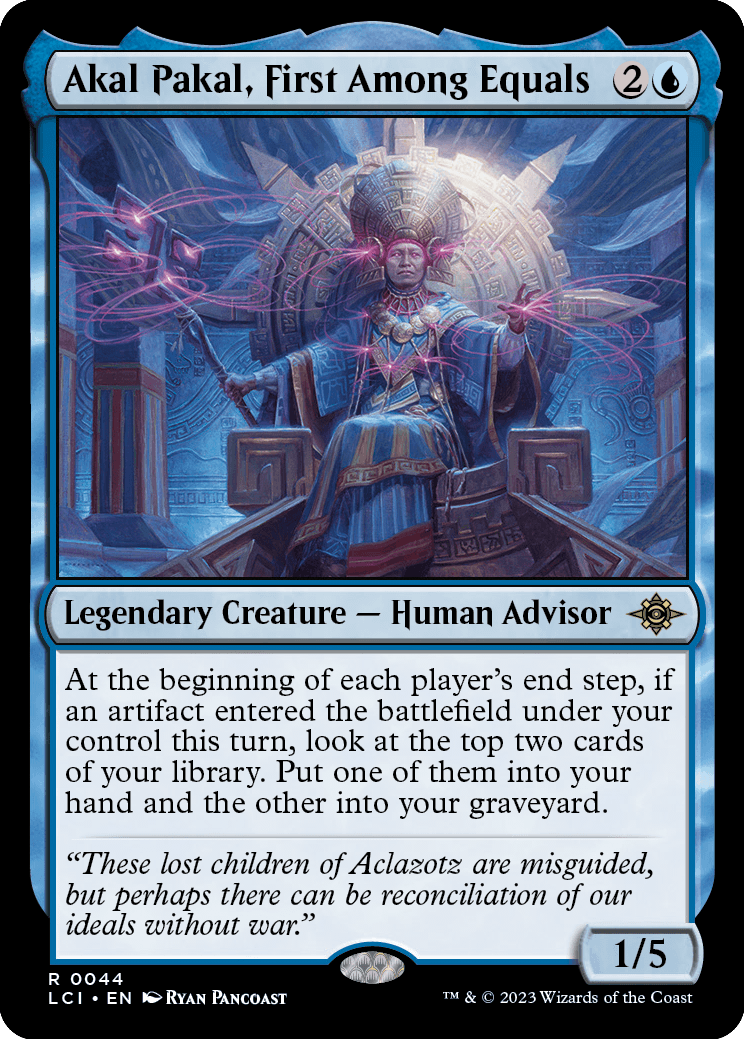
Akal Pakal, First Among Equals
Legendary Creature — Human Advisor
1/5
At the beginning of each player's end step, if an artifact entered the battlefield under your control this turn, look at the top two cards of your library. Put one of them into your hand and the other into your graveyard.
- The ability will trigger no matter what happened to the artifact after it entered. It may have left the battlefield, come under another player's control, or stopped being an artifact.
- If there is only one card in your library, you put it into your hand.
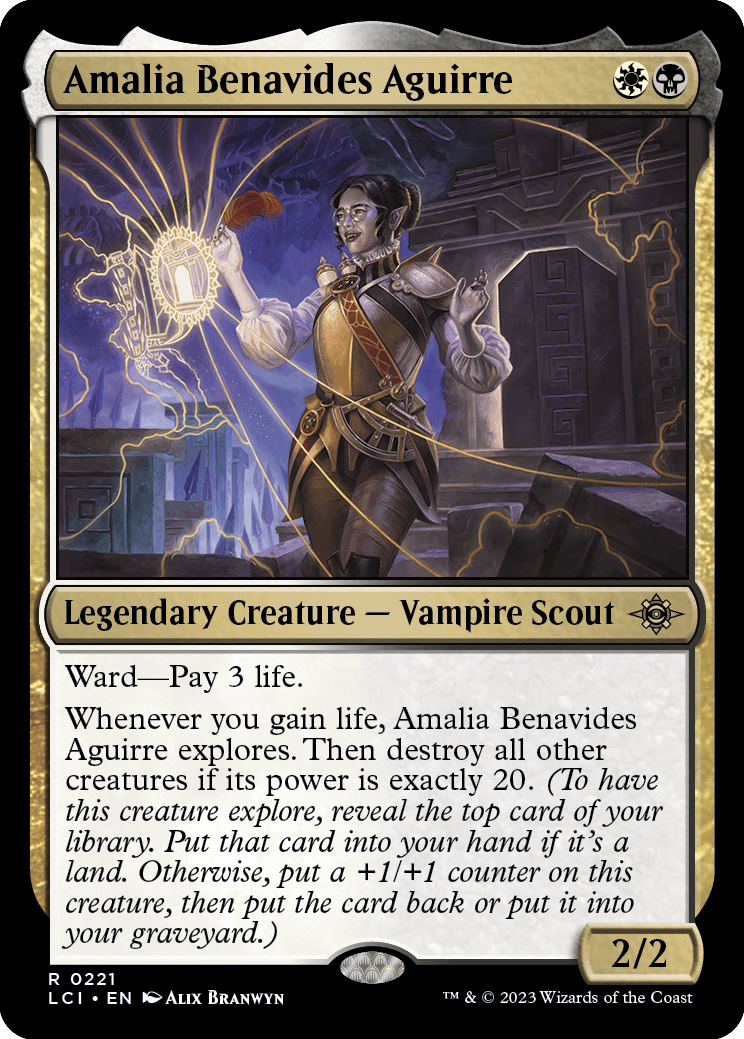
Amalia Benavides Aguirre
Legendary Creature — Vampire Scout
2/2
Ward—Pay 3 life.
Whenever you gain life, Amalia Benavides Aguirre explores. Then destroy all other creatures if its power is exactly 20. (To have this creature explore, reveal the top card of your library. Put that card into your hand if it's a land. Otherwise, put a +1/+1 counter on this creature, then put the card back or put it into your graveyard.)
- If multiple creatures with lifelink you control deal combat damage at the same time, the damage dealt by each of those creatures is a separate life-gaining event and Amalia Benavides Aguirre's ability will trigger that many times.
- Amalia Benavides Aguirre's power must be exactly 20 during the resolution of its last ability after it finishes exploring in order to destroy all other creatures. If it's more or less than 20, nothing is destroyed.
- Amalia Benavides Aguirre's power is checked only once, as the triggered ability resolves. If it is no longer on the battlefield at that point, use its power as it last existed on the battlefield.
- The instruction for Amalia Benavides Aguirre to explore and the effect that occurs if Amalia Benavides Aguirre's power is exactly 20 are all part of the same ability. Players do not get to chance to respond to the ability after knowing the result of the explore.
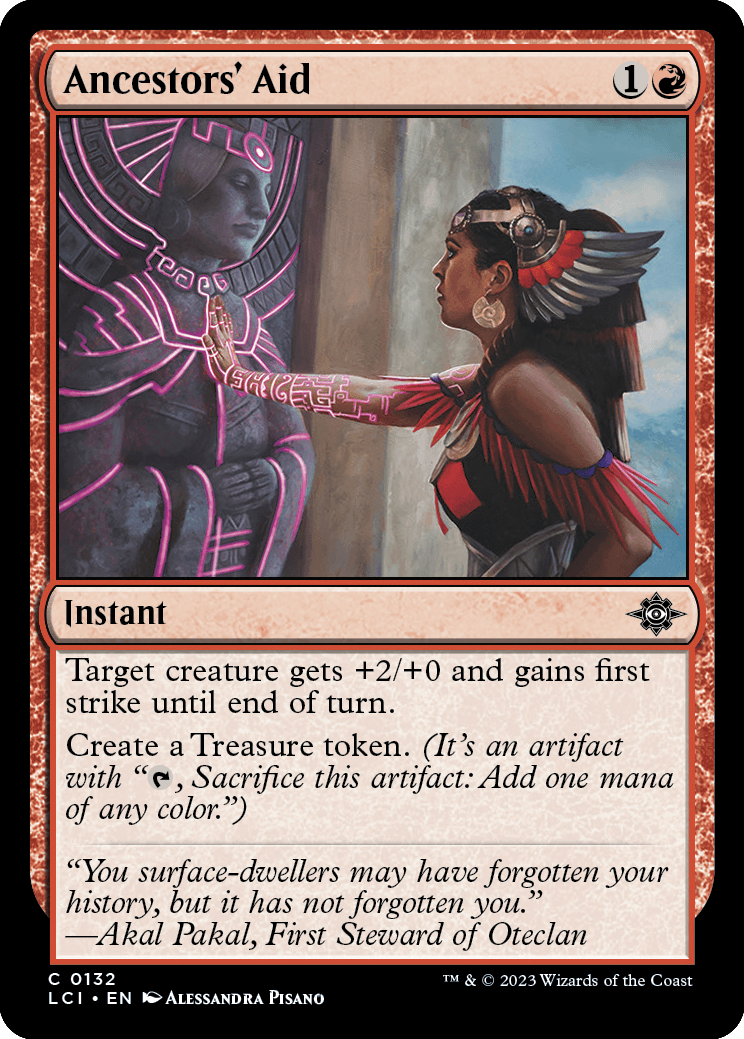
Ancestors' Aid
Instant
Target creature gets +2/+0 and gains first strike until end of turn.
Create a Treasure token. (It's an artifact with ", Sacrifice this artifact: Add one mana of any color.")
- If the target of Ancestors' Aid is illegal as the spell tries to resolve, it won't resolve and none of its effects will happen. You won't create a Treasure token.
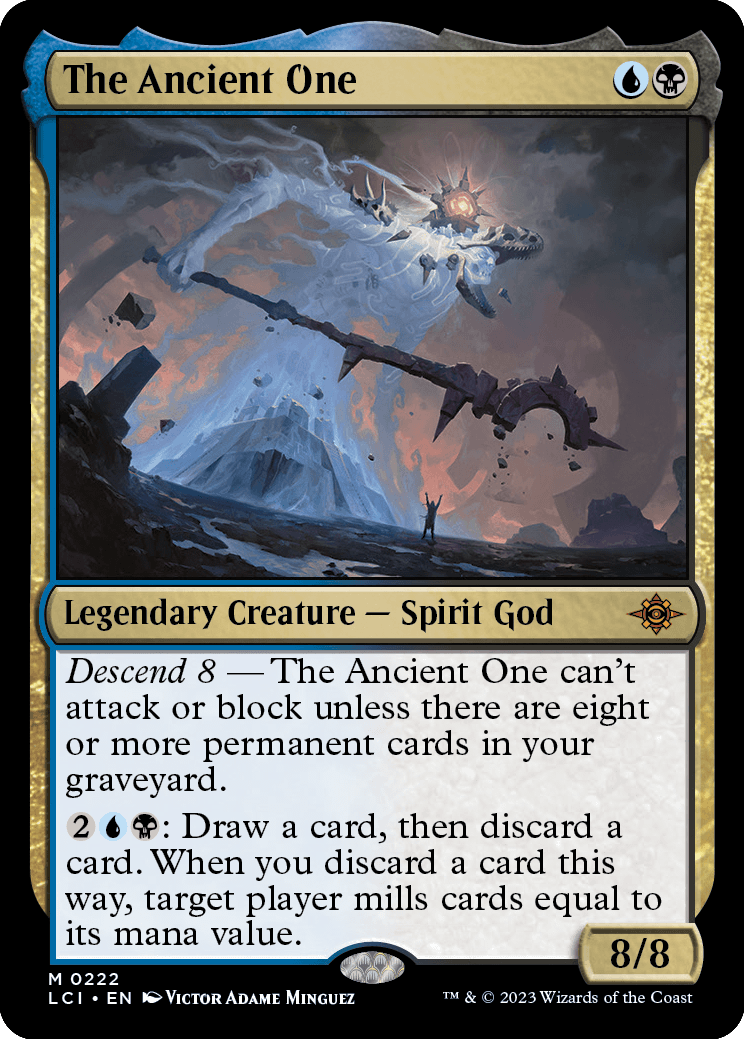
The Ancient One
Legendary Creature — Spirit God
8/8
Descend 8 — The Ancient One can't attack or block unless there are eight or more permanent cards in your graveyard.
: Draw a card, then discard a card. When you discard a card this way, target player mills cards equal to its mana value.
- Once The Ancient One has legally attacked or blocked, removing permanent cards from your graveyard so the descend 8 ability no longer applies won't remove The Ancient One from combat.
- You don't choose a target for The Ancient One's activated ability at the time you activate it. Rather, a second "reflexive" ability triggers when you discard a card this way. You choose a target for that ability as it goes on the stack. Each player may respond to this triggered ability as normal.
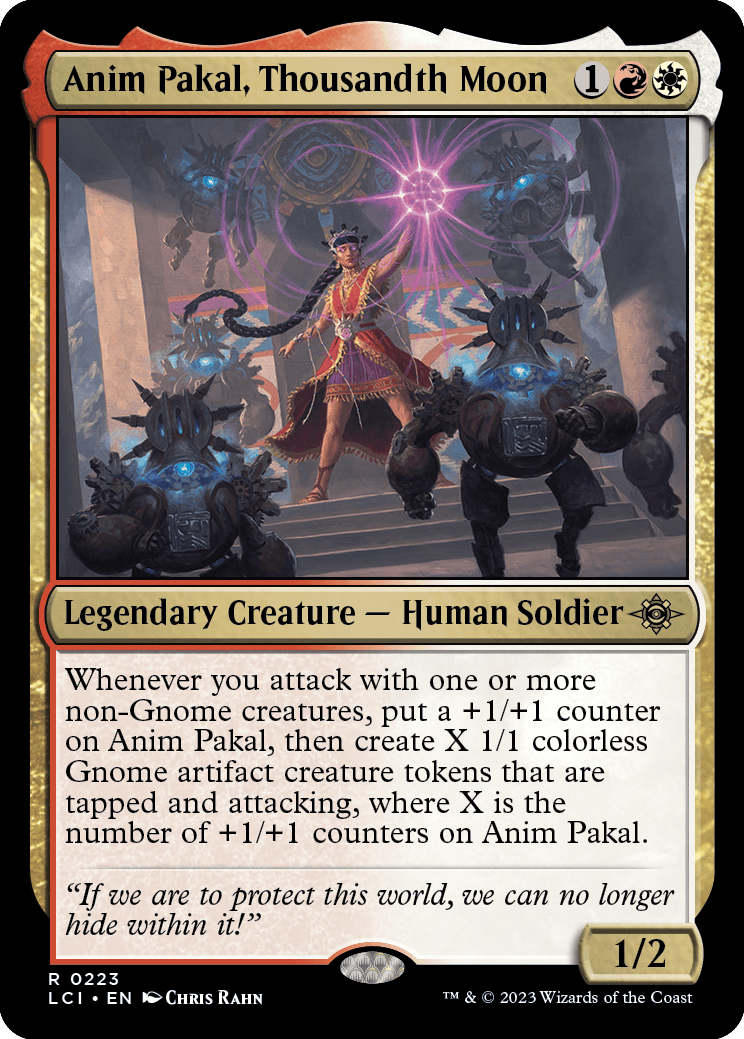
Anim Pakal, Thousandth Moon
Legendary Creature — Human Soldier
1/2
Whenever you attack with one or more non-Gnome creatures, put a +1/+1 counter on Anim Pakal, then create X 1/1 colorless Gnome artifact creature tokens that are tapped and attacking, where X is the number of +1/+1 counters on Anim Pakal.
- Anim Pakal, Thousandth Moon doesn't have to be one of the non-Gnome creatures you attack with in order for its ability to trigger, but it can be.
- You choose which player, planeswalker, or battle the Gnome tokens are attacking. Each Gnome token can enter attacking a different player, planeswalker, or battle, and they don't need to be the same ones that the non-Gnome creatures are attacking.
- Although the Gnome tokens enter the battlefield as attacking creatures, they were never declared as attacking creatures. Abilities that trigger whenever a creature attacks won't trigger when they enter the battlefield attacking.
- If Anim Pakal is no longer on the battlefield when the triggered ability resolves, you'll still create Gnomes. Use the number of +1/+1 counters that were on it when it was last on the battlefield.
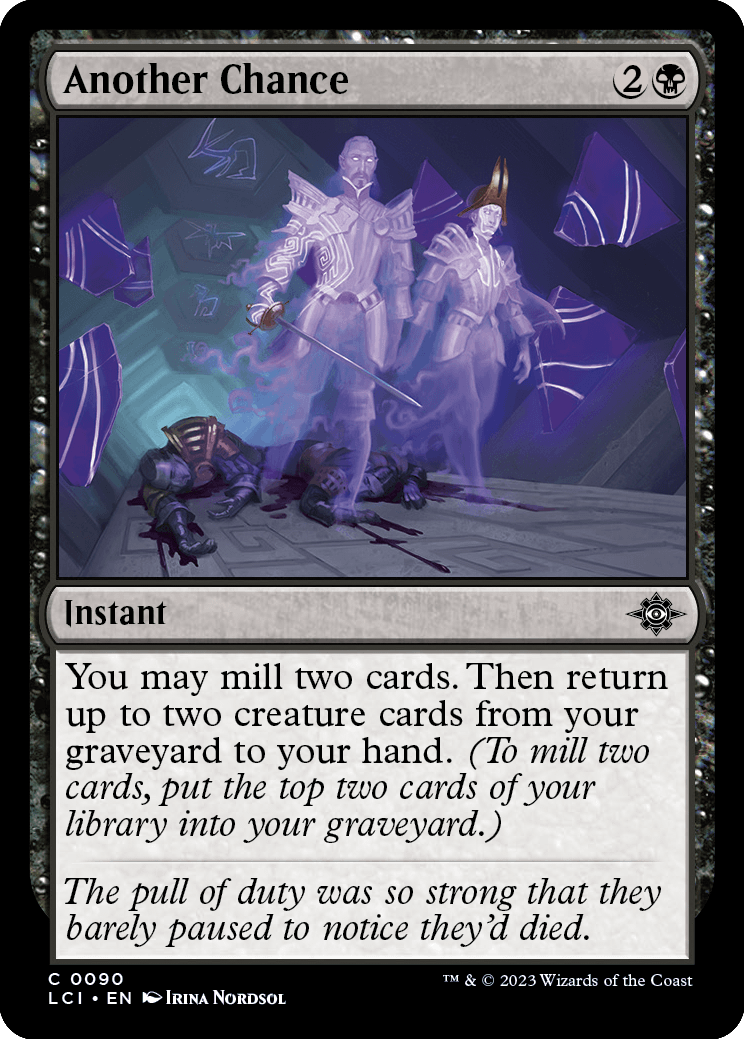
Another Chance
Instant
You may mill two cards. Then return up to two creature cards from your graveyard to your hand. (To mill two cards, put the top two cards of your library into your graveyard.)
- If you don't have at least two cards in your library, you can't choose to mill two cards.
- The creature cards you return to your hand don't have to be any of the cards you milled. They can be cards that were already in your graveyard before you milled.
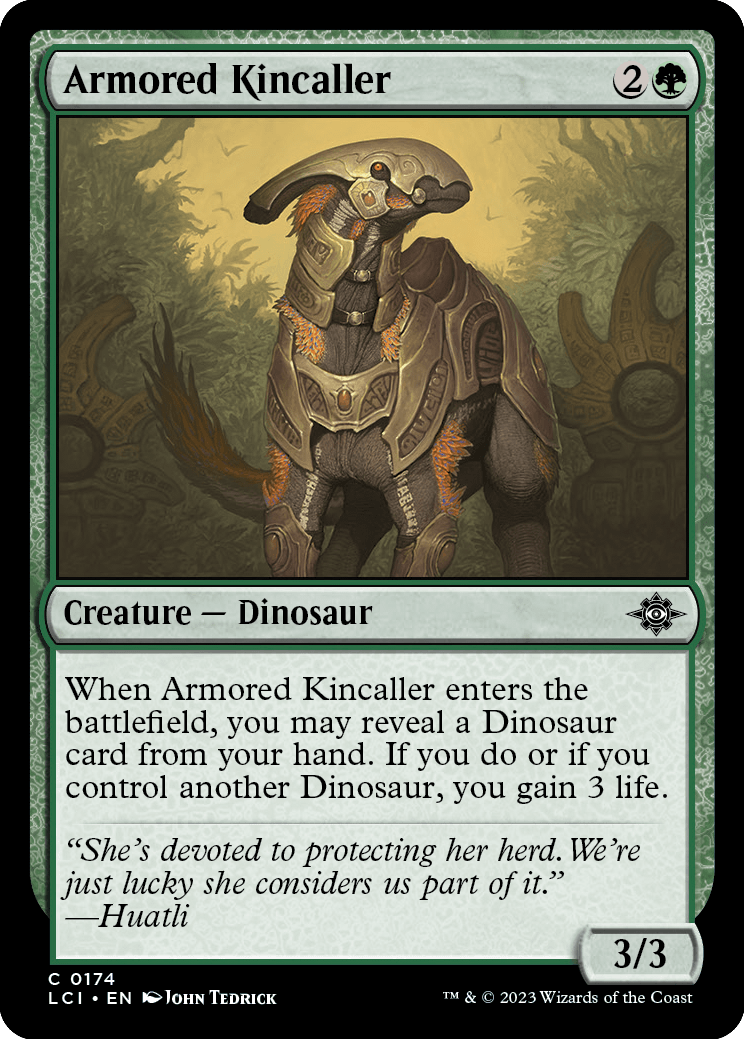
Armored Kincaller
Creature — Dinosaur
3/3
When Armored Kincaller enters the battlefield, you may reveal a Dinosaur card from your hand. If you do or if you control another Dinosaur, you gain 3 life.
- Whether or not you control another Dinosaur is checked only as Armored Kincaller's ability is resolving. It doesn't matter if you still control Armored Kincaller at the time, or if it's still a Dinosaur.
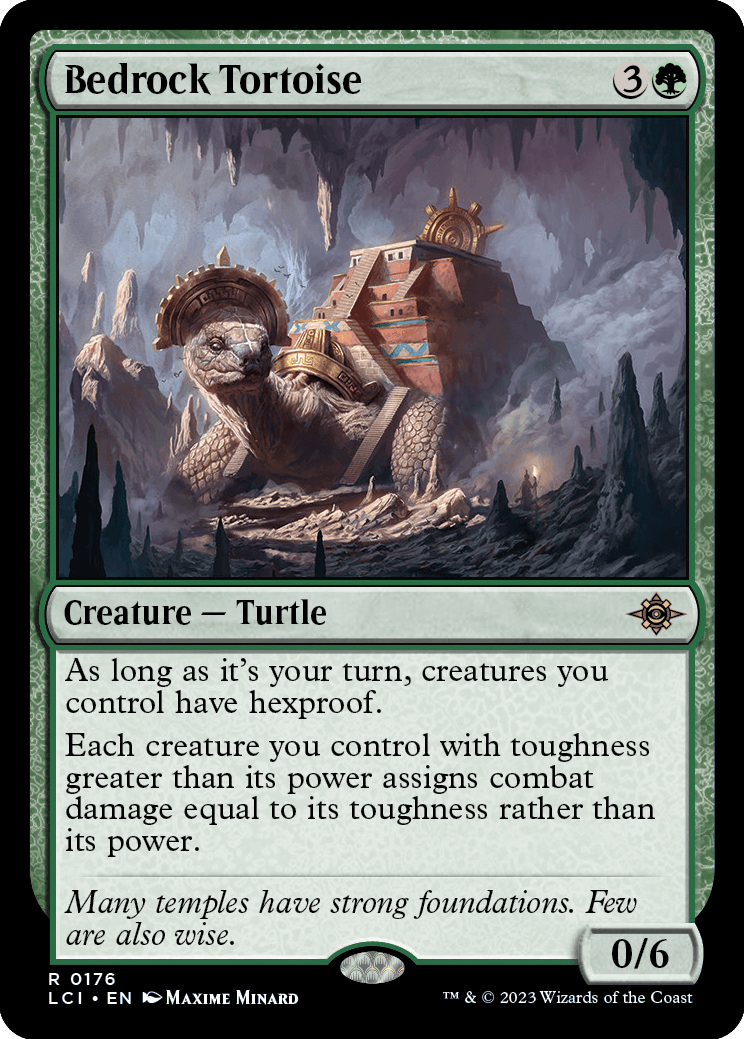
Bedrock Tortoise
Creature — Turtle
0/6
As long as it's your turn, creatures you control have hexproof.
Each creature you control with toughness greater than its power assigns combat damage equal to its toughness rather than its power.
- Bedrock Tortoise's ability doesn't actually change any creature's power. It changes only the amount of combat damage the creature assigns. All other rules and effects that check power or toughness use the real values, even if they cause damage "equal to a creature's power" to be dealt.
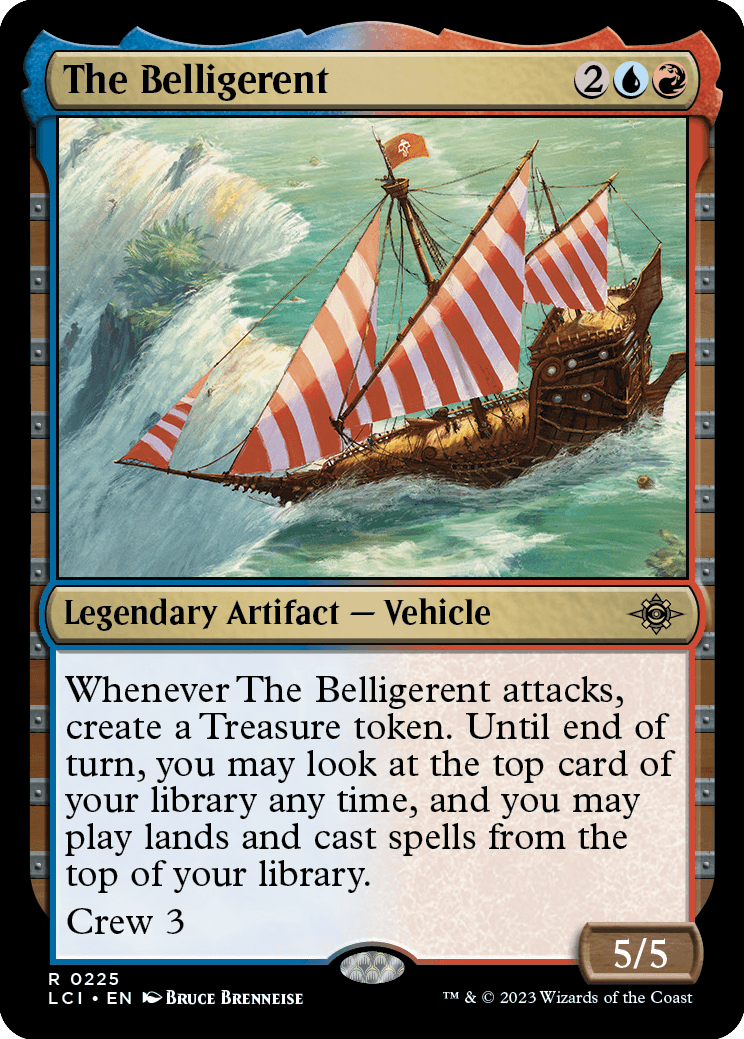
The Belligerent
Legendary Artifact — Vehicle
5/5
Whenever The Belligerent attacks, create a Treasure token. Until end of turn, you may look at the top card of your library any time, and you may play lands and cast spells from the top of your library.
Crew 3
- Once The Belligerent's triggered ability resolves, you can look at the top card of your library whenever you want until end of turn (with one restriction; see below), even if you don't have priority. This action doesn't use the stack. Knowing what that card is becomes part of the information you have access to, just like you can look at the cards in your hand.
- If the top card of your library changes while you're casting a spell, playing a land, or activating an ability, you can't look at the new top card until you finish doing so. This means that if you cast a spell from the top of your library, you can't look at the next one until you're done paying for that spell.
- If the top card of your library has an Adventure, you can cast the Adventure spell this way.
- You must pay all costs and follow all timing rules for spells cast and lands played from the top of your library this way.
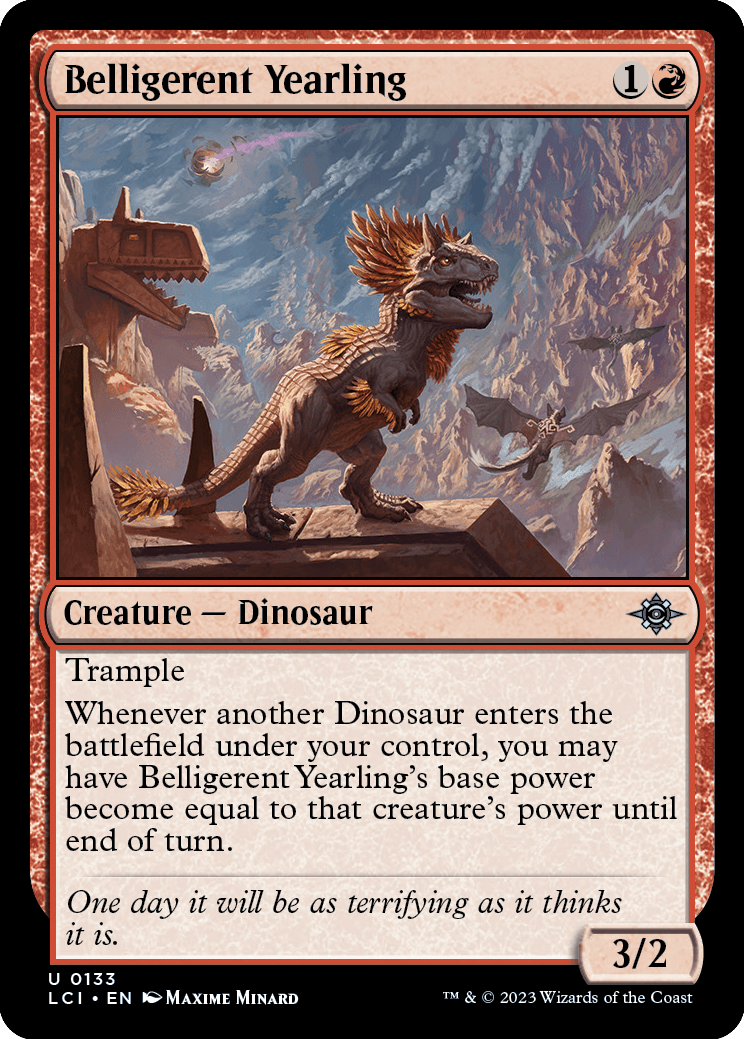
Belligerent Yearling
Creature — Dinosaur
3/2
Trample
Whenever another Dinosaur enters the battlefield under your control, you may have Belligerent Yearling's base power become equal to that creature's power until end of turn.
- Belligerent Yearling's ability overwrites any previous effects that set its power, including previous instances of that ability. Other effects that set its power to specific values that start to apply after the ability resolves, including future instances of the ability, will overwrite that effect.
- Effects that modify the power of Belligerent Yearling without setting it to a specific value will apply to the new base power no matter when they started to take effect. The same is true for counters that change its power.
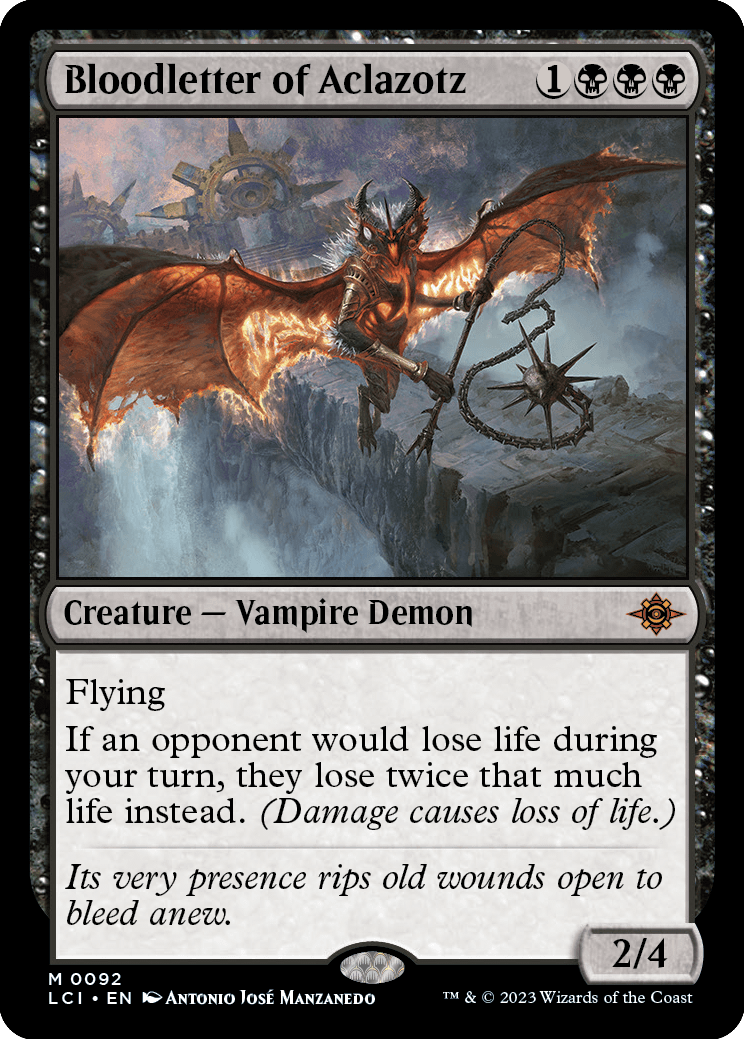
Bloodletter of Aclazotz
Creature — Vampire Demon
2/4
Flying
If an opponent would lose life during your turn, they lose twice that much life instead. (Damage causes loss of life.)
- Bloodletter of Aclazotz's last ability doesn't change the amount of damage dealt to opponents. For example, if a 1/1 creature with lifelink deals combat damage to an opponent on your turn, they would lose 2 life, but you'd still gain only 1 life.
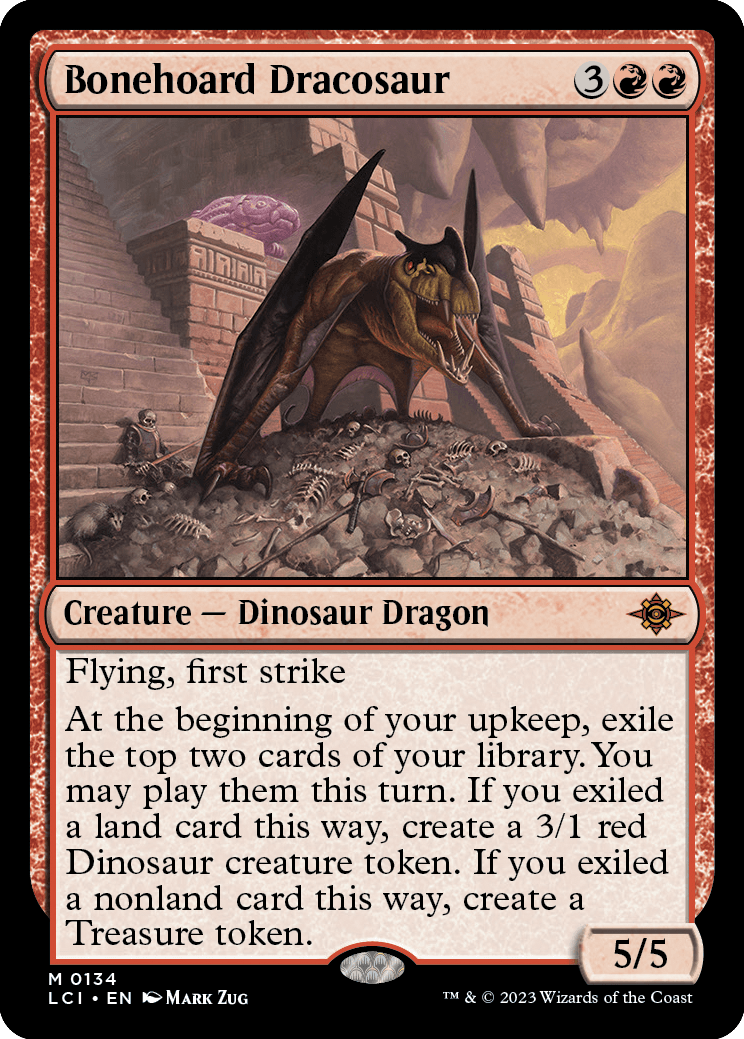
Bonehoard Dracosaur
Creature — Dinosaur Dragon
5/5
Flying, first strike
At the beginning of your upkeep, exile the top two cards of your library. You may play them this turn. If you exiled a land card this way, create a 3/1 red Dinosaur creature token. If you exiled a nonland card this way, create a Treasure token.
- You pay all costs and follow all normal timing rules for cards played this way. For example, if one of the exiled cards is a land card, you may play it only during your main phase while the stack is empty.
- If you exile two land cards, you'll create only one Dinosaur token. Similarly, if you exile two nonland cards, you'll create only one Treasure token.
- If you exile a land card and a nonland card, you'll create a Dinosaur token, then a Treasure token.
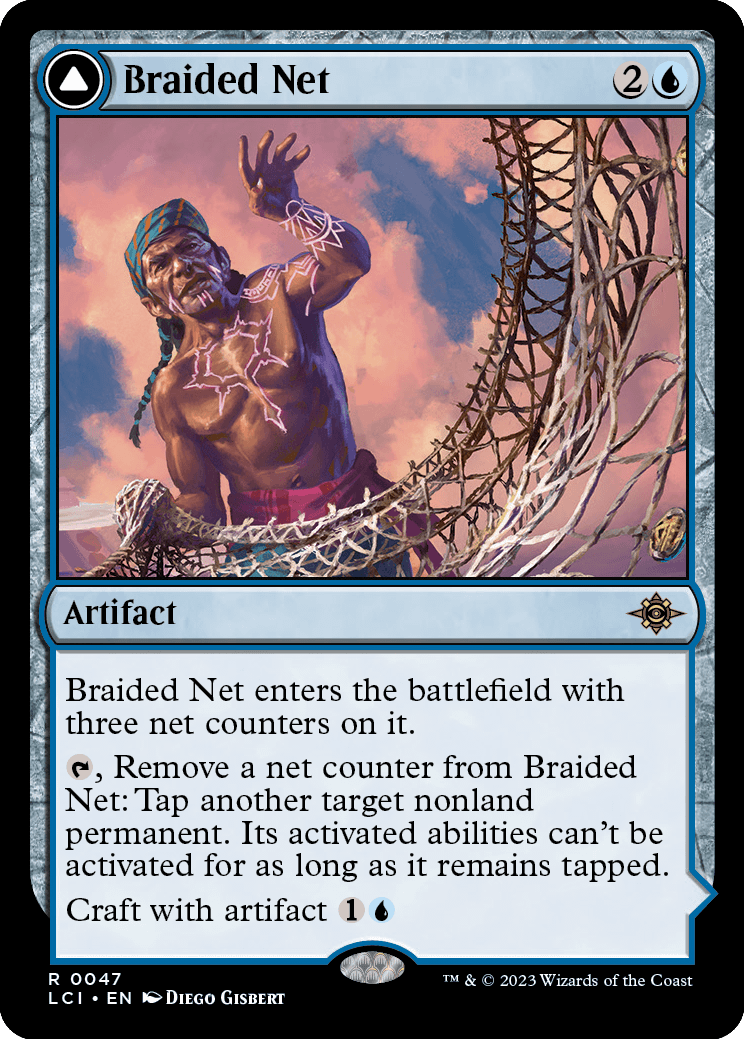
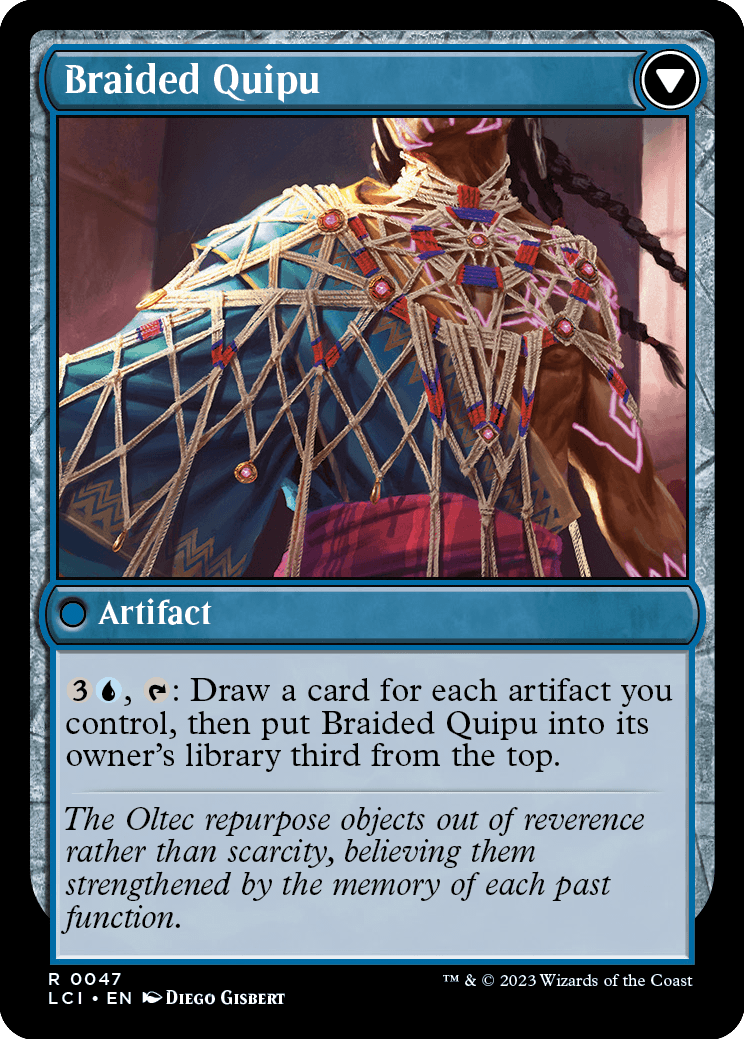
Braided Net
Artifact
Braided Net enters the battlefield with three net counters on it.
, Remove a net counter from Braided Net: Tap another target nonland permanent. Its activated abilities can't be activated for as long as it remains tapped.
Craft with artifact
////
Braided Quipu
Artifact
, : Draw a card for each artifact you control, then put Braided Quipu into its owner's library third from the top.
- Braided Net's activated ability can target another nonland permanent that's already tapped.
- No activated abilities of the target nonland permanent can be activated for as long as it remains tapped, even if those activated abilities' costs involve untapping that permanent.
- Once Braided Quipu is back in your library, Braided Net will be the face that's up again.
- After drawing cards for Braided Quipu's ability, if you have two or fewer cards in your library, you'll put Braided Quipu on the bottom of your library.
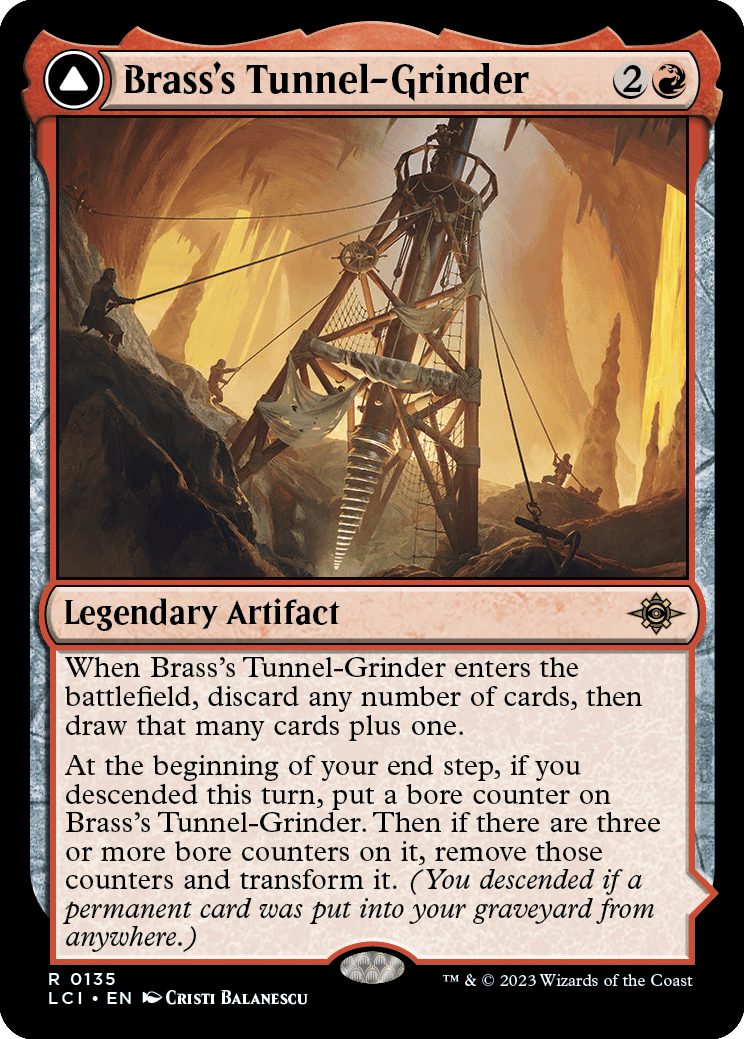
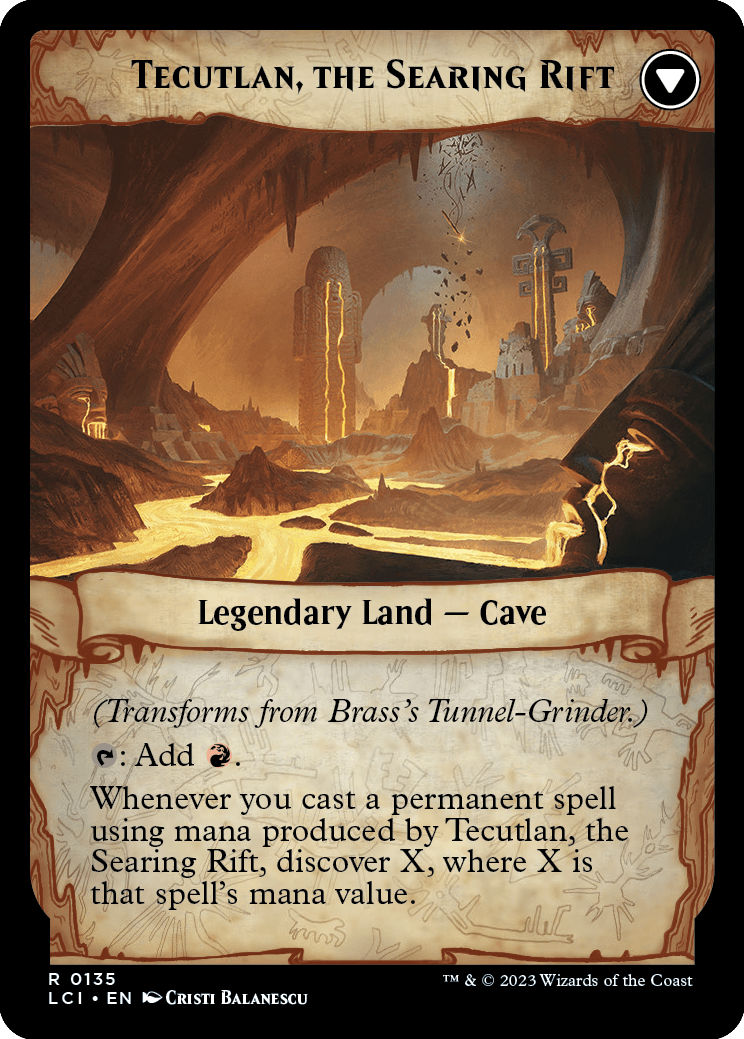
Brass's Tunnel-Grinder
Legendary Artifact
When Brass's Tunnel-Grinder enters the battlefield, discard any number of cards, then draw that many cards plus one.
At the beginning of your end step, if you descended this turn, put a bore counter on Brass's Tunnel-Grinder. Then if there are three or more bore counters on it, remove those counters and transform it. (You descended if a permanent card was put into your graveyard from anywhere.)
////
Tecutlan, the Searing Rift
Legendary Land — Cave
(Transforms from Brass's Tunnel-Grinder.)
: Add .
Whenever you cast a permanent spell using mana produced by Tecutlan, the Searing Rift, discover X, where X is that spell's mana value.
- You choose how many cards to discard as the first ability of Brass's Tunnel-Grinder resolves. You may choose to discard no cards and just draw a card.
- If a permanent spell cast using mana produced by Tecutlan, the Searing Rift has in its mana cost, use the value chosen for X when calculating that spell's mana value.
- Tecutlan, the Searing Rift's triggered ability will resolve before the spell that caused it to trigger.
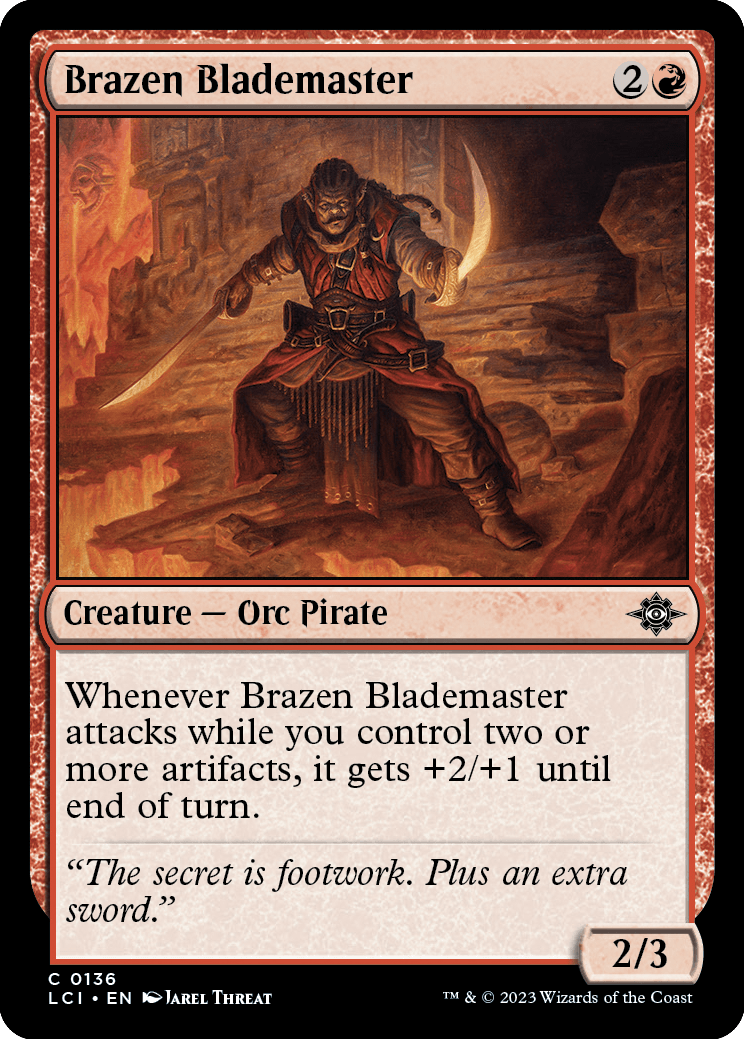
Brazen Blademaster
Creature — Orc Pirate
2/3
Whenever Brazen Blademaster attacks while you control two or more artifacts, it gets +2/+1 until end of turn.
- If you controlled at least two artifacts when you declared Brazen Blademaster as an attacker, it doesn't matter how many you control as its ability resolves. Brazen Blademaster will still get +2/+1 until end of turn.
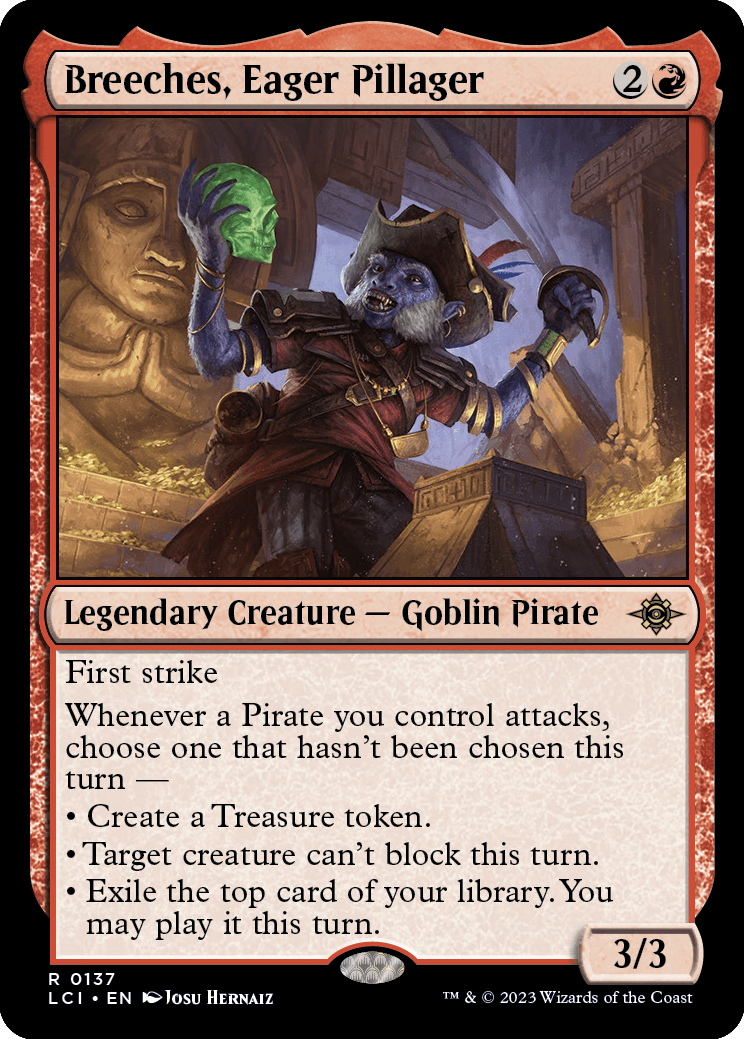
Breeches, Eager Pillager
Legendary Creature — Goblin Pirate
3/3
First strike
Whenever a Pirate you control attacks, choose one that hasn't been chosen this turn —
• Create a Treasure token.
• Target creature can't block this turn.
• Exile the top card of your library. You may play it this turn.
- You pay all costs and follow all normal timing rules for cards played this way. For example, if the exiled card is a land card, you may play it only during your main phase while the stack is empty.
- If you can't legally choose a mode because all three have been chosen that turn, that instance of the ability is removed from the stack with no effect.
- If you somehow control two or more Breeches, Eager Pillager, track which modes have been chosen each turn for each one's ability separately.
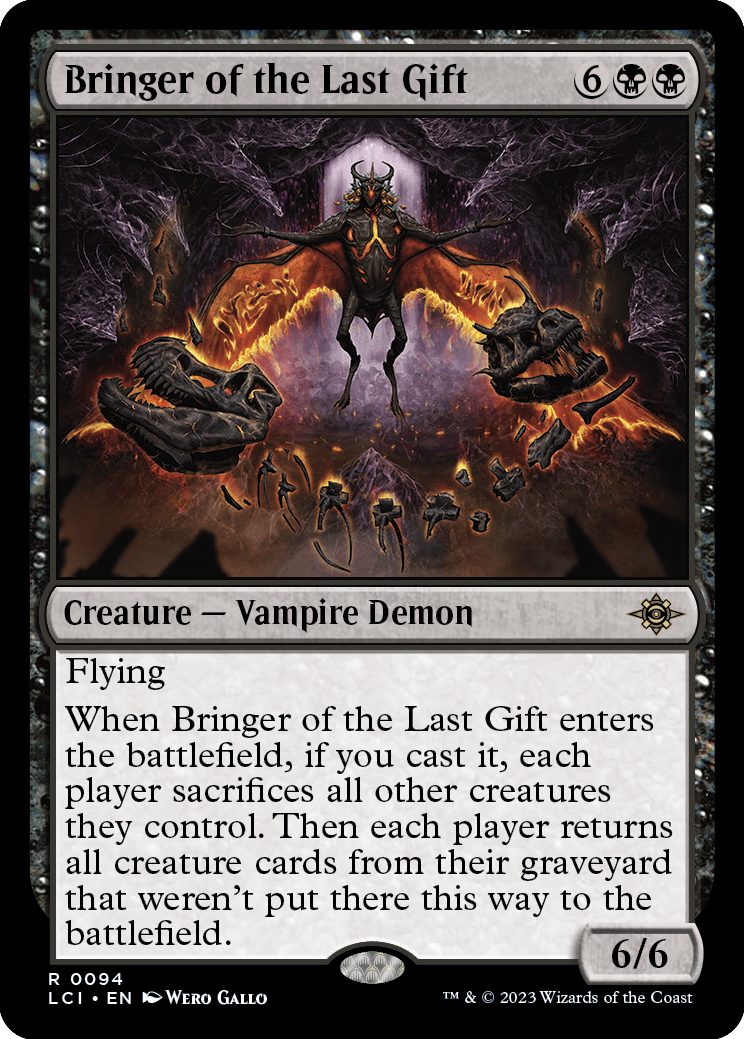
Bringer of the Last Gift
Creature — Vampire Demon
6/6
Flying
When Bringer of the Last Gift enters the battlefield, if you cast it, each player sacrifices all other creatures they control. Then each player returns all creature cards from their graveyard that weren't put there this way to the battlefield.
- Bringer of the Last Gift's last ability triggers if you cast it from any zone. It doesn't trigger if you put Bringer of the Last Gift onto the battlefield without casting it.
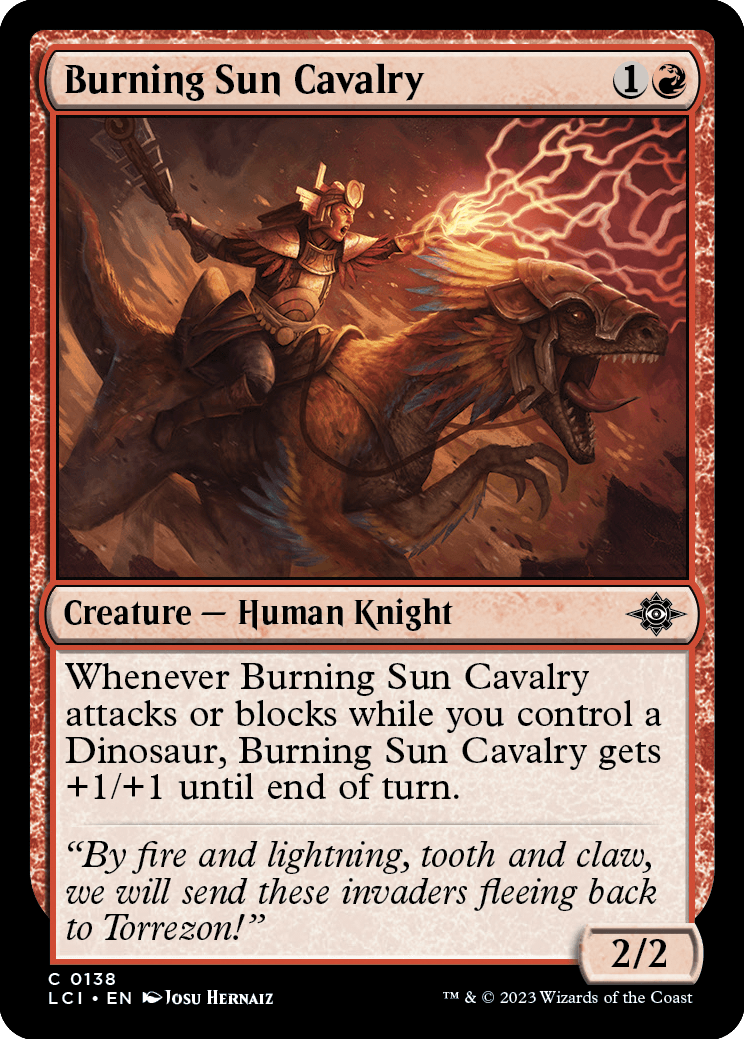
Burning Sun Cavalry
Creature — Human Knight
2/2
Whenever Burning Sun Cavalry attacks or blocks while you control a Dinosaur, Burning Sun Cavalry gets +1/+1 until end of turn.
- If you controlled a Dinosaur when you declared Burning Sun Cavalry as an attacker or blocker, it doesn't matter whether you still control one as its ability resolves. Burning Sun Cavalry will still get +1/+1 until end of turn.
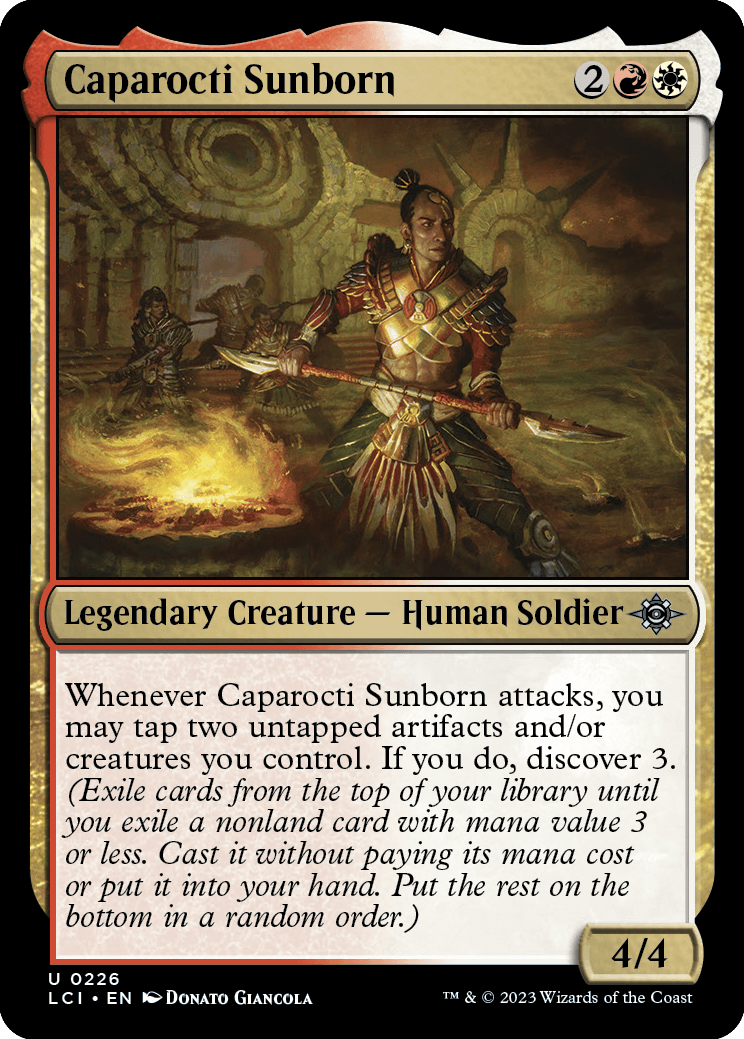
Caparocti Sunborn
Legendary Creature — Human Soldier
4/4
Whenever Caparocti Sunborn attacks, you may tap two untapped artifacts and/or creatures you control. If you do, discover 3. (Exile cards from the top of your library until you exile a nonland card with mana value 3 or less. Cast it without paying its mana cost or put it into your hand. Put the rest on the bottom in a random order.)
- If Caparocti Sunborn is untapped as its ability is resolving (for example, if it has vigilance), it can be tapped for its own ability.
- You can tap any two untapped artifacts and/or creatures you control, including creatures you haven't controlled continuously since the beginning of your most recent turn, for Caparocti Sunborn's ability.
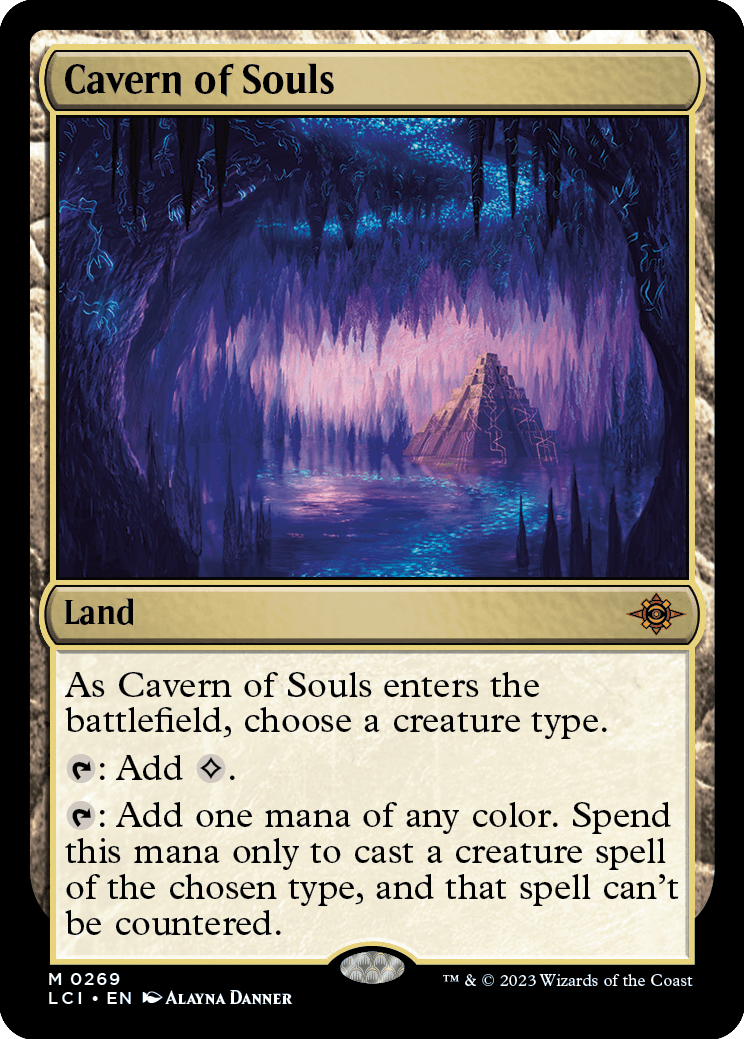
Cavern of Souls
Land
As Cavern of Souls enters the battlefield, choose a creature type.
: Add .
: Add one mana of any color. Spend this mana only to cast a creature spell of the chosen type, and that spell can't be countered.
- You must choose an existing creature type, such as Human or Warrior. Card types such as artifact can't be chosen.
- The spell can't be countered if the mana produced by Cavern of Souls is spent to cover any cost of the spell, even an additional cost such as a kicker cost. This is true even if you use the mana to pay an additional cost while casting a spell "without paying its mana cost."
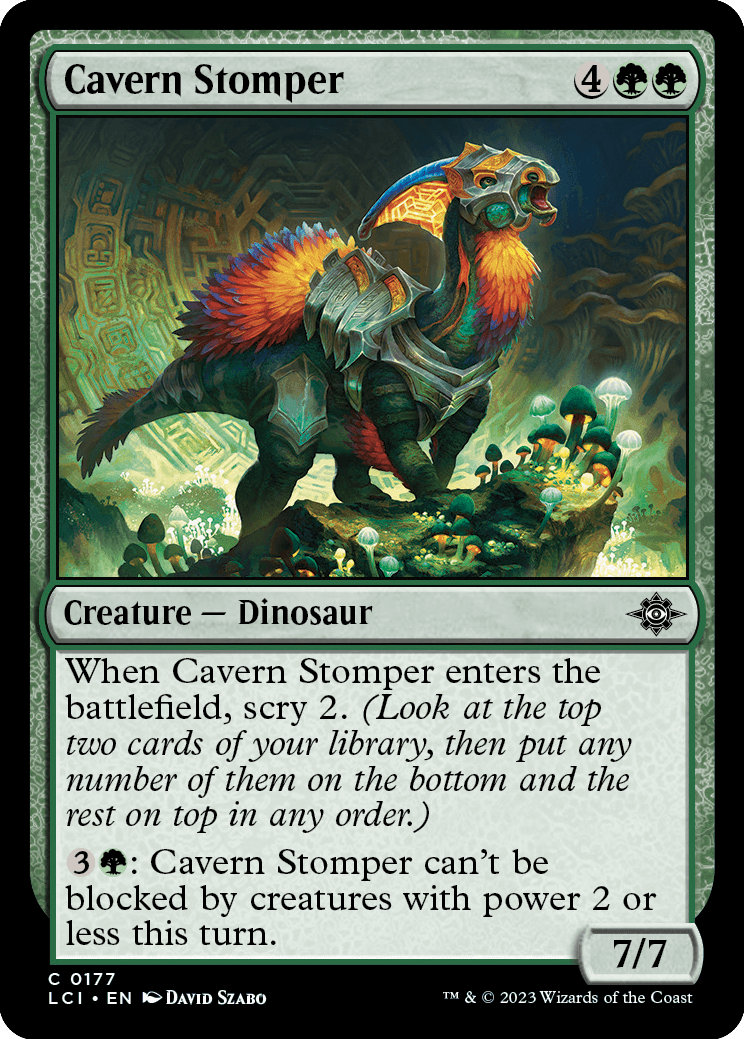
Cavern Stomper
Creature — Dinosaur
7/7
When Cavern Stomper enters the battlefield, scry 2. (Look at the top two cards of your library, then put any number of them on the bottom and the rest on top in any order.)
: Cavern Stomper can't be blocked by creatures with power 2 or less this turn.
- Activating Cavern Stomper's last ability after it has been blocked by one or more creatures with power 2 or less won't change or undo those blocks.
- Reducing a creature's power after it has blocked Cavern Stomper will not remove that blocking creature from combat or make Cavern Stomper unblocked.
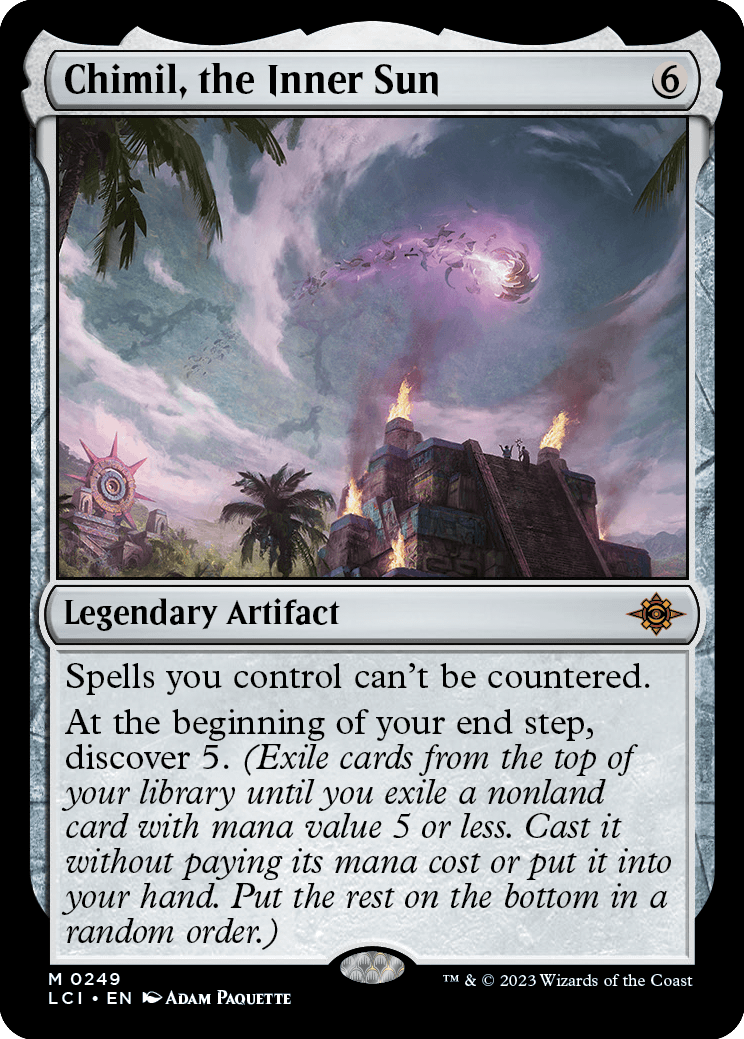
Chimil, the Inner Sun
Legendary Artifact
Spells you control can't be countered.
At the beginning of your end step, discover 5. (Exile cards from the top of your library until you exile a nonland card with mana value 5 or less. Cast it without paying its mana cost or put it into your hand. Put the rest on the bottom in a random order.)
- Chimil, the Inner Sun's first ability applies only while it's on the battlefield. While it's a spell, it can be countered.
- A spell or ability that counters spells can still target spells that can't be countered. When that spell or ability resolves, the uncounterable spell won't be countered, but any additional effects of the countering spell or ability will still happen.
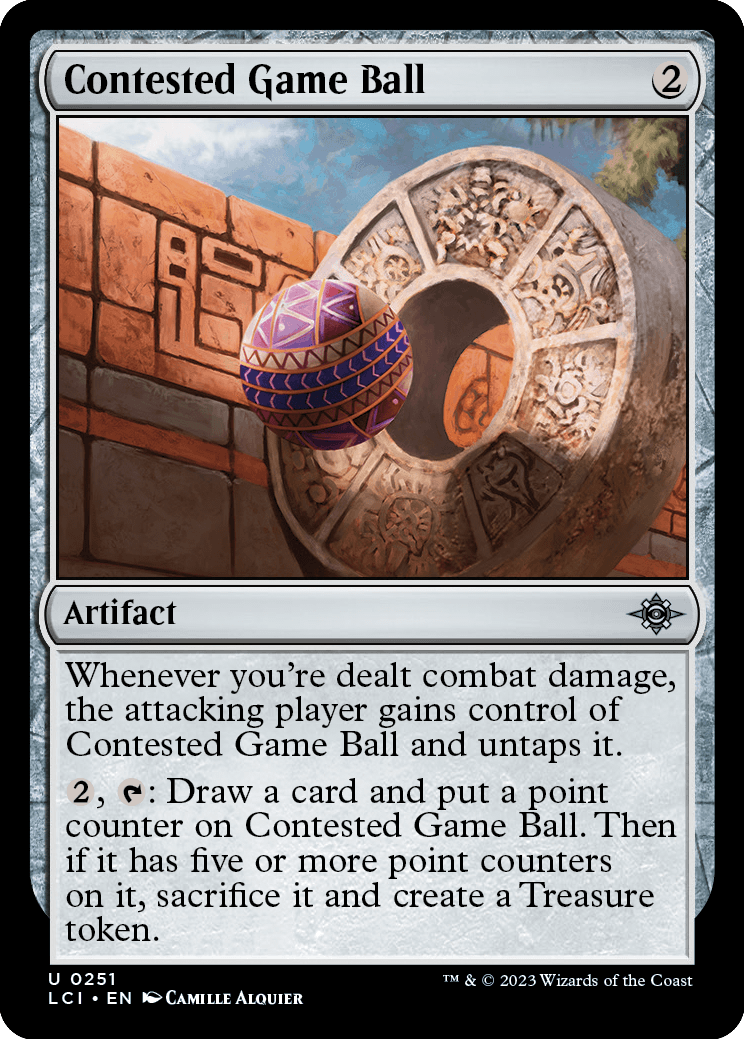
Contested Game Ball
Artifact
Whenever you're dealt combat damage, the attacking player gains control of Contested Game Ball and untaps it.
, : Draw a card and put a point counter on Contested Game Ball. Then if it has five or more point counters on it, sacrifice it and create a Treasure token.
- Contested Game Ball's triggered ability triggers only once whenever you're dealt combat damage, no matter how many creatures deal combat damage to you at the same time.
- If point counters are put on Contested Game Ball some way other than its last ability, you won't sacrifice it or create a Treasure token. The check for five or more point counters happens only as the activated ability resolves.
- In a Two-Headed Giant game, each player on the attacking team is an attacking player. When Contested Game Ball's first ability resolves, you'll choose which member of the attacking team gains control of it.
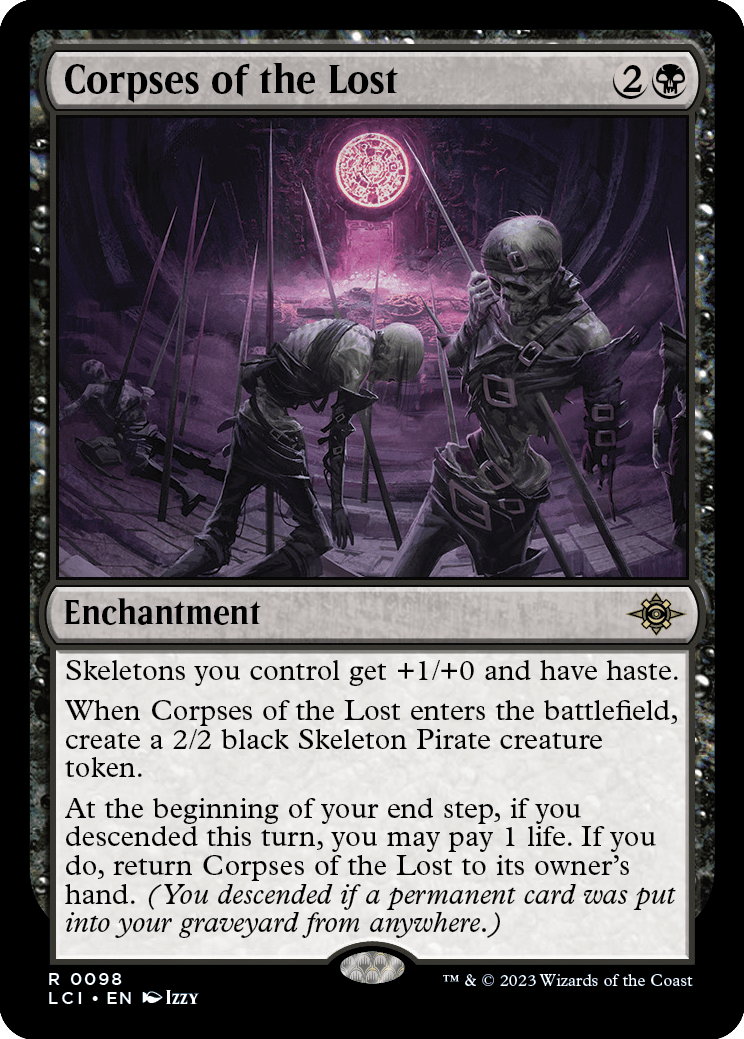
Corpses of the Lost
Enchantment
Skeletons you control get +1/+0 and have haste.
When Corpses of the Lost enters the battlefield, create a 2/2 black Skeleton Pirate creature token.
At the beginning of your end step, if you descended this turn, you may pay 1 life. If you do, return Corpses of the Lost to its owner's hand. (You descended if a permanent card was put into your graveyard from anywhere.)
- You decide to pay 1 life as the last ability is resolving. If you decide to pay 1 life and Corpses of the Lost is still on the battlefield, it will immediately return to its owner's hand. No player may take any actions in between you deciding to pay life and it returning this way.
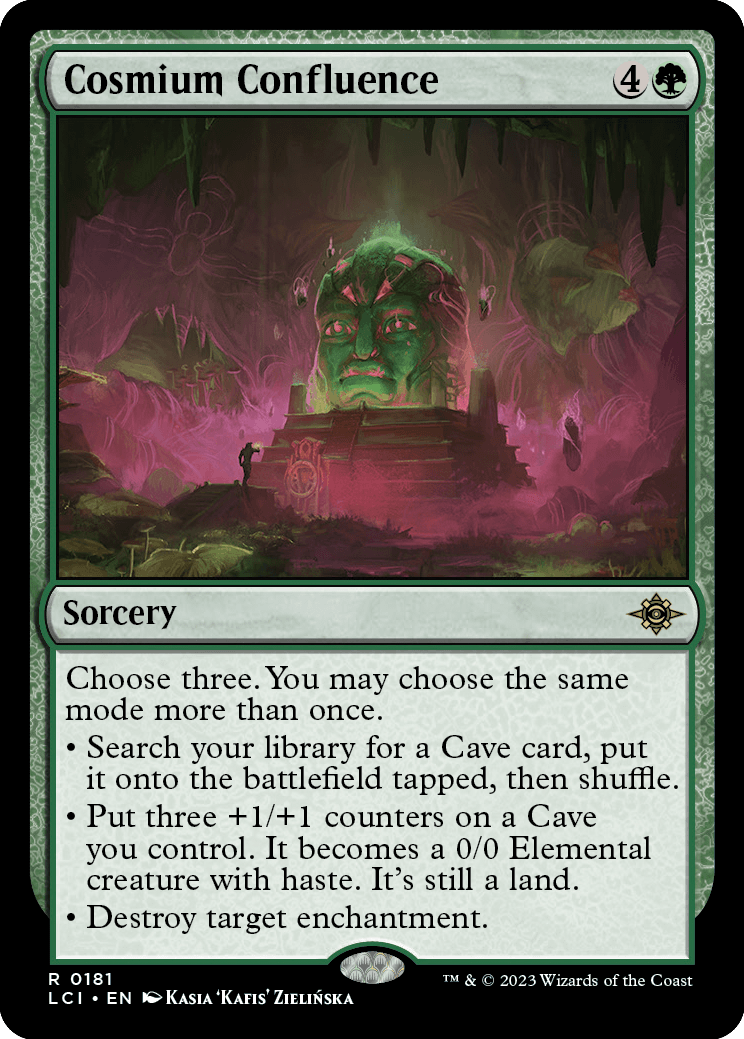
Cosmium Confluence
Sorcery
Choose three. You may choose the same mode more than once.
• Search your library for a Cave card, put it onto the battlefield tapped, then shuffle.
• Put three +1/+1 counters on a Cave you control. It becomes a 0/0 Elemental creature with haste. It's still a land.
• Destroy target enchantment.
- You choose the modes as you cast the spell. Once modes are chosen, they can't be changed.
- If a mode requires a target, you can select that mode only if there's a legal target available. Ignore the targeting requirements for modes you don't choose. Each time you select that mode, you can choose a different target, or you can choose the same target.
- Notably, the second mode doesn't require any targets. You choose the Cave you control that will be affected as Cosmium Confluence is resolving. You may choose a Cave you just put onto the battlefield with the first mode, if applicable.
- No matter which combination of modes you choose, you always follow the instructions in the order they are written.
- If the same mode is chosen more than once, you choose their relative order as you cast the spell. For example, if you choose the last mode of Cosmium Confluence more than once, you choose the relative order to destroy the target enchantments.
- No player can cast spells or activate abilities in between the modes of a resolving spell. Any abilities that trigger won't be put onto the stack until a spell is done resolving.
- If a Confluence is copied, the effect that creates the copy will usually allow you to choose new targets, but you can't choose new modes.
- If all targets for the chosen modes become illegal before a Confluence resolves, the spell will be countered and none of its effects will happen. If at least one target is still legal, the spell will resolve but will have no effect on any illegal targets.
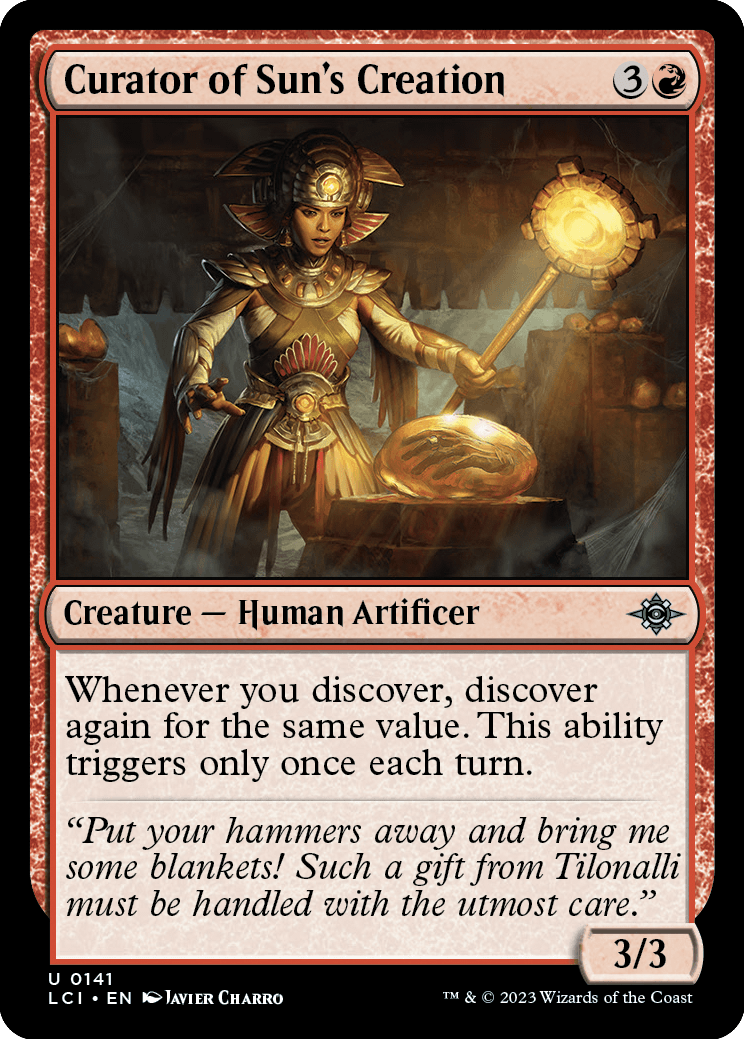
Curator of Sun's Creation
Creature — Human Artificer
3/3
Whenever you discover, discover again for the same value. This ability triggers only once each turn.
- You "discover" when you finish the process of revealing cards, exiling an appropriate nonland card, casting that card or putting it into your hand, and putting the remaining exiled cards on the bottom of your library in a random order, even if one or more of those actions were impossible for some reason.
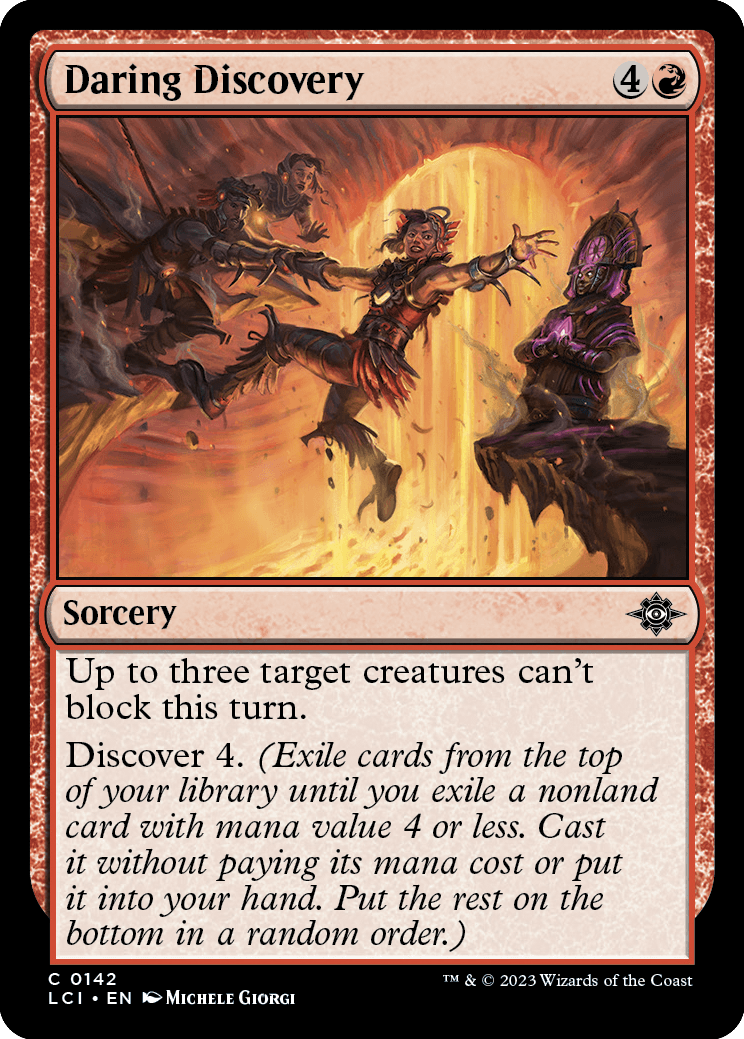
Daring Discovery
Sorcery
Up to three target creatures can't block this turn.
Discover 4. (Exile cards from the top of your library until you exile a nonland card with mana value 4 or less. Cast it without paying its mana cost or put it into your hand. Put the rest on the bottom in a random order.)
- You can cast Daring Discovery with no targets and just discover 4. However, if you choose any targets, and all of those targets are illegal by the time Daring Discovery tries to resolve, it won't resolve and none of its effects will happen. You won't discover 4. As long as one target remains legal, any legal targets won't be able to block this turn, any illegal targets won't be affected, and you'll discover 4.
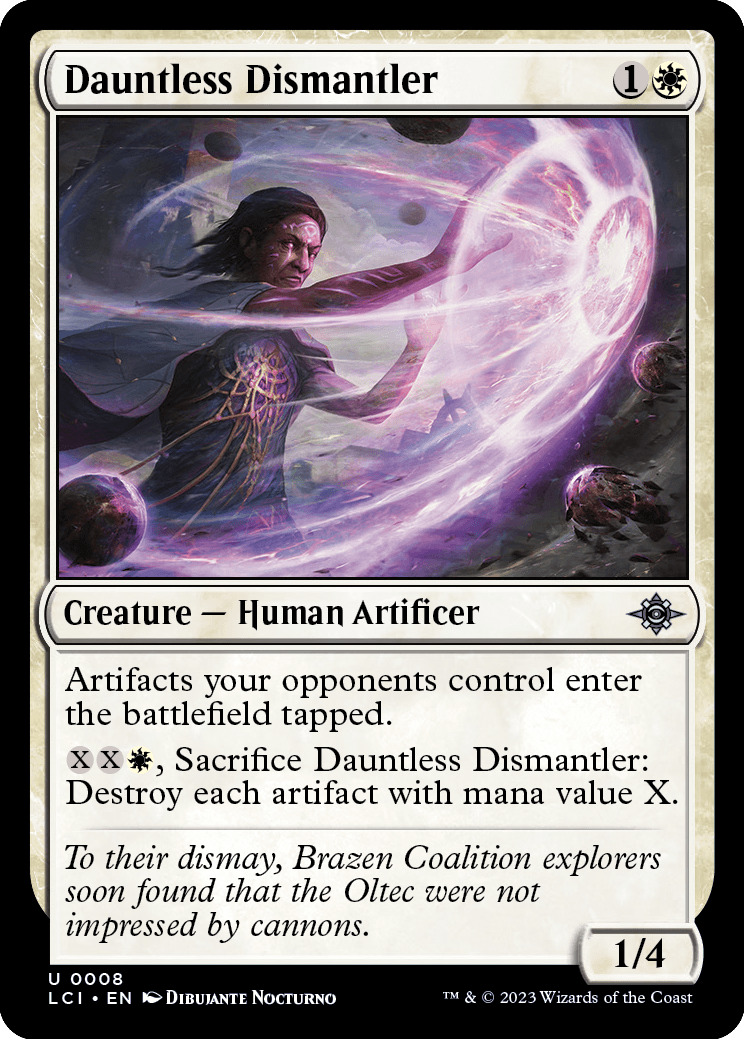
Dauntless Dismantler
Creature — Human Artificer
1/4
Artifacts your opponents control enter the battlefield tapped.
, Sacrifice Dauntless Dismantler: Destroy each artifact with mana value X.
- If an artifact an opponent controls enters the battlefield at the same time that Dauntless Dismantler enters the battlefield, Dauntless Dismantler's effect won't apply to that artifact.
- Dauntless Dismantler's last ability destroys only artifacts whose mana values are exactly X.
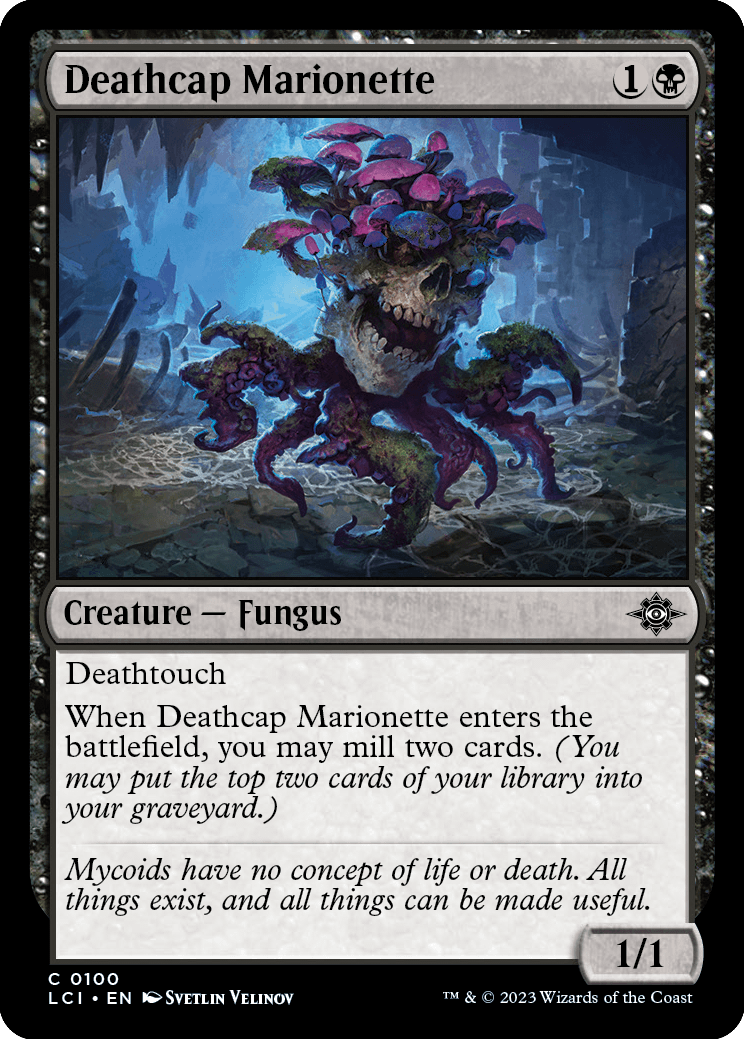
Deathcap Marionette
Creature — Fungus
1/1
Deathtouch
When Deathcap Marionette enters the battlefield, you may mill two cards. (You may put the top two cards of your library into your graveyard.)
- If you don't have at least two cards in your library, you can't choose to mill two cards.
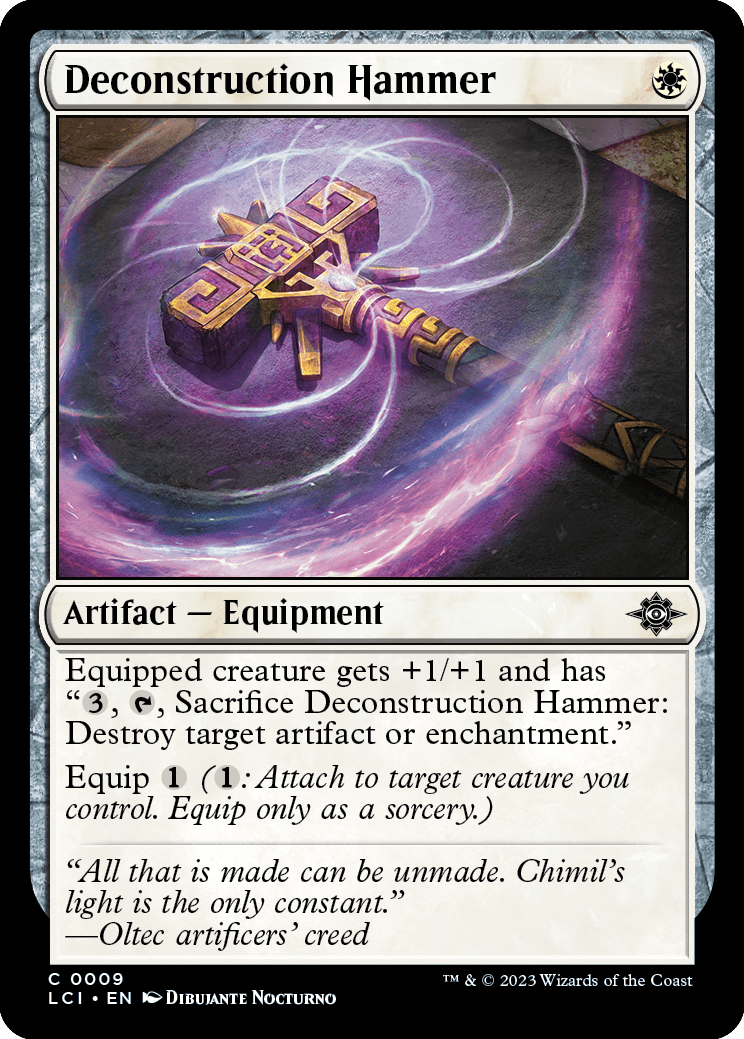
Deconstruction Hammer
Artifact — Equipment
Equipped creature gets +1/+1 and has ", , Sacrifice Deconstruction Hammer: Destroy target artifact or enchantment."
Equip (: Attach to target creature you control. Equip only as a sorcery.)
- If Deconstruction Hammer somehow ends up attached to a creature controlled by a different player, that player won't be able to activate the granted ability, as they can't pay the cost of sacrificing Deconstruction Hammer, a permanent they don't control.
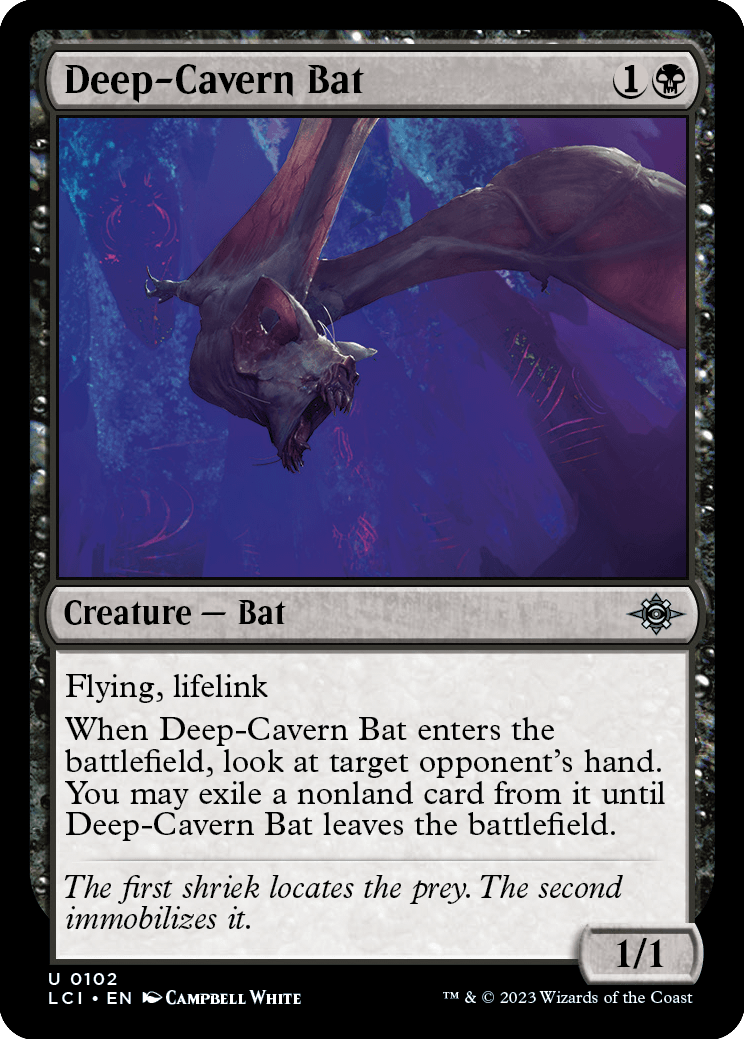
Deep-Cavern Bat
Creature — Bat
1/1
Flying, lifelink
When Deep-Cavern Bat enters the battlefield, look at target opponent's hand. You may exile a nonland card from it until Deep-Cavern Bat leaves the battlefield.
- If Deep-Cavern Bat leaves the battlefield before its last ability resolves, you'll still look at the target opponent's hand, but you won't exile any cards from it.
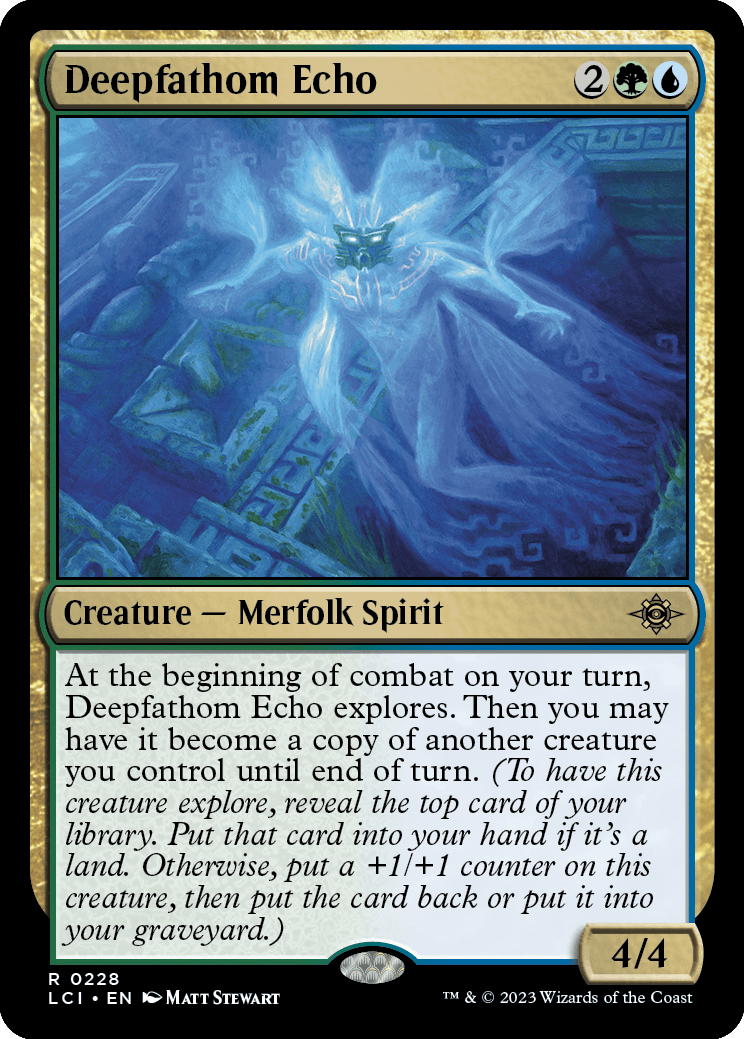
Deepfathom Echo
Creature — Merfolk Spirit
4/4
At the beginning of combat on your turn, Deepfathom Echo explores. Then you may have it become a copy of another creature you control until end of turn. (To have this creature explore, reveal the top card of your library. Put that card into your hand if it's a land. Otherwise, put a +1/+1 counter on this creature, then put the card back or put it into your graveyard.)
- Once Deepfathom Echo becomes a copy of another creature, it no longer has its triggered ability until end of turn.
- Deepfathom Echo copies exactly what is printed on the chosen creature (unless that creature is copying something else or is a token; see below). It doesn't copy whether that creature is tapped or untapped, whether it has any counters on it or any Auras and Equipment attached to it, or any non-copy effects that have changed its power, toughness, types, color, or so on.
- Non-copy effects that have already applied to Deepfathom Echo will continue to apply to it. For example, +1/+1 counters on it will still affect it.
- If the copied creature has in its mana cost, X is 0.
- If Deepfathom Echo becomes a copy of a creature that is copying something else, it becomes a copy of whatever that creature is a copy of.
- If the copied creature is a token, Deepfathom Echo copies the original characteristics of that token as stated by the effect that created that token. Deepfathom Echo doesn't become a token (although it might already be one).
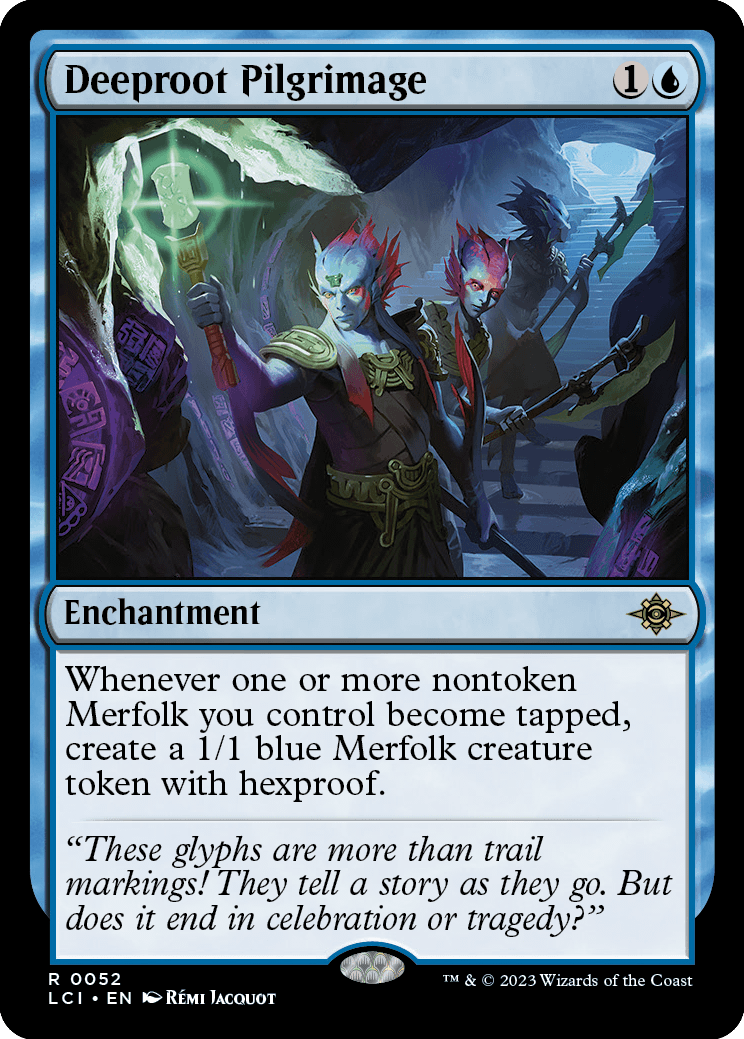
Deeproot Pilgrimage
Enchantment
Whenever one or more nontoken Merfolk you control become tapped, create a 1/1 blue Merfolk creature token with hexproof.
- If more than one nontoken Merfolk you control becomes tapped at the same time (for example, to pay the cost of Adaptive Gemguard's activated ability), Deeproot Pilgrimage's ability will trigger only once.
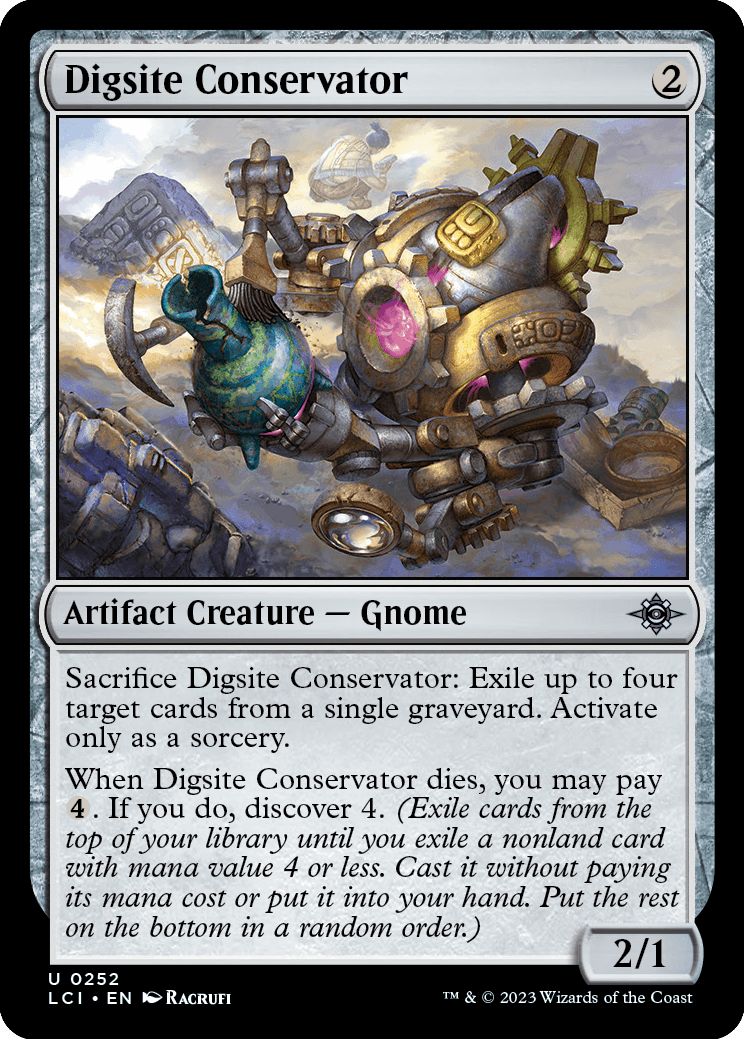
Digsite Conservator
Artifact Creature — Gnome
2/1
Sacrifice Digsite Conservator: Exile up to four target cards from a single graveyard. Activate only as a sorcery.
When Digsite Conservator dies, you may pay . If you do, discover 4. (Exile cards from the top of your library until you exile a nonland card with mana value 4 or less. Cast it without paying its mana cost or put it into your hand. Put the rest on the bottom in a random order.)
- Digsite Conservator's triggered ability will trigger if it dies for any reason, not only because you sacrificed it due to its activated ability.


Dire Flail
Artifact — Equipment
Equipped creature gets +2/+0.
Equip
Craft with artifact (, Exile this artifact, Exile another artifact you control or an artifact card from your graveyard: Return this card transformed under its owner's control. Craft only as a sorcery.)
////
Dire Blunderbuss
Artifact — Equipment
Equipped creature gets +3/+0 and has "Whenever this creature attacks, you may sacrifice an artifact other than Dire Blunderbuss. When you do, this creature deals damage equal to its power to target creature."
Equip
- You don't choose a target for the triggered ability granted by Dire Blunderbuss at the time it triggers. Rather, a second "reflexive" ability triggers when you sacrifice another artifact this way. You choose targets for that ability as it goes on the stack. Each player may respond to this triggered ability as normal.
- Use the equipped creature's power as the reflexive triggered ability granted by Dire Blunderbuss resolves to determine how much damage is dealt. If the equipped creature is no longer on the battlefield at that time, use its power as it last existed on the battlefield.
- If the equipped creature isn't on the battlefield as the reflexive triggered ability granted by Dire Blunderbuss resolves but it had lifelink when it left the battlefield, you will gain life.
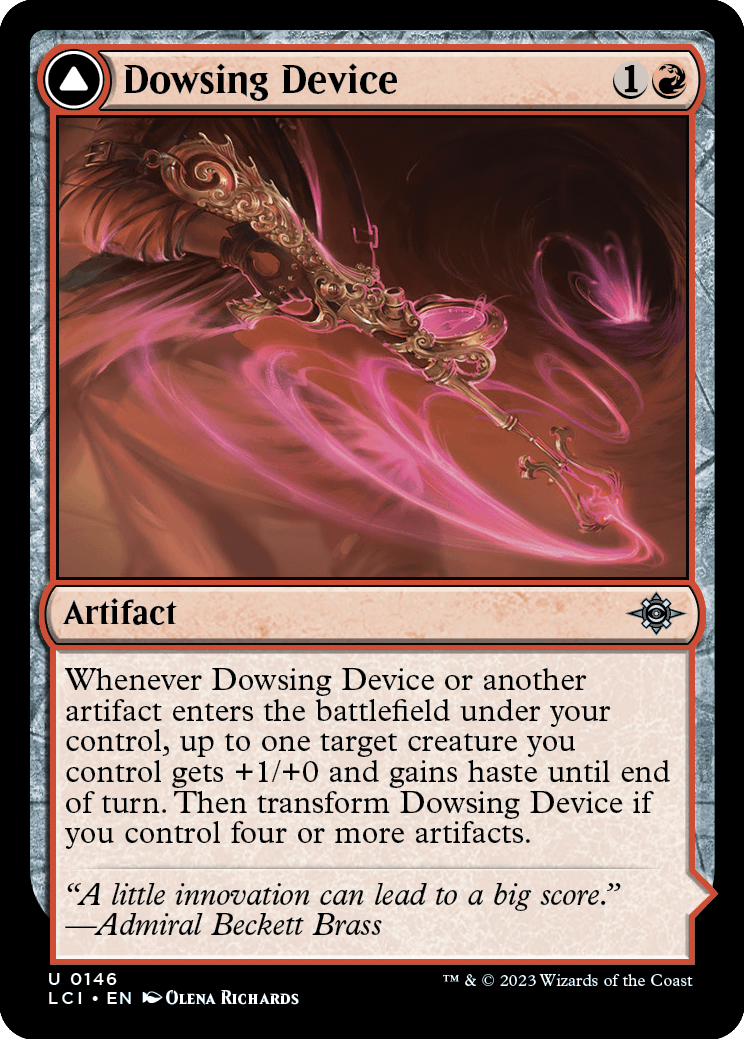
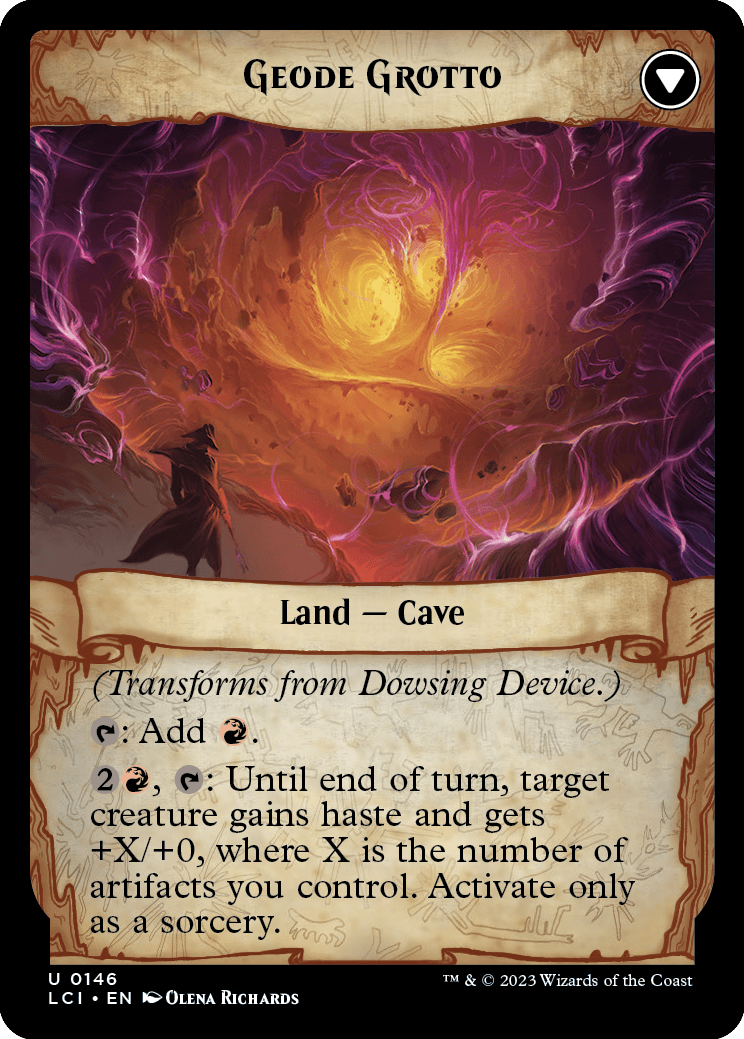
Dowsing Device
Artifact
Whenever Dowsing Device or another artifact enters the battlefield under your control, up to one target creature you control gets +1/+0 and gains haste until end of turn. Then transform Dowsing Device if you control four or more artifacts.
////
Geode Grotto
Land — Cave
(Transforms from Dowsing Device.)
: Add .
, : Until end of turn, target creature gains haste and gets +X/+0, where X is the number of artifacts you control. Activate only as a sorcery.
- The value of X for Geode Grotto's last ability is determined only as it resolves. Once that happens, the value of X won't change later in the turn even if the number of artifacts you control changes.
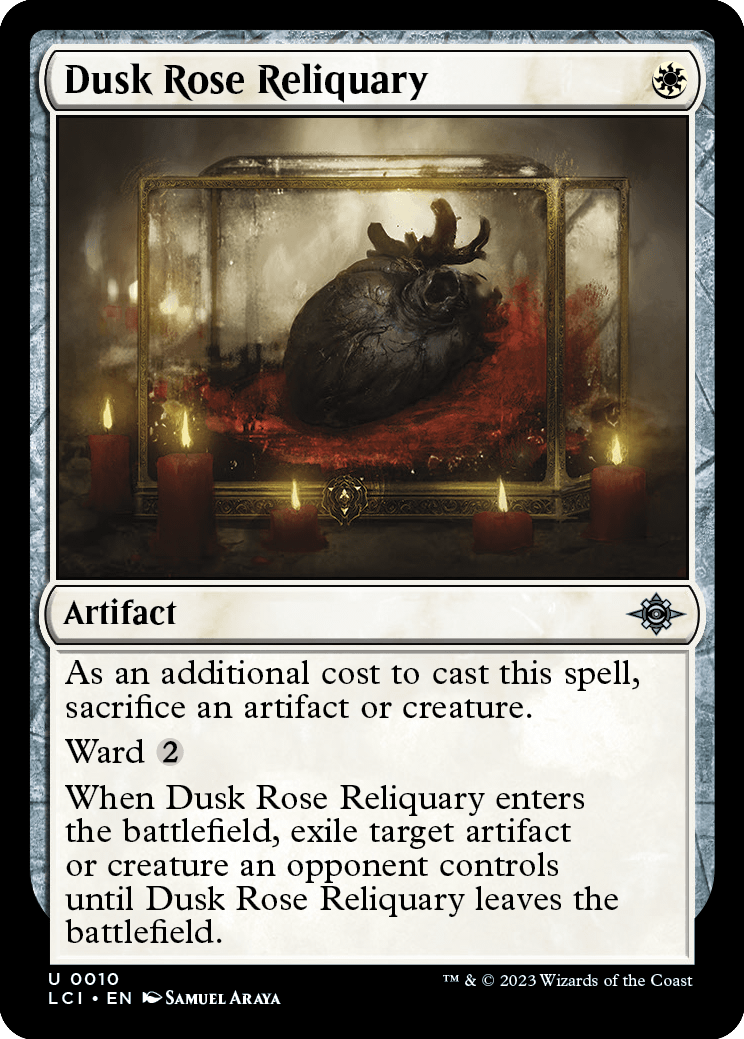
Dusk Rose Reliquary
Artifact
As an additional cost to cast this spell, sacrifice an artifact or creature.
Ward
When Dusk Rose Reliquary enters the battlefield, exile target artifact or creature an opponent controls until Dusk Rose Reliquary leaves the battlefield.
- If Dusk Rose Reliquary leaves the battlefield before its last ability resolves, the target permanent won't be exiled.
- Auras attached to the exiled permanent will be put into their owners' graveyards. Any Equipment will become unattached and remain on the battlefield. Any counters on the exiled permanent will cease to exist. When the card returns to the battlefield, it will be a new object with no connection to the card that was exiled.
- If a token is exiled this way, it will cease to exist and won't return to the battlefield.
- If a double-faced card is exiled this way, it will return with its front face up, no matter which face was up when it left the battlefield.
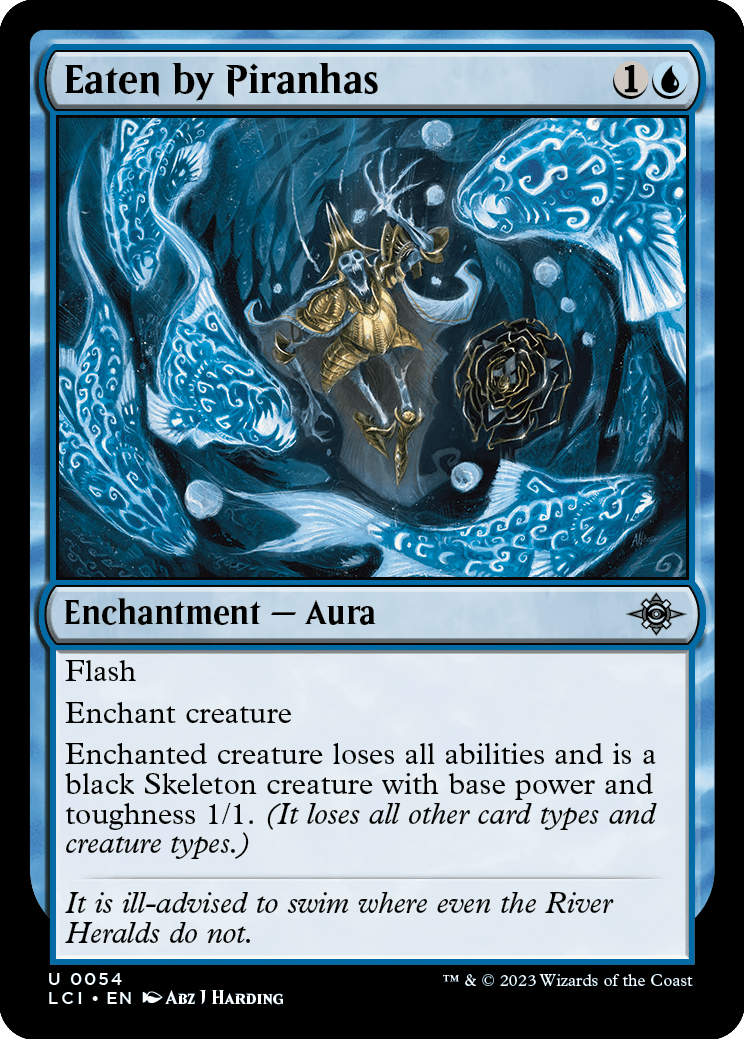
Eaten by Piranhas
Enchantment — Aura
Flash
Enchant creature
Enchanted creature loses all abilities and is a black Skeleton creature with base power and toughness 1/1. (It loses all other card types and creature types.)
- Eaten by Piranhas overwrites all previous effects that set the creature's base power and toughness to specific values. Any power- or toughness-setting effects that start to apply afterward will overwrite this effect.
- Effects that modify the creature's power and/or toughness, such as the effect of Staggering Size, will apply to the creature no matter when they started to take effect. The same is true for counters that change its power and/or toughness and effects that switch its power and toughness.
- If the enchanted creature had any subtypes other than creature types, such as Equipment, Vehicle, or Cave, it loses those as well.
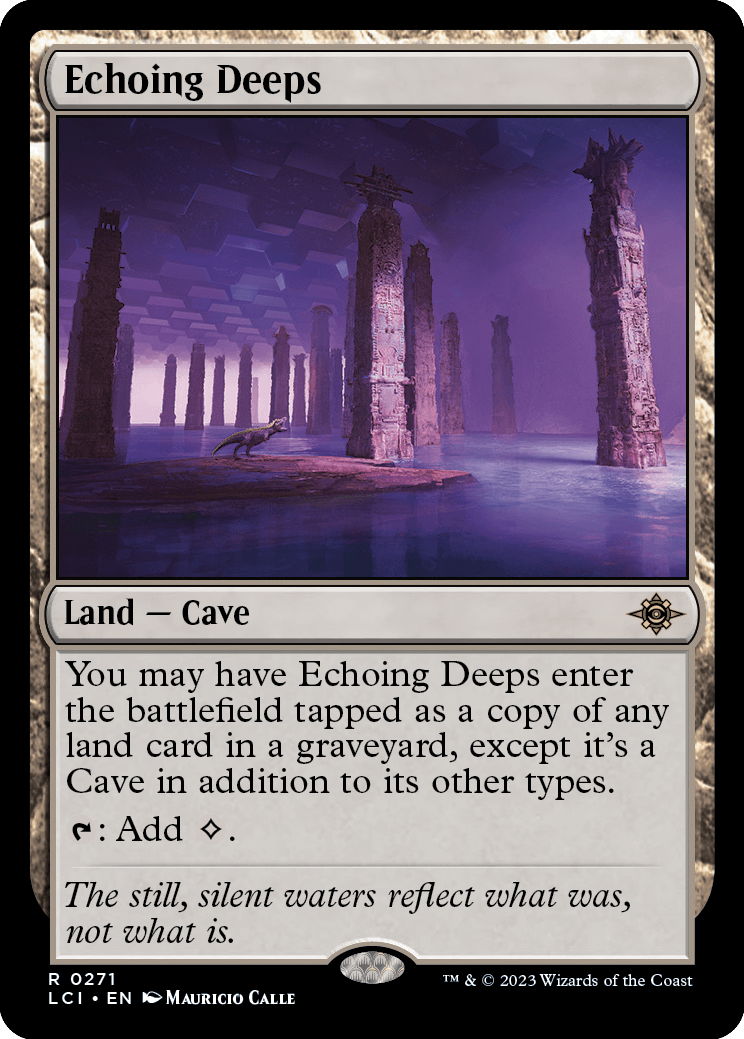
Echoing Deeps
Land — Cave
You may have Echoing Deeps enter the battlefield tapped as a copy of any land card in a graveyard, except it's a Cave in addition to its other types.
: Add .
- If you choose to have Echoing Deeps not copy anything, it enters the battlefield untapped.
- Echoing Deeps copies exactly what was printed on the original land card, with the noted exception.
- Any enters-the-battlefield abilities of the copied land card will trigger when Echoing Deeps enters the battlefield. Any "as [this land] enters the battlefield" or "[this land] enters the battlefield with" abilities of the chosen land card will also work.
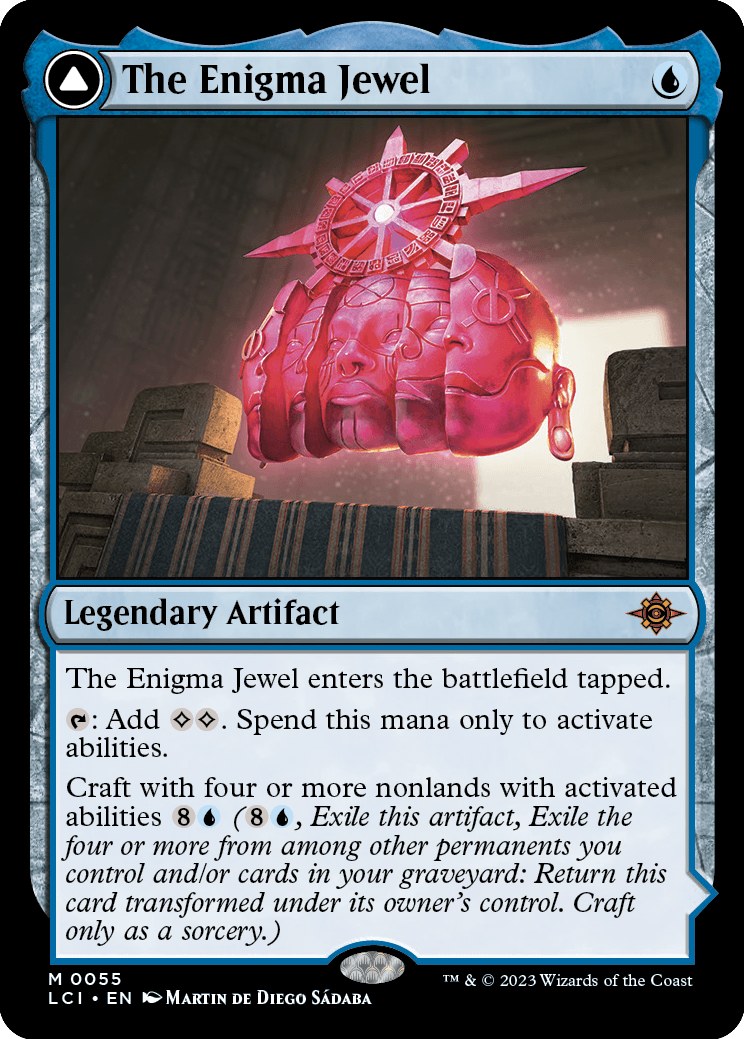
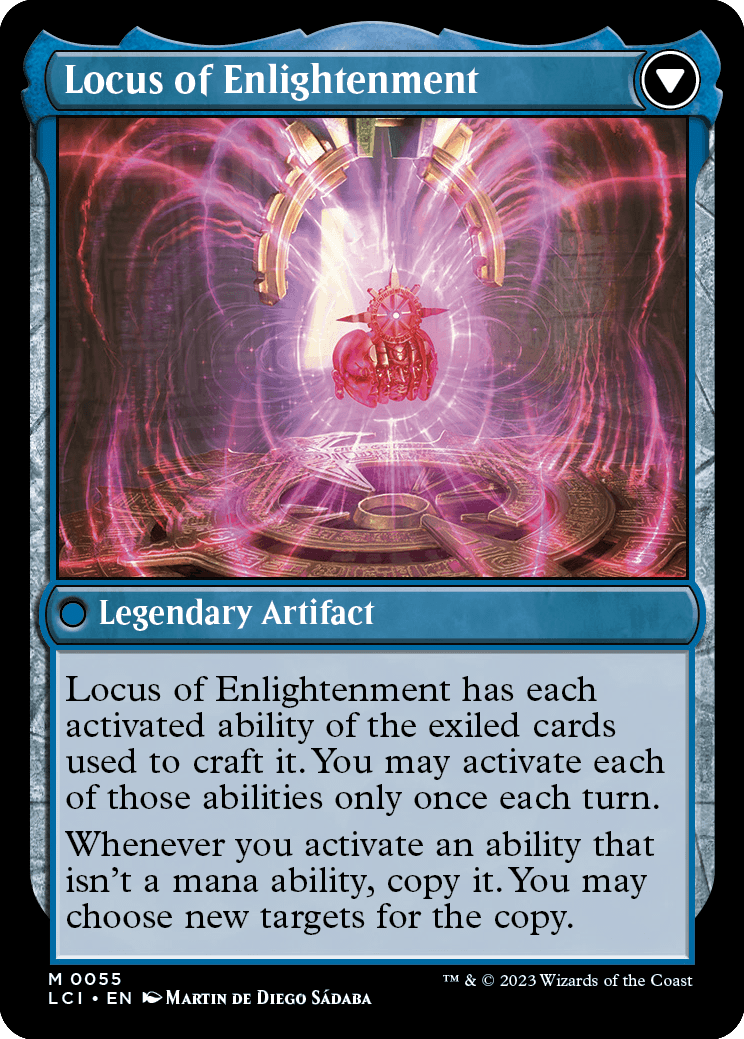
The Enigma Jewel
Legendary Artifact
The Enigma Jewel enters the battlefield tapped.
: Add . Spend this mana only to activate abilities.
Craft with four or more nonlands with activated abilities (, Exile this artifact, Exile the four or more from among other permanents you control and/or cards in your graveyard: Return this card transformed under its owner's control. Craft only as a sorcery.)
////
Locus of Enlightenment
Legendary Artifact
Locus of Enlightenment has each activated ability of the exiled cards used to craft it. You may activate each of those abilities only once each turn.
Whenever you activate an ability that isn't a mana ability, copy it. You may choose new targets for the copy.
- Craft abilities are activated abilities. You can spend mana from The Enigma Jewel's activated ability to activate its own craft ability, for example.
- Activated abilities contain a colon. They're generally written "[Cost]: [Effect]." Some keyword abilities are activated abilities and will have colons in their reminder text.
- Locus of Enlightenment has only the activated abilities of the exiled cards used to craft it. It doesn't gain keyword abilities (unless those keyword abilities are activated), triggered abilities, or static abilities.
- If an activated ability of an exiled card used to craft Locus of Enlightenment references the card it's printed on by name, treat Locus of Enlightenment's version of that ability as though it referenced Locus of Enlightenment instead.
- The "only once each turn" restriction applies to each ability individually, even if multiples of the same card were exiled to craft Locus of Enlightenment. For example, if two of the same card were exiled to craft Locus of Enlightenment, it will have two instances of each of that card's activated abilities. Each of those abilities may be activated once each turn.
- An activated mana ability is one that produces mana as it resolves, not one that costs mana to activate.
- The copy of the activated ability created by Locus of Enlightenment's triggered ability resolves before the original ability.
- The copy is created on the stack, so it's not "activated." Abilities that trigger when a player activates an ability (such as Locus of Enlightenment's own triggered ability) won't trigger.
- If the ability that's copied is modal (that is, it says "Choose one —" or the like), the copy will have the same mode or modes. You can't choose different ones.
- If the ability that's copied has an X whose value was determined as it was cast, the copy has the same value of X.
- If the ability has damage divided as it was put onto the stack, the division can't be changed, although the targets receiving that damage still can. The same is true of abilities that distribute counters.
- Any choices made when the ability resolves won't have been made yet when it's copied. Any such choices will be made separately when the copy resolves.
- The copy will have the same targets as the ability it's copying unless you choose new ones. You may change any number of the targets, including all of them or none of them.
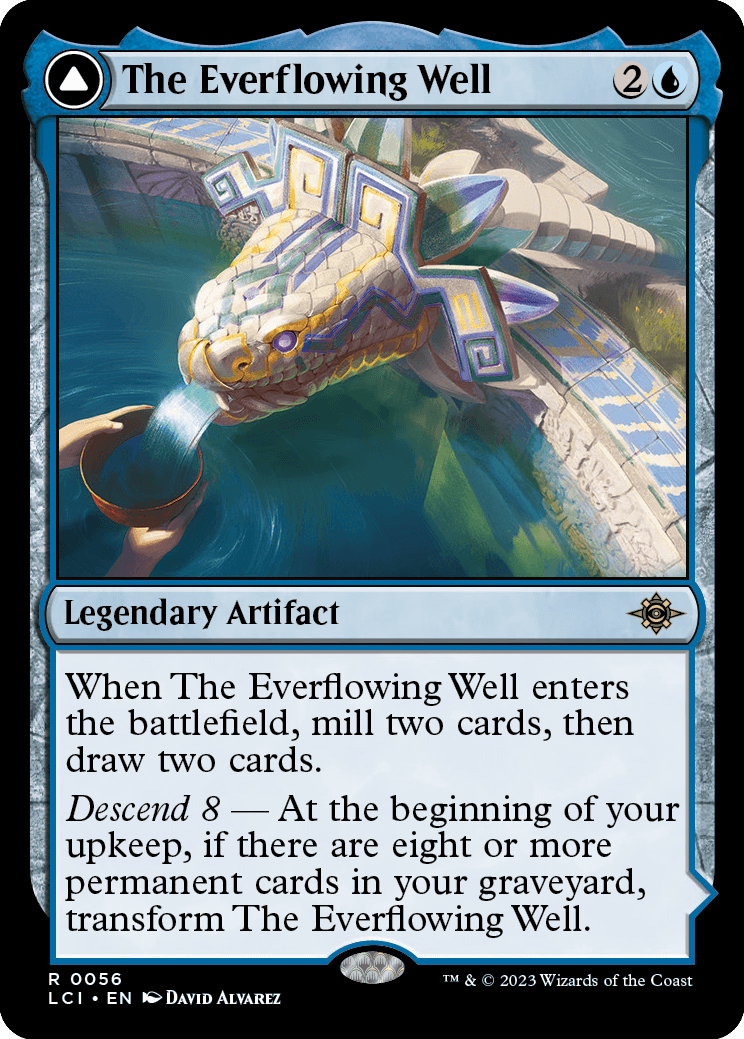
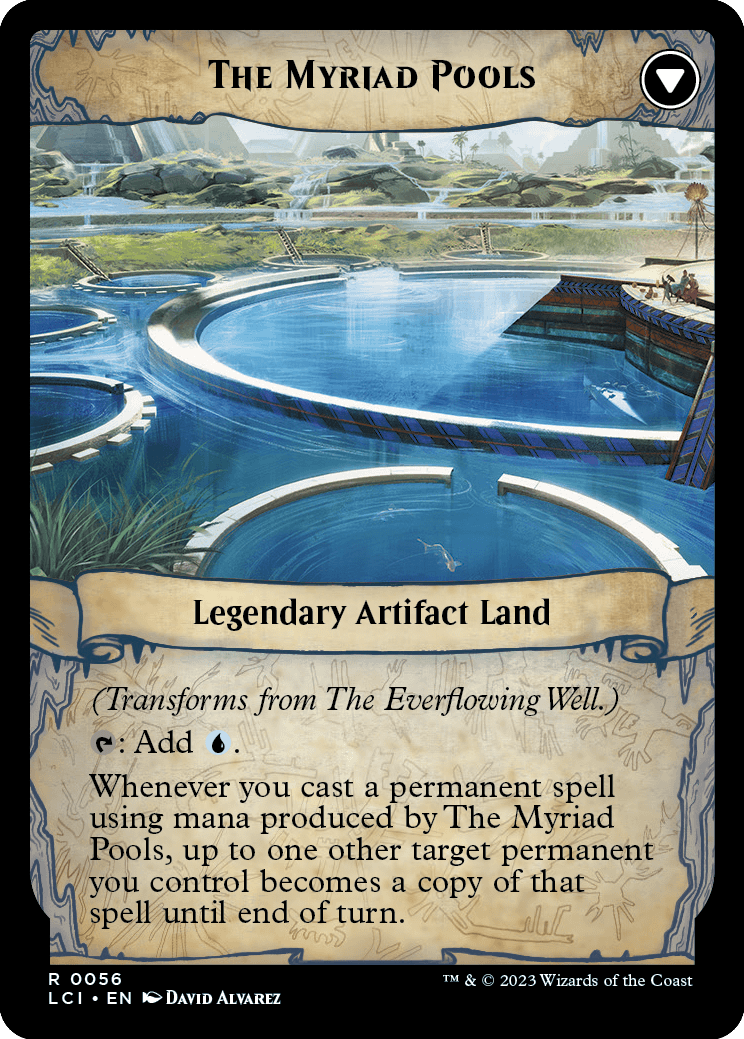
The Everflowing Well
Legendary Artifact
When The Everflowing Well enters the battlefield, mill two cards, then draw two cards.
Descend 8 — At the beginning of your upkeep, if there are eight or more permanent cards in your graveyard, transform The Everflowing Well.
////
The Myriad Pools
Legendary Artifact Land
(Transforms from The Everflowing Well.)
: Add .
Whenever you cast a permanent spell using mana produced by The Myriad Pools, up to one other target permanent you control becomes a copy of that spell until end of turn.
- The triggered ability of Myriad Pools will resolve before the spell that caused it to trigger.
- The target permanent copies what is printed on the original card, plus any choices that were made when casting the spell.
- If the copied spell has in its mana cost, X is still 0 for the purposes of determining the mana value of the permanent on the battlefield.
- Non-copy effects that have already applied to the target permanent will continue to apply to it. For example, if it's a creature, +1/+1 counters on it will still affect it.
- Because the target permanent isn't entering the battlefield when it becomes a copy of a permanent spell, any "When [this permanent] enters the battlefield" or "[This permanent] enters the battlefield with" abilities of the copied spell won't apply for the target permanent.
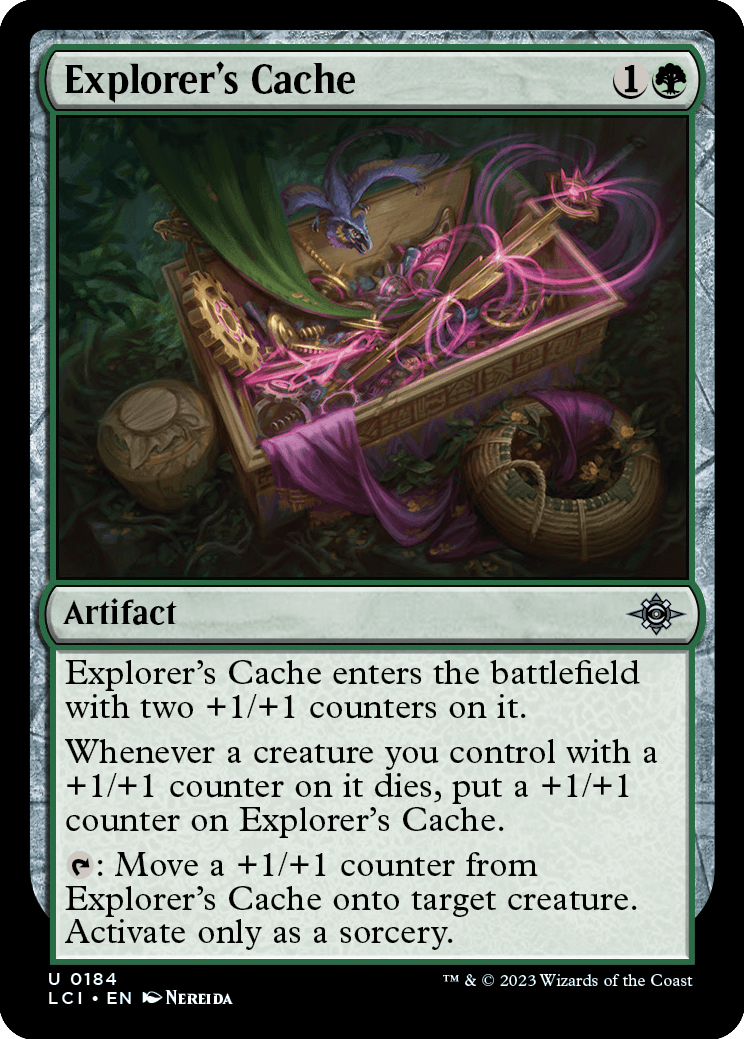
Explorer's Cache
Artifact
Explorer's Cache enters the battlefield with two +1/+1 counters on it.
Whenever a creature you control with a +1/+1 counter on it dies, put a +1/+1 counter on Explorer's Cache.
: Move a +1/+1 counter from Explorer's Cache onto target creature. Activate only as a sorcery.
- To move a counter from one permanent to another, the counter is removed from the first permanent and put on the second. Any abilities that care about a counter being removed from or put onto a permanent will apply.
- If Explorer's Cache isn't on the battlefield as its activated ability resolves, you can't remove a +1/+1 counter from it, so you won't put a +1/+1 counter on the target creature.
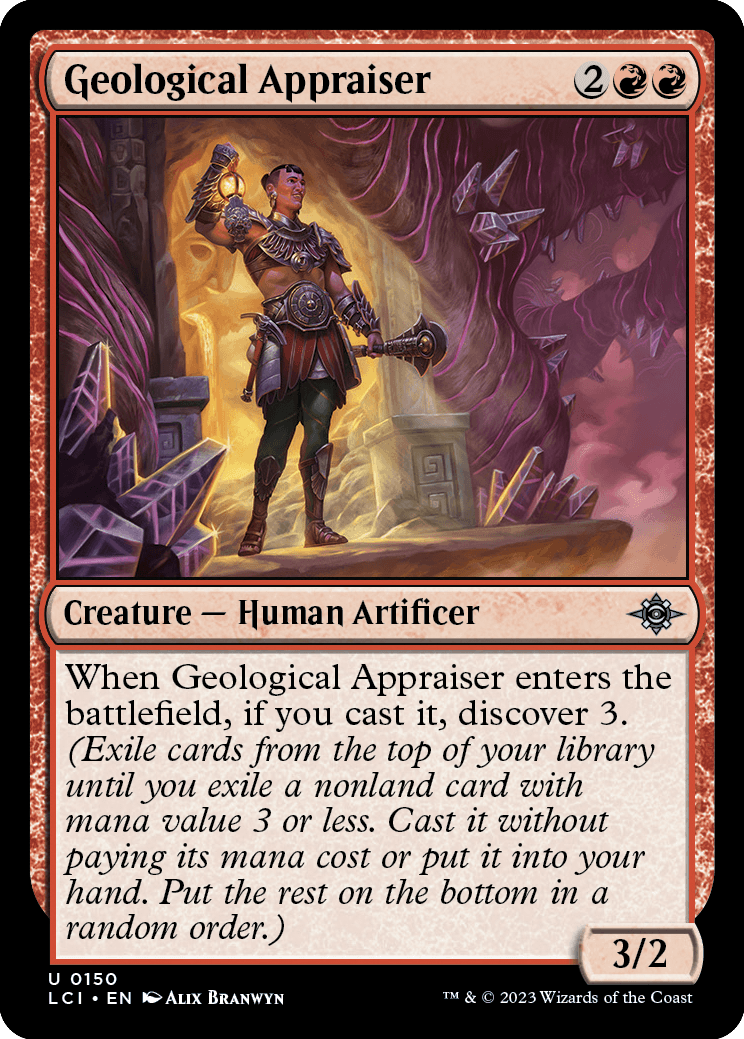
Geological Appraiser
Creature — Human Artificer
3/2
When Geological Appraiser enters the battlefield, if you cast it, discover 3. (Exile cards from the top of your library until you exile a nonland card with mana value 3 or less. Cast it without paying its mana cost or put it into your hand. Put the rest on the bottom in a random order.)
- Geological Appraiser's triggered ability triggers if you cast it from any zone. It doesn't trigger if you put Geological Appraiser onto the battlefield without casting it.
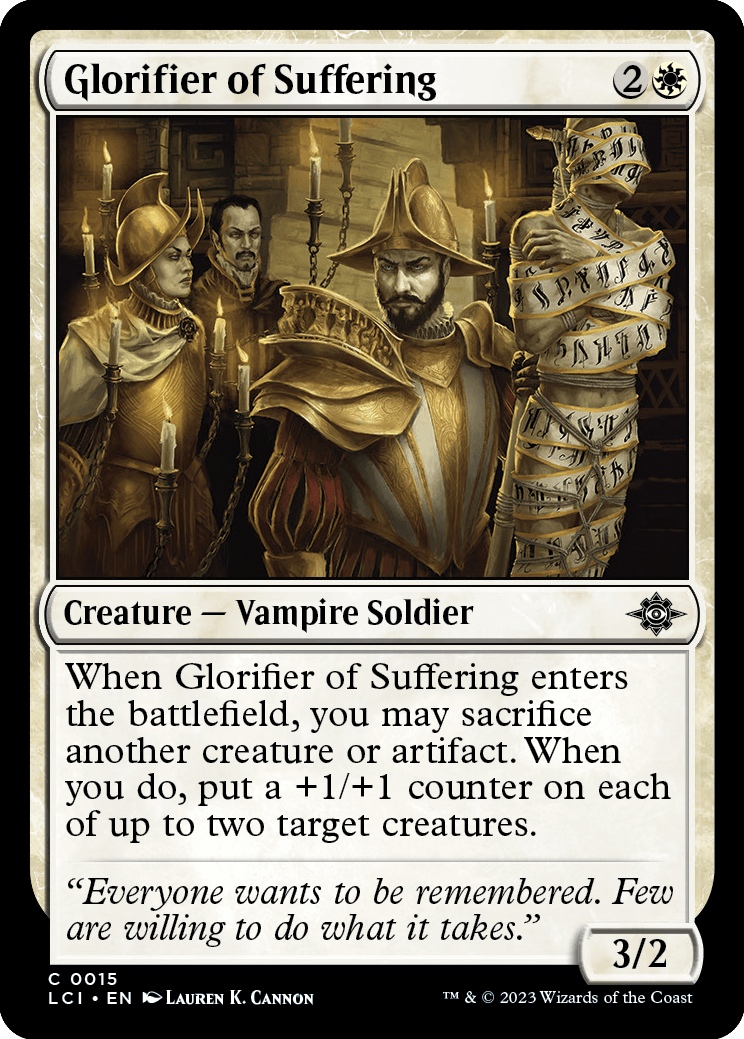
Glorifier of Suffering
Creature — Vampire Soldier
3/2
When Glorifier of Suffering enters the battlefield, you may sacrifice another creature or artifact. When you do, put a +1/+1 counter on each of up to two target creatures.
- You don't choose a target for Glorifier of Suffering's ability at the time it triggers. Rather, a second "reflexive" ability triggers when you sacrifice another creature or artifact this way. You choose targets for that ability as it goes on the stack. Each player may respond to this triggered ability as normal.
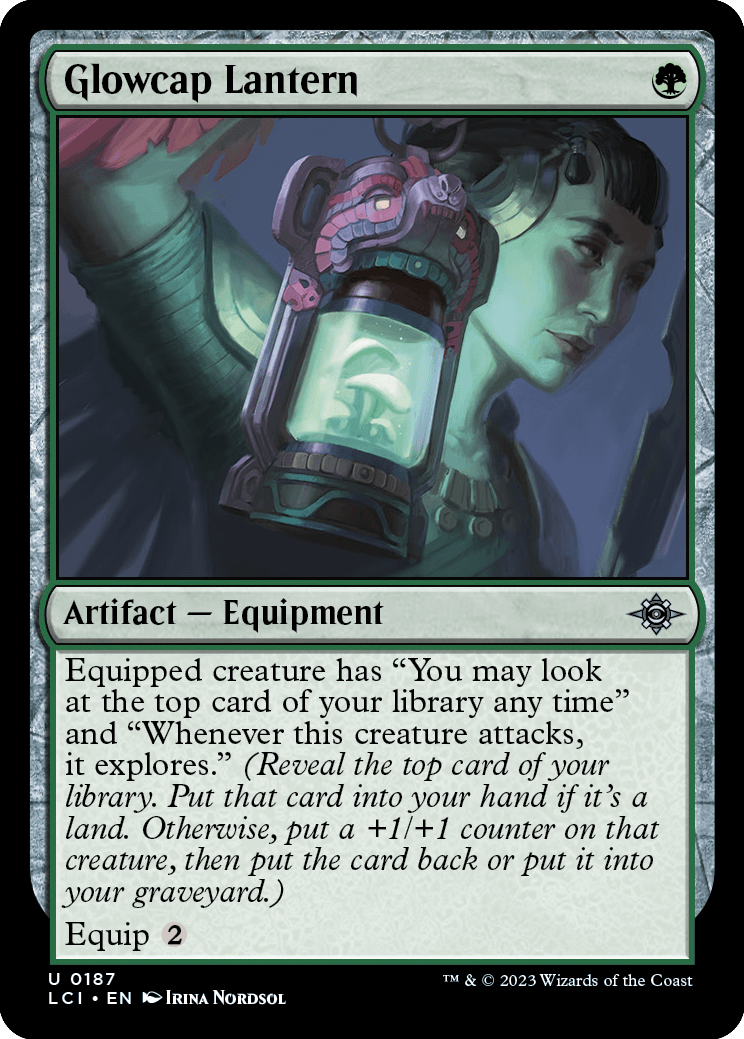
Glowcap Lantern
Artifact — Equipment
Equipped creature has "You may look at the top card of your library any time" and "Whenever this creature attacks, it explores." (Reveal the top card of your library. Put that card into your hand if it's a land. Otherwise, put a +1/+1 counter on that creature, then put the card back or put it into your graveyard.)
Equip
- The ability granted by Glowcap Lantern lets you look at the top card of your library whenever you want (with one restriction—see below), even if you don't have priority. This action doesn't use the stack. Knowing what that card is becomes part of the information you have access to, just like you can look at the cards in your hand.
- If the top card of your library changes while you're casting a spell, playing a land, or activating an ability, you can't look at the new top card until you finish doing so. This means that if you cast the top card of your library, you can't look at the next one until you're done paying for that spell.
- If Glowcap Lantern isn't attached to a creature you control, you can't look at the top card of your library. The lantern isn't that bright.
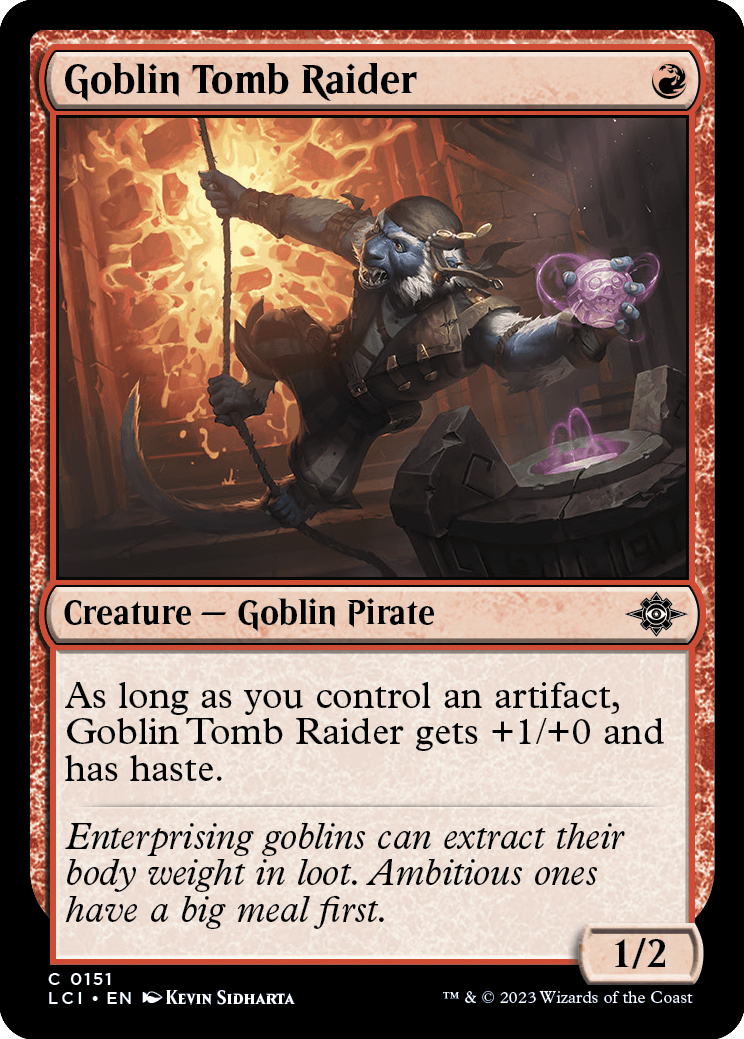
Goblin Tomb Raider
Creature — Goblin Pirate
1/2
As long as you control an artifact, Goblin Tomb Raider gets +1/+0 and has haste.
- Once Goblin Tomb Raider has been declared as an attacker, causing it to lose haste by removing all of your artifacts won't cause it to stop attacking, even if it entered the battlefield or came under your control that turn.
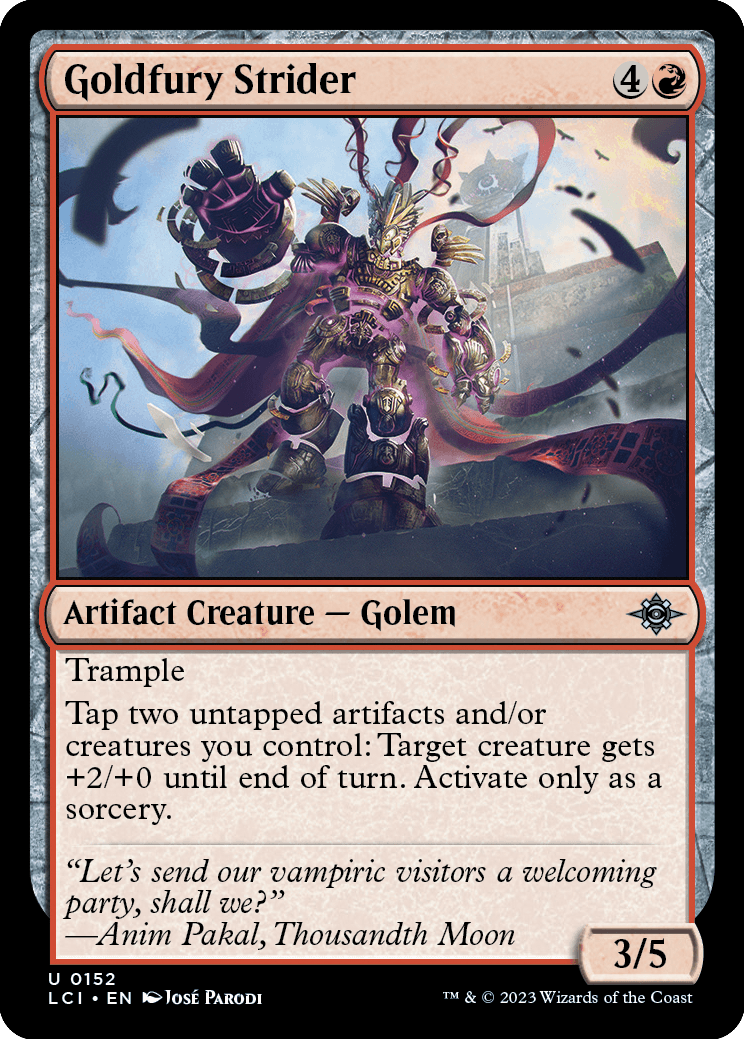
Goldfury Strider
Artifact Creature — Golem
3/5
Trample
Tap two untapped artifacts and/or creatures you control: Target creature gets +2/+0 until end of turn. Activate only as a sorcery.
- You can tap any two untapped artifacts and/or creatures you control, including Goldfury Strider and other creatures you haven't controlled continuously since the beginning of your most recent turn, to pay the cost of Goldfury Strider's activated ability.
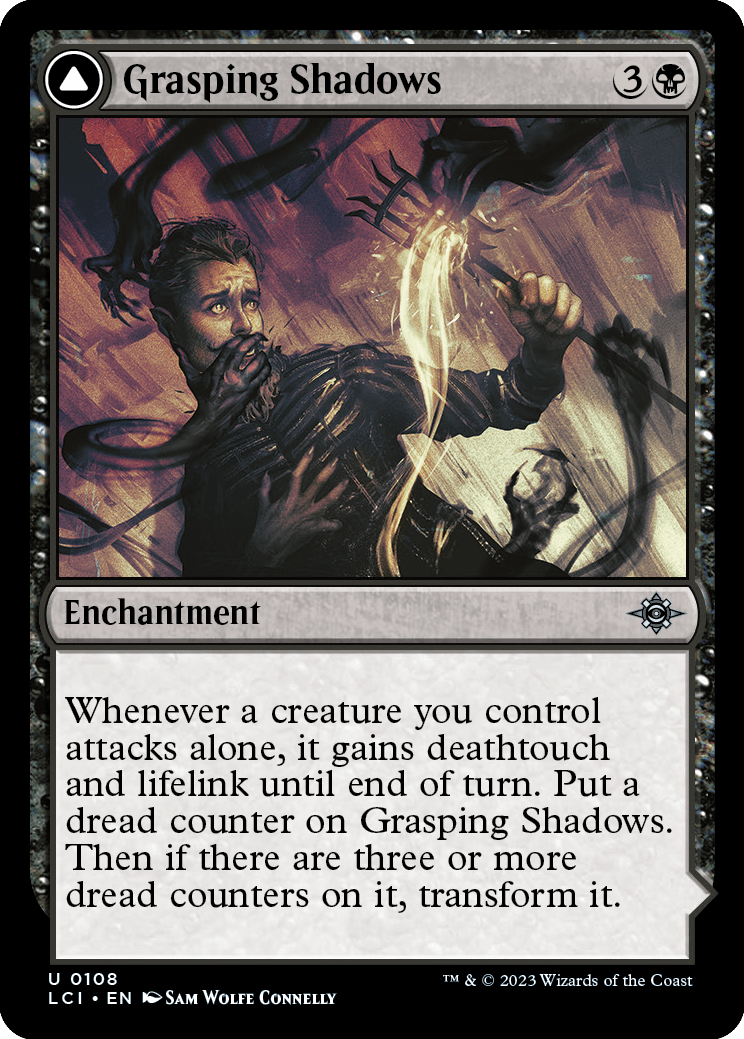
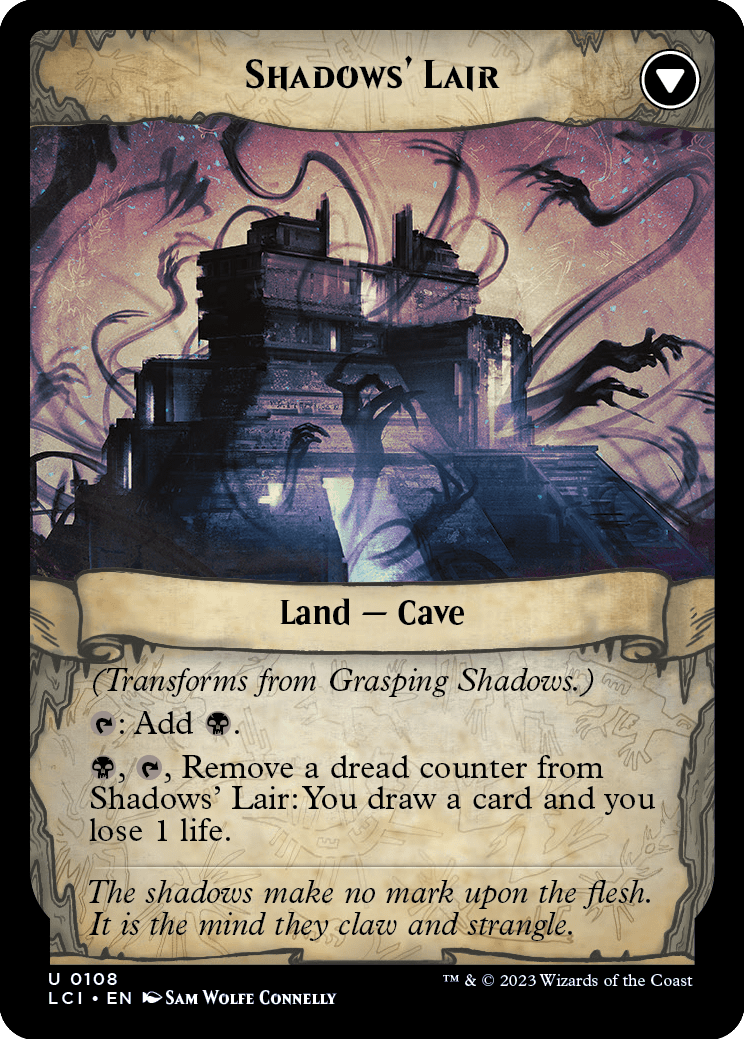
Grasping Shadows
Enchantment
Whenever a creature you control attacks alone, it gains deathtouch and lifelink until end of turn. Put a dread counter on Grasping Shadows. Then if there are three or more dread counters on it, transform it.
////
Shadows' Lair
Land — Cave
(Transforms from Grasping Shadows.)
: Add .
, , Remove a dread counter from Shadows' Lair: You draw a card and you lose 1 life.
- A creature attacks alone if it's the only creature declared as an attacker during the declare attackers step. For example, the triggered ability of Grasping Shadows won't trigger if you attack with multiple creatures and all but one of them are removed from combat.
- Once the ability of Grasping Shadows has triggered, creatures entering the battlefield attacking won't affect that ability.
- Grasping Shadows keeps its dread counters as it transforms into Shadows' Lair.
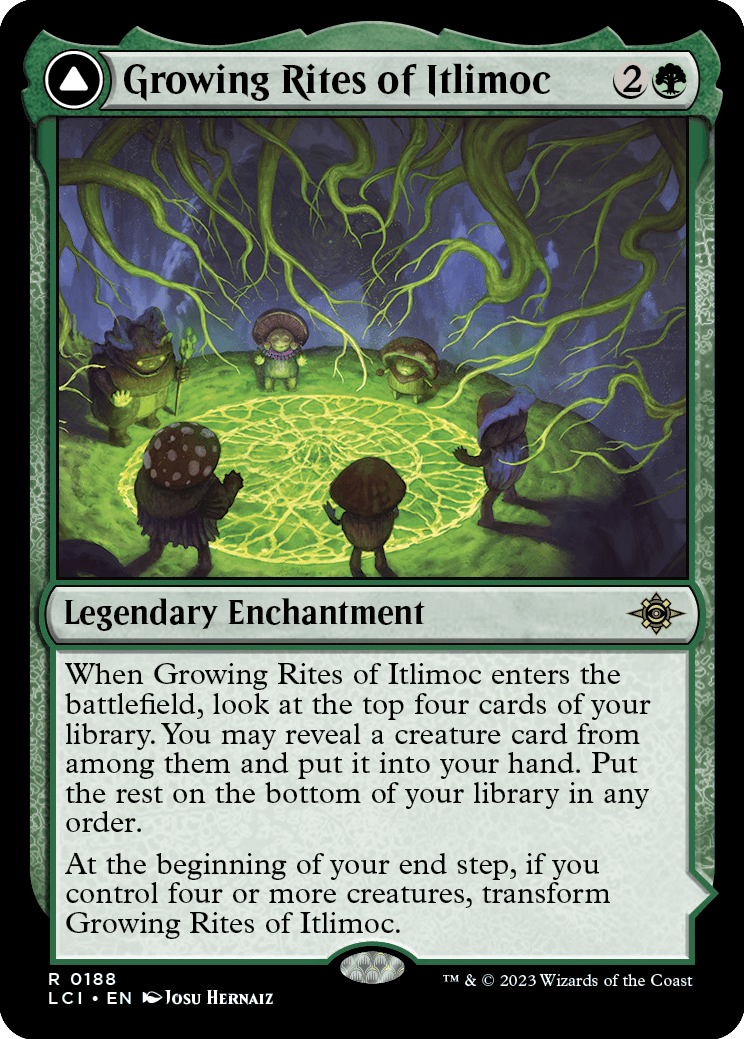
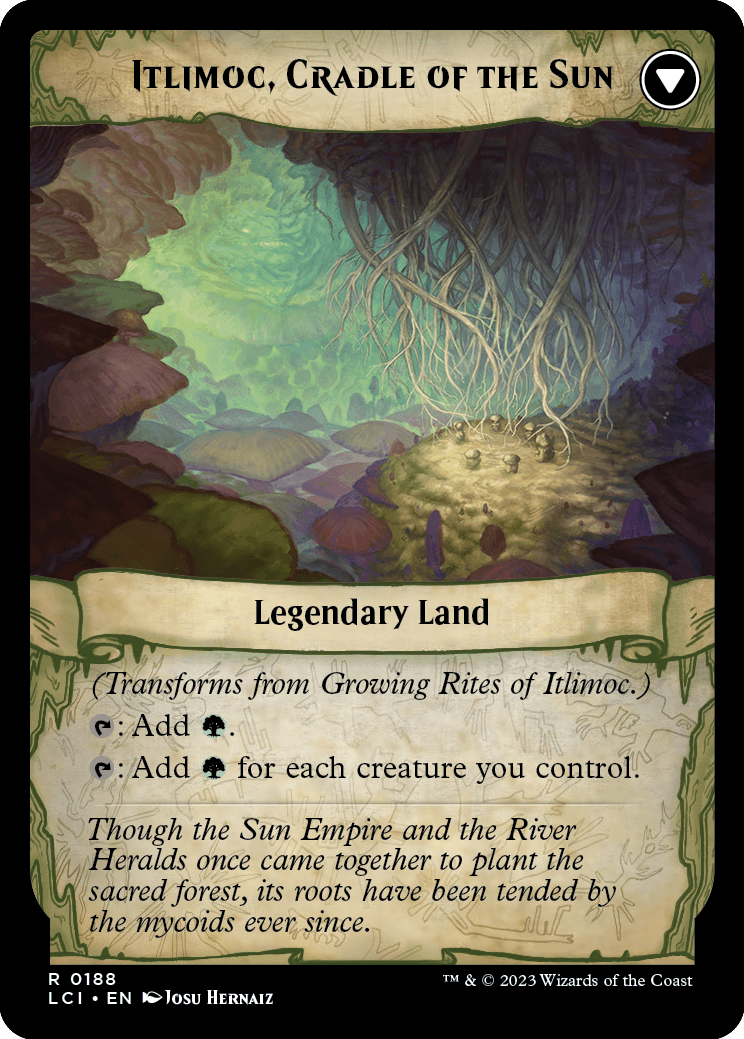
Growing Rites of Itlimoc
Legendary Enchantment
When Growing Rites of Itlimoc enters the battlefield, look at the top four cards of your library. You may reveal a creature card from among them and put it into your hand. Put the rest on the bottom of your library in any order.
At the beginning of your end step, if you control four or more creatures, transform Growing Rites of Itlimoc.
////
Itlimoc, Cradle of the Sun
Legendary Land
(Transforms from Growing Rites of Itlimoc.)
: Add .
: Add for each creature you control.
- The last ability of Growing Rites of Itlimoc doesn't trigger if you don't control four or more creatures as your end step begins. If it does trigger, if you don't control four or more creatures as it tries to resolve, it does nothing.
- If you control a creature that will be removed from the battlefield "at the beginning of the next end step," you can resolve the ability of Growing Rites of Itlimoc before that creature leaves the battlefield.
- If you gain control of a creature "until end of turn," or if a noncreature permanent you control becomes a creature "until end of turn," it'll be a creature under your control through the entire end step.
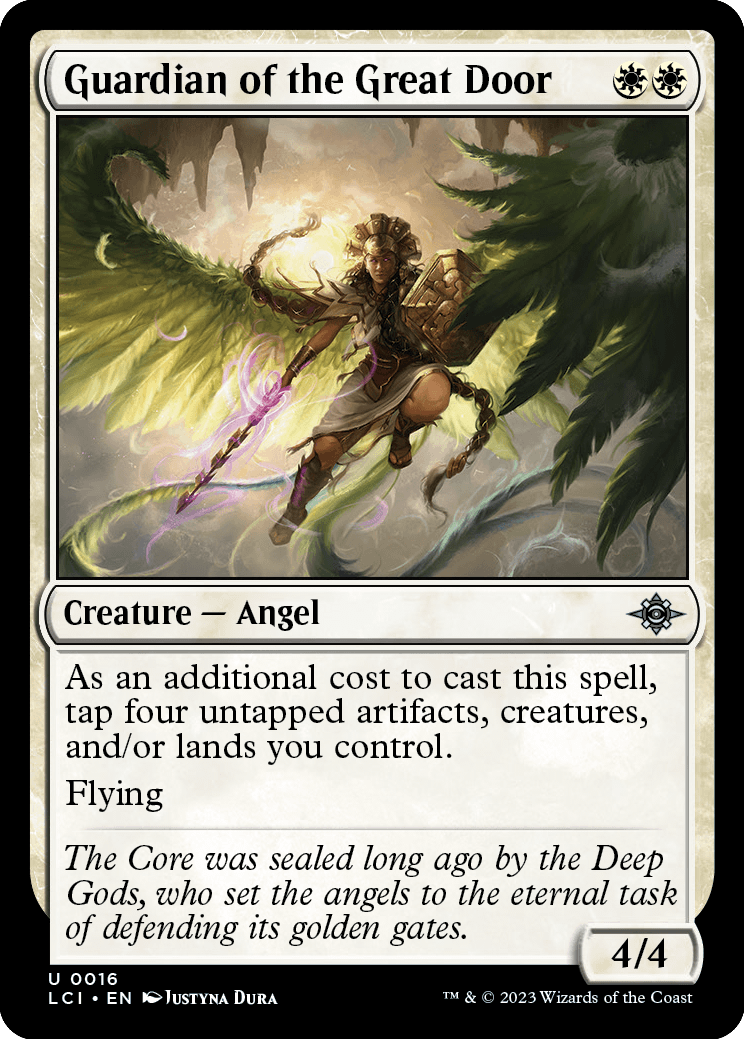
Guardian of the Great Door
Creature — Angel
4/4
As an additional cost to cast this spell, tap four untapped artifacts, creatures, and/or lands you control.
Flying
- You can tap any four untapped artifacts, creatures, and/or lands you control, including creatures you haven't controlled continuously since the beginning of your most recent turn, to pay the additional cost to cast Guardian of the Great Door.
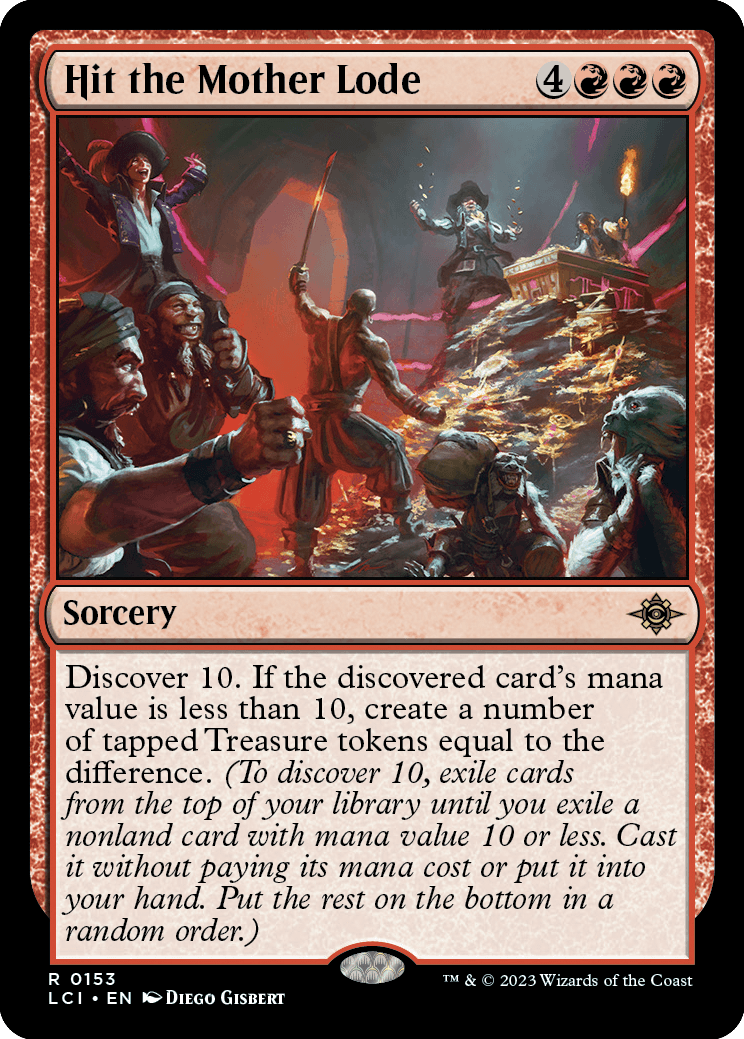
Hit the Mother Lode
Sorcery
Discover 10. If the discovered card's mana value is less than 10, create a number of tapped Treasure tokens equal to the difference. (To discover 10, exile cards from the top of your library until you exile a nonland card with mana value 10 or less. Cast it without paying its mana cost or put it into your hand. Put the rest on the bottom in a random order.)
- You won't create any Treasure tokens until you finish discovering. For example, if the card you discover has "As an additional cost to cast this spell, sacrifice an artifact," you can't sacrifice one of the Treasures from Hit the Mother Lode to pay that additional cost.
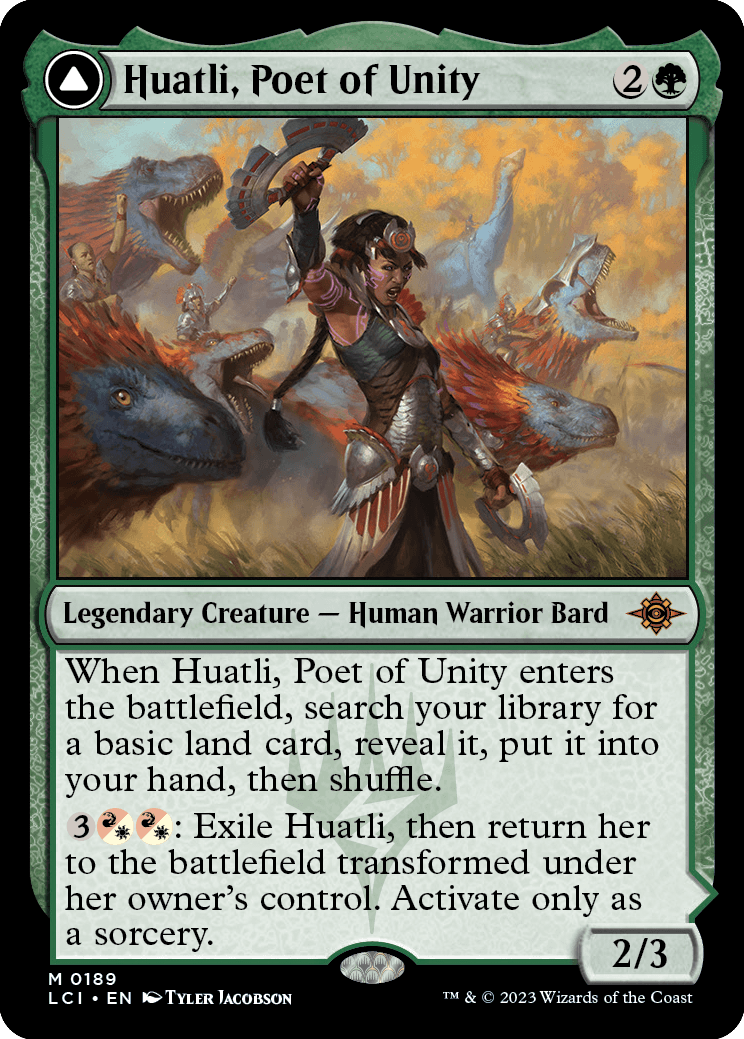
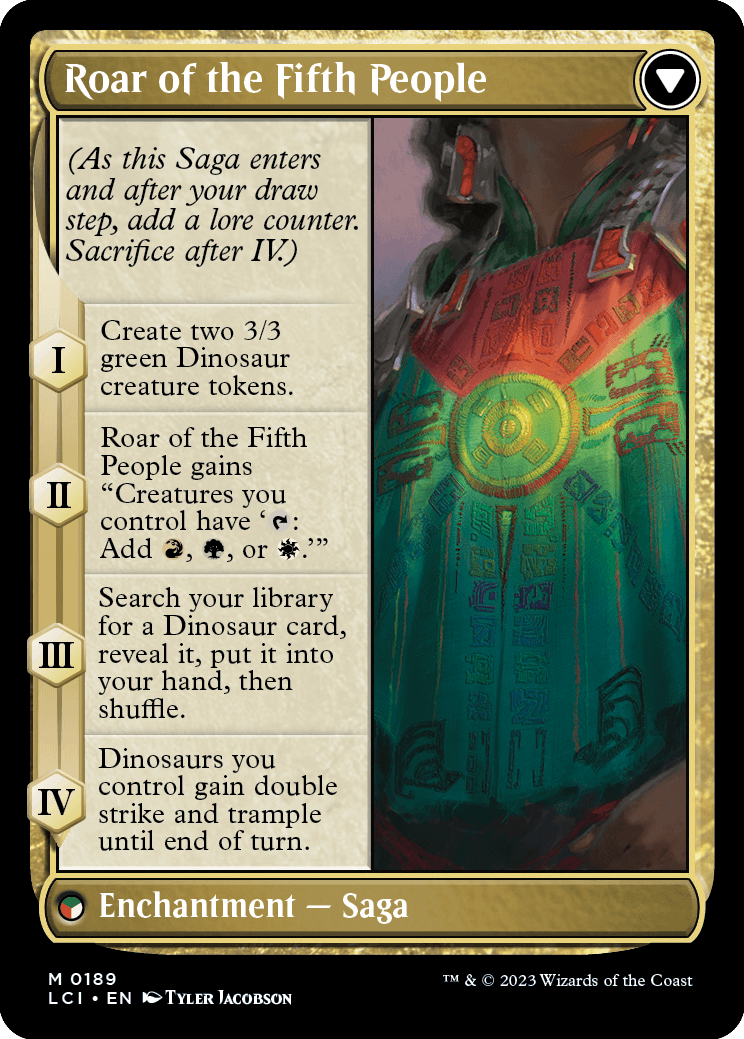
Huatli, Poet of Unity
Legendary Creature — Human Warrior Bard
2/3
When Huatli, Poet of Unity enters the battlefield, search your library for a basic land card, reveal it, put it into your hand, then shuffle.
: Exile Huatli, then return her to the battlefield transformed under her owner's control. Activate only as a sorcery.
////
Roar of the Fifth People
Enchantment — Saga
(As this Saga enters and after your draw step, add a lore counter. Sacrifice after IV.)
I — Create two 3/3 green Dinosaur creature tokens.
II — Roar of the Fifth People gains "Creatures you control have ': Add , , or .'"
III — Search your library for a Dinosaur card, reveal it, put it into your hand, then shuffle.
IV — Dinosaurs you control gain double strike and trample until end of turn.
- Roar of the Fifth People's second chapter ability doesn't have a duration. It will continue to apply as long as Roar of the Fifth People remains on the battlefield.
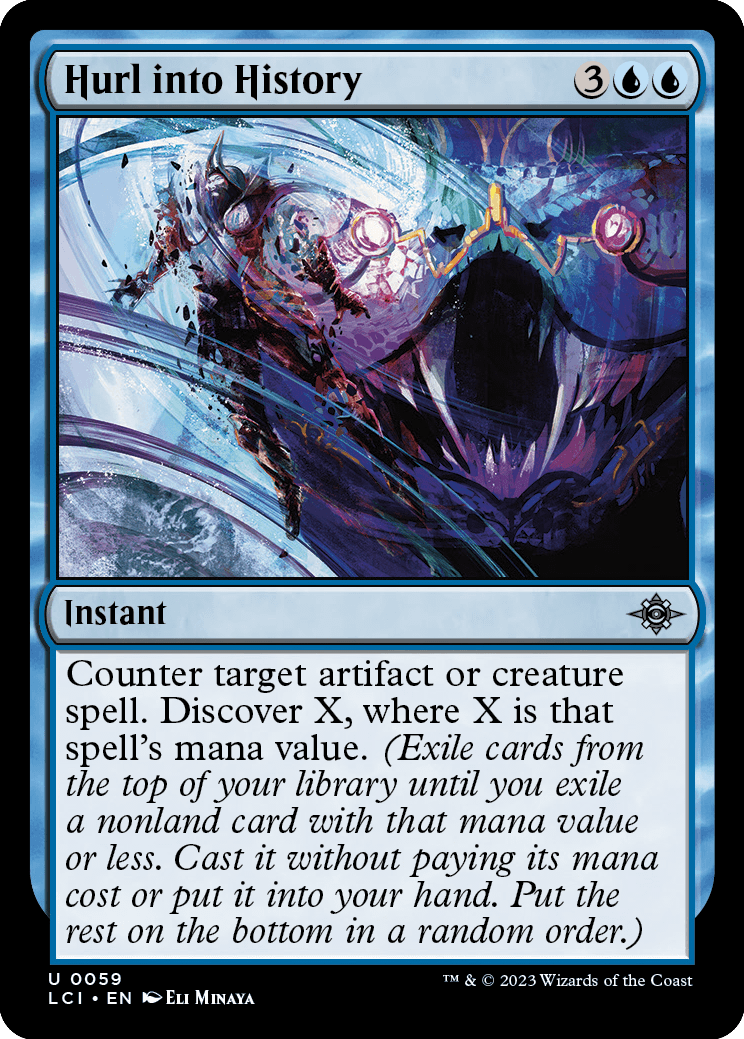
Hurl into History
Instant
Counter target artifact or creature spell. Discover X, where X is that spell's mana value. (Exile cards from the top of your library until you exile a nonland card with that mana value or less. Cast it without paying its mana cost or put it into your hand. Put the rest on the bottom in a random order.)
- If the target spell has in its mana cost, use the value chosen for X when calculating that spell's mana value.
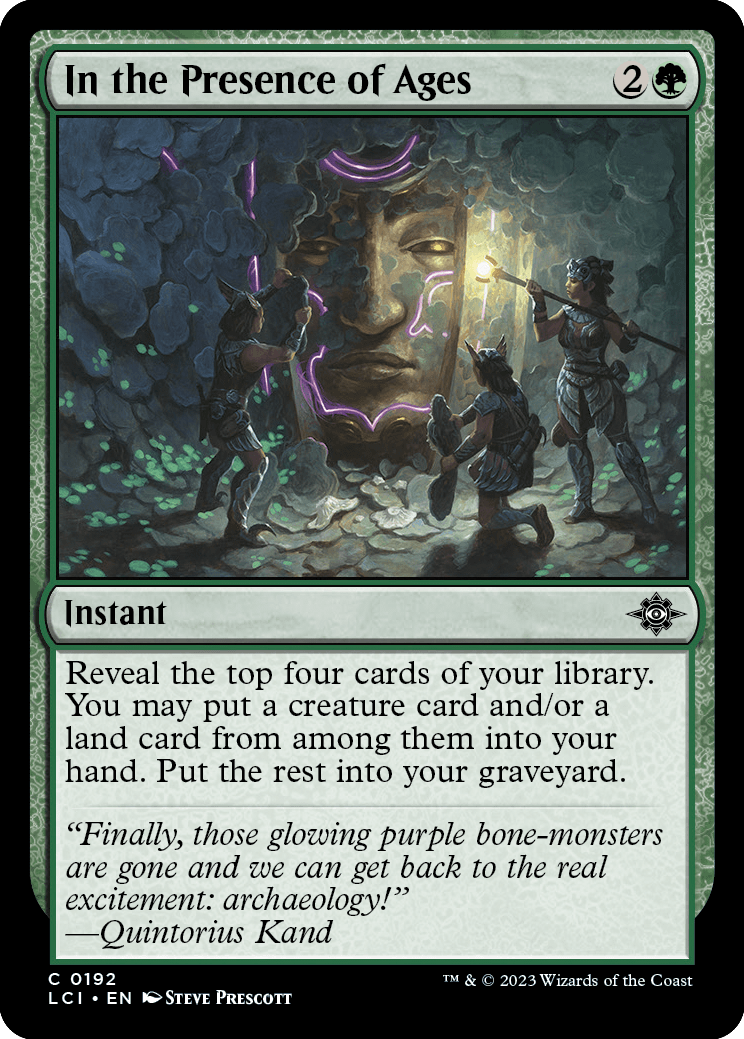
In the Presence of Ages
Instant
Reveal the top four cards of your library. You may put a creature card and/or a land card from among them into your hand. Put the rest into your graveyard.
- While resolving In the Presence of Ages, you could put no cards, a creature card, a land card, or a creature card and a land card into your hand.
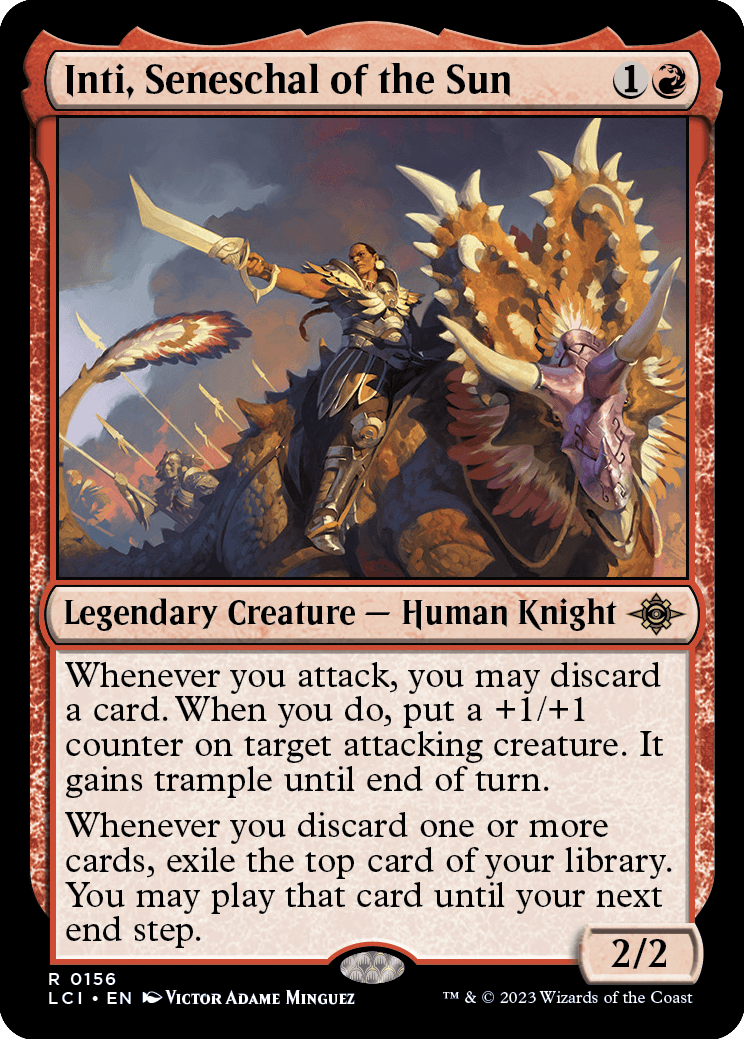
Inti, Seneschal of the Sun
Legendary Creature — Human Knight
2/2
Whenever you attack, you may discard a card. When you do, put a +1/+1 counter on target attacking creature. It gains trample until end of turn.
Whenever you discard one or more cards, exile the top card of your library. You may play that card until your next end step.
- You don't choose a target for Inti, Seneschal of the Sun's first ability at the time it triggers. Rather, a second "reflexive" ability triggers when you discard a card this way. You choose targets for that ability as it goes on the stack. Each player may respond to this triggered ability as normal.
- You pay all costs and follow all normal timing rules for cards played due to the last ability. For example, if the exiled card is a land card, you may play it only during your main phase while the stack is empty.

Intrepid Paleontologist
Creature — Human Druid
2/2
: Add one mana of any color.
: Exile target card from a graveyard.
You may cast Dinosaur creature spells from among cards you own exiled with Intrepid Paleontologist. If you cast a spell this way, that creature enters the battlefield with a finality counter on it. (If a creature with a finality counter on it would die, exile it instead.)
- You must still pay all costs and follow any timing restrictions and permissions for Dinosaur creature spells you cast from exile this way. Normally, you'll be able to cast them only during your main phase while the stack is empty.
- Intrepid Paleontologist must be under your control in order to start casting a Dinosaur creature spell using its last ability, but it doesn't need to stay under your control throughout that process or be under your control as the spell resolves. If, for example, you sacrifice Intrepid Paleontologist to pay an additional cost of the spell or it's destroyed in response, the spell will still resolve normally.
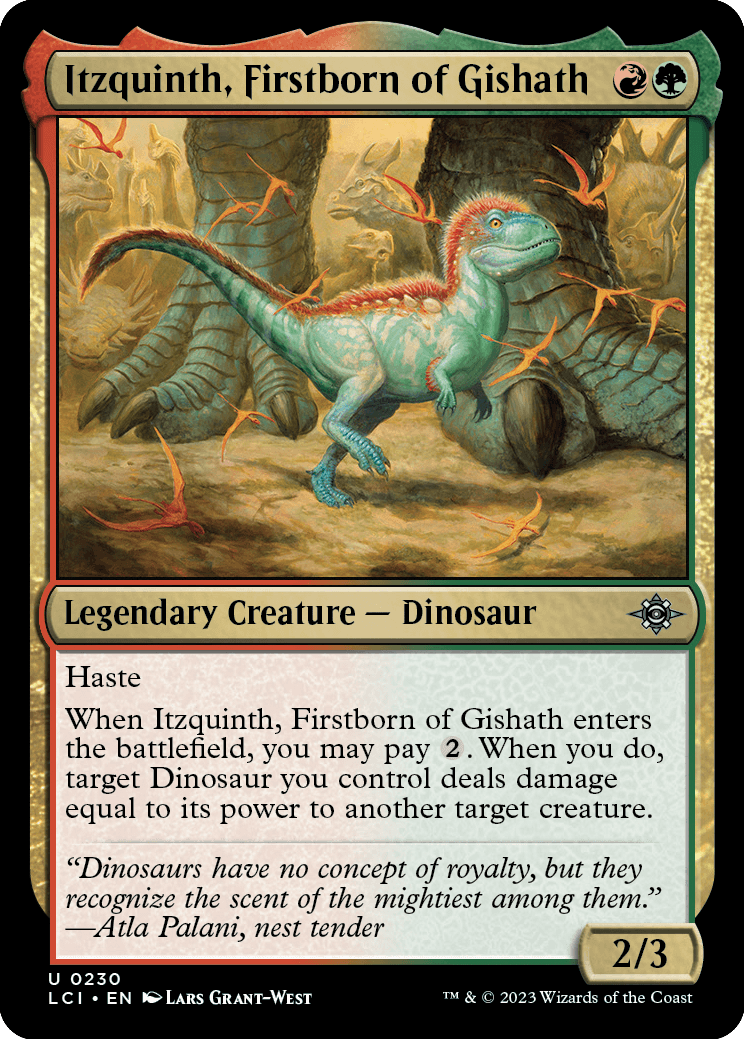
Itzquinth, Firstborn of Gishath
Legendary Creature — Dinosaur
2/3
Haste
When Itzquinth, Firstborn of Gishath enters the battlefield, you may pay . When you do, target Dinosaur you control deals damage equal to its power to another target creature.
- You don't choose targets for Itzquinth, Firstborn of Gishath's triggered ability at the time it triggers. Rather, a second "reflexive" ability triggers when you pay this way. You choose targets for that ability as it goes on the stack. Each player may respond to this triggered ability as normal.
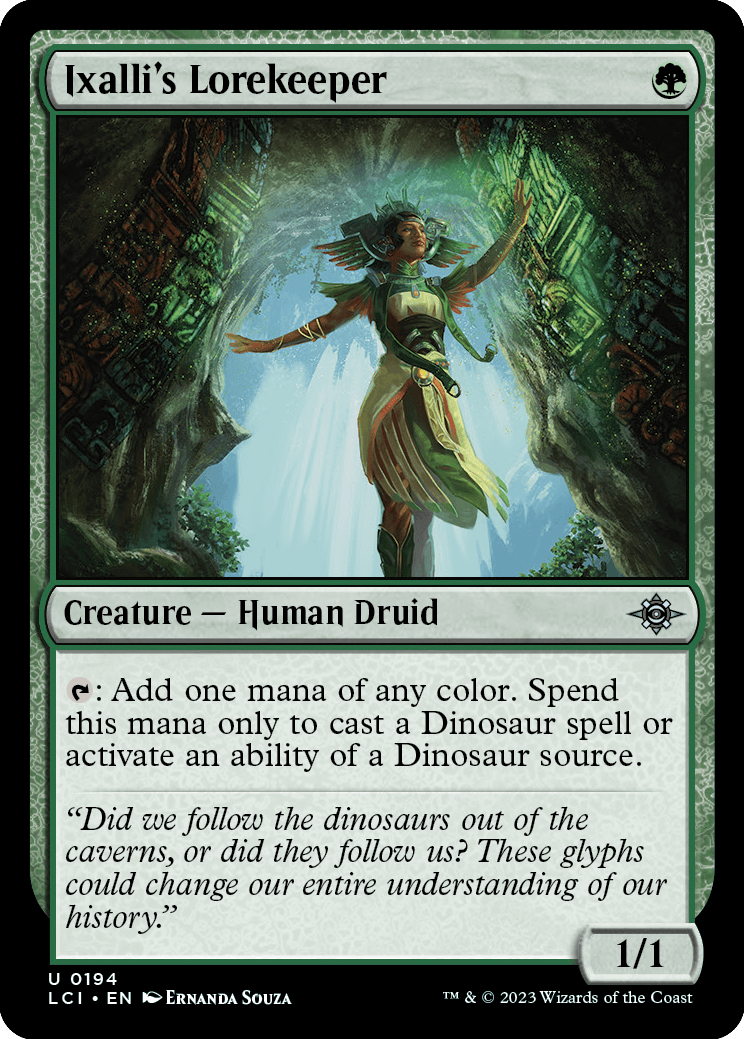
Ixalli's Lorekeeper
Creature — Human Druid
1/1
: Add one mana of any color. Spend this mana only to cast a Dinosaur spell or activate an ability of a Dinosaur source.
- A "Dinosaur source" is any object with the creature type Dinosaur. This means you could spend the mana to activate an ability of a Dinosaur you control or a Dinosaur card in your hand or graveyard, for example.
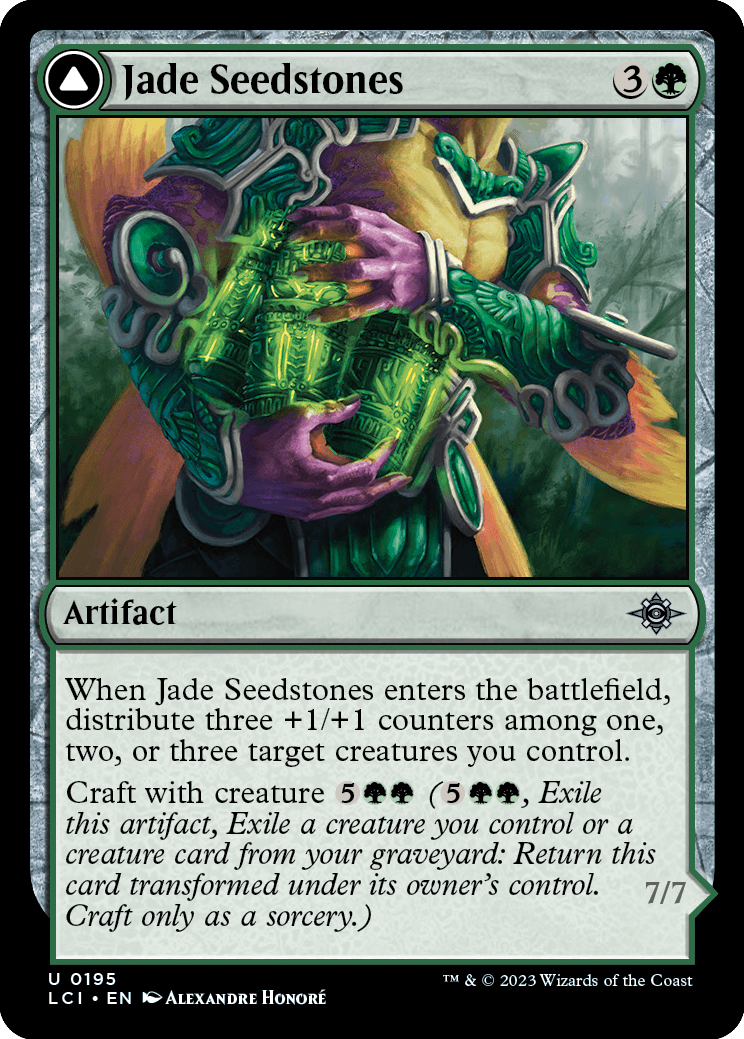
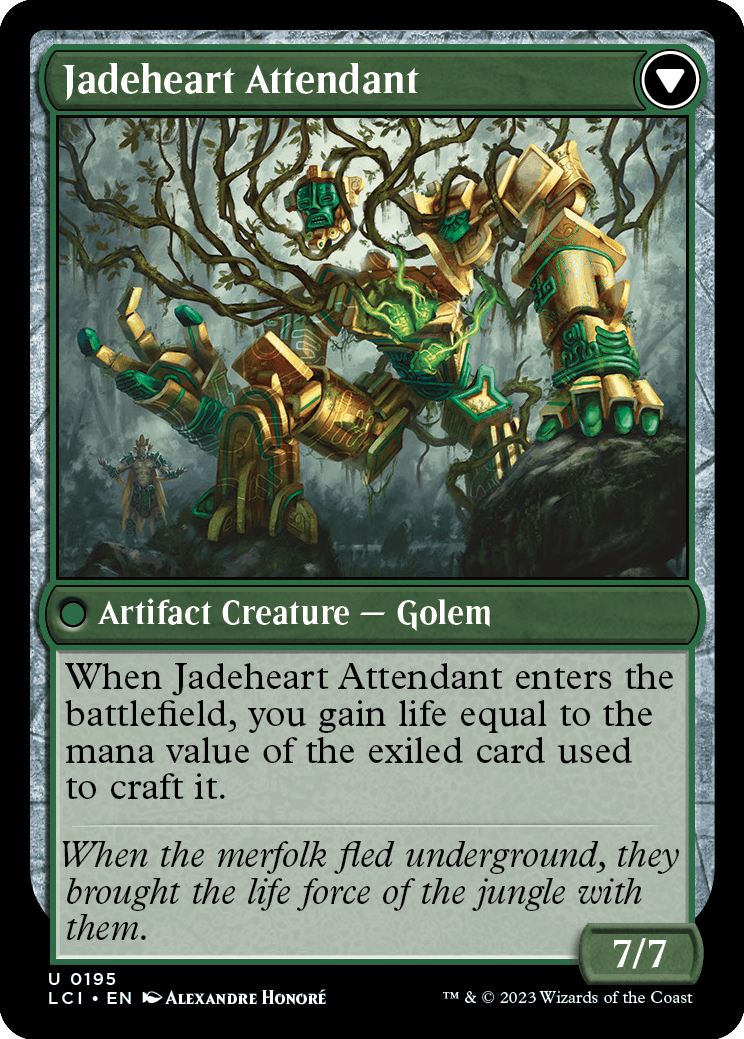
Jade Seedstones
Artifact
When Jade Seedstones enters the battlefield, distribute three +1/+1 counters among one, two, or three target creatures you control.
Craft with creature (, Exile this artifact, Exile a creature you control or a creature card from your graveyard: Return this card transformed under its owner's control. Craft only as a sorcery.)
////
Jadeheart Attendant
Artifact Creature — Golem
7/7
When Jadeheart Attendant enters the battlefield, you gain life equal to the mana value of the exiled card used to craft it.
- You choose how many targets the first ability of Jade Seedstones has and how the counters will be distributed as that ability is put on the stack. Each target must receive at least one counter.
- If some of the creatures are illegal targets as the first ability of Jade Seedstones tries to resolve, the original distribution of counters still applies and the counters that would have been put on the illegal targets are lost. They won't be put instead on a legal target.
- In some unusual cases, multiple cards may be exiled to craft Jadeheart Attendant. For example, if an effect makes Jade Seedstones a copy of a permanent with a craft ability that requires multiple components, the copy effect will expire as Jade Seedstones leaves the battlefield and it will return as Jadeheart Attendant. The enters-the-battlefield ability will count all the exiled cards, and you'll gain life equal to their total mana values.
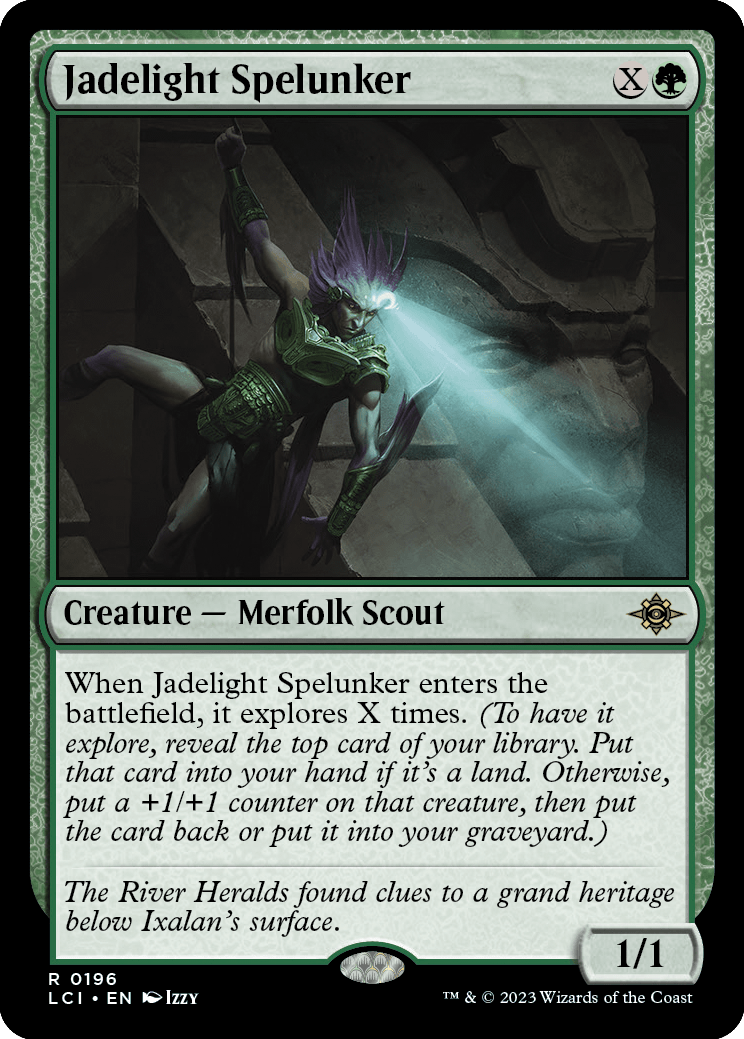
Jadelight Spelunker
Creature — Merfolk Scout
1/1
When Jadelight Spelunker enters the battlefield, it explores X times. (To have it explore, reveal the top card of your library. Put that card into your hand if it's a land. Otherwise, put a +1/+1 counter on that creature, then put the card back or put it into your graveyard.)
- If Jadelight Spelunker enters the battlefield without being cast, or if it was cast with X equal to 0, the enters-the-battlefield ability will still trigger, but Jadelight Spelunker won't explore at all.
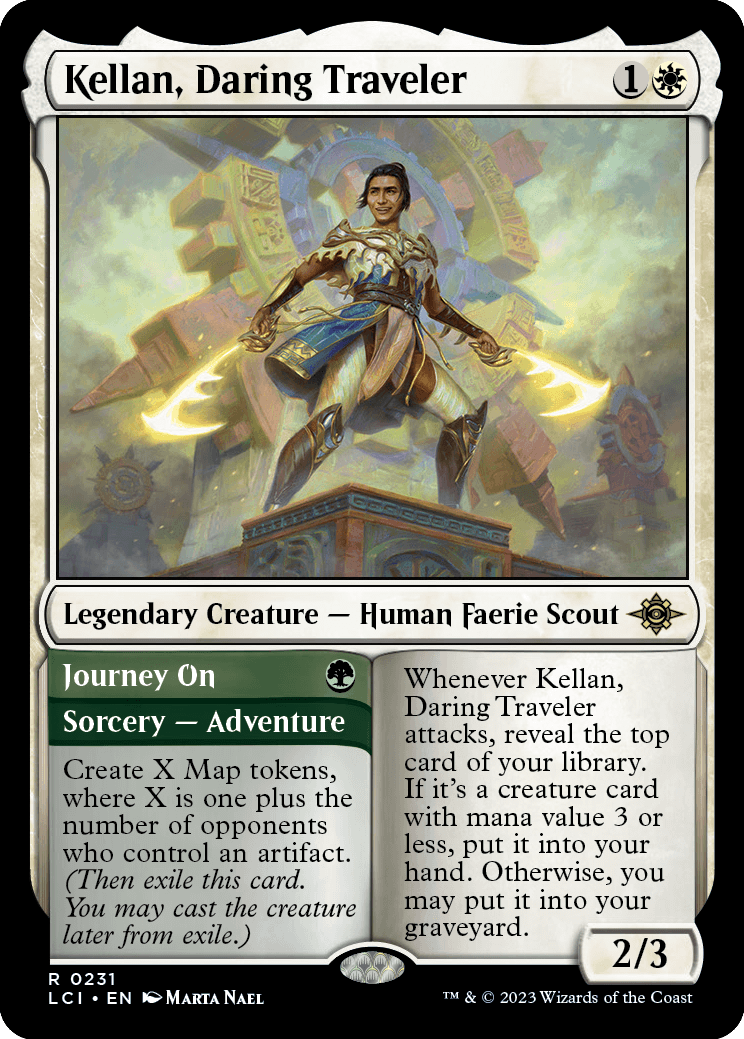
Kellan, Daring Traveler
Legendary Creature — Human Faerie Scout
2/3
Whenever Kellan, Daring Traveler attacks, reveal the top card of your library. If it's a creature card with mana value 3 or less, put it into your hand. Otherwise, you may put it into your graveyard.
//ADV//
Journey On
Sorcery — Adventure
Create X Map tokens, where X is one plus the number of opponents who control an artifact. (Then exile this card. You may cast the creature later from exile.)
- If you don't put the card you reveal due to Kellan's triggered ability into your hand and you choose not to put it into your graveyard, it stays on top of your library.
- Journey On counts the number of opponents who control at least one artifact, not the number of artifacts opponents control.
- An adventurer card is a permanent card in every zone except the stack, as well as while on the stack if not cast as an Adventure. Ignore its alternative characteristics in those cases. For example, while it's in your graveyard, Kellan, Daring Traveler is a white creature card whose mana value is 2. While there, it can't be the target of a spell or ability that targets only instant or sorcery cards.
- When casting a spell as an Adventure, use the alternative characteristics and ignore all of the card's normal characteristics. The spell's color, mana cost, mana value, and so on are determined by only those alternative characteristics. If the spell leaves the stack, it immediately resumes using its normal characteristics.
- If you cast an adventurer card as an Adventure, use only its alternative characteristics to determine whether it's legal to cast that spell. For example, if you control Johann, Apprentice Sorcerer ("Once each turn, you may cast an instant or sorcery spell from the top of your library") and Kellan, Daring Traveler is on top of your library, you can cast Journey On, but not Kellan, Daring Traveler.
- If a spell is cast as an Adventure, its controller exiles it instead of putting it into its owner's graveyard as it resolves. For as long as it remains exiled, that player may cast it as a permanent spell. If an Adventure spell leaves the stack in any way other than resolving (most likely by being countered or by failing to resolve because its targets have all become illegal), that card won't be exiled and the spell's controller won't be able to cast it as a permanent later.
- If an adventurer card ends up in exile for any other reason than by exiling itself while resolving, it won't give you permission to cast it as a permanent spell.
- You must still follow any timing restrictions and permissions for the permanent spell you cast from exile. Normally, you'll be able to cast it only during your main phase while the stack is empty.
- If an effect copies an Adventure spell, that copy is exiled as it resolves. It ceases to exist as a state-based action; it's not possible to cast the copy as a permanent.
- Some cards in other sets refer to a card, spell, or permanent that "has an Adventure." This refers to a card, spell, or permanent that has an adventurer card's set of alternative characteristics, even if they're not being used and even if that card was never cast as an Adventure.
- If an effect refers to a card, spell, or permanent that has an Adventure, it won't find an instant or sorcery spell on the stack that's been cast as an Adventure.
- If an object becomes a copy of an object that has an Adventure, the copy also has an Adventure. If it changes zones, it will either cease to exist (if it's a token) or cease to be a copy (if it's a nontoken permanent), and so you won't be able to cast it as an Adventure.
- If an effect instructs you to choose a card name, you may choose the alternative Adventure name. Consider only the alternative characteristics to determine whether that is an appropriate name to choose.
- Casting a card as an Adventure isn't casting it for an alternative cost. Effects that allow you to cast a spell for an alternative cost or without paying its mana cost may allow you to apply those to the Adventure.
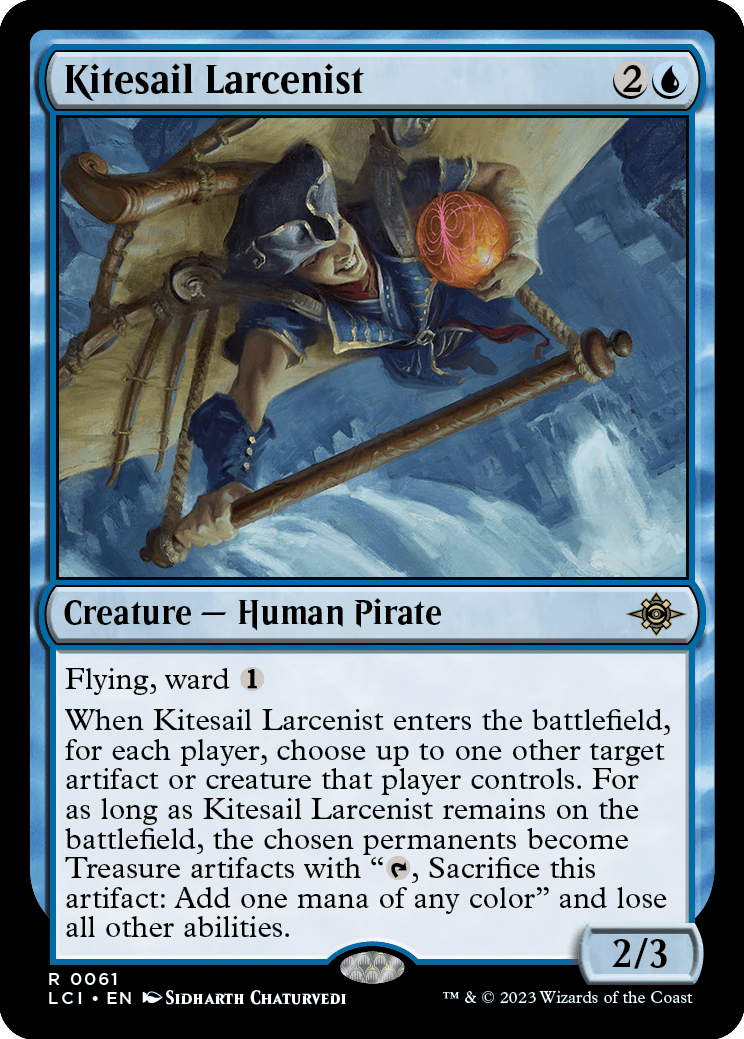
Kitesail Larcenist
Creature — Human Pirate
2/3
Flying, ward
When Kitesail Larcenist enters the battlefield, for each player, choose up to one other target artifact or creature that player controls. For as long as Kitesail Larcenist remains on the battlefield, the chosen permanents become Treasure artifacts with ", Sacrifice this artifact: Add one mana of any color" and lose all other abilities.
- The targets of Kitesail Larcenist's enters-the-battlefield ability will lose any other subtypes and card types they previously had and will be only Treasure artifacts as long as Kitesail Larcenist remains on the battlefield. They will retain any supertypes they had.
- If Kitesail Larcenist leaves the battlefield before its enters-the-battlefield ability resolves, that ability will have no effect. The target permanents won't become Treasures at all.
- If some of the targets, but not all, are illegal as the ability resolves, the illegal targets will be unaffected. Only the remaining legal targets will become Treasures.
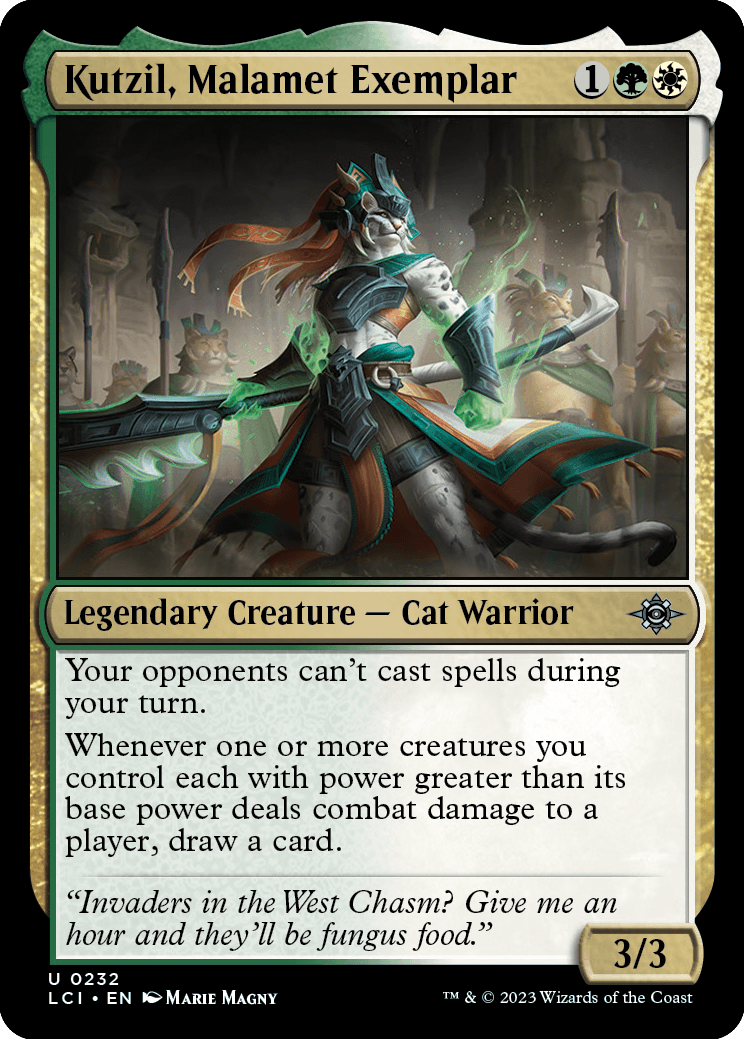
Kutzil, Malamet Exemplar
Legendary Creature — Cat Warrior
3/3
Your opponents can't cast spells during your turn.
Whenever one or more creatures you control each with power greater than its base power deals combat damage to a player, draw a card.
- Normally, a creature's base power and toughness are the power and toughness printed on the card or, for a token, the power and toughness set by the effect that created it. If another effect sets a creature's power and toughness to specific numbers or values, those become its base power and toughness. If an effect modifies a creature's power and/or toughness without setting them, that is not included when determining its base power and toughness.
- If a creature has a characteristic-defining ability that sets its power and toughness, indicated with a */* or similar in the power and toughness box, that ability is taken into account when determining its base power and toughness.
- Some creatures have base power and toughness 0/0 and an ability that gives them a bonus based on some criteria. Those are not characteristic-defining abilities, and that ability doesn't change its base power and toughness. Such a creature will have power greater than its base power if the ability is raising its power above 0.
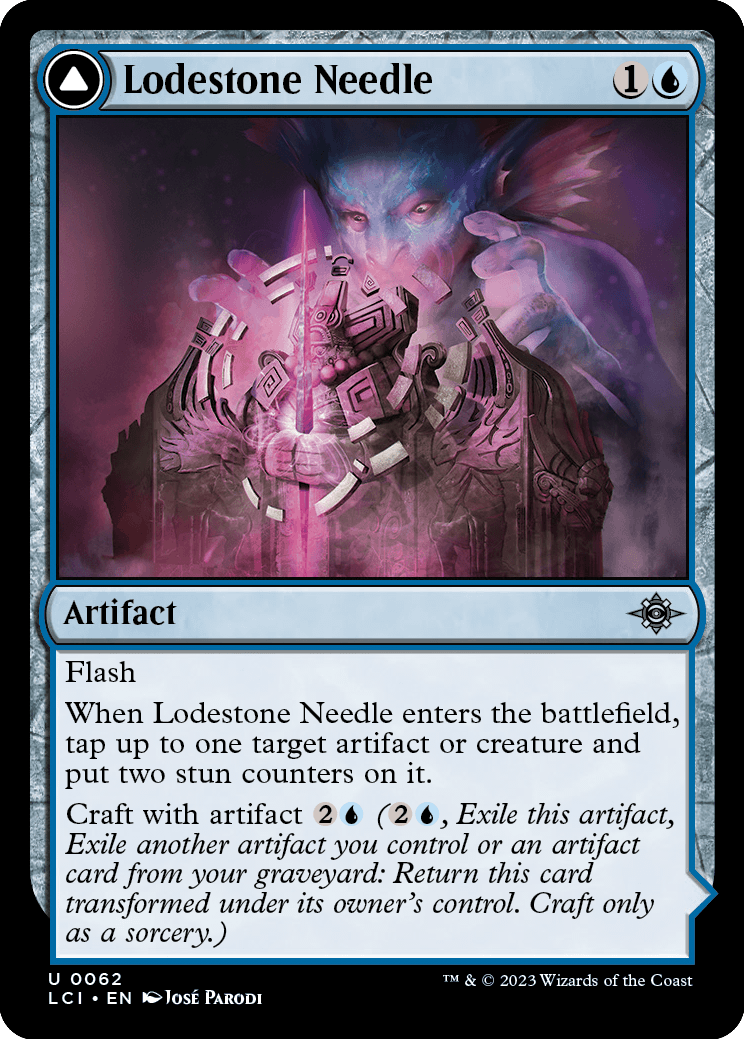
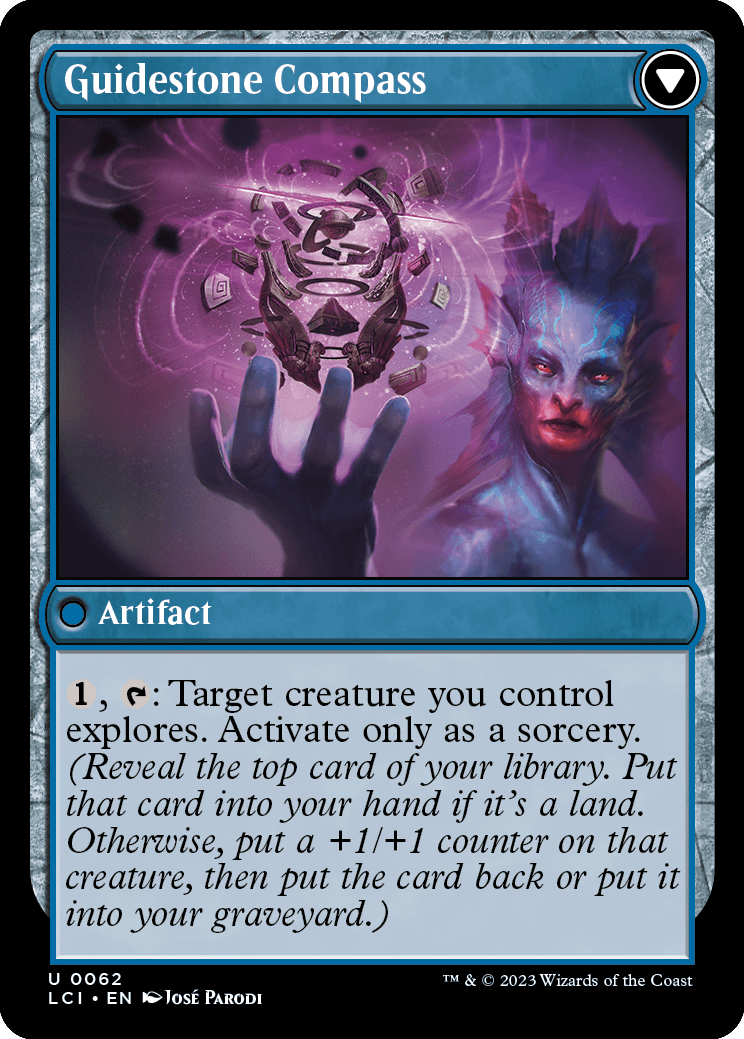
Lodestone Needle
Artifact
Flash
When Lodestone Needle enters the battlefield, tap up to one target artifact or creature and put two stun counters on it.
Craft with artifact (, Exile this artifact, Exile another artifact you control or an artifact card from your graveyard: Return this card transformed under its owner's control. Craft only as a sorcery.)
////
Guidestone Compass
Artifact
, : Target creature you control explores. Activate only as a sorcery. (Reveal the top card of your library. Put that card into your hand if it's a land. Otherwise, put a +1/+1 counter on that creature, then put the card back or put it into your graveyard.)
- Lodestone Needle's enters-the-battlefield ability can target an artifact or creature that's already tapped. If so, you'll just put two stun counters on that artifact or creature.
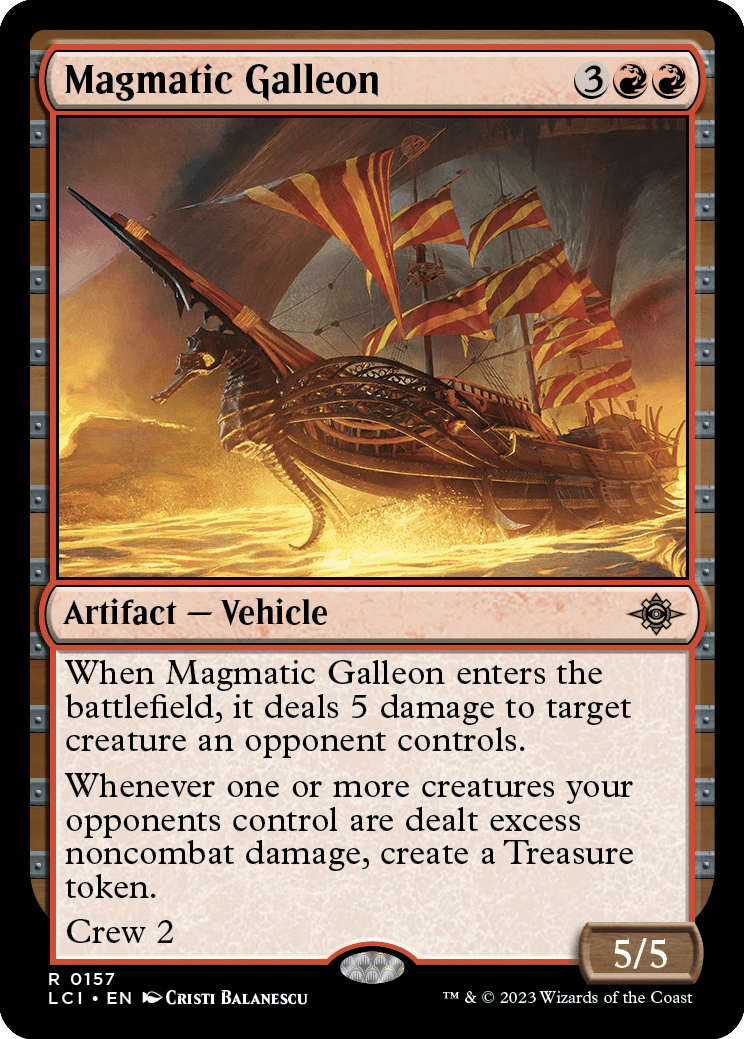
Magmatic Galleon
Artifact — Vehicle
5/5
When Magmatic Galleon enters the battlefield, it deals 5 damage to target creature an opponent controls.
Whenever one or more creatures your opponents control are dealt excess noncombat damage, create a Treasure token.
Crew 2
- Excess damage has been dealt to a creature if the damage dealt to it is greater than lethal damage. Usually, this means damage greater than its toughness, although damage already marked on the creature is taken into account.
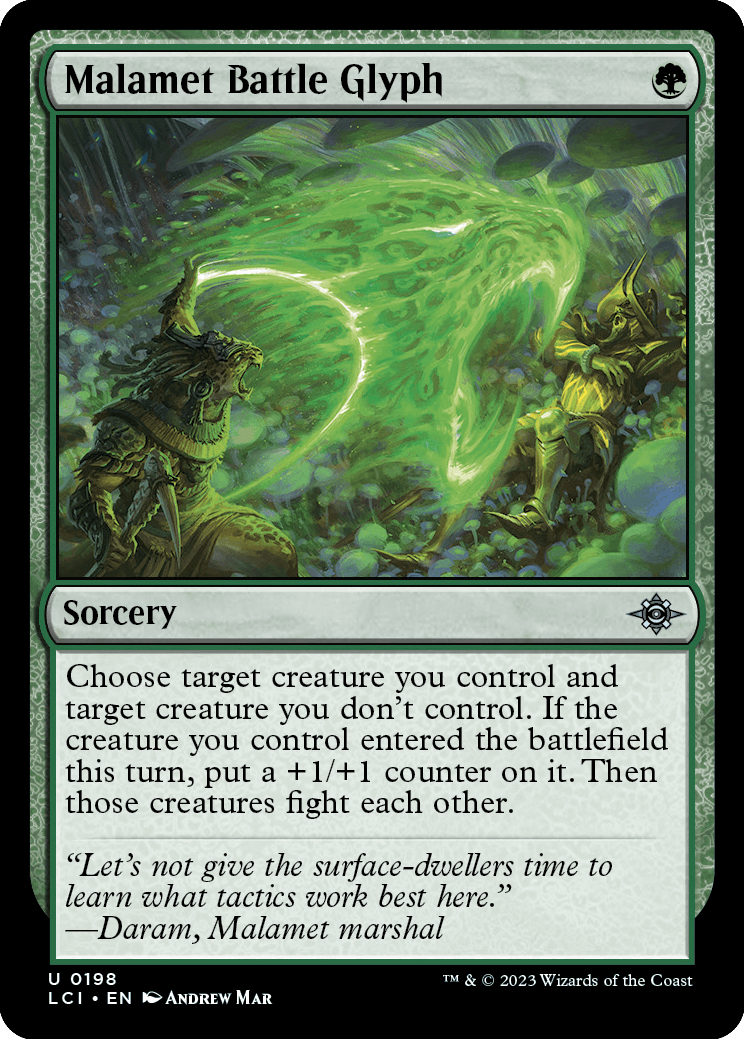
Malamet Battle Glyph
Sorcery
Choose target creature you control and target creature you don't control. If the creature you control entered the battlefield this turn, put a +1/+1 counter on it. Then those creatures fight each other.
- If the target creature you control entered the battlefield this turn and is still a legal target as Malamet Battle Glyph resolves but the target creature you don't control isn't, you will still put a +1/+1 counter on the creature you control. The creatures will not fight each other.
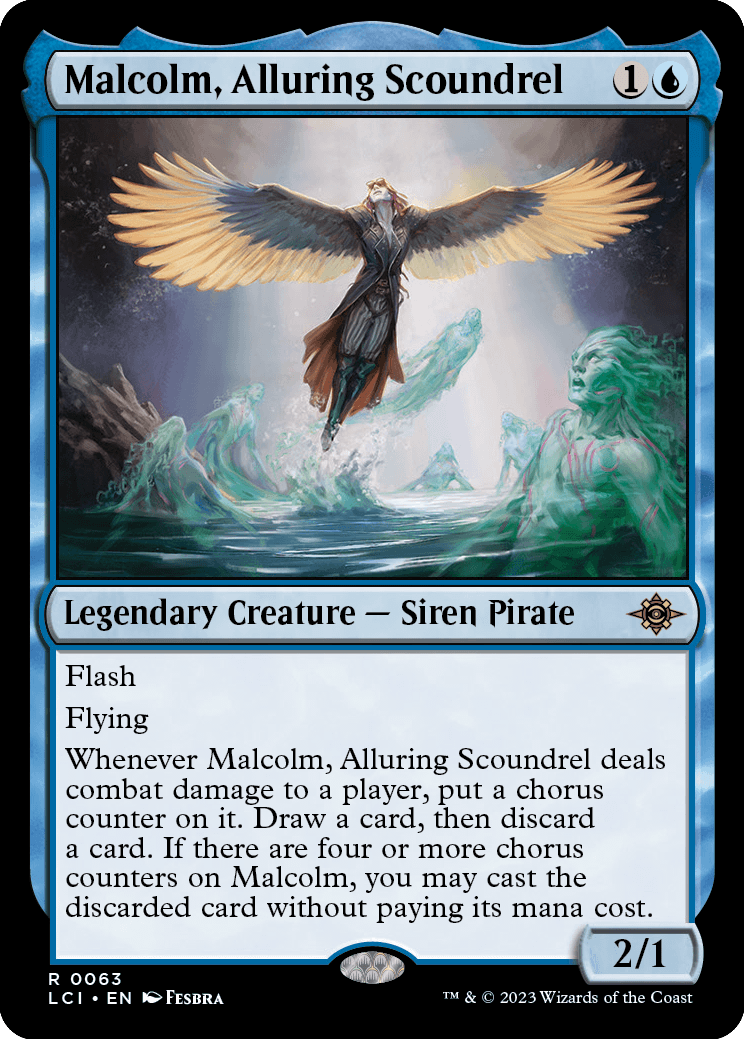
Malcolm, Alluring Scoundrel
Legendary Creature — Siren Pirate
2/1
Flash
Flying
Whenever Malcolm, Alluring Scoundrel deals combat damage to a player, put a chorus counter on it. Draw a card, then discard a card. If there are four or more chorus counters on Malcolm, you may cast the discarded card without paying its mana cost.
- If you cast a spell using Malcolm, Alluring Scoundrel's last ability, you do so as part of the resolution of the ability. You can't wait to cast the spell later in the turn. Timing permissions based on the card's type are ignored.
- You may not play land cards discarded with Malcolm, Alluring Scoundrel's last ability.
- If you cast a card "without paying its mana cost", you can't choose to cast it for any alternative costs. You can, however, pay additional costs. If the card has any mandatory additional costs, you must pay those to cast the card.
- If the spell has in its mana cost, you must choose 0 as the value of X.
- If Malcolm, Alluring Scoundrel isn't on the battlefield as its triggered ability resolves, you won't put a chorus counter on it, but you'll still draw a card and discard a card. You may still cast the discarded card without paying its mana cost if Malcolm had four or more chorus counters on it when it was last on the battlefield.
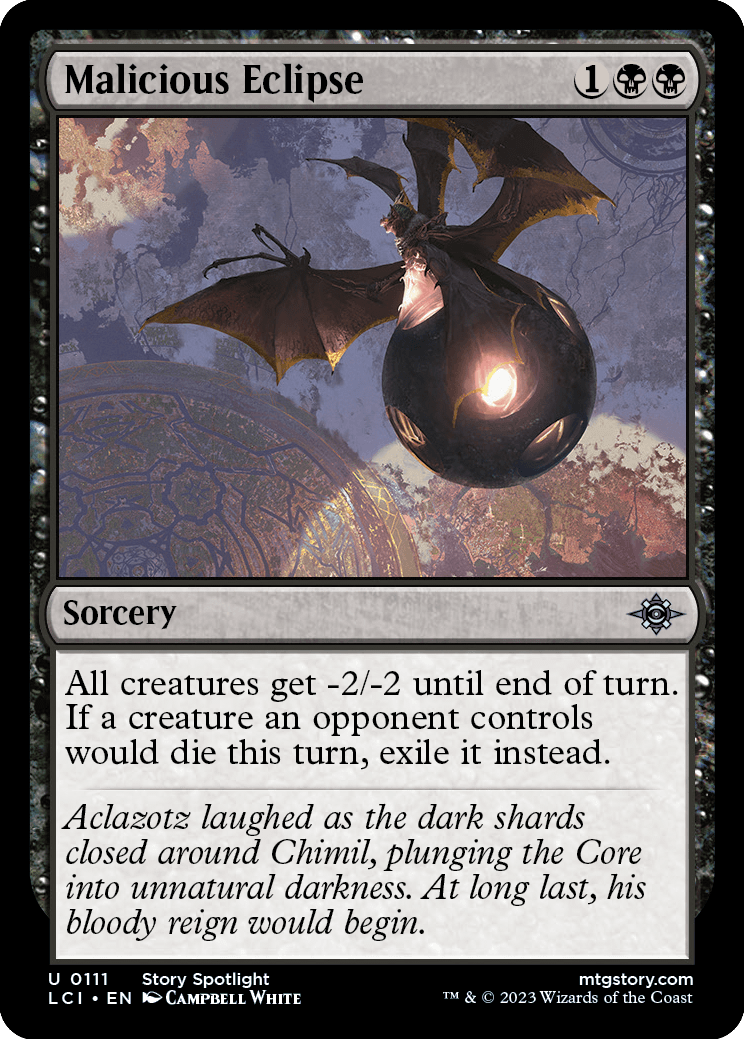
Malicious Eclipse
Sorcery
All creatures get -2/-2 until end of turn. If a creature an opponent controls would die this turn, exile it instead.
- Creatures opponents control will be exiled if they would die for any reason that turn, not just if they die by being reduced to 0 or less toughness by Malicious Eclipse.
- While the -2/-2 applies only to creatures that are on the battlefield as Malicious Eclipse resolves, the replacement effect applies to all creatures opponents control that turn, including ones that enter the battlefield after Malicious Eclipse resolves, noncreatures that become creatures after Malicious Eclipse resolves, and creatures that become controlled by opponents after Malicious Eclipse resolves.
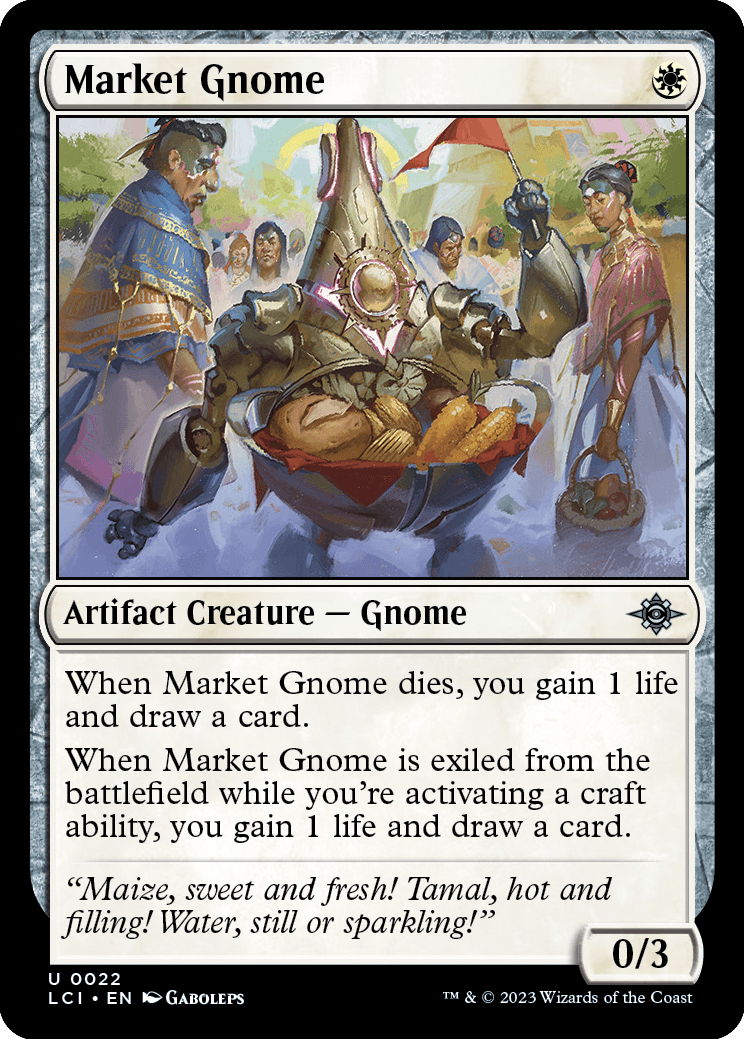
Market Gnome
Artifact Creature — Gnome
0/3
When Market Gnome dies, you gain 1 life and draw a card.
When Market Gnome is exiled from the battlefield while you're activating a craft ability, you gain 1 life and draw a card.
- Market Gnome's last ability will go onto the stack above the craft ability that caused it to trigger. This means you'll gain 1 life and draw a card before the transformed card returns to the battlefield.
- Most of the time, Market Gnome's last ability will trigger because it was exiled as one of the components used in the craft ability. However, in some uncommon cases, the ability will also trigger if Market Gnome is exiled while you're activating mana abilities as part of paying for that craft ability.
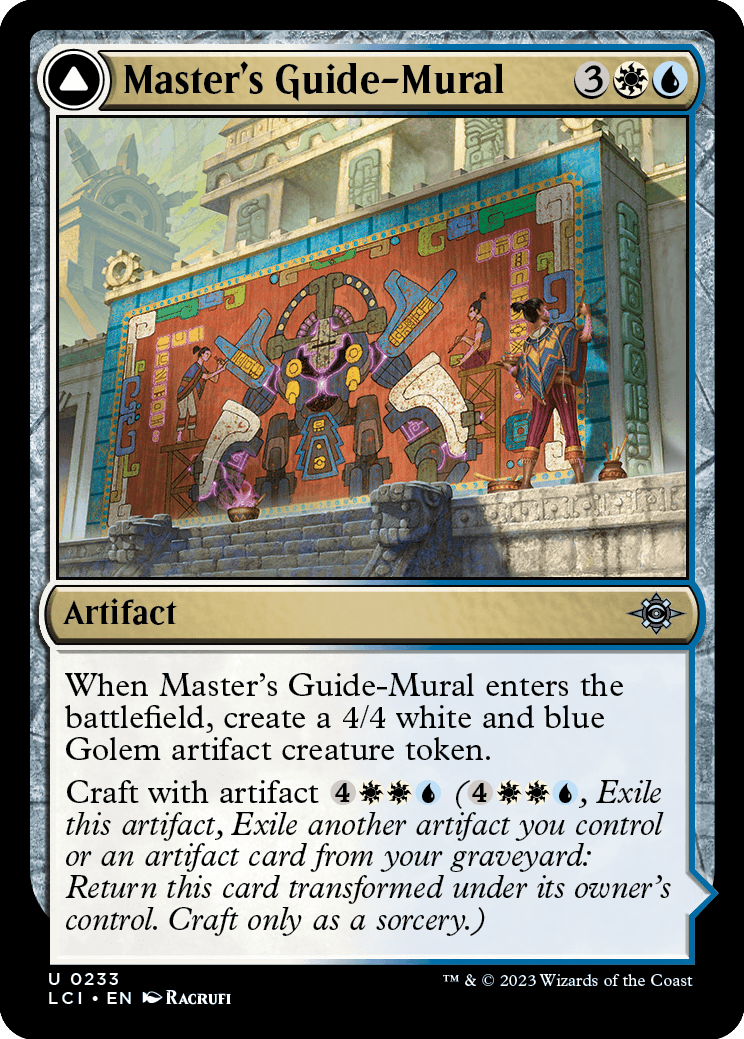
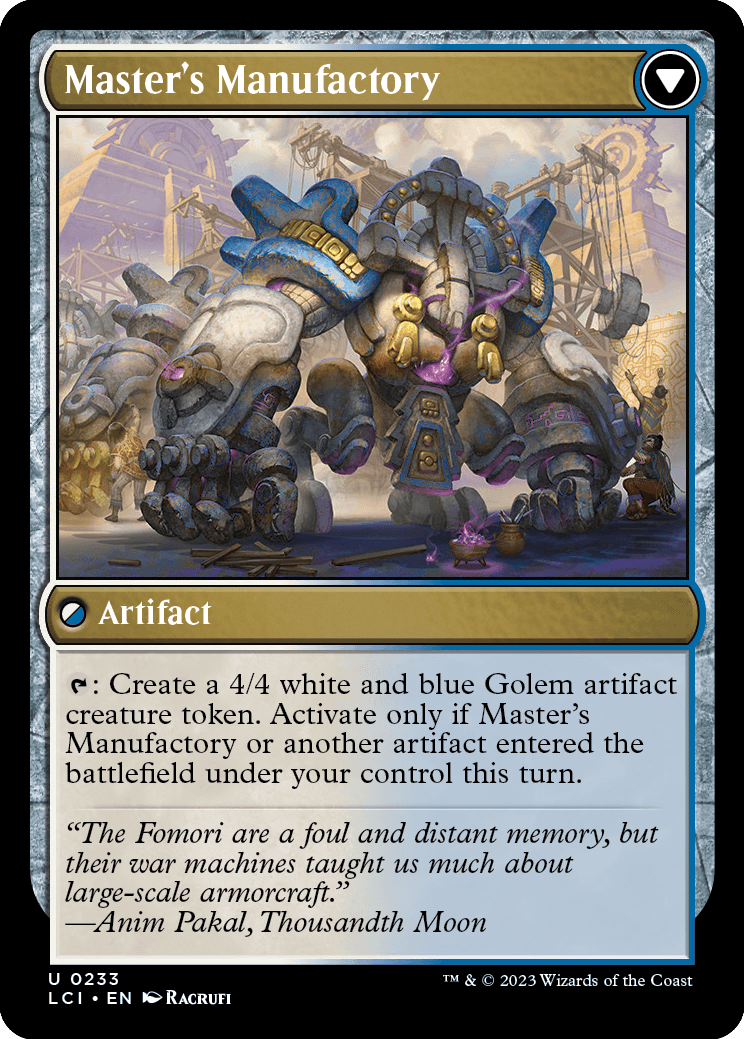
Master's Guide-Mural
Artifact
When Master's Guide-Mural enters the battlefield, create a 4/4 white and blue Golem artifact creature token.
Craft with artifact (, Exile this artifact, Exile another artifact you control or an artifact card from your graveyard: Return this card transformed under its owner's control. Craft only as a sorcery.)
////
Master's Manufactory
Artifact
: Create a 4/4 white and blue Golem artifact creature token. Activate only if Master's Manufactory or another artifact entered the battlefield under your control this turn.
- The ability of Master's Manufactory can be activated no matter what happened to the artifact after it entered under your control. It may have left the battlefield, stopped being an artifact, or another player may have gained control of it.
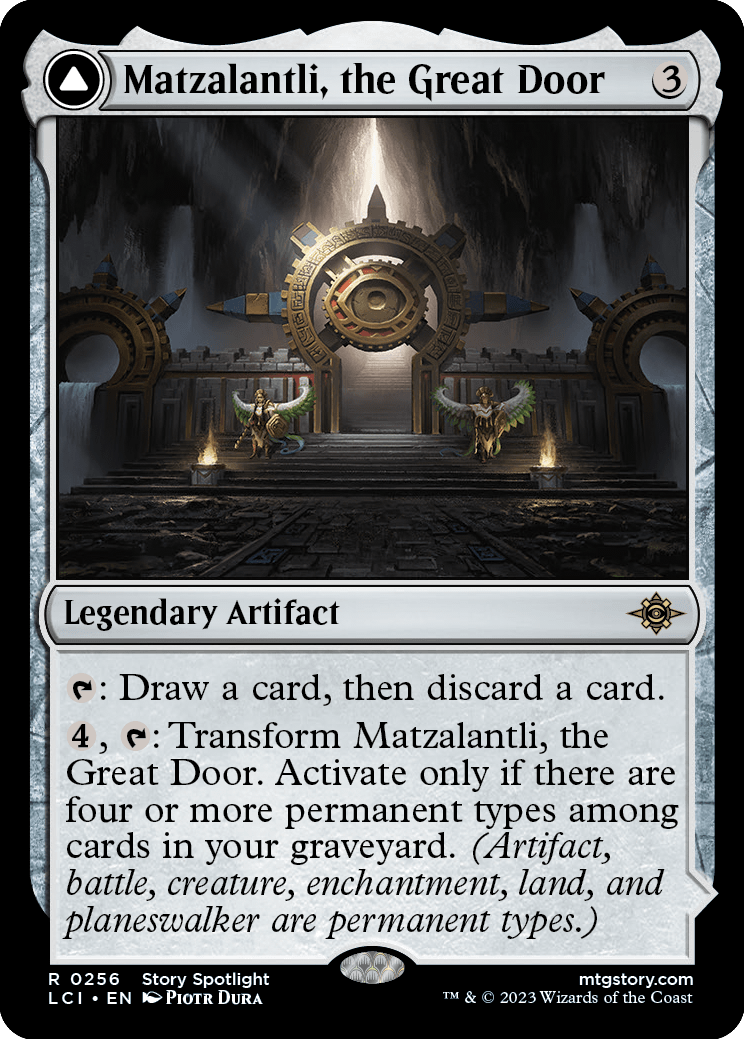
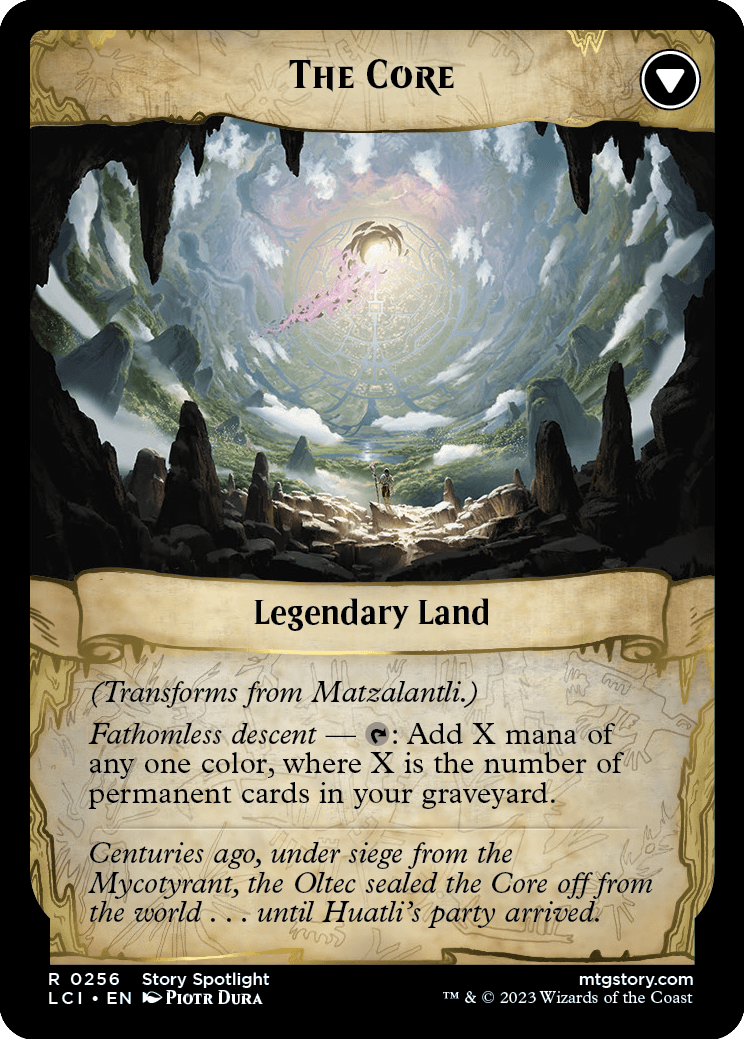
Matzalantli, the Great Door
Legendary Artifact
: Draw a card, then discard a card.
, : Transform Matzalantli, the Great Door. Activate only if there are four or more permanent types among cards in your graveyard. (Artifact, battle, creature, enchantment, land, and planeswalker are permanent types.)
////
The Core
Legendary Land
(Transforms from Matzalantli.)
Fathomless descent — : Add X mana of any one color, where X is the number of permanent cards in your graveyard.
- Transforming Matzalantli doesn't cause it to leave the battlefield. It also doesn't cause it to become untapped.
- The Core's activated ability is a mana ability. It doesn't use the stack and can't be responded to.
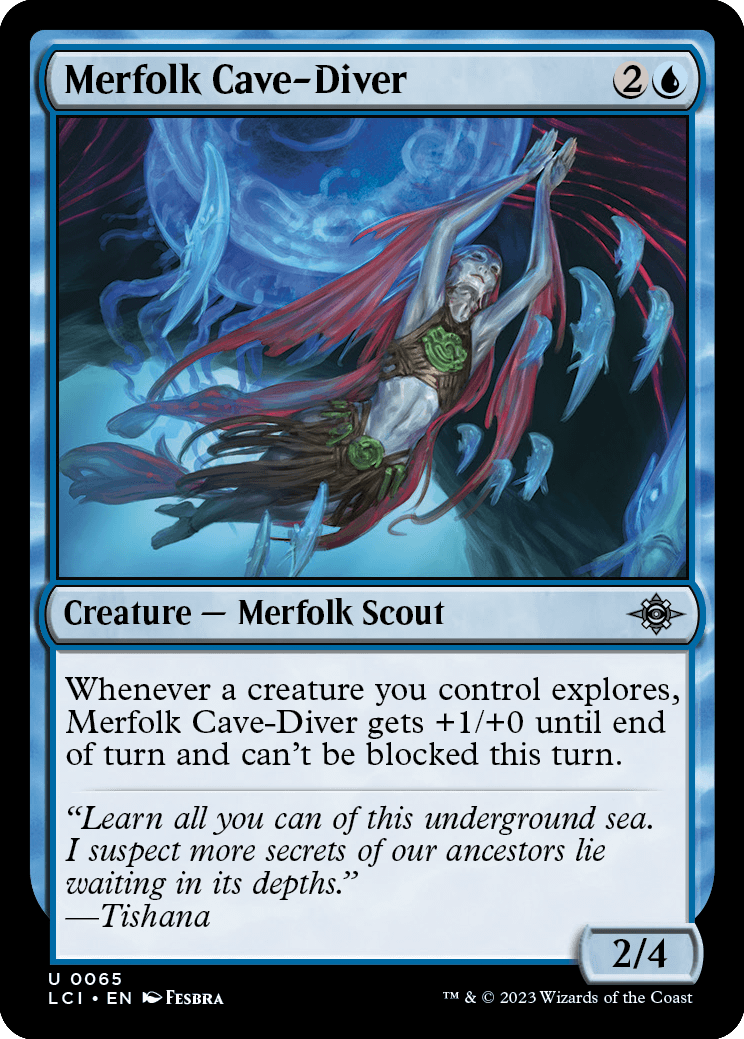
Merfolk Cave-Diver
Creature — Merfolk Scout
2/4
Whenever a creature you control explores, Merfolk Cave-Diver gets +1/+0 until end of turn and can't be blocked this turn.
- If a creature leaves the battlefield before an effect instructs it to explore, it still explores. Abilities like Merfolk Cave-Diver's that trigger whenever a creature you control explores will still trigger.
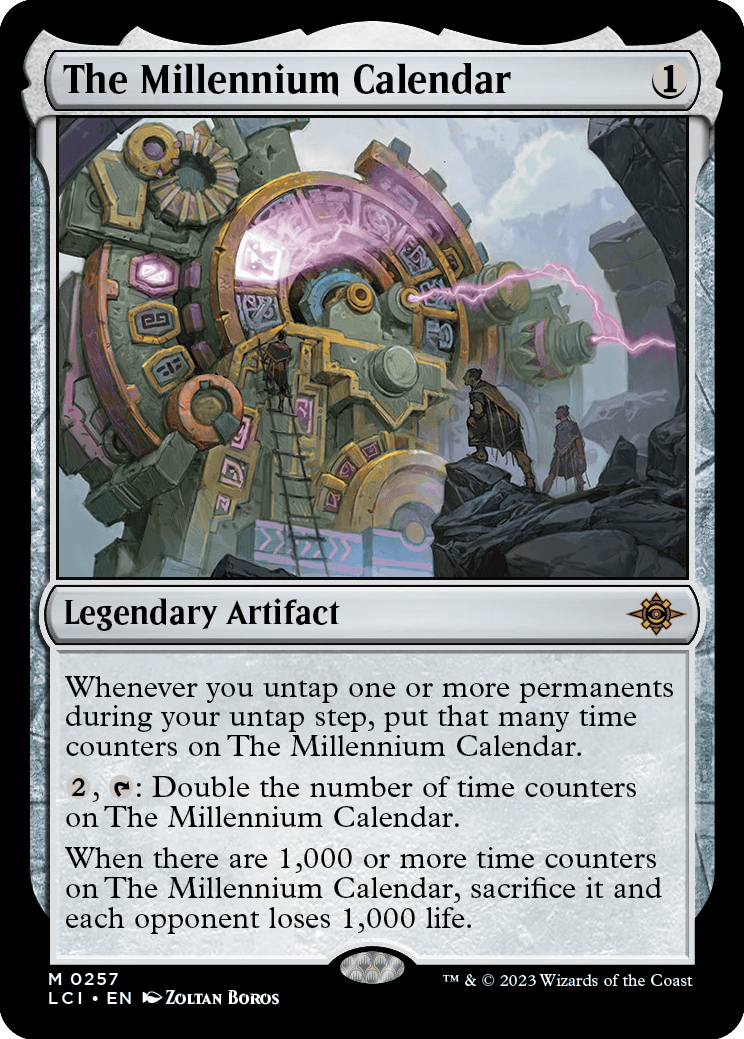
The Millennium Calendar
Legendary Artifact
Whenever you untap one or more permanents during your untap step, put that many time counters on The Millennium Calendar.
, : Double the number of time counters on The Millennium Calendar.
When there are 1,000 or more time counters on The Millennium Calendar, sacrifice it and each opponent loses 1,000 life.
- The Millenium Calendar's first ability triggers during the untap step. However, since no player gets priority during the untap step, the ability waits to be put on the stack until the upkeep starts. At that time, any "beginning of upkeep" triggers will also trigger. Those abilities and The Millenium Calendar's ability are put onto the stack at that time.
- If The Millenium Calendar's last ability is countered or otherwise removed from the stack, it will just trigger again immediately if The Millenium Calendar still has 1,000 or more time counters on it.
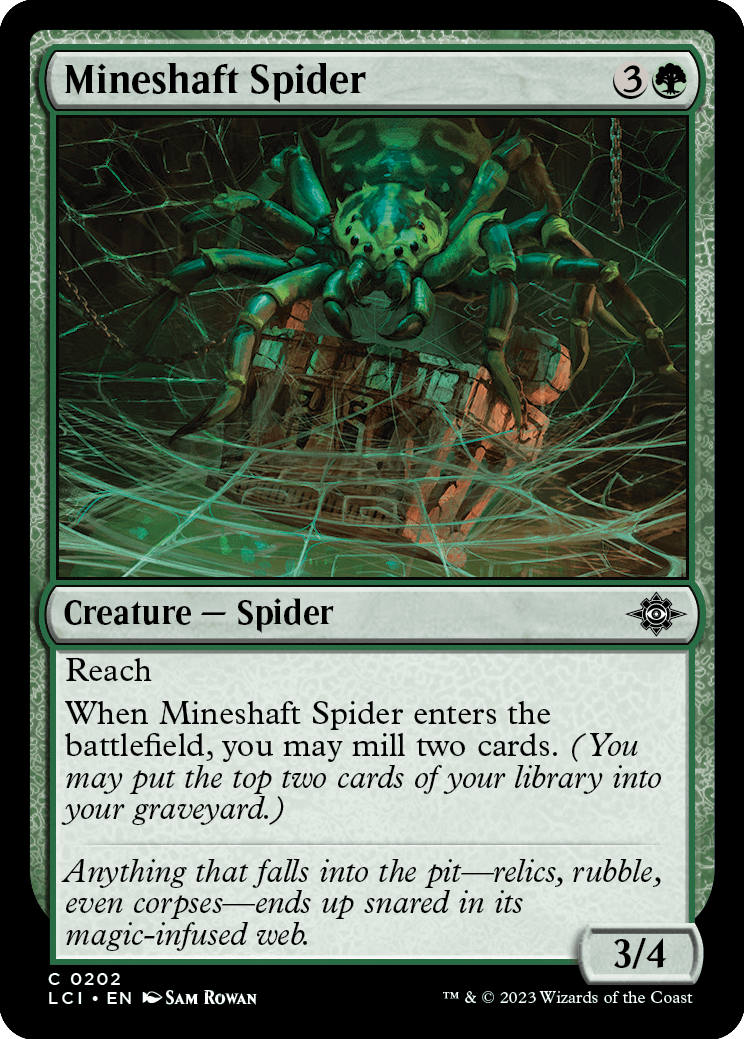
Mineshaft Spider
Creature — Spider
3/4
Reach
When Mineshaft Spider enters the battlefield, you may mill two cards. (You may put the top two cards of your library into your graveyard.)
- If you don't have at least two cards in your library, you can't choose to mill two cards.
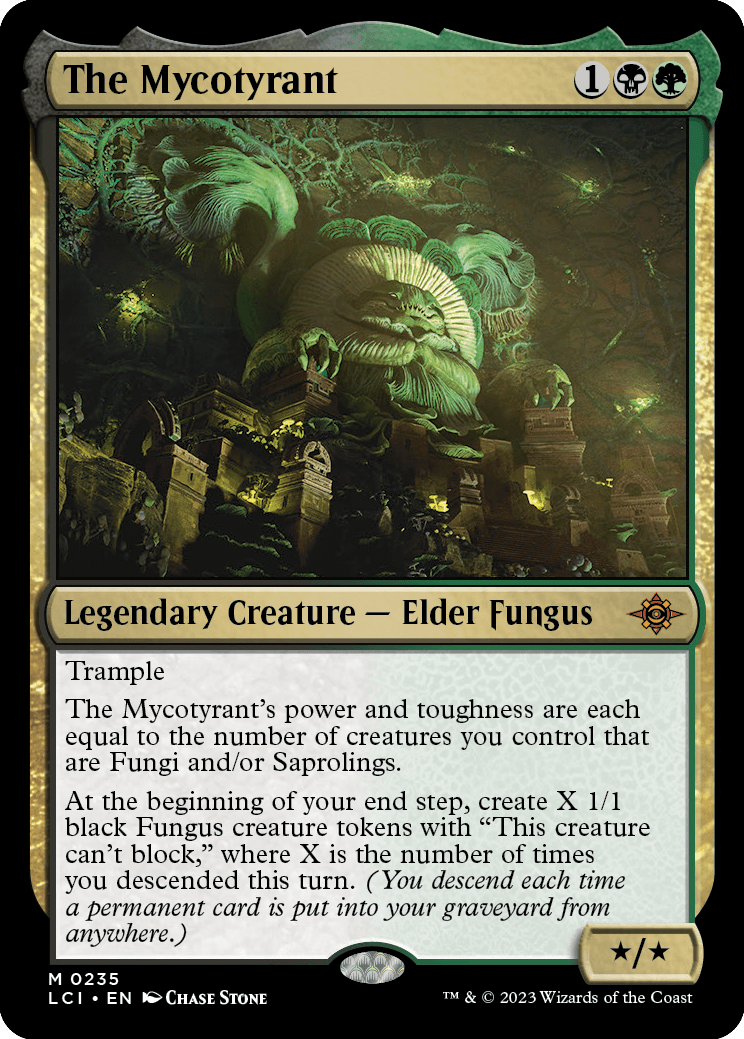
The Mycotyrant
Legendary Creature — Elder Fungus
*/*
Trample
The Mycotyrant's power and toughness are each equal to the number of creatures you control that are Fungi and/or Saprolings.
At the beginning of your end step, create X 1/1 black Fungus creature tokens with "This creature can't block," where X is the number of times you descended this turn. (You descend each time a permanent card is put into your graveyard from anywhere.)
- The ability that defines The Mycotyrant's power and toughness works in all zones. As long as The Mycotyrant is on the battlefield (and still a Fungus, or somehow a Saproling), that ability will count The Mycotyrant itself.
- If you control a creature that is both a Fungus and a Saproling, it counts only once for The Mycotyrant's middle ability.
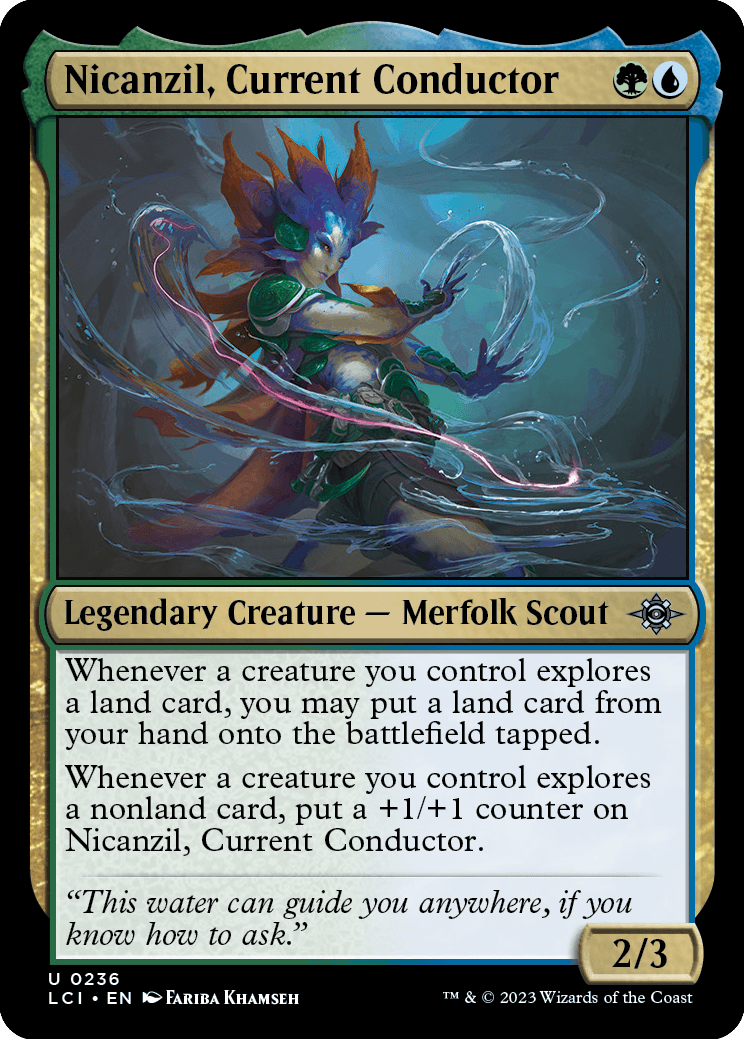
Nicanzil, Current Conductor
Legendary Creature — Merfolk Scout
2/3
Whenever a creature you control explores a land card, you may put a land card from your hand onto the battlefield tapped.
Whenever a creature you control explores a nonland card, put a +1/+1 counter on Nicanzil, Current Conductor.
- Nicanzil, Current Conductor's triggered abilities care about the characteristics of the card as it was revealed while a creature explored. It doesn't matter what happened to the card after that.
- Nicanzil's first ability won't resolve until after you're done exploring. You may put any land card from your hand onto the battlefield, including the land card you explored (if it's still in your hand) or one that was already in your hand.
- If a creature leaves the battlefield before an effect instructs it to explore, it still explores. Abilities like Nicanzil's that trigger whenever a creature you control explores will still trigger.
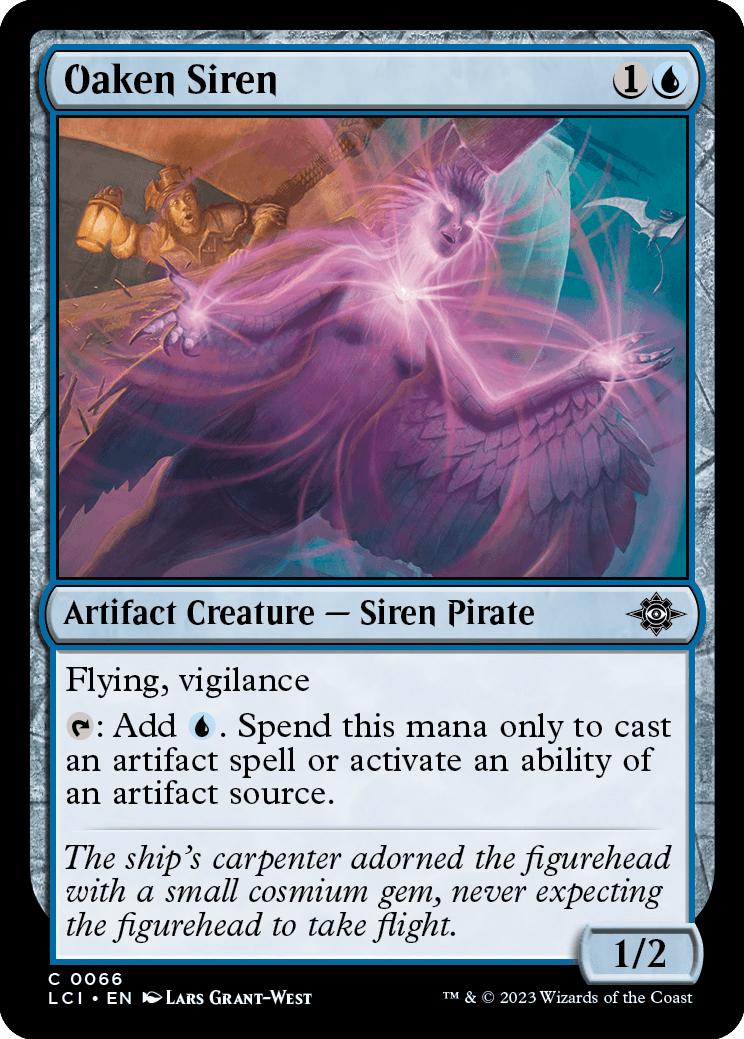
Oaken Siren
Artifact Creature — Siren Pirate
1/2
Flying, vigilance
: Add . Spend this mana only to cast an artifact spell or activate an ability of an artifact source.
- An "artifact source" is any object with the card type artifact. This means you could spend the mana to activate an ability of an artifact you control or an artifact card in your hand or graveyard, for example.
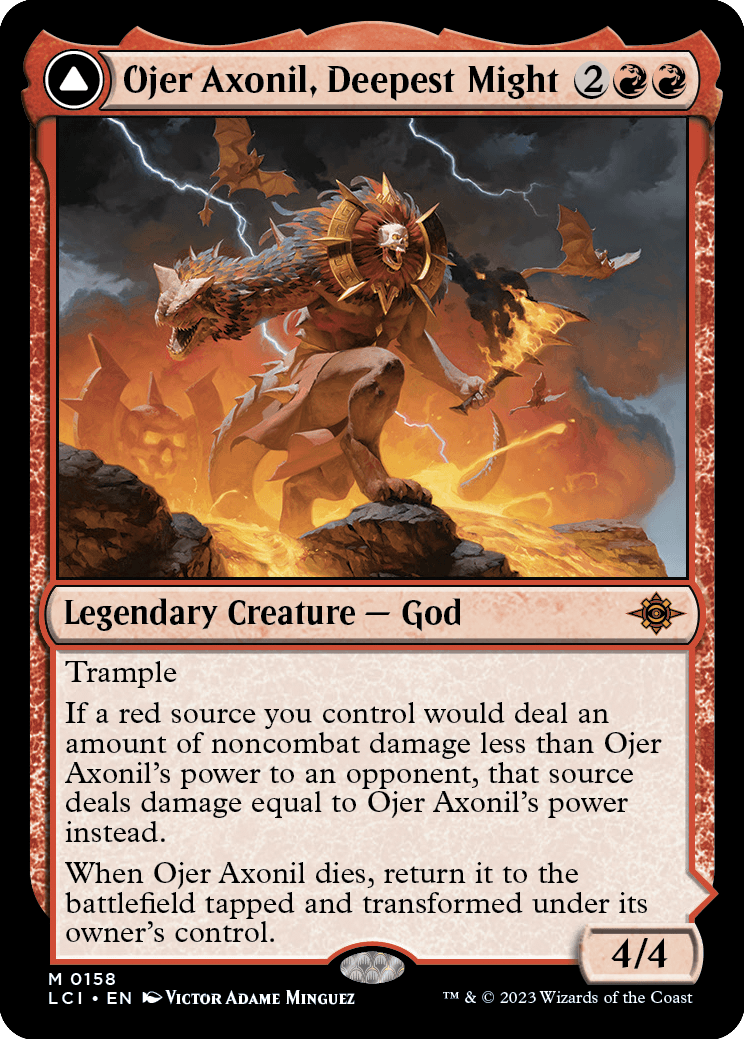
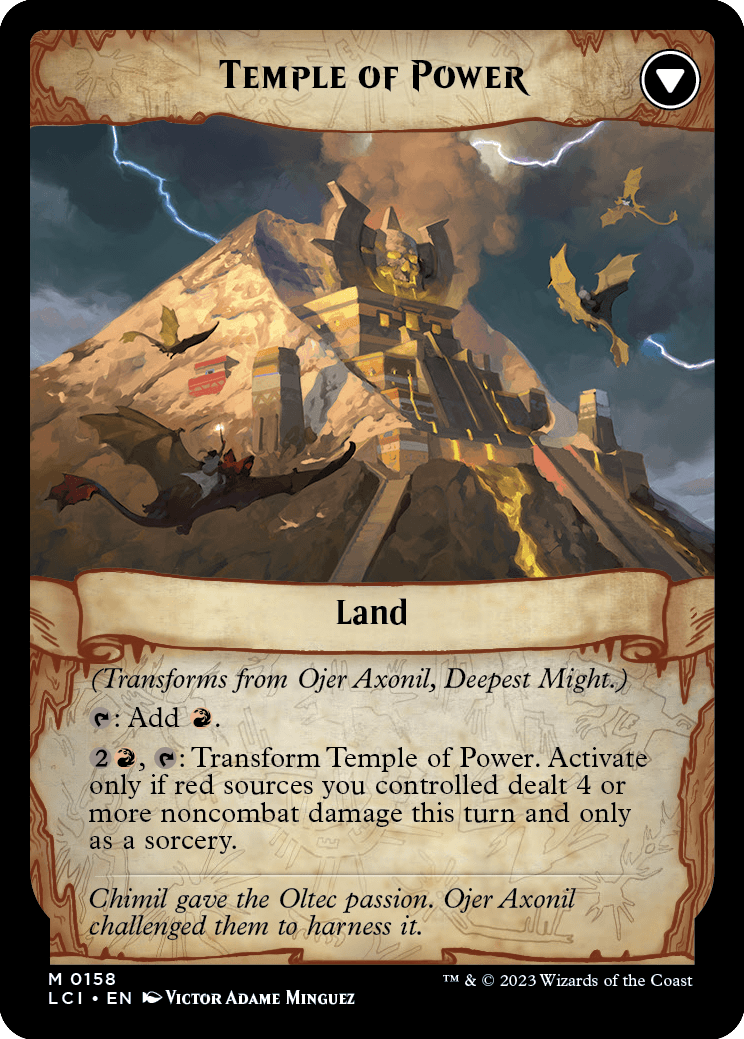
Ojer Axonil, Deepest Might
Legendary Creature — God
4/4
Trample
If a red source you control would deal an amount of noncombat damage less than Ojer Axonil's power to an opponent, that source deals damage equal to Ojer Axonil's power instead.
When Ojer Axonil dies, return it to the battlefield tapped and transformed under its owner's control.
////
Temple of Power
Land
(Transforms from Ojer Axonil, Deepest Might.)
: Add .
, : Transform Temple of Power. Activate only if red sources you controlled dealt 4 or more noncombat damage this turn and only as a sorcery.
- While you control Ojer Axonil, Deepest Might, if an effect such as that of Chandra's Pyrohelix asks you to divide damage among targets, you must divide the unmodified damage.
- The comparison between the amount of noncombat damage being dealt and Ojer Axonil's power occurs only once, when the damage would be dealt. Reducing Ojer Axonil's power before noncombat damage is dealt may cause its replacement effect not to apply to that damage.
- If Ojer Axonil's second ability and additional replacement effects would modify how damage would be dealt, the player being dealt damage chooses the order in which to apply those effects.
- If a card that isn't a transforming double-faced card is a copy of Ojer Axonil, Deepest Might, it won't return to the battlefield when it dies.
- For the purpose of Temple of Power's last ability, you need to have controlled the red source that dealt noncombat damage only at the time that the damage was dealt. If it dies or changes control after that point, that damage will still count toward Temple of Power's activation restriction.
- The 4 or more noncombat damage may be dealt by multiple red sources you controlled. For example, if you cast a red spell that dealt 3 damage to a creature and then a red artifact you controlled dealt 1 noncombat damage to a creature, you could activate Temple of Power's last ability.
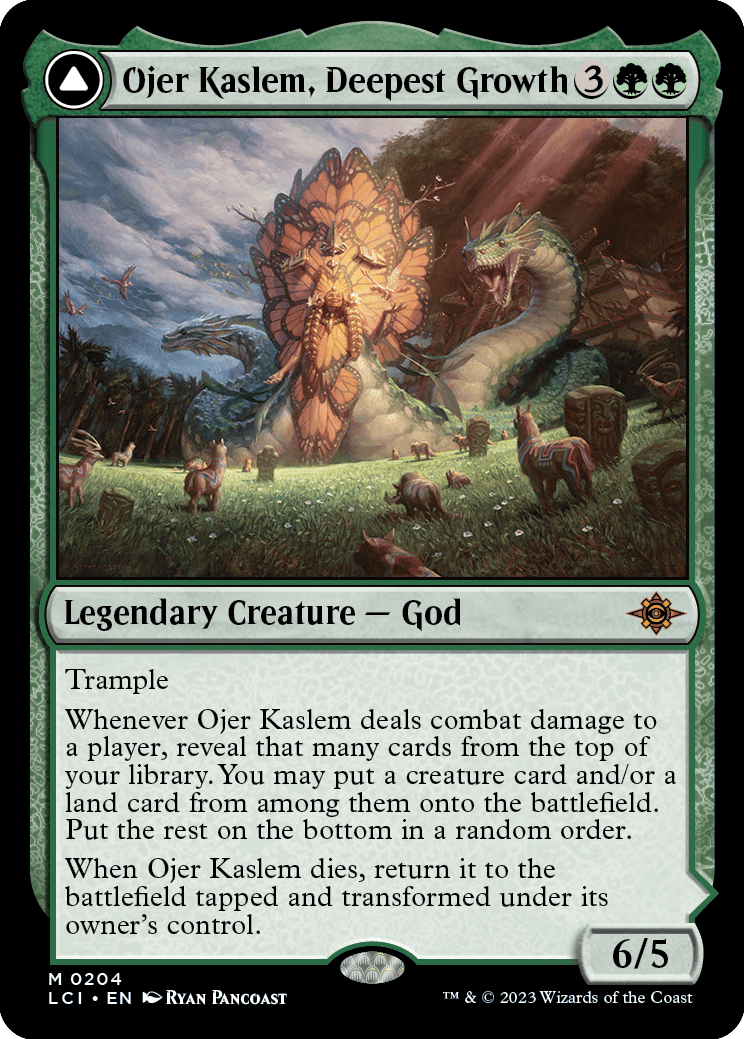
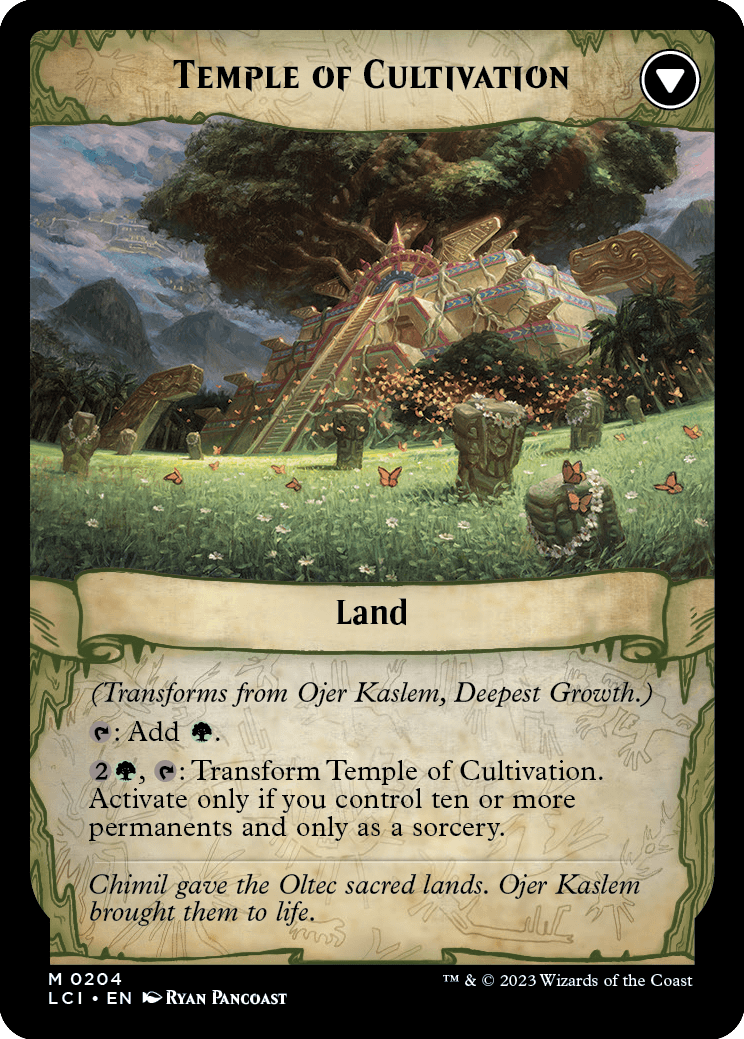
Ojer Kaslem, Deepest Growth
Legendary Creature — God
6/5
Trample
Whenever Ojer Kaslem deals combat damage to a player, reveal that many cards from the top of your library. You may put a creature card and/or a land card from among them onto the battlefield. Put the rest on the bottom in a random order.
When Ojer Kaslem dies, return it to the battlefield tapped and transformed under its owner's control.
////
Temple of Cultivation
Land
(Transforms from Ojer Kaslem, Deepest Growth.)
: Add .
, : Transform Temple of Cultivation. Activate only if you control ten or more permanents and only as a sorcery.
- While resolving Ojer Kaslem, Deepest Growth's middle ability, you could put no cards, a creature card, a land card, or a creature card and a land card onto the battlefield.
- If a card that isn't a transforming double-faced card is a copy of Ojer Kaslem, Deepest Growth, it won't return to the battlefield when it dies.
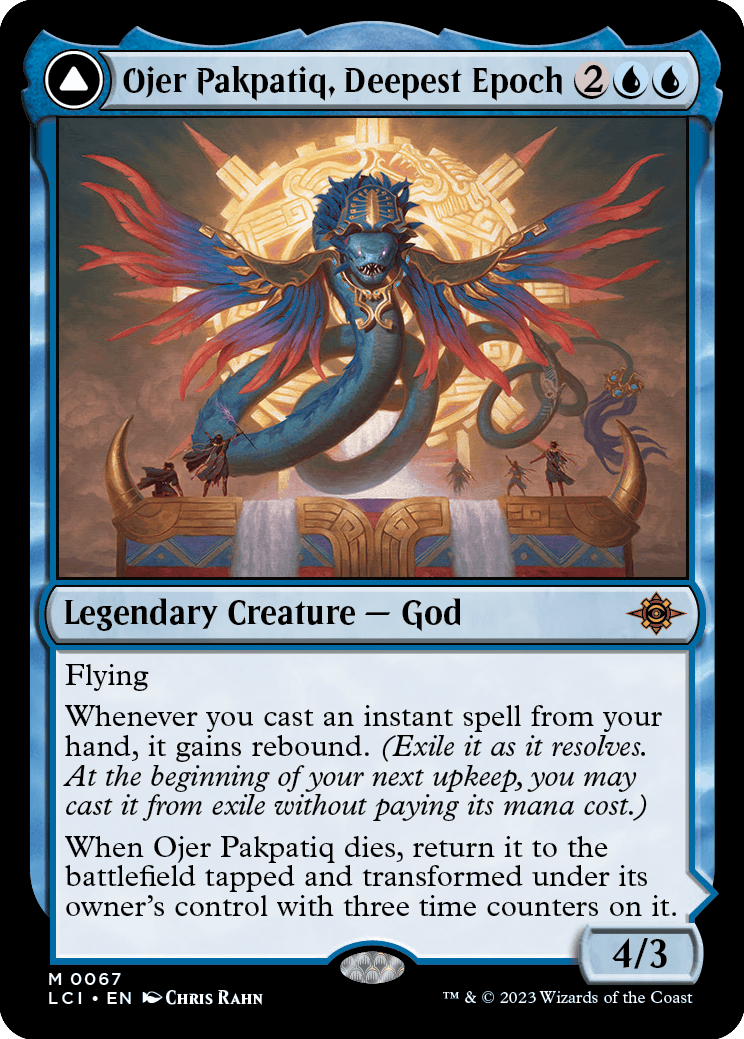
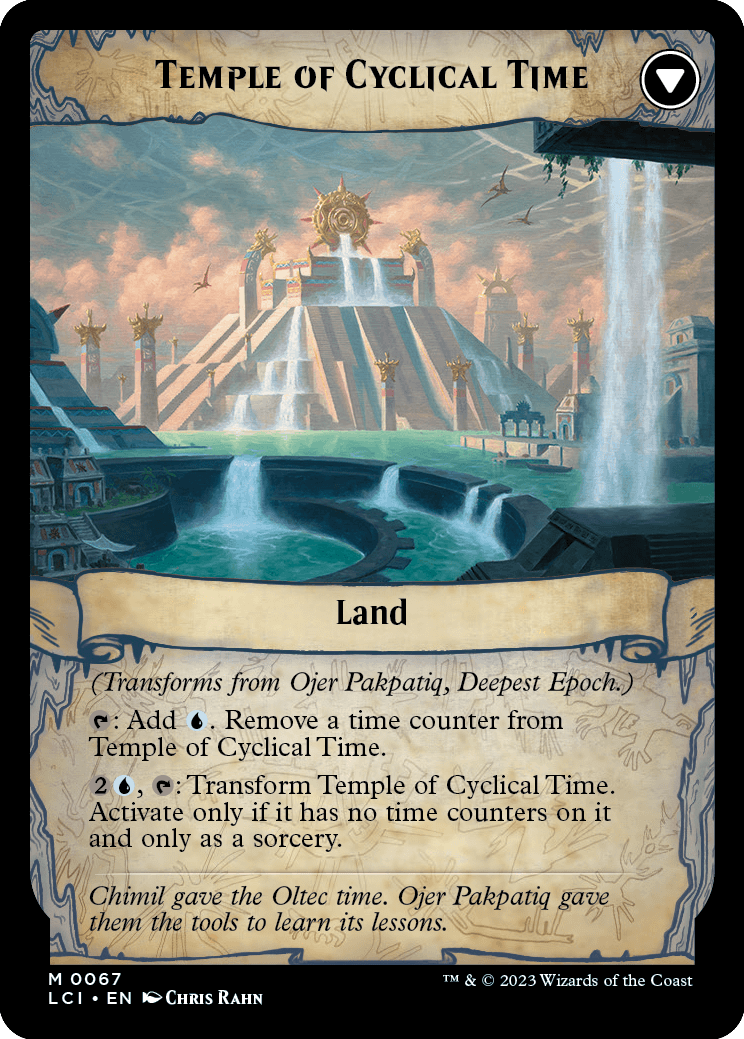
Ojer Pakpatiq, Deepest Epoch
Legendary Creature — God
4/3
Flying
Whenever you cast an instant spell from your hand, it gains rebound. (Exile it as it resolves. At the beginning of your next upkeep, you may cast it from exile without paying its mana cost.)
When Ojer Pakpatiq dies, return it to the battlefield tapped and transformed under its owner's control with three time counters on it.
////
Temple of Cyclical Time
Land
(Transforms from Ojer Pakpatiq, Deepest Epoch.)
: Add . Remove a time counter from Temple of Cyclical Time.
, : Transform Temple of Cyclical Time. Activate only if it has no time counters on it and only as a sorcery.
- Casting the card again due to rebound's delayed triggered ability is optional. If you choose not to cast the card, or if you can't because an effect prohibits it, the card will stay exiled. You won't get another chance to cast it on a future turn. If you do cast the card, it's put into its owner's graveyard as normal once it resolves.
- If a spell with rebound that you cast from your hand doesn't resolve for any reason, including being countered, that spell won't resolve and none of its effects will happen, including rebound. The spell will be put into its owner's graveyard and you won't get to cast it again on your next turn.
- If a card that isn't a transforming double-faced card is a copy of Ojer Pakpatiq, Deepest Epoch, it won't return to the battlefield when it dies.
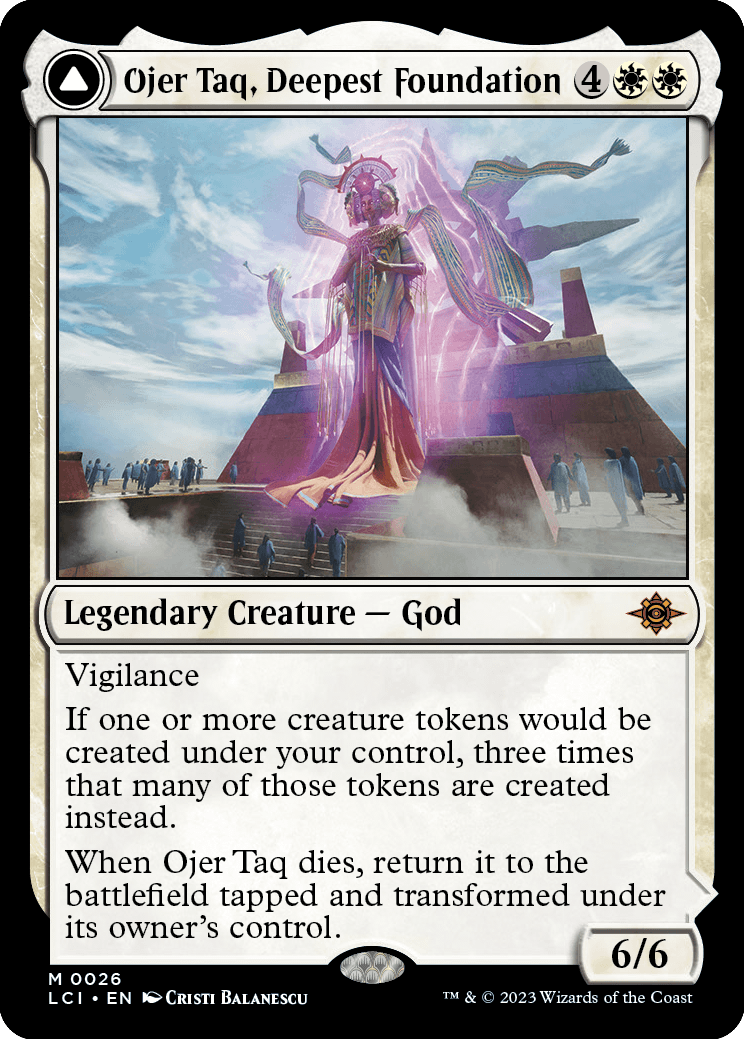
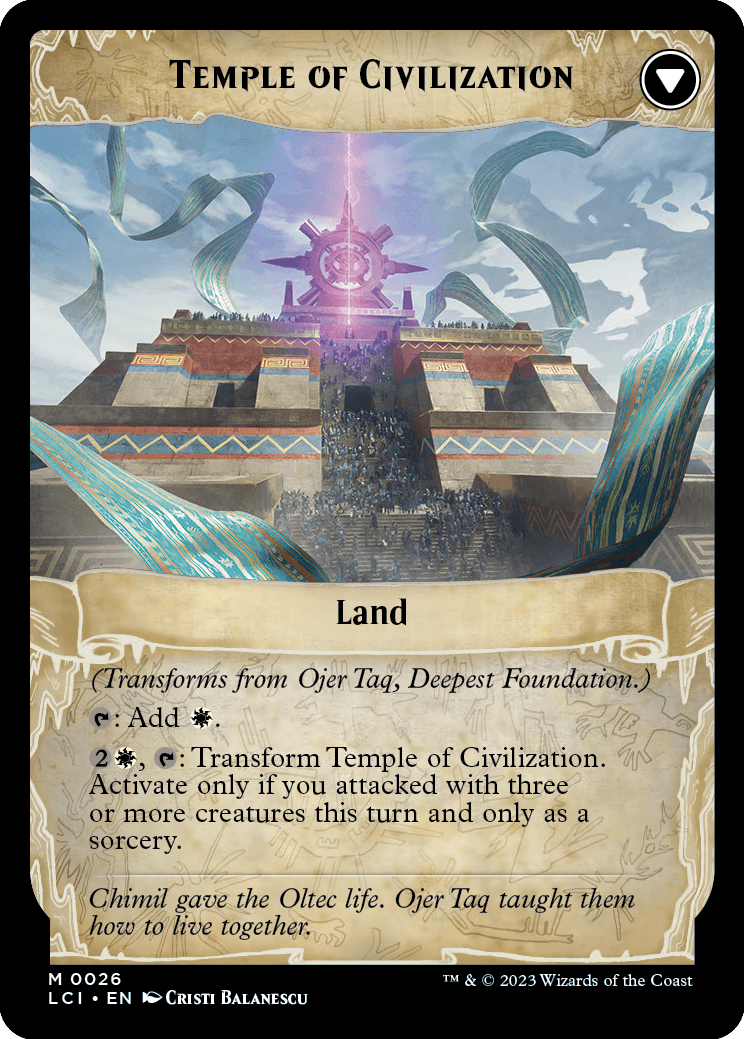
Ojer Taq, Deepest Foundation
Legendary Creature — God
6/6
Vigilance
If one or more creature tokens would be created under your control, three times that many of those tokens are created instead.
When Ojer Taq dies, return it to the battlefield tapped and transformed under its owner's control.
////
Temple of Civilization
Land
(Transforms from Ojer Taq, Deepest Foundation.)
: Add .
, : Transform Temple of Civilization. Activate only if you attacked with three or more creatures this turn and only as a sorcery.
- Everything that is specified by the effect creating the original token or tokens will also be true about the additional tokens created by Ojer Taq, Deepest Foundation's replacement effect. For example, if an effect tells you to create a token "tapped and attacking," the additional tokens will also be tapped and attacking. Similarly, if an effect creates a token and puts counters on it, the additional tokens will also get those counters.
- If a card that isn't a transforming double-faced card is a copy of Ojer Taq, Deepest Foundation, it won't return to the battlefield when it dies.
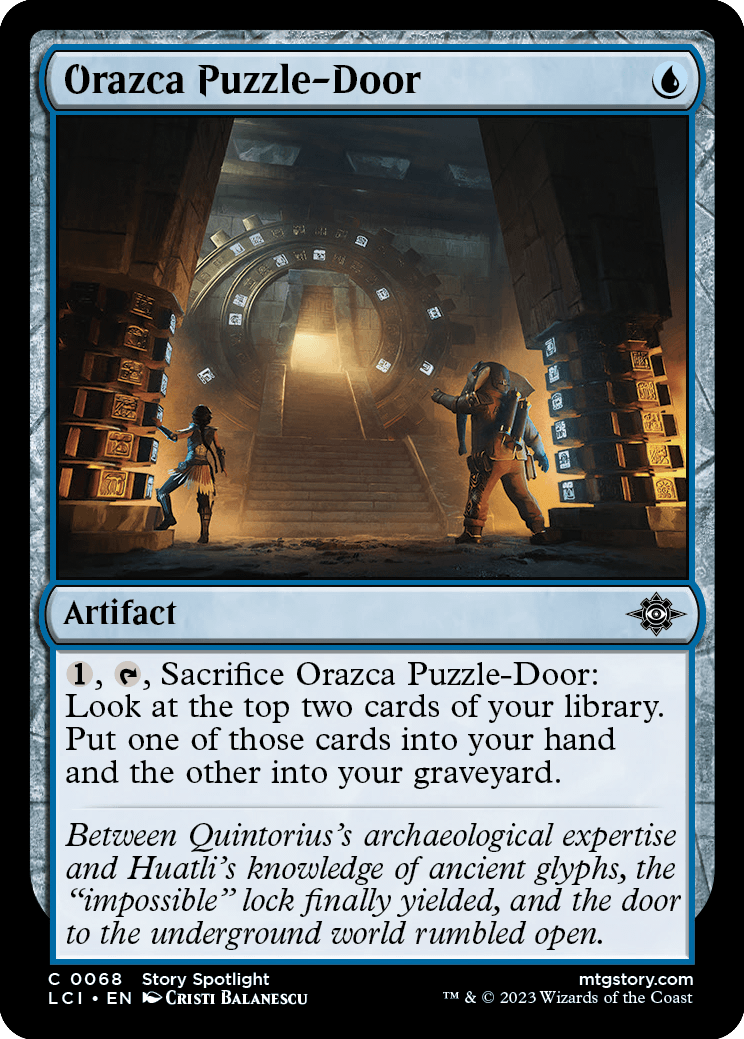
Orazca Puzzle-Door
Artifact
, , Sacrifice Orazca Puzzle-Door: Look at the top two cards of your library. Put one of those cards into your hand and the other into your graveyard.
- If there is only one card in your library, you put it into your hand.
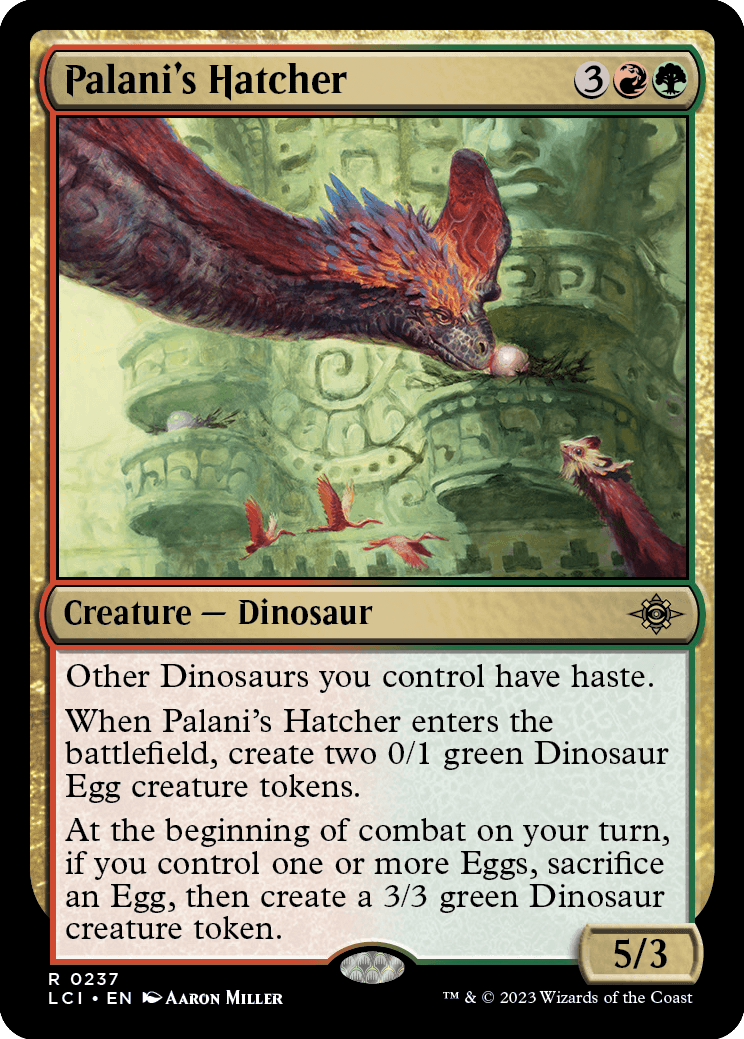
Palani's Hatcher
Creature — Dinosaur
5/3
Other Dinosaurs you control have haste.
When Palani's Hatcher enters the battlefield, create two 0/1 green Dinosaur Egg creature tokens.
At the beginning of combat on your turn, if you control one or more Eggs, sacrifice an Egg, then create a 3/3 green Dinosaur creature token.
- Palani's Hatcher's last ability counts any creature you control with the creature type Egg, not just the tokens Palani's Hatcher creates.
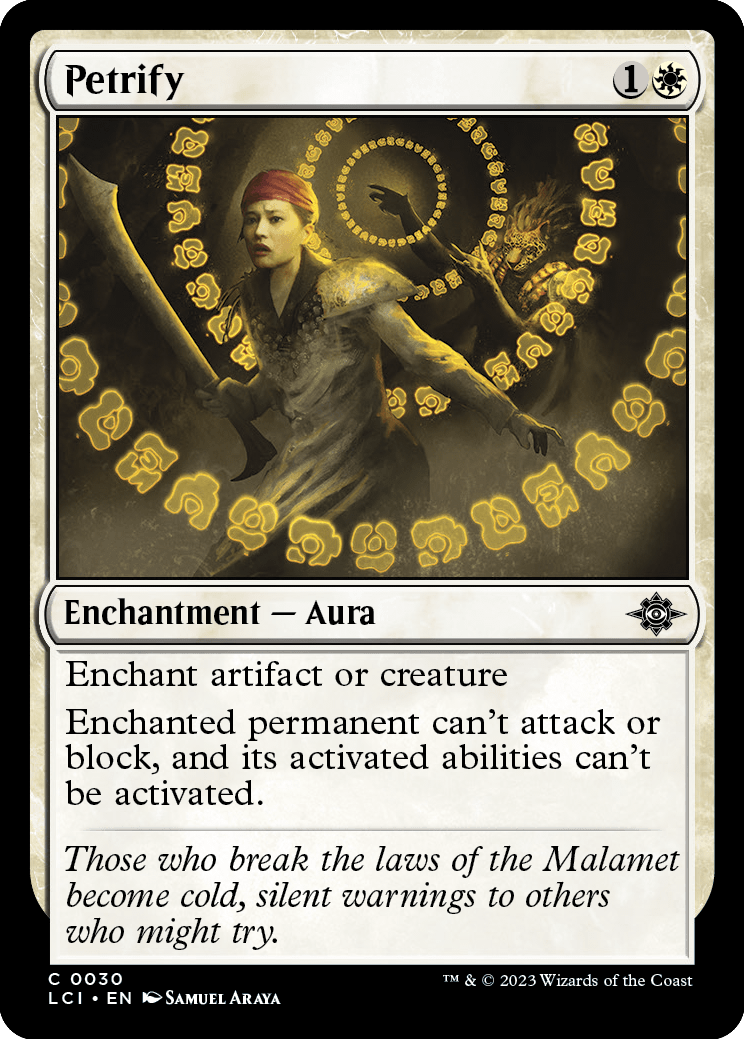
Petrify
Enchantment — Aura
Enchant artifact or creature
Enchanted permanent can't attack or block, and its activated abilities can't be activated.
- Activated abilities contain a colon. They're generally written "[Cost]: [Effect]." Some keywords are activated abilities and will have colons in their reminder text.
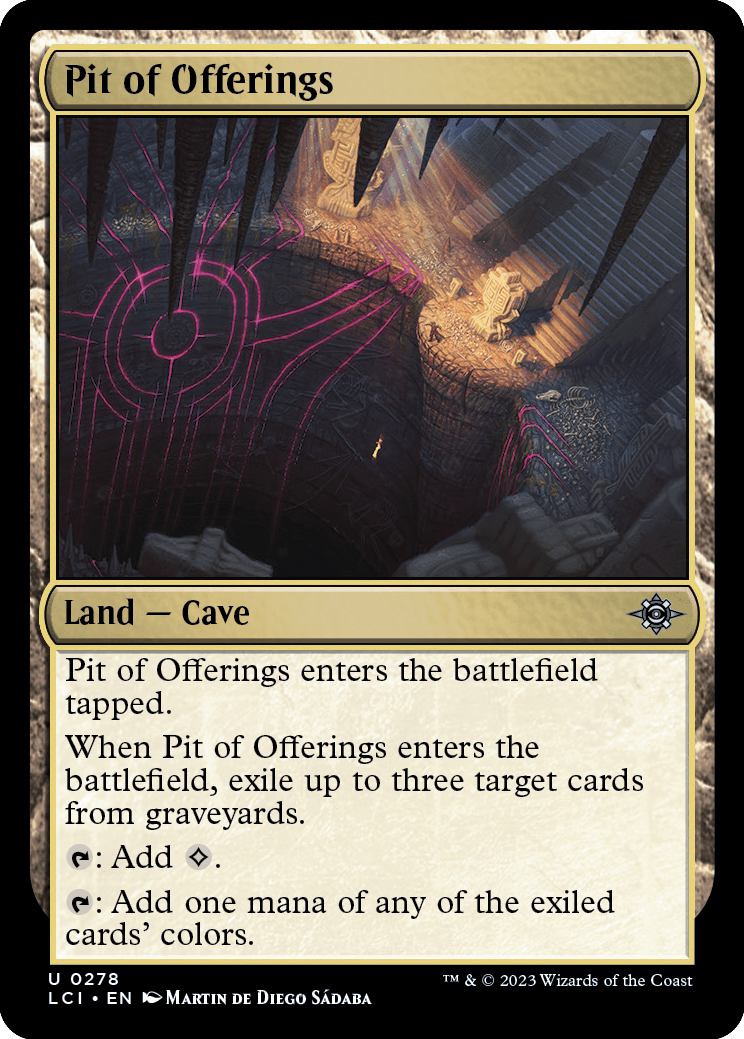
Pit of Offerings
Land — Cave
Pit of Offerings enters the battlefield tapped.
When Pit of Offerings enters the battlefield, exile up to three target cards from graveyards.
: Add .
: Add one mana of any of the exiled cards' colors.
- The five colors are white, blue, black, red, and green. The last ability of Pit of Offerings can't produce .
- If no cards are exiled with Pit of Offerings, its last ability can't add mana.
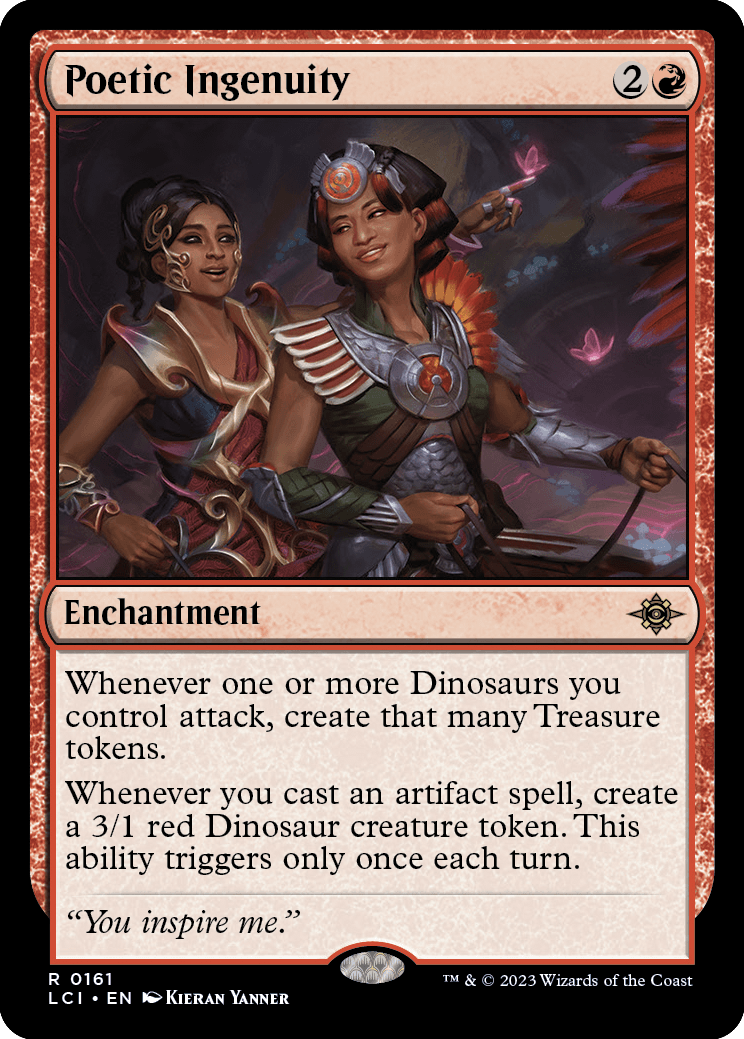
Poetic Ingenuity
Enchantment
Whenever one or more Dinosaurs you control attack, create that many Treasure tokens.
Whenever you cast an artifact spell, create a 3/1 red Dinosaur creature token. This ability triggers only once each turn.
- Poetic Ingenuity's last ability resolves before the spell that caused it to trigger. You create a Dinosaur token even if the artifact spell is countered.
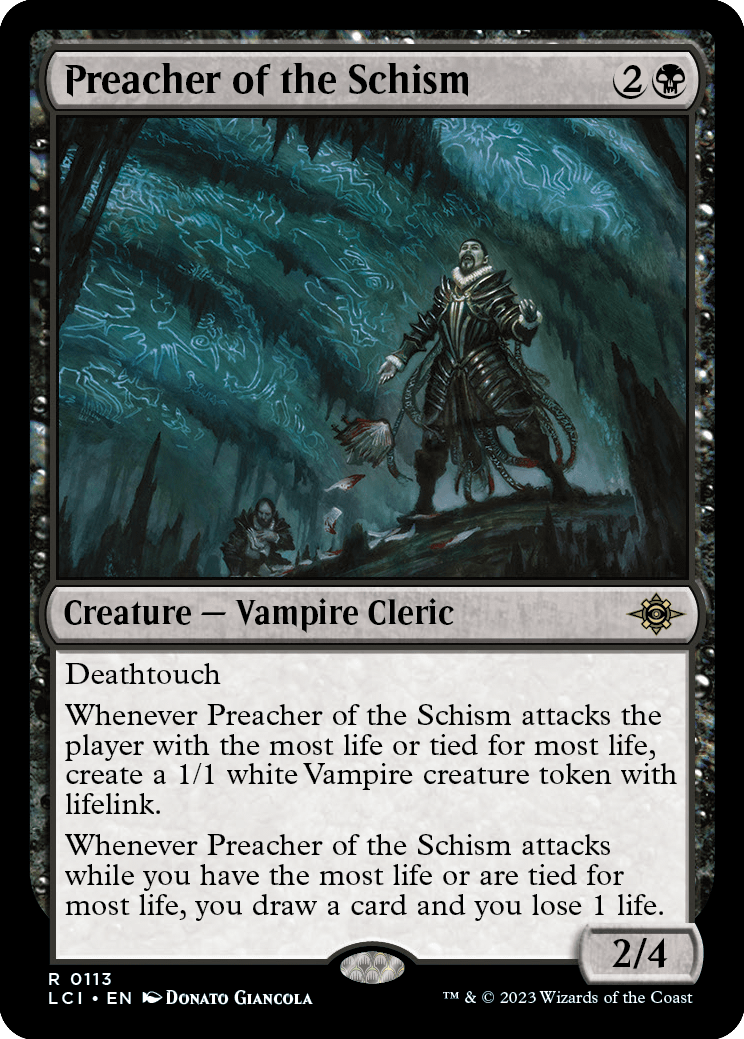
Preacher of the Schism
Creature — Vampire Cleric
2/4
Deathtouch
Whenever Preacher of the Schism attacks the player with the most life or tied for most life, create a 1/1 white Vampire creature token with lifelink.
Whenever Preacher of the Schism attacks while you have the most life or are tied for most life, you draw a card and you lose 1 life.
- If you are tied for most life and Preacher of the Schism attacks another player who is tied for most life, both its middle and its last ability will trigger.
- Preacher of the Schism's middle ability triggers only if it attacks a player. It won't trigger if Preacher of the Schism attacks a planeswalker or battle, no matter what its controller's life total is.
- Once Preacher of the Schism's middle ability triggers, it doesn't matter what happens to players' life totals before the ability resolves. You'll create a Vampire token even if the player Preacher of the Schism attacked doesn't have the most life as the ability resolves.
- Similarly, once Preacher of the Schism's last ability triggers, it doesn't matter what happens to players' life totals before the ability resolves. You'll draw a card and lose 1 life even if you don't have the most life as the ability resolves.
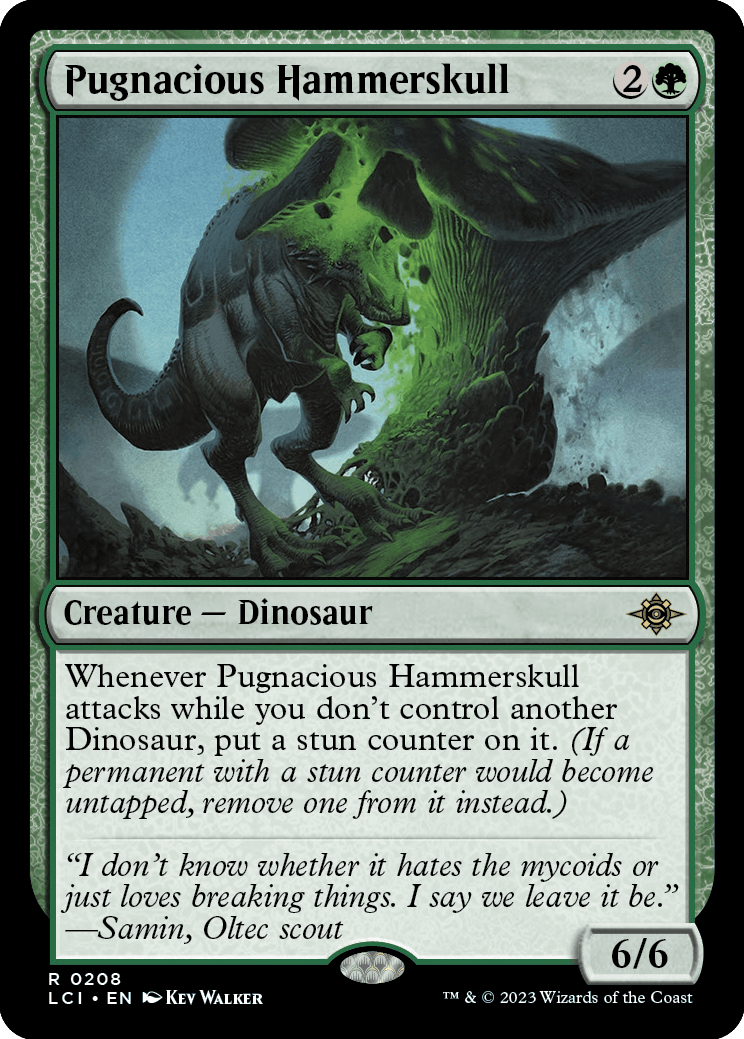
Pugnacious Hammerskull
Creature — Dinosaur
6/6
Whenever Pugnacious Hammerskull attacks while you don't control another Dinosaur, put a stun counter on it. (If a permanent with a stun counter would become untapped, remove one from it instead.)
- If you didn't control another Dinosaur when you declared Pugnacious Hammerskull as an attacker, it doesn't matter whether or not you control one as its ability resolves. You'll still put a stun counter on Pugnacious Hammerskull.
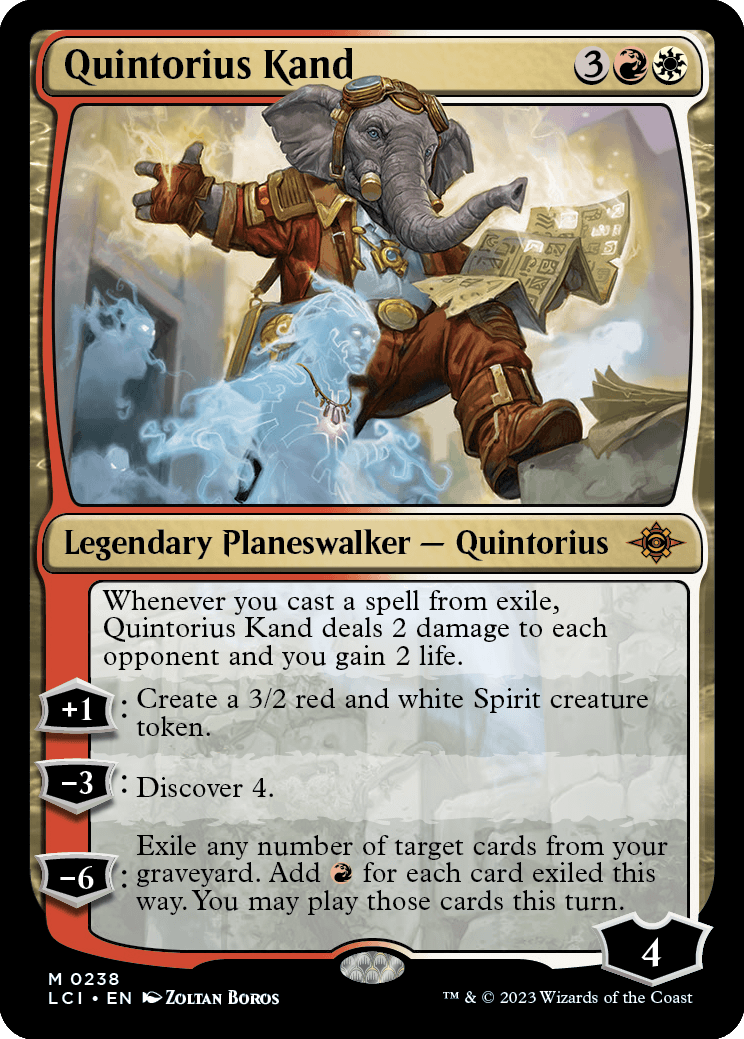
Quintorius Kand
Legendary Planeswalker — Quintorius
4
Whenever you cast a spell from exile, Quintorius Kand deals 2 damage to each opponent and you gain 2 life.
+1: Create a 3/2 red and white Spirit creature token.
−3: Discover 4.
−6: Exile any number of target cards from your graveyard. Add for each card exiled this way. You may play those cards this turn.
- You must follow all normal timing rules for a card you play with Quintorius Kand's last ability and, if it's a spell, you must pay its costs to cast it.
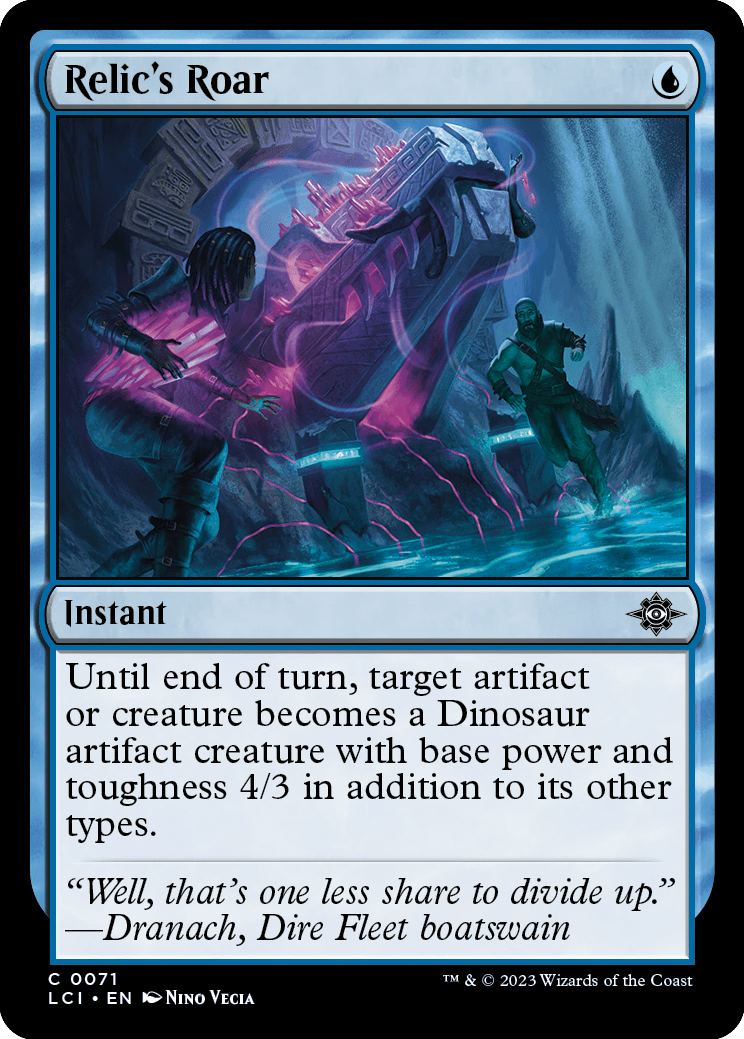
Relic's Roar
Instant
Until end of turn, target artifact or creature becomes a Dinosaur artifact creature with base power and toughness 4/3 in addition to its other types.
- Relic's Roar overwrites all previous effects that set the creature's base power and toughness to specific values. Any power- or toughness-setting effects that start to apply afterward will overwrite this effect.
- The artifact or creature retains its abilities and colors, if any.
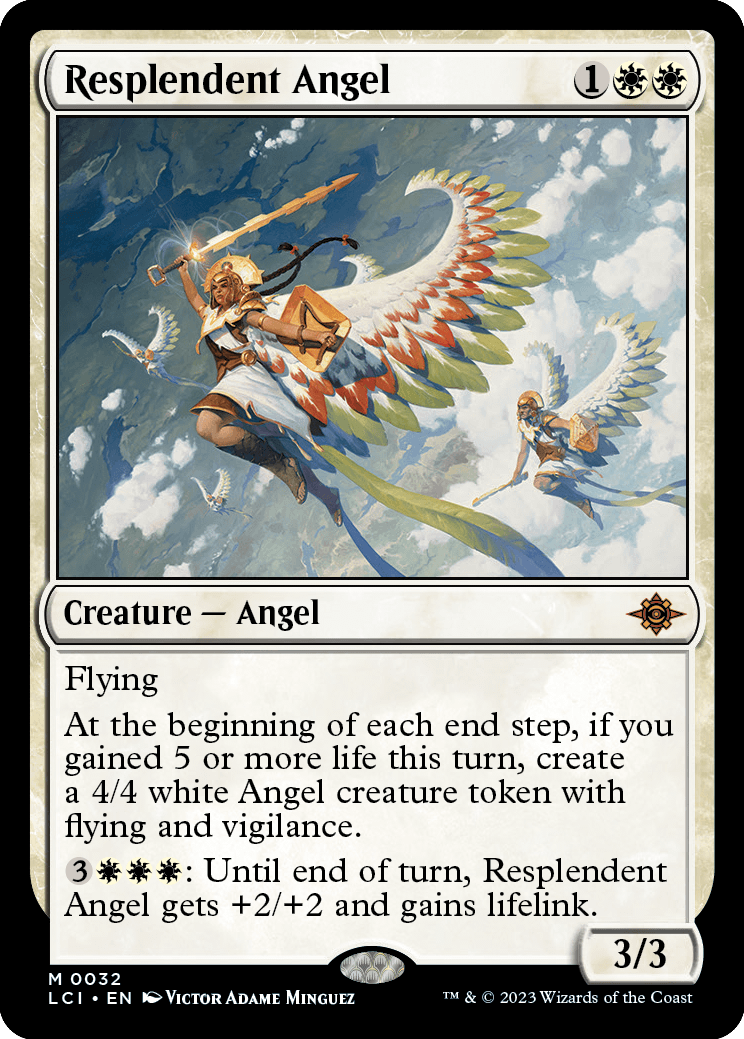
Resplendent Angel
Creature — Angel
3/3
Flying
At the beginning of each end step, if you gained 5 or more life this turn, create a 4/4 white Angel creature token with flying and vigilance.
: Until end of turn, Resplendent Angel gets +2/+2 and gains lifelink.
- Resplendent Angel's triggered ability checks if you gained 5 or more life total during the turn. It doesn't matter if you also lost life or whether your life total is greater than it was at the beginning of the turn. It also doesn't matter whether Resplendent Angel was on the battlefield when any of the life gain happened.
- You don't need to have gained 5 life all at once to satisfy Resplendent Angel's triggered ability.
- If you didn't gain life during the turn before the end step begins, Resplendent Angel's triggered ability won't trigger at all. Gaining life during the end step won't cause the ability to trigger.
- You create only one Angel token, no matter how many times you gained 5 or more life.
- In a Two-Headed Giant game, life gained by your teammate won't satisfy Resplendent Angel's triggered ability, even though it caused your team's life total to increase.
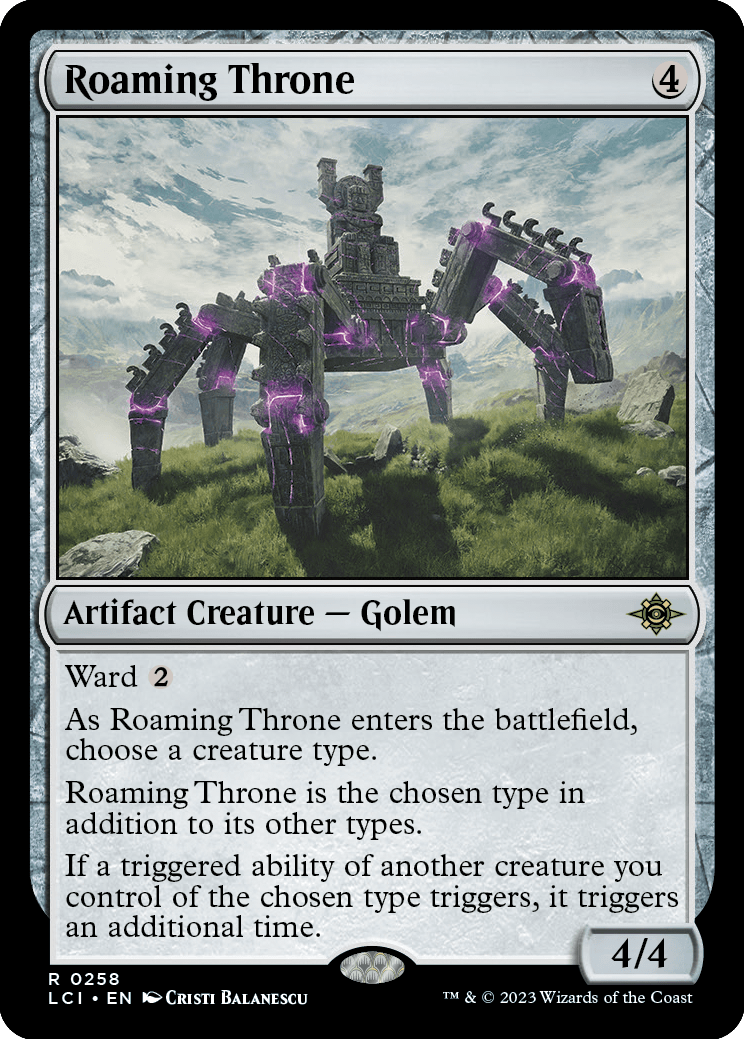
Roaming Throne
Artifact Creature — Golem
4/4
Ward
As Roaming Throne enters the battlefield, choose a creature type.
Roaming Throne is the chosen type in addition to its other types.
If a triggered ability of another creature you control of the chosen type triggers, it triggers an additional time.
- Roaming Throne's last ability doesn't copy the triggered ability; it just causes the ability to trigger an additional time. Any choices made as you put the ability onto the stack, such as modes and targets, are made separately for each instance of the ability. Any choices made on resolution, such as whether to put counters on a permanent, are also made individually.
- If you control two Roaming Thrones with the same chosen creature type, triggered abilities of other creatures you control of the chosen type trigger three times. Three such Roaming Thrones result in four triggered abilities, and so on.
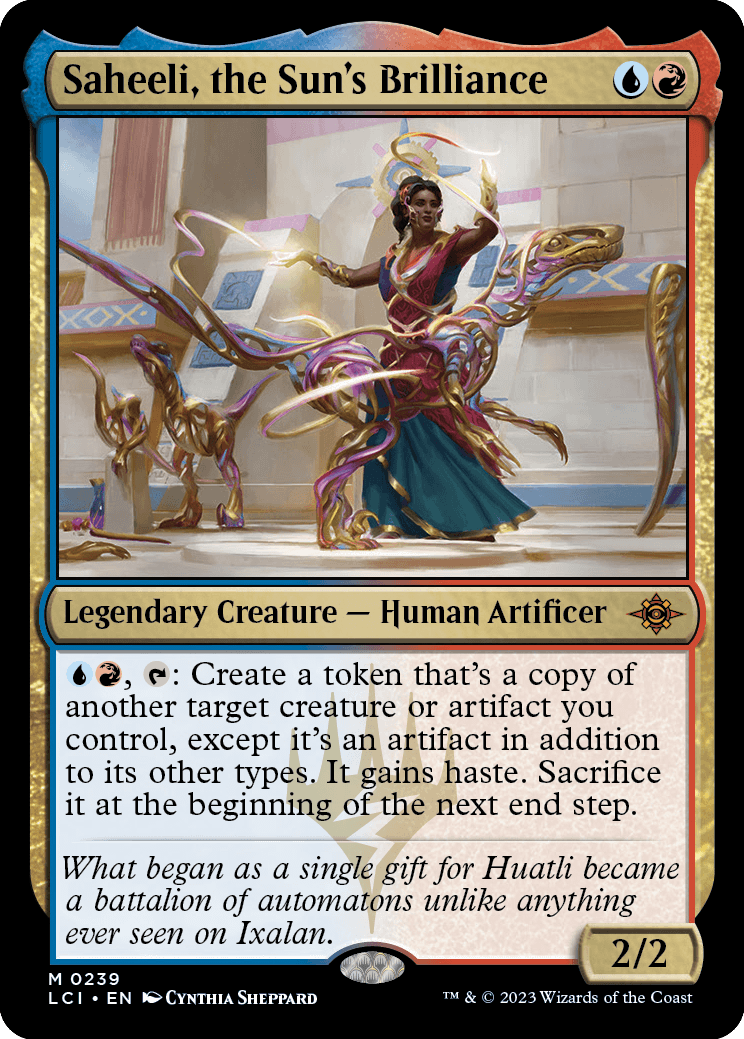
Saheeli, the Sun's Brilliance
Legendary Creature — Human Artificer
2/2
, : Create a token that's a copy of another target creature or artifact you control, except it's an artifact in addition to its other types. It gains haste. Sacrifice it at the beginning of the next end step.
- The token copies exactly what was printed on the original permanent, with the listed exceptions (unless that permanent is copying something else or is a token; see below). It doesn't copy whether that permanent is tapped or untapped, whether it has any counters on it or any Auras or Equipment attached to it, or any non-copy effects that have changed its types, color, power and toughness, and so on.
- If the copied permanent has in its mana cost, X is 0.
- If the copied permanent is a token, the new token that's created copies the original characteristics of that token as stated by the effect that created the token (with the listed exceptions).
- If the copied permanent is copying something else, then the token enters the battlefield as whatever that permanent copied (with the listed exceptions).
- Any enters-the-battlefield abilities of the copied permanent will trigger when the token enters the battlefield. Any "as [this permanent] enters the battlefield" or "[this permanent] enters the battlefield with" abilities of the target permanent will also work.
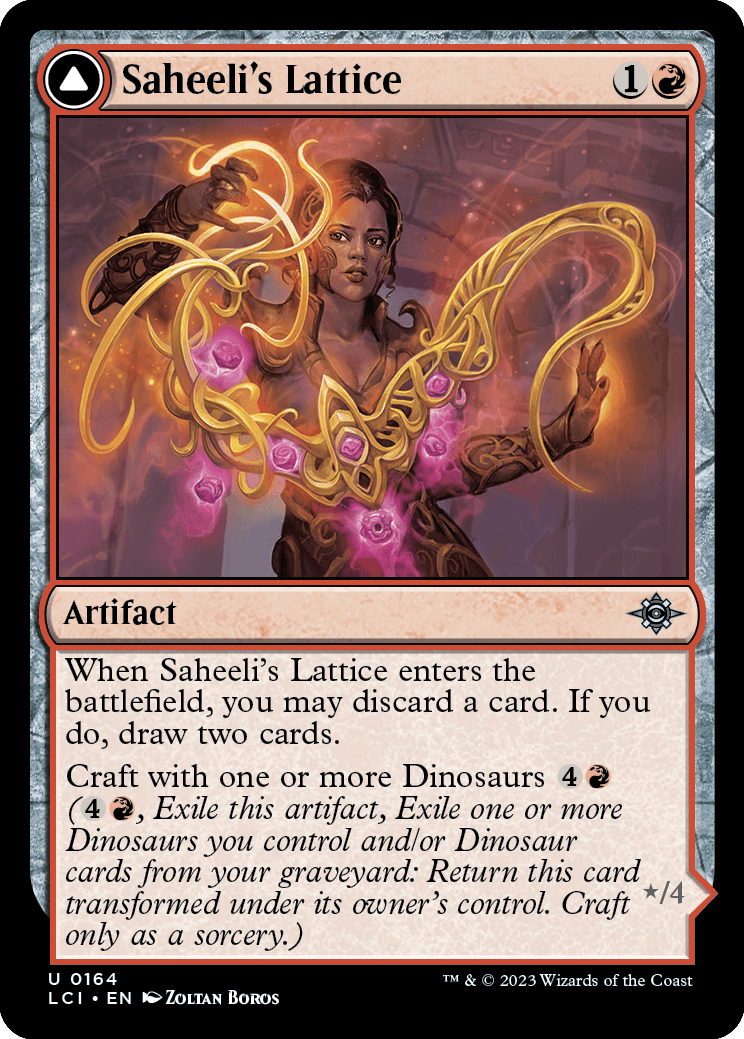
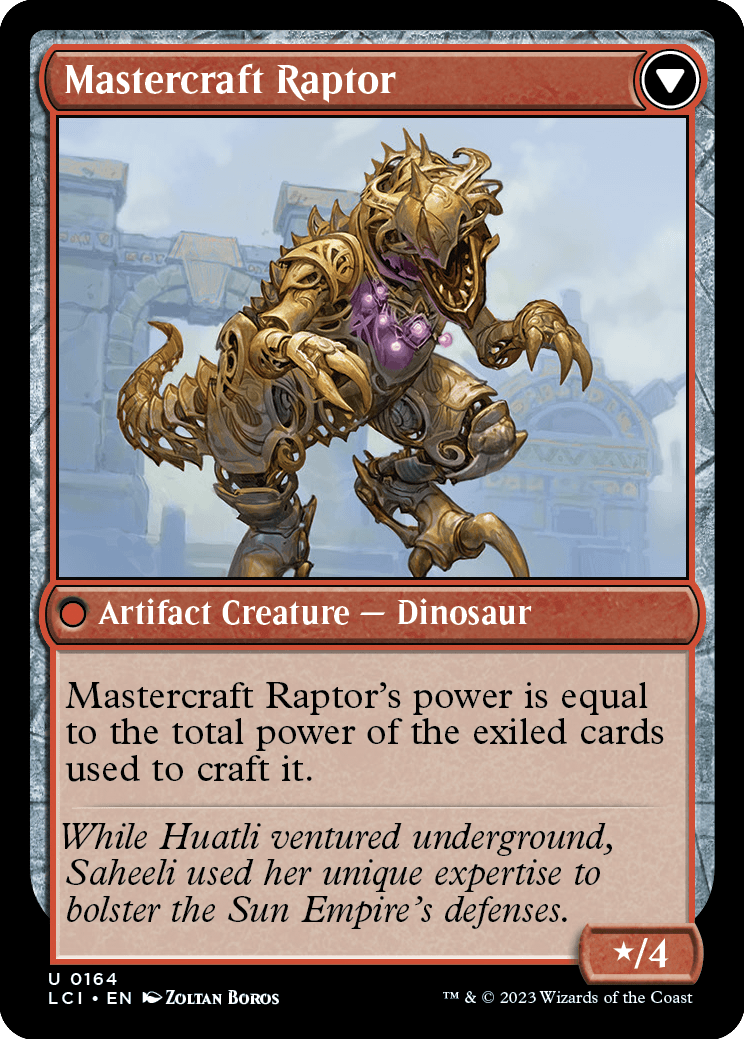
Saheeli's Lattice
Artifact
When Saheeli's Lattice enters the battlefield, you may discard a card. If you do, draw two cards.
Craft with one or more Dinosaurs (, Exile this artifact, Exile one or more Dinosaurs you control and/or Dinosaur cards from your graveyard: Return this card transformed under its owner's control. Craft only as a sorcery.)
////
Mastercraft Raptor
Artifact Creature — Dinosaur
*/4
Mastercraft Raptor's power is equal to the total power of the exiled cards used to craft it.
- If any of the exiled cards has a characteristic-defining ability that defines its power, that ability will apply. For example, if you somehow used Souls of the Lost to craft Mastercraft Raptor (perhaps because it became a copy of a Dinosaur), its power while in exile is equal to the number of permanent cards in your graveyard, and Mastercraft Raptor's power will change as the number of permanent cards in your graveyard changes. If the characteristic-defining ability can't be applied, then use 0.
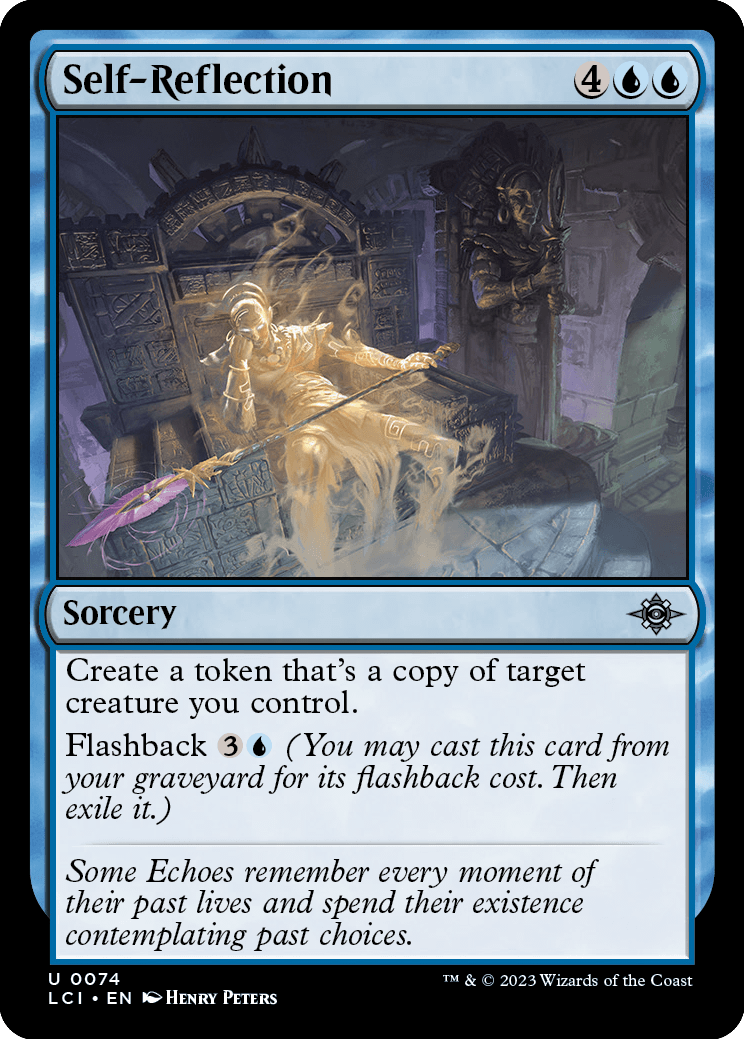
Self-Reflection
Sorcery
Create a token that's a copy of target creature you control.
Flashback (You may cast this card from your graveyard for its flashback cost. Then exile it.)
- The token copies exactly what was printed on the original creature (unless that permanent is copying something else or is a token; see below). It doesn't copy whether that creature is tapped or untapped, whether it has any counters on it or any Auras or Equipment attached to it, or any non-copy effects that have changed its types, color, power and toughness, and so on.
- If the copied creature has in its mana cost, X is 0.
- If the copied creature is a token, the new token that's created copies the original characteristics of that token as stated by the effect that created the token.
- If the copied creature is copying something else, then the token enters the battlefield as whatever that creature copied.
- Any enters-the-battlefield abilities of the copied creature will trigger when the token enters the battlefield. Any "as [this creature] enters the battlefield" or "[this creature] enters the battlefield with" abilities of the target creature will also work.
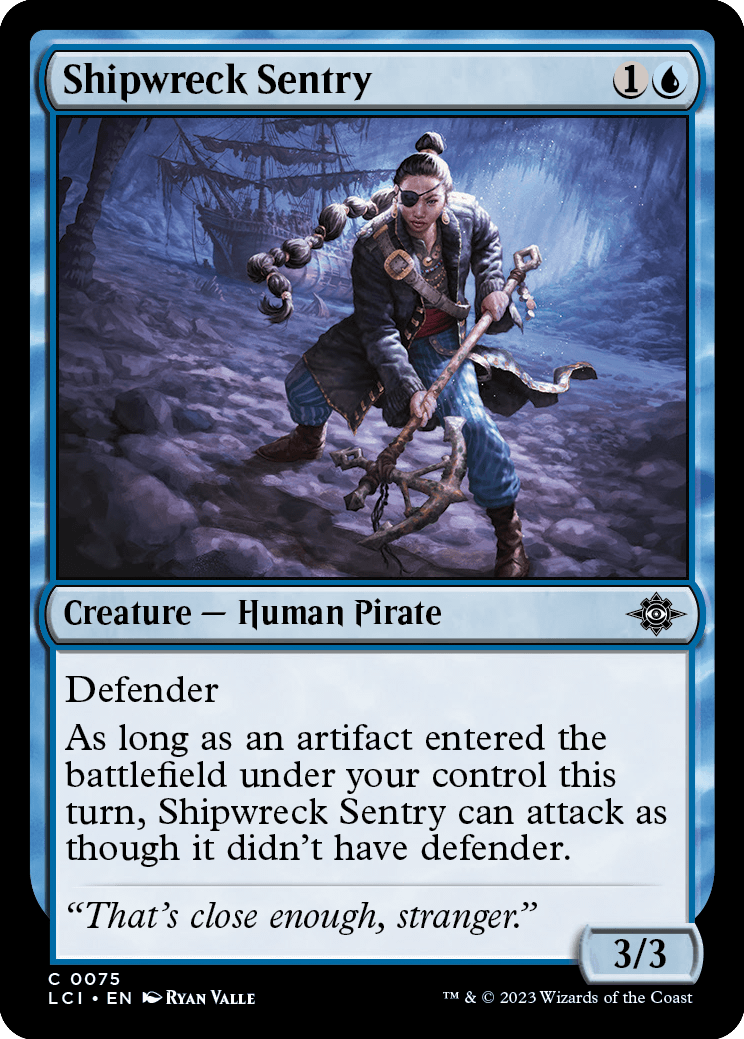
Shipwreck Sentry
Creature — Human Pirate
3/3
Defender
As long as an artifact entered the battlefield under your control this turn, Shipwreck Sentry can attack as though it didn't have defender.
- Once an artifact enters the battlefield under your control, Shipwreck Sentry can attack that turn as though it didn't have defender. It doesn't matter if that artifact stays an artifact or stays under your control.
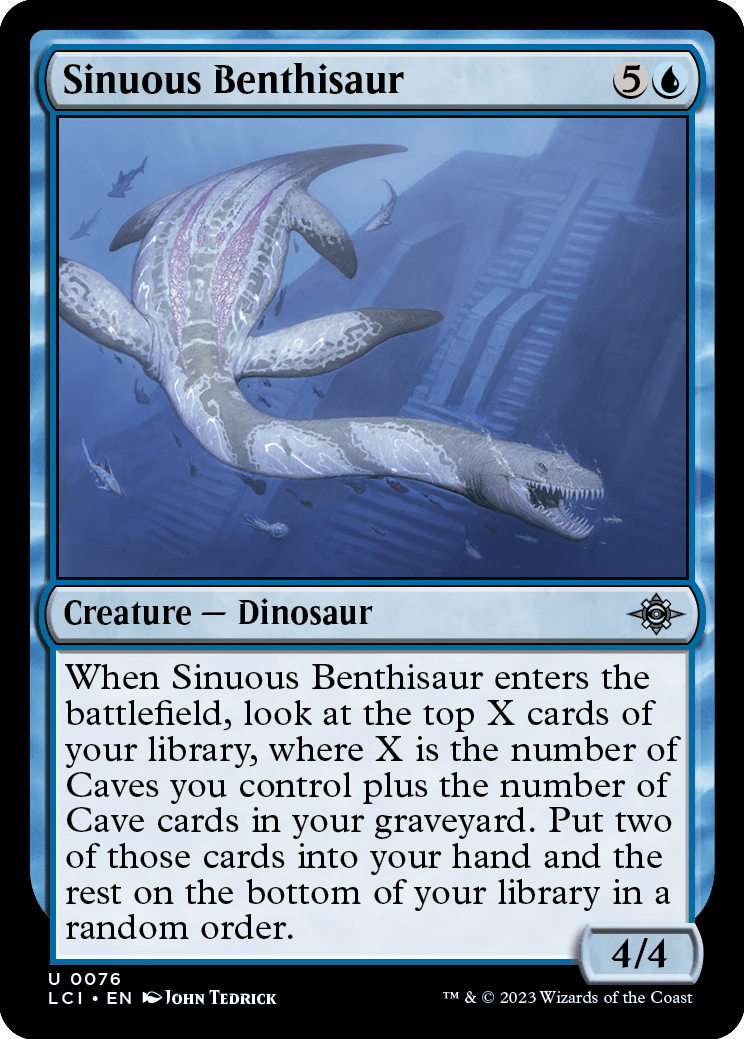
Sinuous Benthisaur
Creature — Dinosaur
4/4
When Sinuous Benthisaur enters the battlefield, look at the top X cards of your library, where X is the number of Caves you control plus the number of Cave cards in your graveyard. Put two of those cards into your hand and the rest on the bottom of your library in a random order.
- If X is 1, you'll look at the top card of your library and put it into your hand. If X is 0, you won't look at any cards from the top of your library.
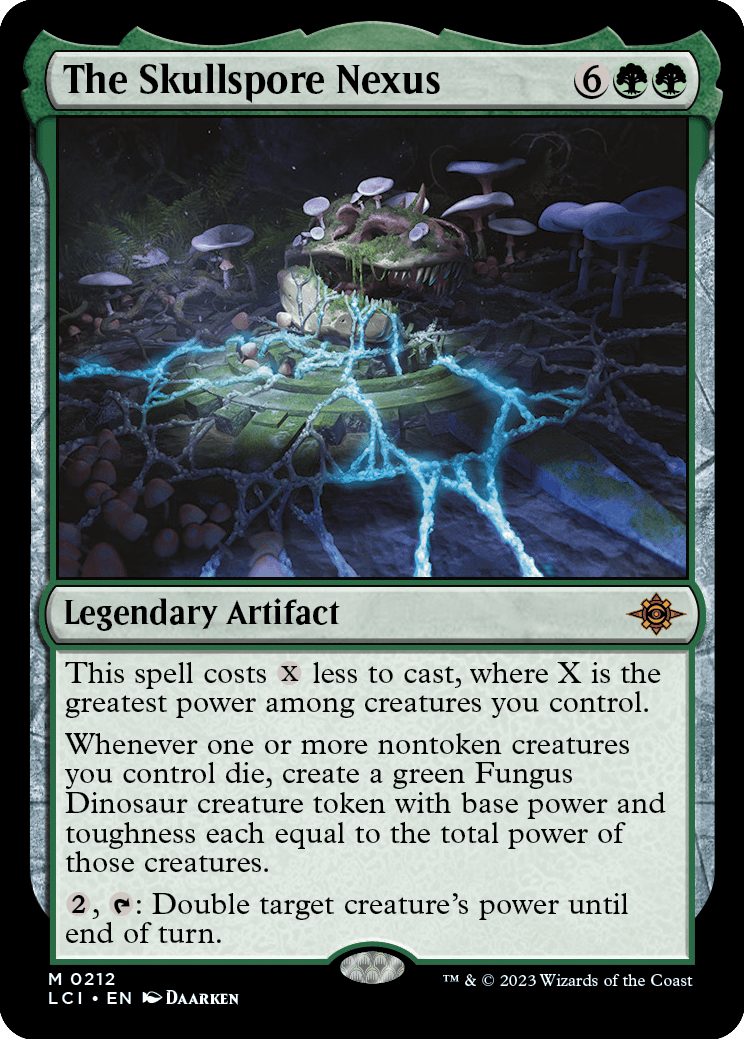
The Skullspore Nexus
Legendary Artifact
This spell costs less to cast, where X is the greatest power among creatures you control.
Whenever one or more nontoken creatures you control die, create a green Fungus Dinosaur creature token with base power and toughness each equal to the total power of those creatures.
, : Double target creature's power until end of turn.
- The first step of casting a spell is to move it to the stack. If this causes the greatest power among creatures you control to change (for example, if you control a creature with "This creature's power is equal to the number of cards in your hand"), that new power will be used to determine the cost reduction.
- Once you determine the cost to cast The Skullspore Nexus, you may activate abilities to pay that cost. If the greatest power among creatures you control changes while activating mana abilities, the cost to cast The Skullspore Nexus remains what you previously determined.
- Use the power of the nontoken creatures that died as they last existed on the battlefield to determine the base power and toughness of the token created by the middle ability.
- To double a creature's power, that creature gets +X/+0, where X is that creature's power as The Skullspore Nexus's activated ability resolves.
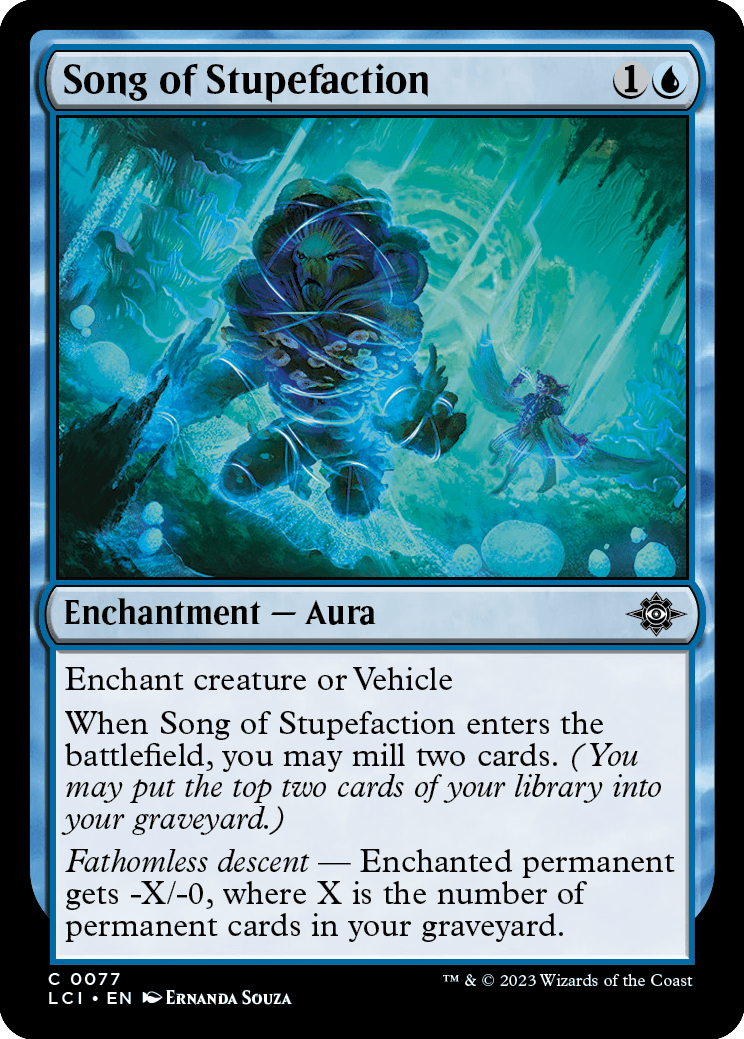
Song of Stupefaction
Enchantment — Aura
Enchant creature or Vehicle
When Song of Stupefaction enters the battlefield, you may mill two cards. (You may put the top two cards of your library into your graveyard.)
Fathomless descent — Enchanted permanent gets -X/-0, where X is the number of permanent cards in your graveyard.
- If you don't have at least two cards in your library, you can't choose to mill two cards.
- The value of X will change as the number of permanent cards in your graveyard changes.
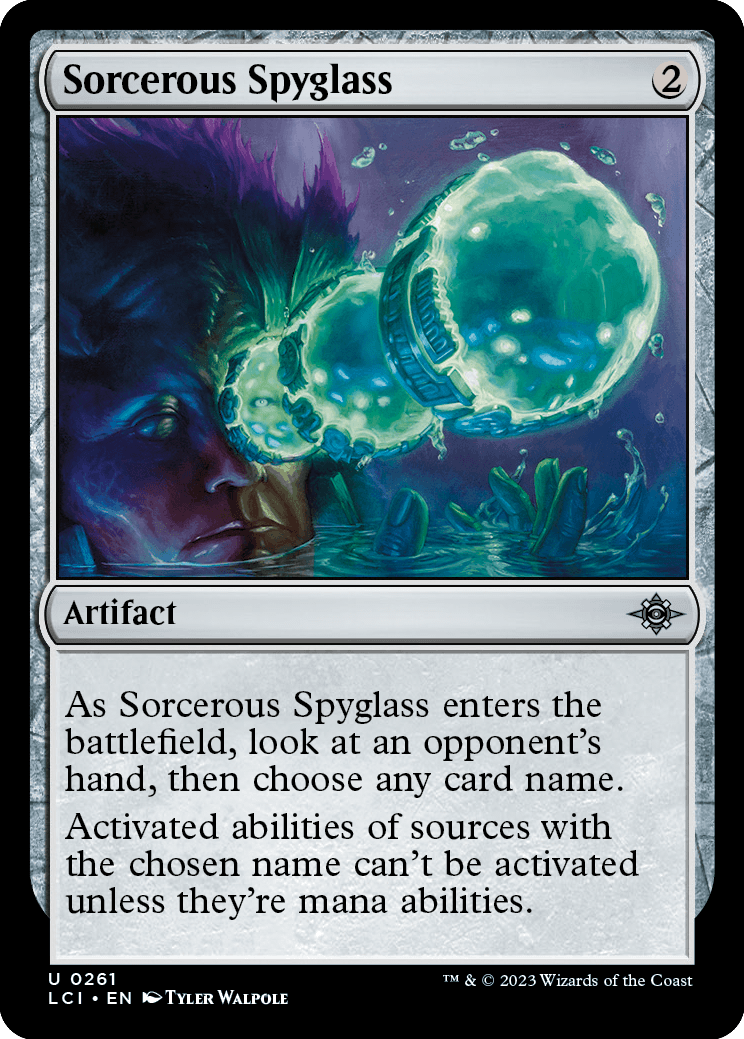
Sorcerous Spyglass
Artifact
As Sorcerous Spyglass enters the battlefield, look at an opponent's hand, then choose any card name.
Activated abilities of sources with the chosen name can't be activated unless they're mana abilities.
- You can choose any card name, even if that card doesn't normally have an activated ability. You're not limited to the names of cards you saw in the opponent's hand.
- You can't choose the name of a token unless that token has the same name as a card.
- Activated abilities contain a colon. They're generally written "[Cost]: [Effect]." Some keyword abilities (such as equip) are activated abilities and will have colons in their reminder text. Triggered abilities (starting with "when," "whenever," or "at") are unaffected by the last ability of Sorcerous Spyglass.
- An activated mana ability is one that produces mana as it resolves, not one that costs mana to activate.
- Sorcerous Spyglass affects cards regardless of what zone they're in. This includes cards in hand, cards in the graveyard, and exiled cards.
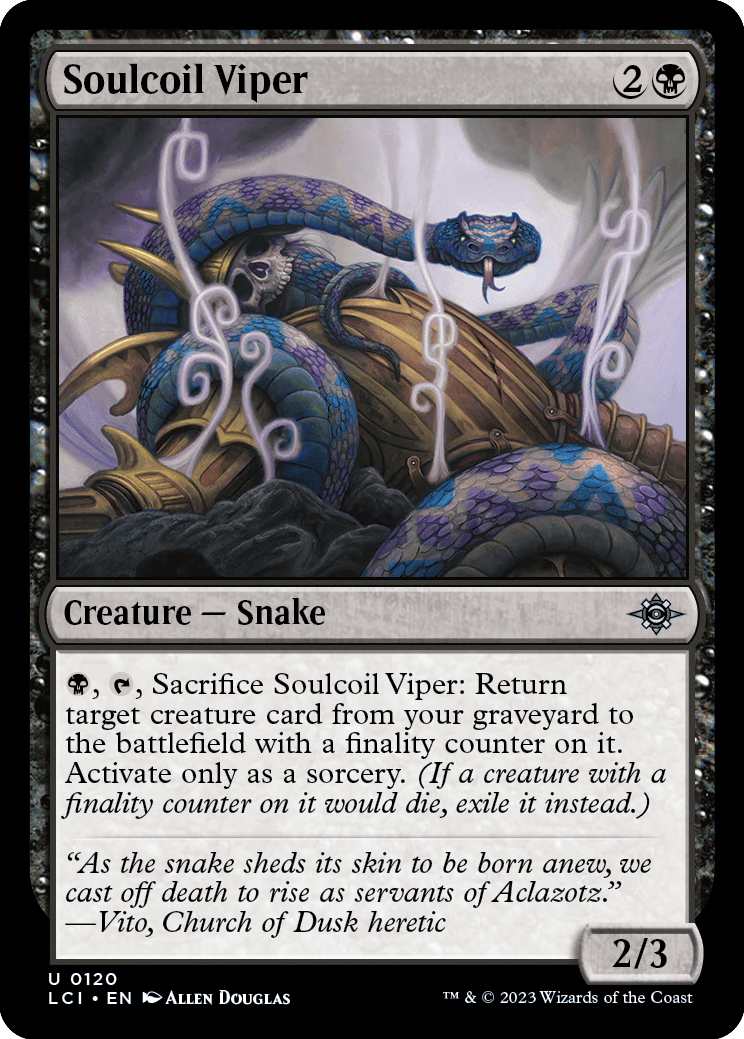
Soulcoil Viper
Creature — Snake
2/3
, , Sacrifice Soulcoil Viper: Return target creature card from your graveyard to the battlefield with a finality counter on it. Activate only as a sorcery. (If a creature with a finality counter on it would die, exile it instead.)
- Because you choose the target of Soulcoil Viper's ability before you pay the cost of sacrificing it, Soulcoil Viper can't be the target of its own ability.
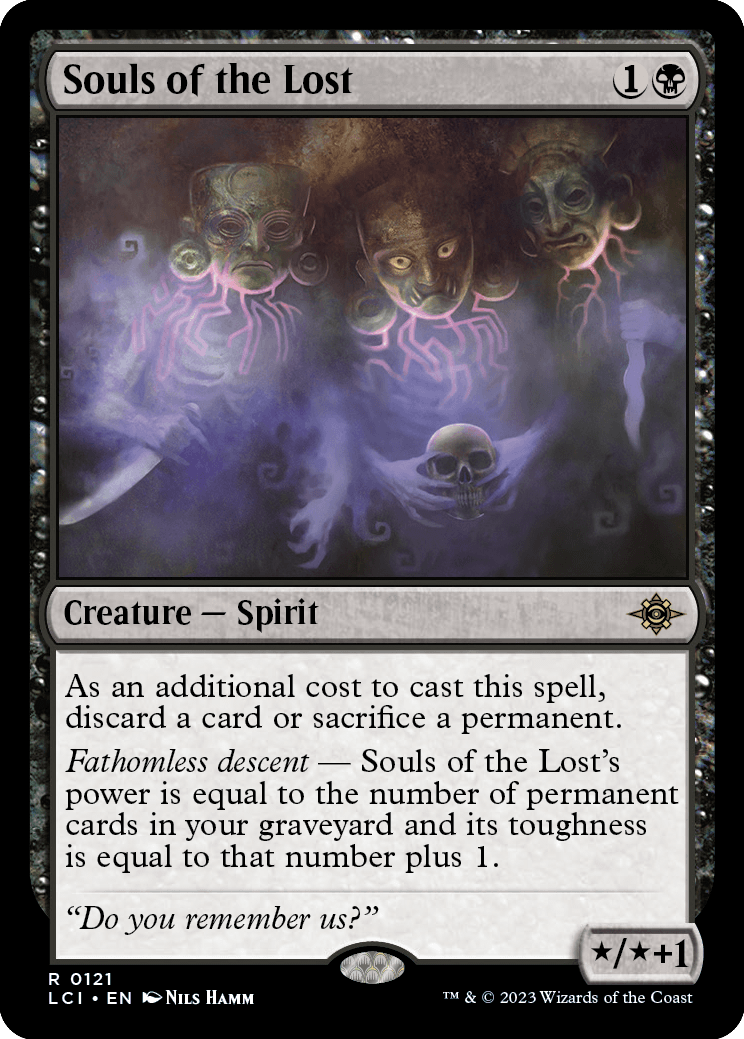
Souls of the Lost
Creature — Spirit
*/*+1
As an additional cost to cast this spell, discard a card or sacrifice a permanent.
Fathomless descent — Souls of the Lost's power is equal to the number of permanent cards in your graveyard and its toughness is equal to that number plus 1.
- The ability that defines Souls of the Lost's power and toughness works in all zones. As long as Souls of the Lost is in your graveyard, that ability will count Souls of the Lost itself.
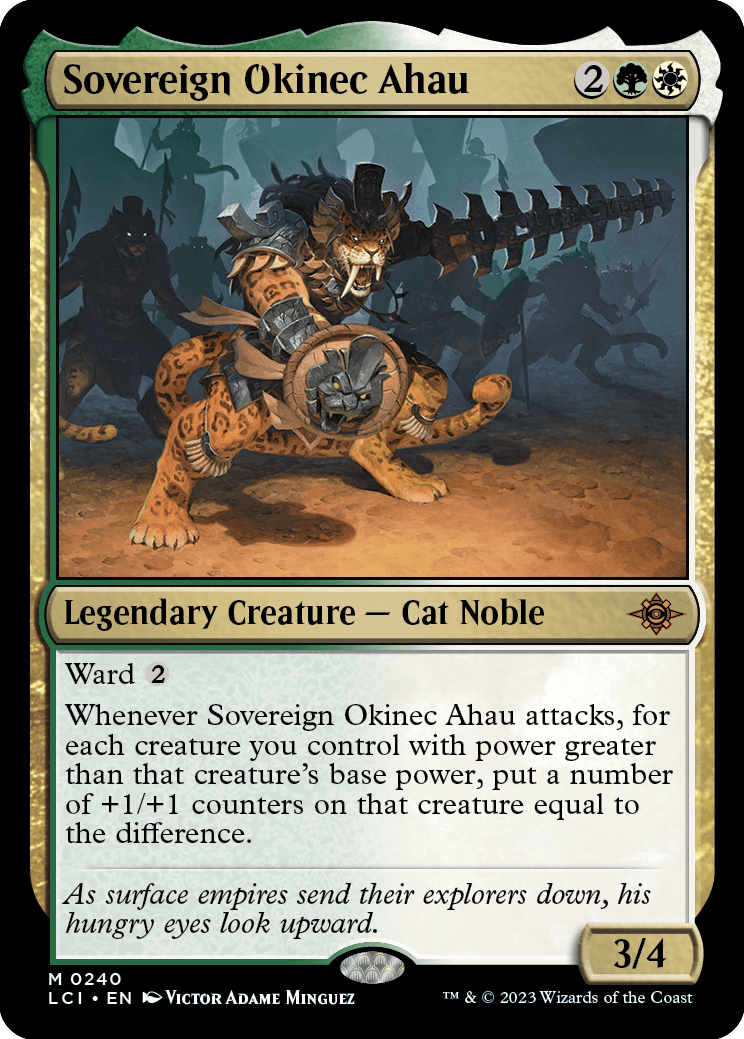
Sovereign Okinec Ahau
Legendary Creature — Cat Noble
3/4
Ward
Whenever Sovereign Okinec Ahau attacks, for each creature you control with power greater than that creature's base power, put a number of +1/+1 counters on that creature equal to the difference.
- Normally, a creature's base power and toughness are the power and toughness printed on the card or, for a token, the power and toughness set by the effect that created it. If another effect sets a creature's power and toughness to specific numbers or values, those become its base power and toughness. If an effect modifies a creature's power and/or toughness without setting them, that is not included when determining its base power and toughness.
- If a creature has a characteristic-defining ability that sets its power and toughness, indicated with a */* or similar in the power and toughness box, that ability is taken into account when determining its base power and toughness.
- Some creatures have base power and toughness 0/0 and an ability that gives them a bonus based on some criteria. Those are not characteristic-defining abilities, and that ability doesn't change its base power and toughness.
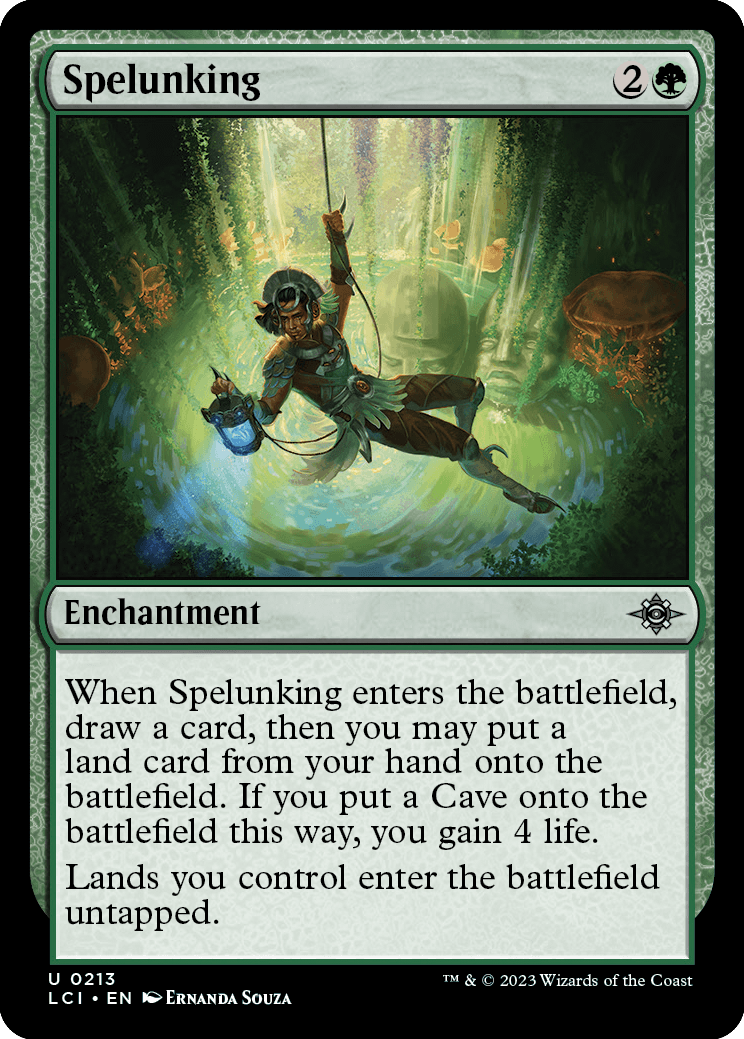
Spelunking
Enchantment
When Spelunking enters the battlefield, draw a card, then you may put a land card from your hand onto the battlefield. If you put a Cave onto the battlefield this way, you gain 4 life.
Lands you control enter the battlefield untapped.
- If a land has an ability that says it enters the battlefield tapped, you choose the order in which that ability's effect and Spelunking's effect apply. This means you can choose to have the land enter tapped or untapped. If a land you control is simply put onto the battlefield tapped without a replacement effect being applied, it always enters untapped if you control Spelunking.
- If Spelunking would enter the battlefield at the same time a land you control would enter the battlefield tapped, that land still enters the battlefield tapped.
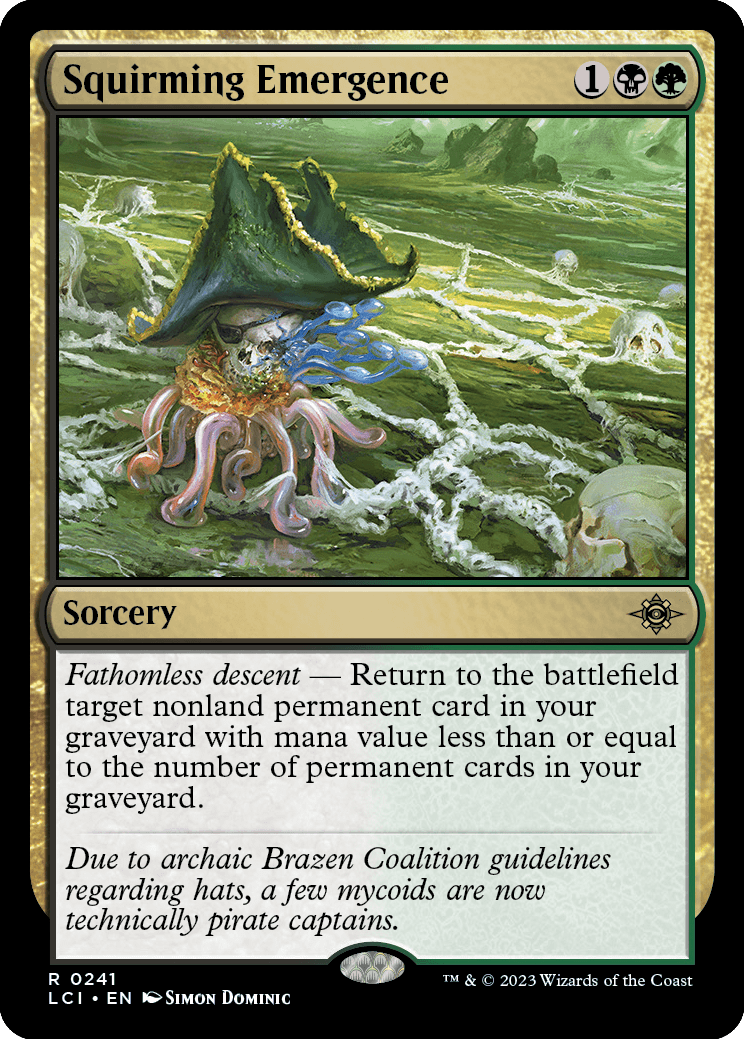
Squirming Emergence
Sorcery
Fathomless descent — Return to the battlefield target nonland permanent card in your graveyard with mana value less than or equal to the number of permanent cards in your graveyard.
- The target nonland permanent card still counts toward the number of permanent cards in your graveyard for the purposes of Squirming Emergence.
- Like all spells that require targets, Squirming Emergence will check to make sure its target is still legal as it tries to resolve. Use the number of permanent cards in your graveyard at that time, even though it may be a different number than the number that were there as you cast the spell. If the permanent card's mana value is greater than the number of permanent cards in your graveyard at that time, Squirming Emergence won't resolve.

Stalactite Stalker
Creature — Goblin Rogue
1/1
Menace
At the beginning of your end step, if you descended this turn, put a +1/+1 counter on Stalactite Stalker. (You descended if a permanent card was put into your graveyard from anywhere.)
, Sacrifice Stalactite Stalker: Target creature gets -X/-X until end of turn, where X is Stalactite Stalker's power.
- Use Stalactite Stalker's power as it last existed on the battlefield to determine the value of X.
- Stalactites are the ones that hang from the ceilings of caves. You might be thinking of stalagmites.
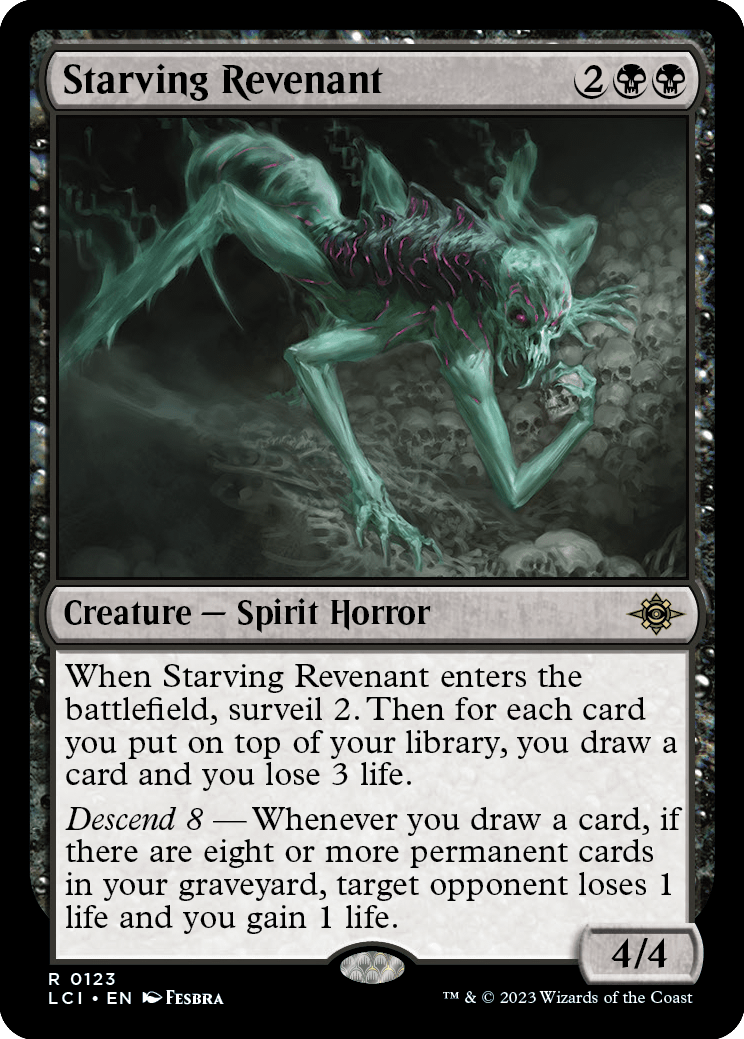
Starving Revenant
Creature — Spirit Horror
4/4
When Starving Revenant enters the battlefield, surveil 2. Then for each card you put on top of your library, you draw a card and you lose 3 life.
Descend 8 — Whenever you draw a card, if there are eight or more permanent cards in your graveyard, target opponent loses 1 life and you gain 1 life.
- Except in some unusual cases, the cards you put on top of your library while surveilling will be the cards you draw.
- For Starving Revenant's enters-the-battlefield ability, you put cards into your graveyard for surveil (if any) before drawing cards. If there are eight or more permanent cards in your graveyard by the time you draw cards, those draws will cause the descend 8 ability to trigger.
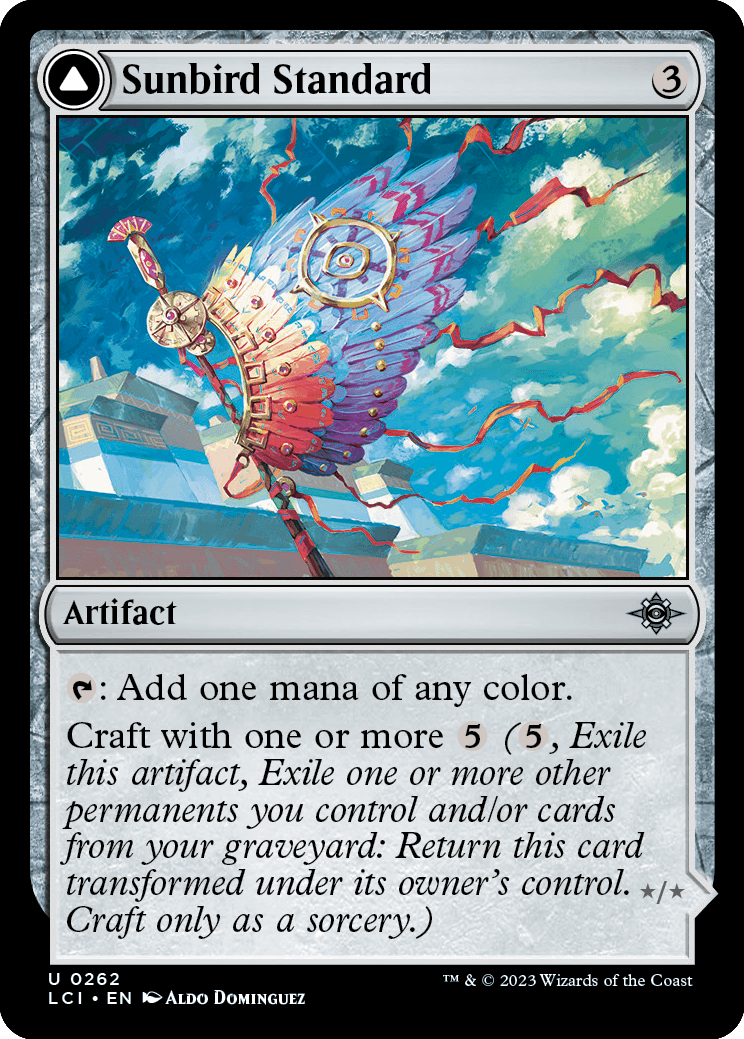

Sunbird Standard
Artifact
: Add one mana of any color.
Craft with one or more (, Exile this artifact, Exile one or more other permanents you control and/or cards from your graveyard: Return this card transformed under its owner's control. Craft only as a sorcery.)
////
Sunbird Effigy
Artifact Creature — Bird Construct
*/*
Flying, vigilance, haste
Sunbird Effigy's power and toughness are each equal to the number of colors among the exiled cards used to craft it.
: For each color among the exiled cards used to craft Sunbird Effigy, add one mana of that color.
- The five colors are white, blue, black, red, and green, and as such, Sunbird Effigy's characteristic-defining ability can't set its power and toughness higher than 5/5. Similarly, Sunbird Effigy's last ability can produce at most five mana (one of each of color).
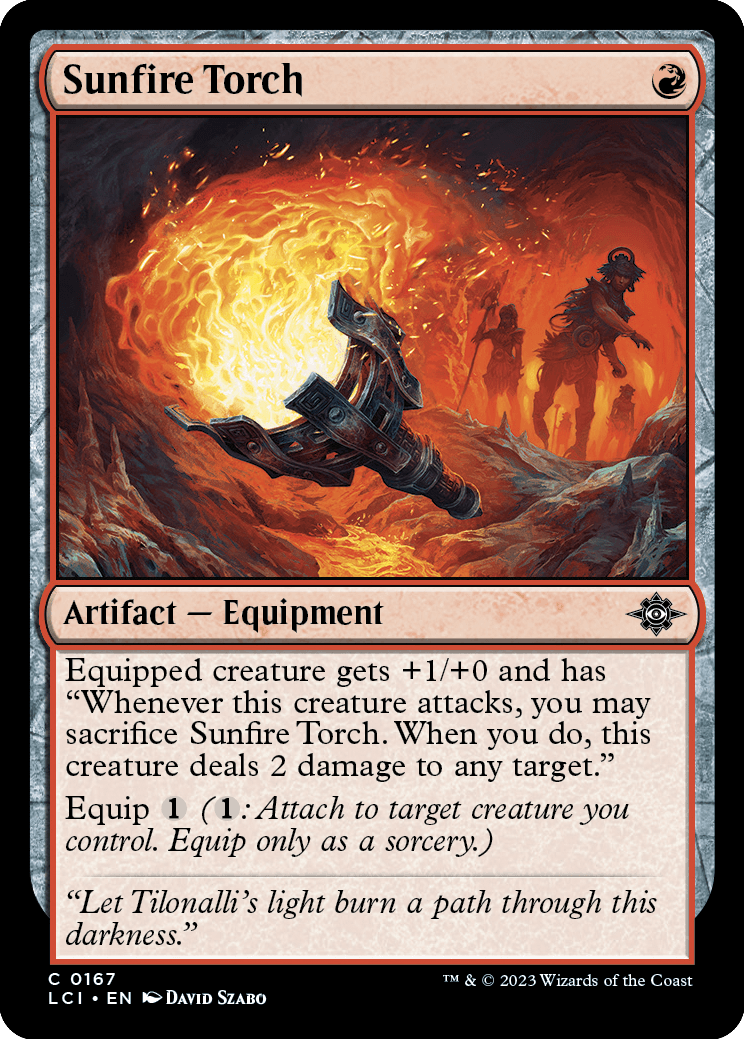
Sunfire Torch
Artifact — Equipment
Equipped creature gets +1/+0 and has "Whenever this creature attacks, you may sacrifice Sunfire Torch. When you do, this creature deals 2 damage to any target."
Equip (: Attach to target creature you control. Equip only as a sorcery.)
- You don't choose a target for the triggered ability granted by Sunfire Torch at the time it triggers. Rather, a second "reflexive" ability triggers when you sacrifice Sunfire Torch this way. You choose a target for that ability as it goes on the stack. Each player may respond to this triggered ability as normal.
- The source of the damage is the equipped creature, not Sunfire Torch.
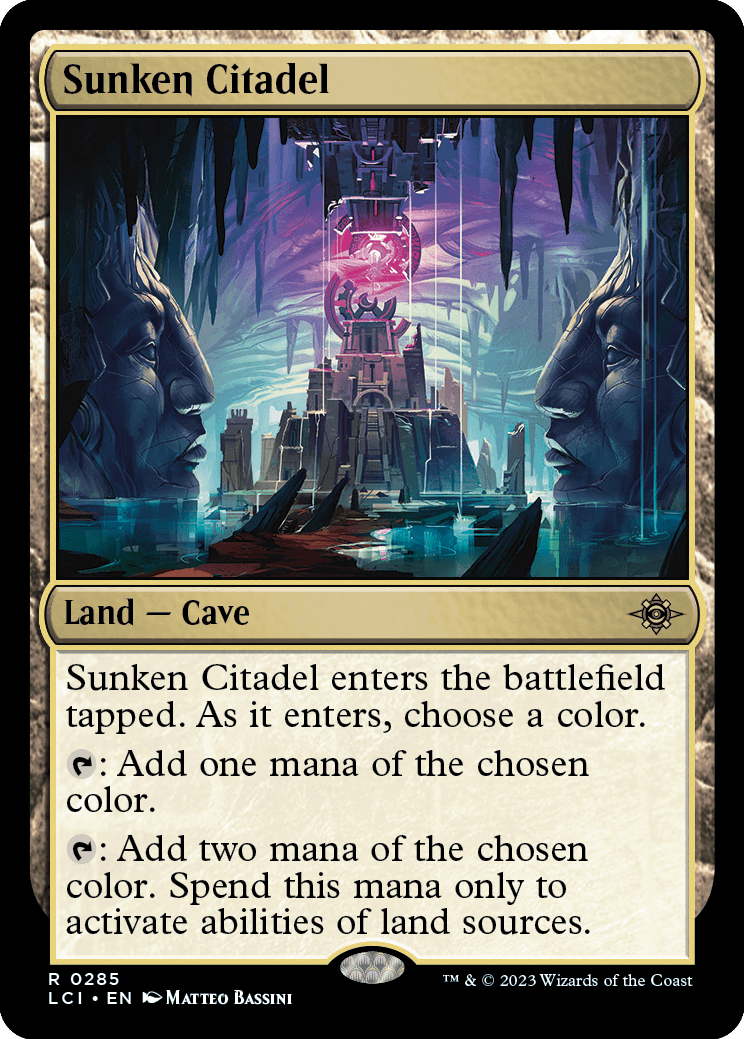
Sunken Citadel
Land — Cave
Sunken Citadel enters the battlefield tapped. As it enters, choose a color.
: Add one mana of the chosen color.
: Add two mana of the chosen color. Spend this mana only to activate abilities of land sources.
- "Land sources" include any objects with the card type land. This means you could spend the mana to activate an ability of a land you control or a land card in your hand or graveyard, for example.
- You may spend the two mana added by the last ability on the same ability or on two different abilities.
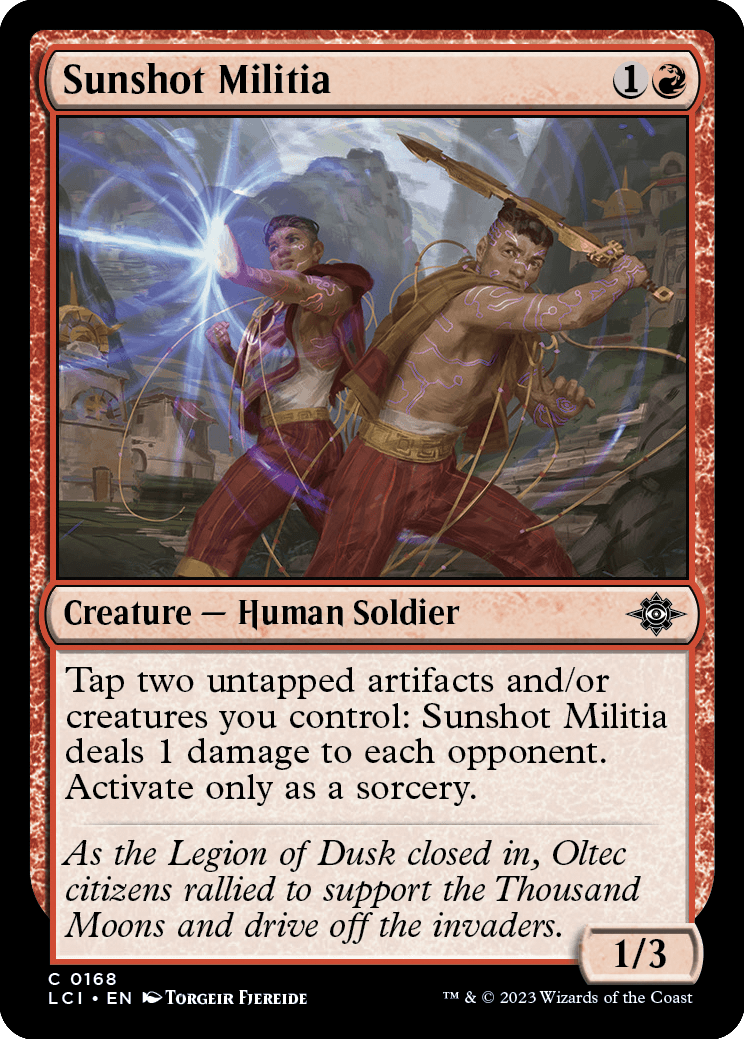
Sunshot Militia
Creature — Human Soldier
1/3
Tap two untapped artifacts and/or creatures you control: Sunshot Militia deals 1 damage to each opponent. Activate only as a sorcery.
- You can tap any two untapped artifacts and/or creatures you control, including creatures you haven't controlled continuously since the beginning of your most recent turn, to pay the cost of Sunshot Militia's activated ability.
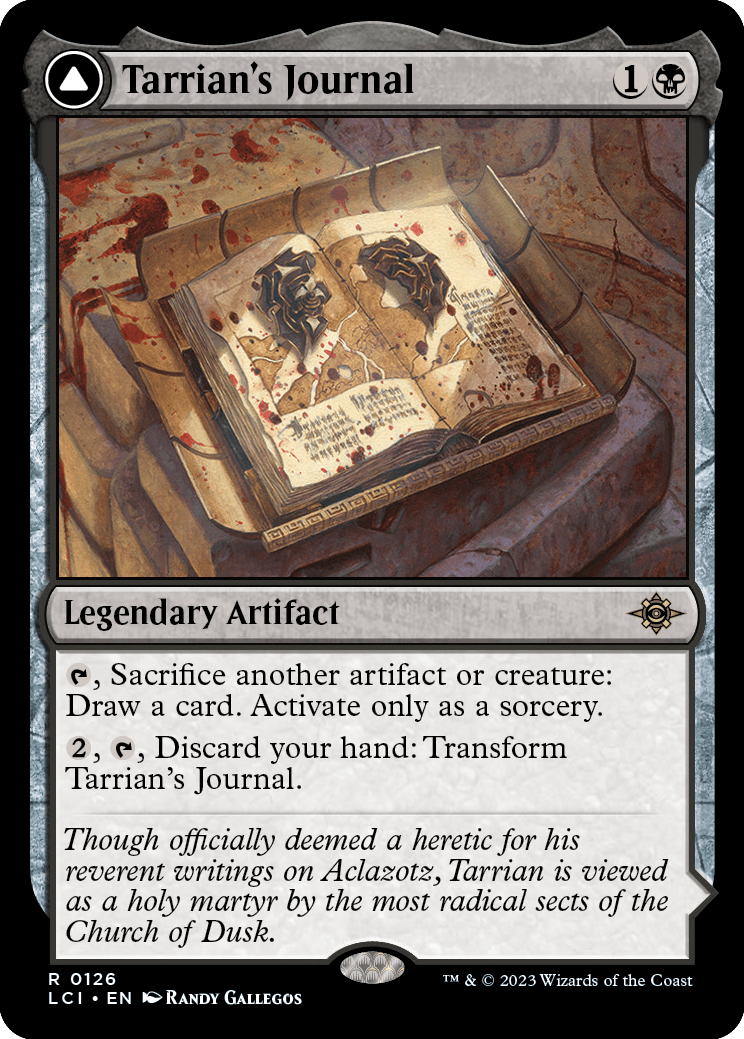
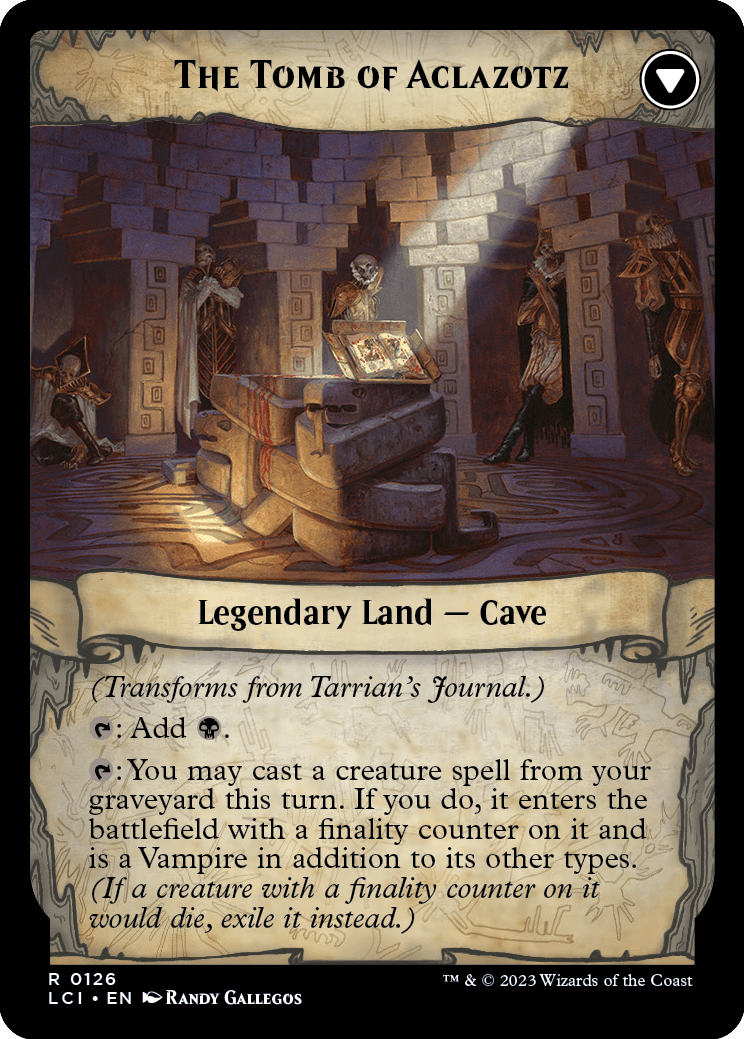
Tarrian's Journal
Legendary Artifact
, Sacrifice another artifact or creature: Draw a card. Activate only as a sorcery.
, , Discard your hand: Transform Tarrian's Journal.
////
The Tomb of Aclazotz
Legendary Land — Cave
(Transforms from Tarrian's Journal.)
: Add .
: You may cast a creature spell from your graveyard this turn. If you do, it enters the battlefield with a finality counter on it and is a Vampire in addition to its other types. (If a creature with a finality counter on it would die, exile it instead.)
- You can discard your hand even if you hand has zero cards in it.
- You don't choose which creature spell you're casting while activating or resolving The Tomb of Aclazotz's last ability. The ability creates a permission for you to cast a creature spell from your graveyard later in the turn.
- You must still follow any timing restrictions and permissions for creature spells you cast with the permission granted by The Tomb of Aclazotz's last ability. Normally, you'll be able to cast them only during your main phase while the stack is empty.
- The creature spell you cast will be a Vampire in addition to its other types while on the stack. The resulting creature will be a Vampire in addition to its other types.
- If you somehow activate The Tome of Aclazotz's ability more than once during a turn, you can cast a creature spell for each ability's permission. Similarly, if another effect allows you to cast a creature spell from your graveyard, you may use that permission and later use The Tomb of Aclazotz's ability to cast another creature spell.
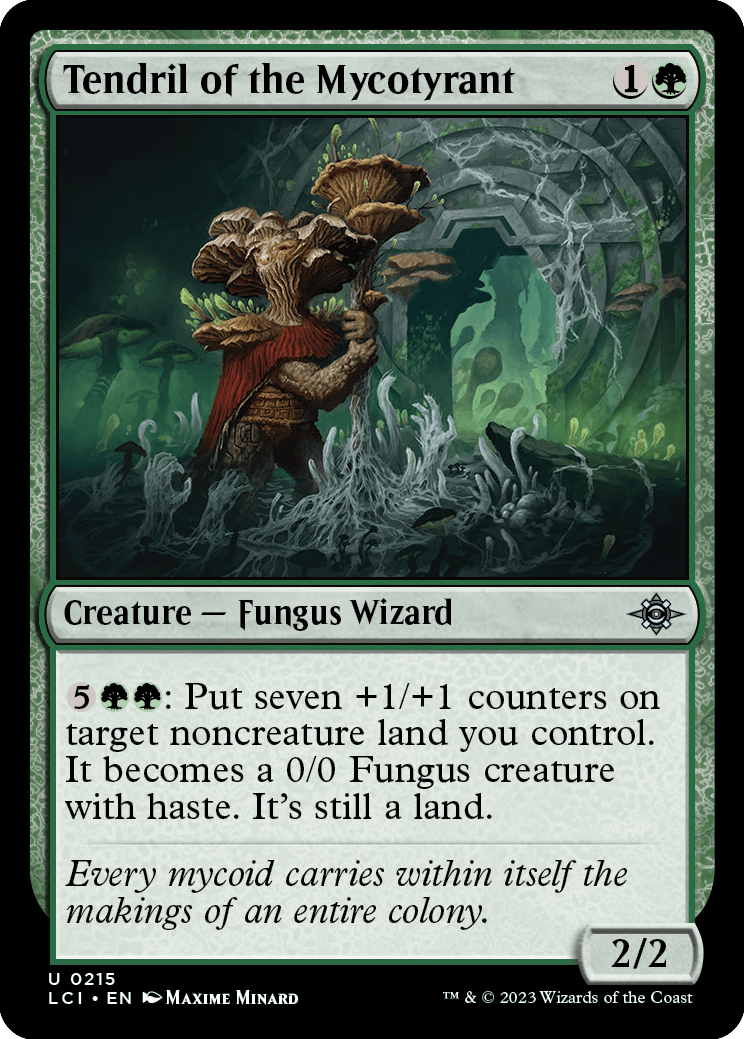
Tendril of the Mycotyrant
Creature — Fungus Wizard
2/2
: Put seven +1/+1 counters on target noncreature land you control. It becomes a 0/0 Fungus creature with haste. It's still a land.
- Tendril of the Mycotyrant's ability doesn't have a duration. The land remains a creature until it leaves the battlefield.
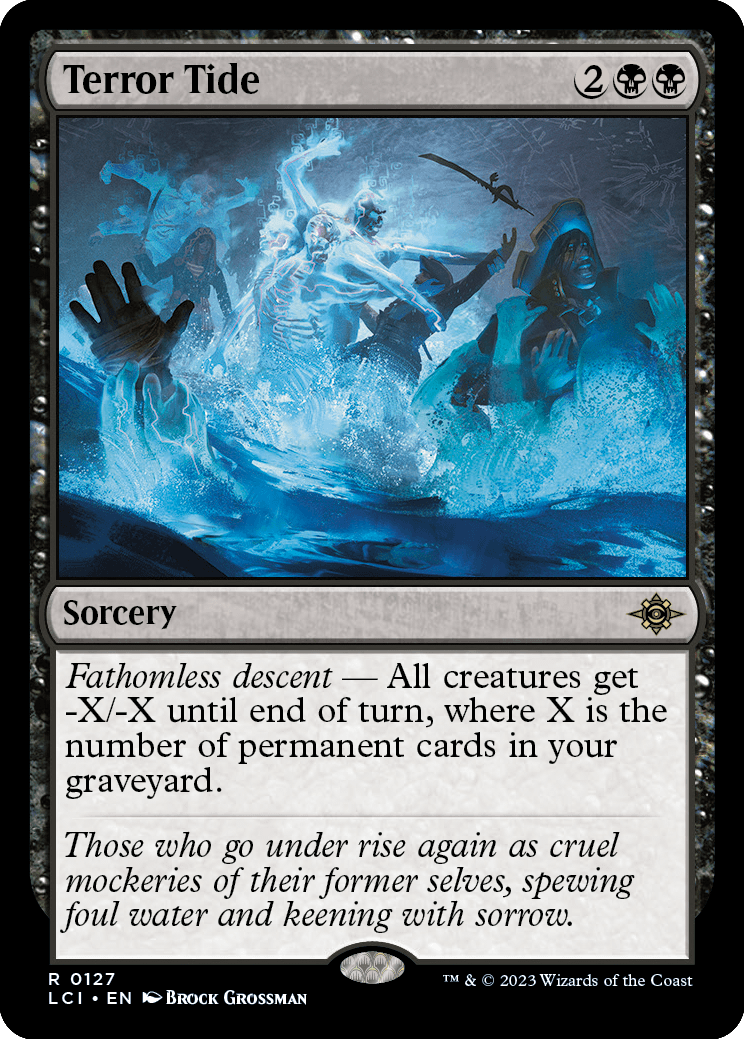
Terror Tide
Sorcery
Fathomless descent — All creatures get -X/-X until end of turn, where X is the number of permanent cards in your graveyard.
- The value of X is checked only once, as Terror Tide resolves.
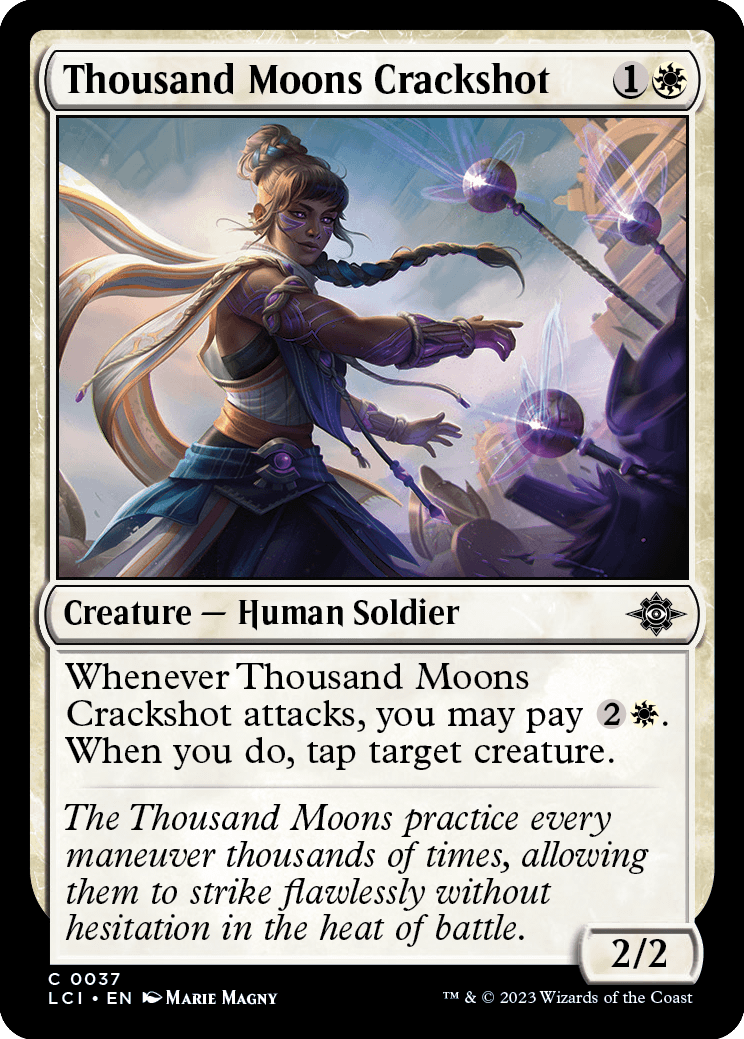
Thousand Moons Crackshot
Creature — Human Soldier
2/2
Whenever Thousand Moons Crackshot attacks, you may pay . When you do, tap target creature.
- You don't choose a target for Thousand Moons Crackshot's triggered ability at the time it triggers. Rather, a second "reflexive" ability triggers when you pay this way. You choose a target for that ability as it goes on the stack. Each player may respond to this triggered ability as normal.

Thousand Moons Infantry
Creature — Human Soldier
2/4
Untap Thousand Moons Infantry during each other player's untap step.
- Thousand Moons Infantry still untaps during your untap step as normal.
- Thousand Moons Infantry untaps at the same time as the active player's permanents. You can't choose not to untap it at that time.
- If an effect states that Thousand Moons Infantry doesn't untap during your untap step, that effect won't apply during another player's untap step.
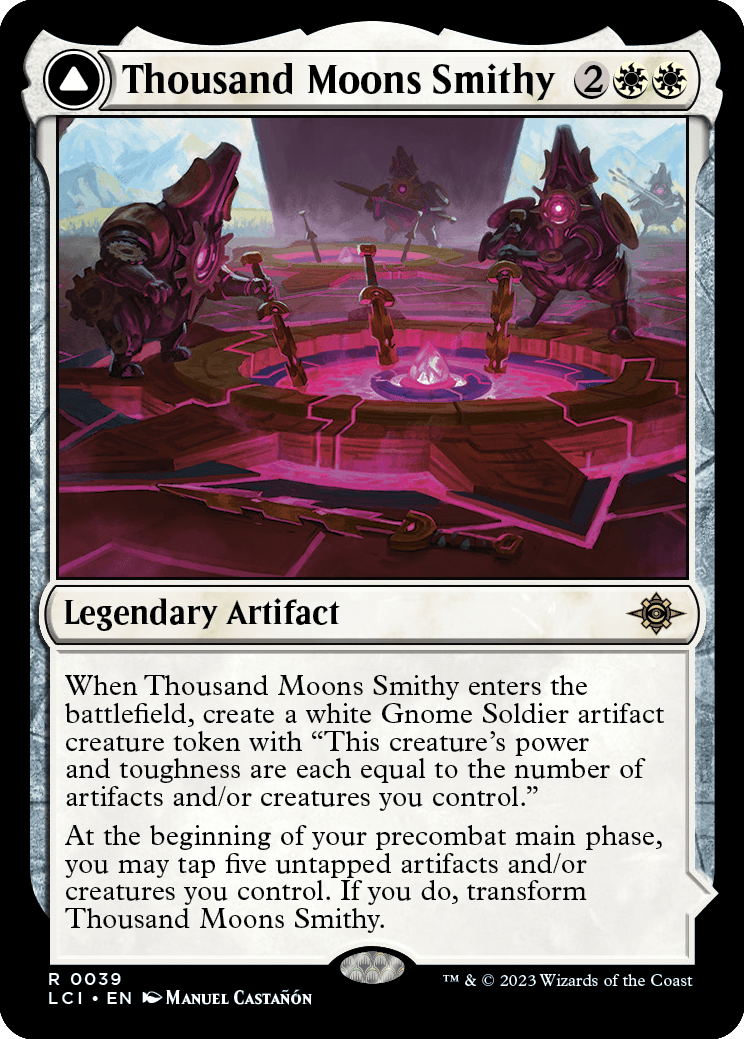
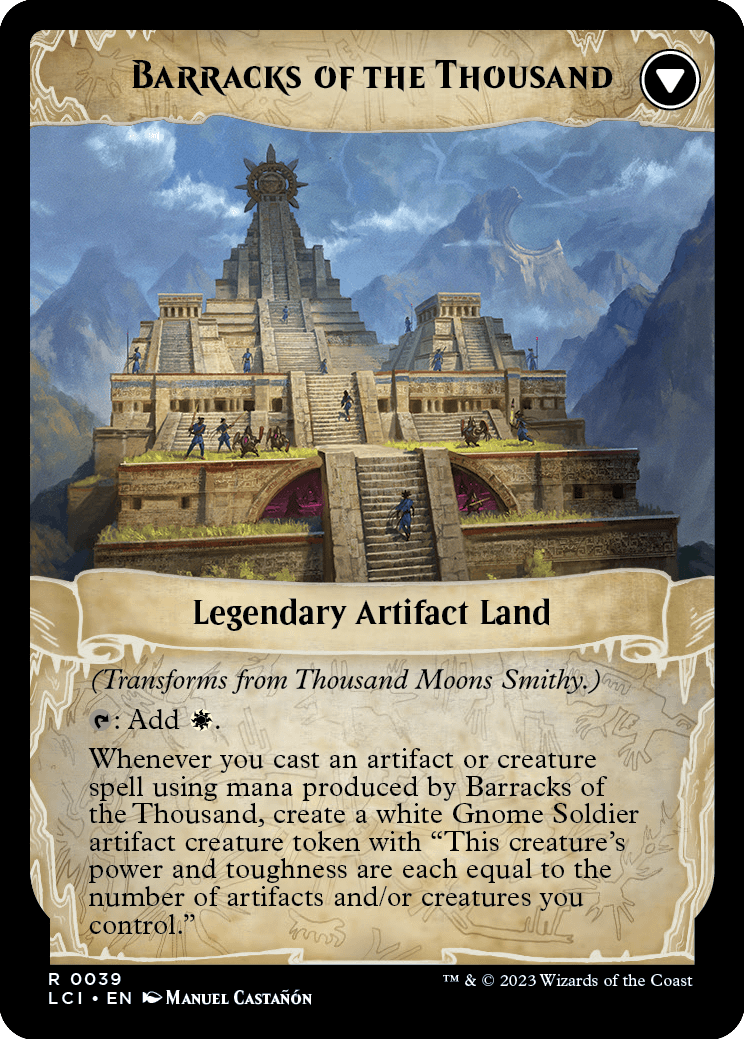
Thousand Moons Smithy
Legendary Artifact
When Thousand Moons Smithy enters the battlefield, create a white Gnome Soldier artifact creature token with "This creature's power and toughness are each equal to the number of artifacts and/or creatures you control."
At the beginning of your precombat main phase, you may tap five untapped artifacts and/or creatures you control. If you do, transform Thousand Moons Smithy.
////
Barracks of the Thousand
Legendary Artifact Land
(Transforms from Thousand Moons Smithy.)
: Add .
Whenever you cast an artifact or creature spell using mana produced by Barracks of the Thousand, create a white Gnome Soldier artifact creature token with "This creature's power and toughness are each equal to the number of artifacts and/or creatures you control."
- Barracks of the Thousand's triggered ability will resolve before the spell that caused it to trigger.
- The power and toughness of the Gnome Soldier token will change as the number of artifacts and/or creatures you control changes.
- An artifact creature you control counts only once towards the Gnome Soldier's power and toughness.
- The Gnome Soldier's ability will count the Gnome Soldier itself, so it will be at least 1/1.
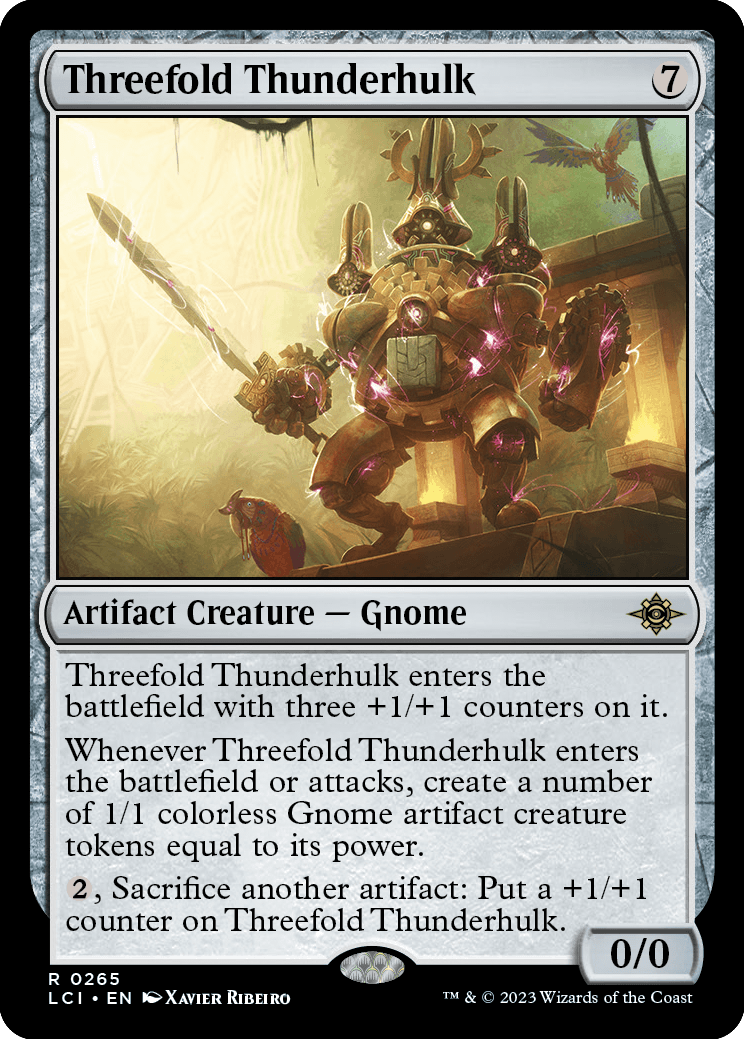
Threefold Thunderhulk
Artifact Creature — Gnome
0/0
Threefold Thunderhulk enters the battlefield with three +1/+1 counters on it.
Whenever Threefold Thunderhulk enters the battlefield or attacks, create a number of 1/1 colorless Gnome artifact creature tokens equal to its power.
, Sacrifice another artifact: Put a +1/+1 counter on Threefold Thunderhulk.
- If Threefold Thunderhulk leaves the battlefield while its triggered ability is on the stack, use its power as it last existed on the battlefield to determine how many Gnomes to create.
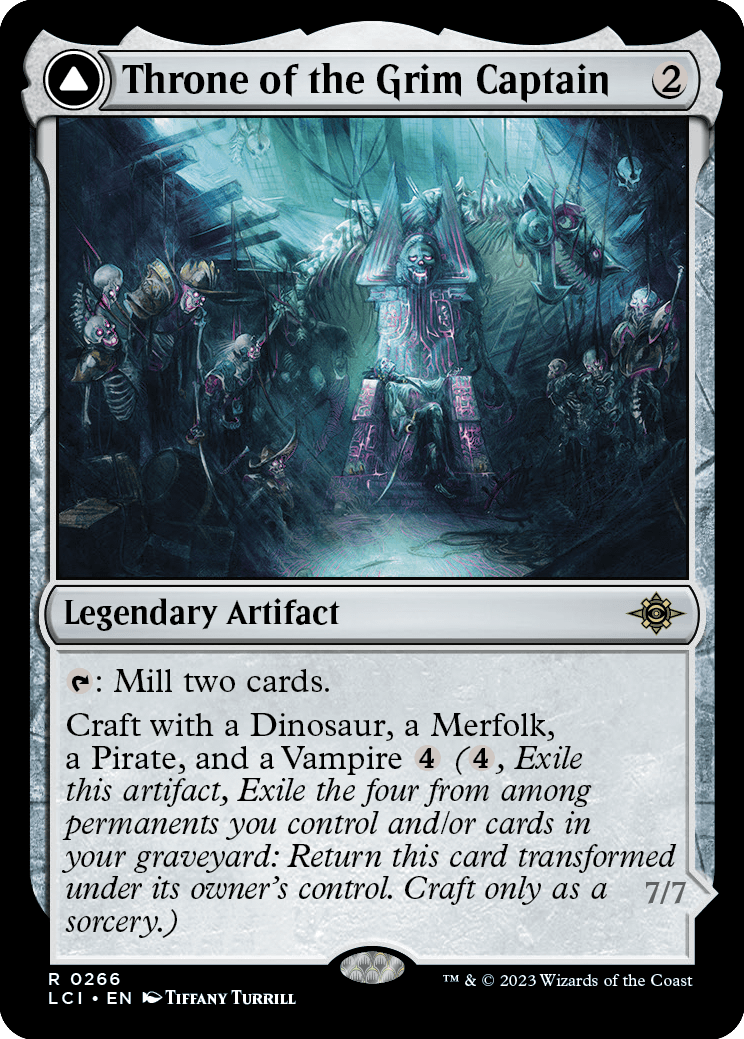
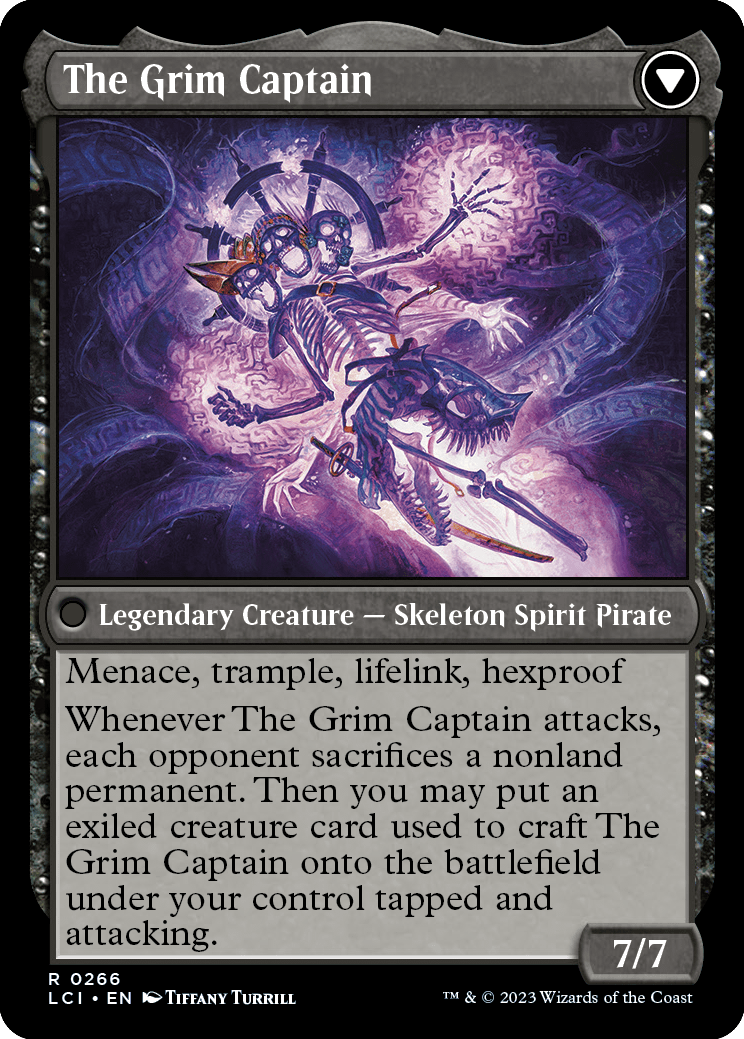
Throne of the Grim Captain
Legendary Artifact
: Mill two cards.
Craft with a Dinosaur, a Merfolk, a Pirate, and a Vampire (, Exile this artifact, Exile the four from among permanents you control and/or cards in your graveyard: Return this card transformed under its owner's control. Craft only as a sorcery.)
////
The Grim Captain
Legendary Creature — Skeleton Spirit Pirate
7/7
Menace, trample, lifelink, hexproof
Whenever The Grim Captain attacks, each opponent sacrifices a nonland permanent. Then you may put an exiled creature card used to craft The Grim Captain onto the battlefield under your control tapped and attacking.
- The Dinosaur, Merfolk, Pirate, and Vampire exiled to pay Throne of the Grim Captain's craft cost need to be separate objects. One creature with changeling is not enough.
- Although the creature card you put onto the battlefield is an attacking creature, it was never declared as an attacking creature. This means that abilities that trigger whenever a creature attacks won't trigger when it enters the battlefield attacking.
- You choose which player, planeswalker, or battle the creature you put onto the battlefield is attacking as it enters the battlefield. It doesn't have to be the same player, planeswalker, or battle that The Grim Captain is attacking.
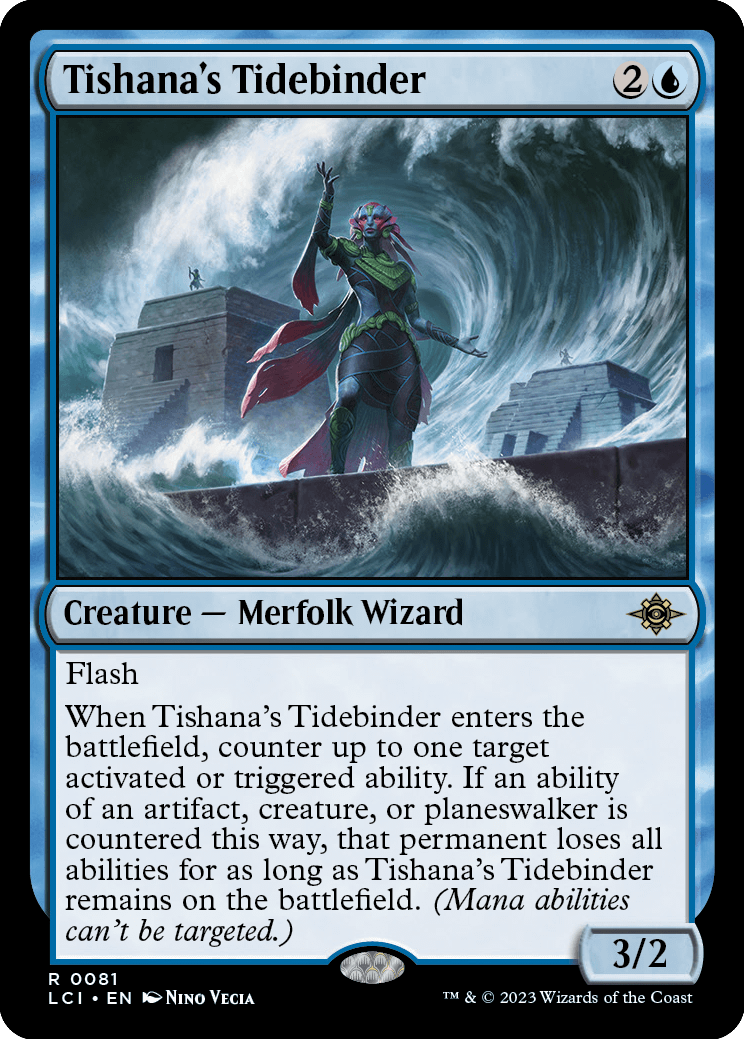
Tishana's Tidebinder
Creature — Merfolk Wizard
3/2
Flash
When Tishana's Tidebinder enters the battlefield, counter up to one target activated or triggered ability. If an ability of an artifact, creature, or planeswalker is countered this way, that permanent loses all abilities for as long as Tishana's Tidebinder remains on the battlefield. (Mana abilities can't be targeted.)
- If Tishana's Tidebinder leaves the battlefield before its triggered ability resolves, the target activated or triggered ability will still be countered, but the source of the ability won't lose its abilities at all.
- If the affected permanent gains an ability after Tishana's Tidebinder's effect begins to apply to it, it will keep that ability.
- Tishana's Tidebinder's triggered ability checks to see if the source of the ability is an artifact, creature, or planeswalker as it resolves. If it isn't, it won't lose all abilities, even if it was an artifact, creature, or planeswalker when the ability was activated or when it triggered.
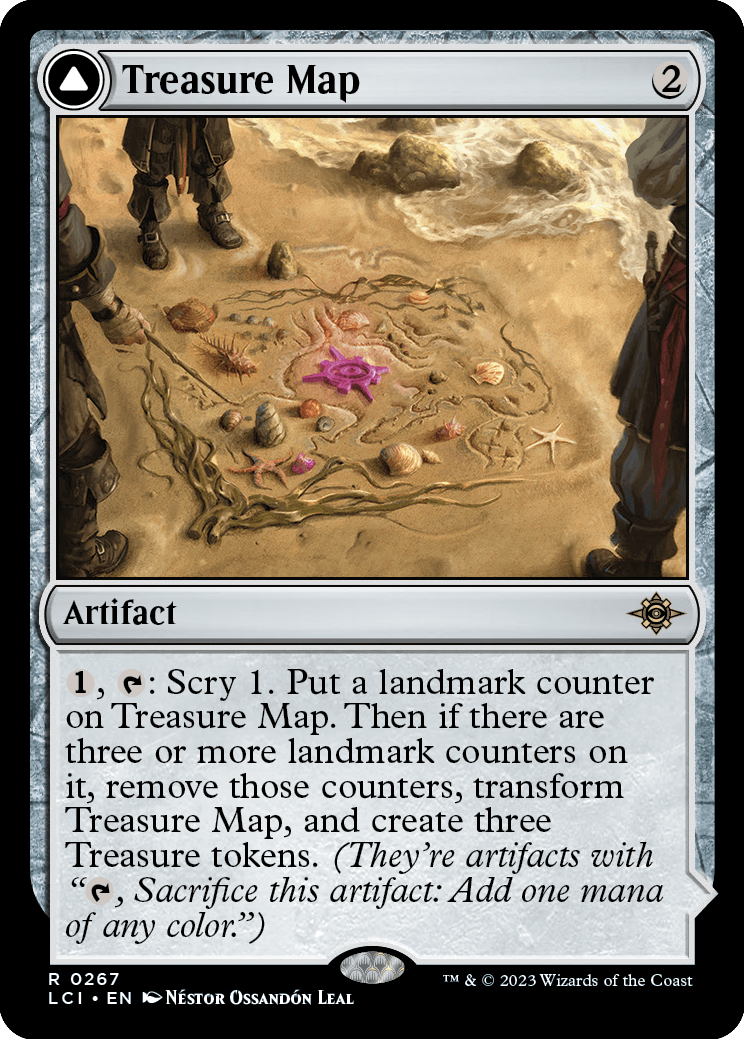
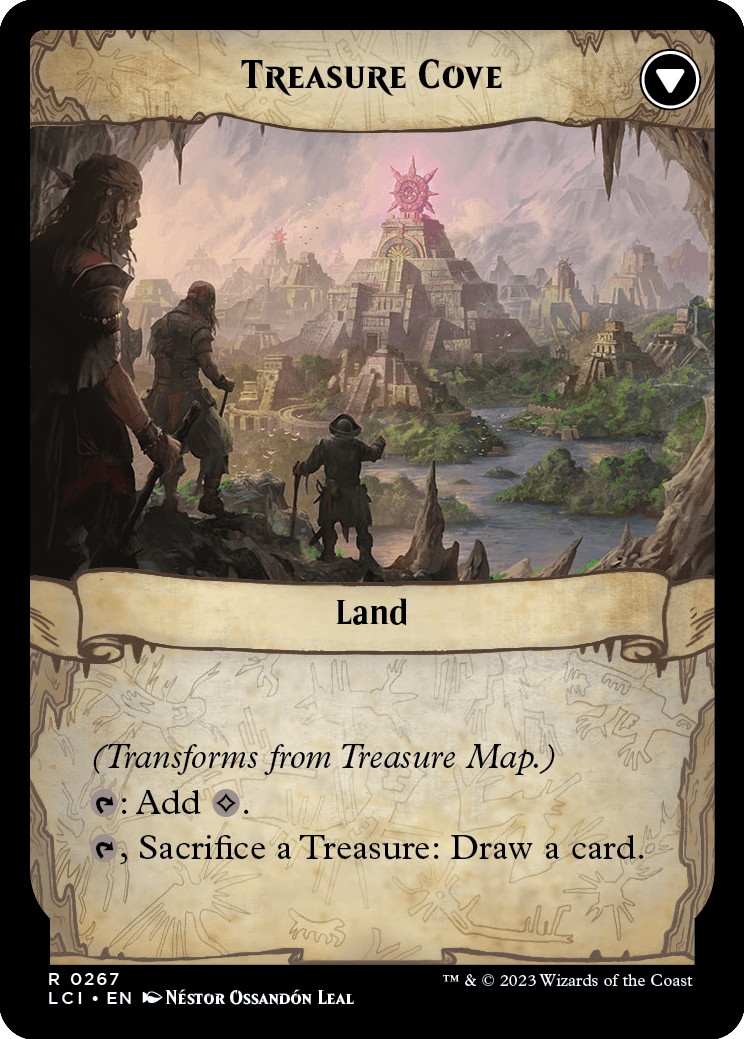
Treasure Map
Artifact
, : Scry 1. Put a landmark counter on Treasure Map. Then if there are three or more landmark counters on it, remove those counters, transform Treasure Map, and create three Treasure tokens. (They're artifacts with ", Sacrifice this artifact: Add one mana of any color.")
////
Treasure Cove
Land
(Transforms from Treasure Map.)
: Add .
, Sacrifice a Treasure: Draw a card.
- If a third landmark counter is put on Treasure Map by something other than the resolution of its ability (as modified by any applicable replacement effects), you won't remove those counters, transform Treasure Map, or get Treasures yet. You'll have to wait until you activate its ability again.
- If Treasure Map leaves the battlefield before its ability resolves, you can't put a landmark counter on it. However, if it somehow already had three landmark counters on it before it left the battlefield, you'll create three Treasure tokens.
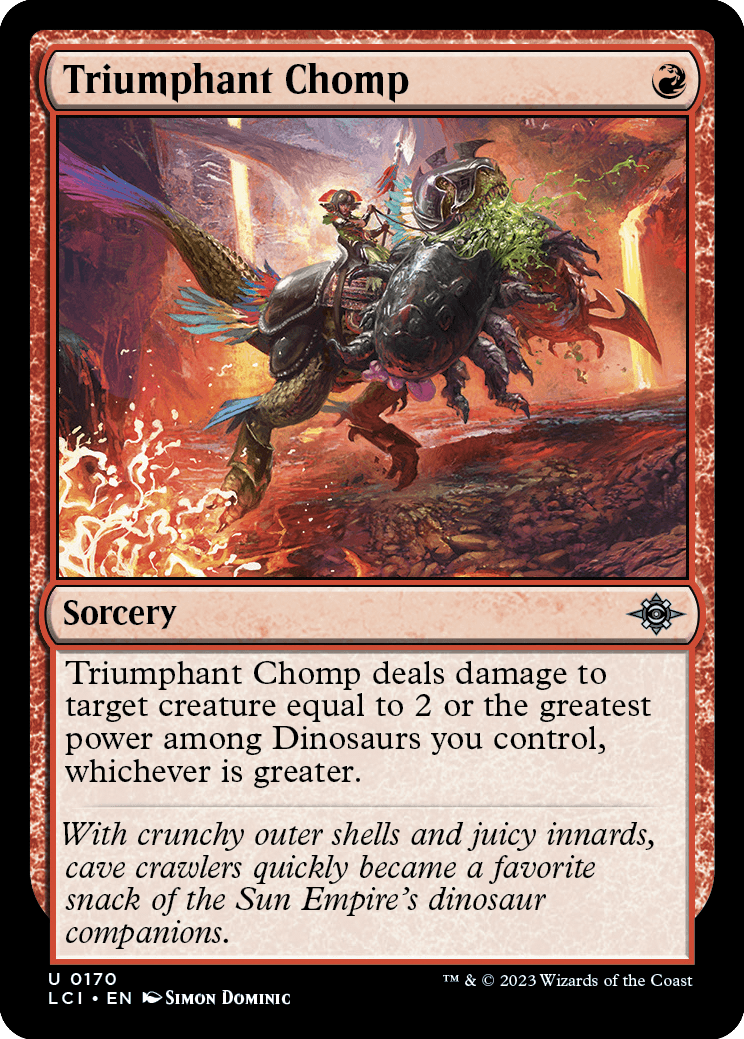
Triumphant Chomp
Sorcery
Triumphant Chomp deals damage to target creature equal to 2 or the greatest power among Dinosaurs you control, whichever is greater.
- The amount of damage Triumphant Chomp deals is determined as it resolves. If you don't control any Dinosaurs at that time, or if the Dinosaurs you control are unusually small, Triumphant Chomp will deal 2 damage.
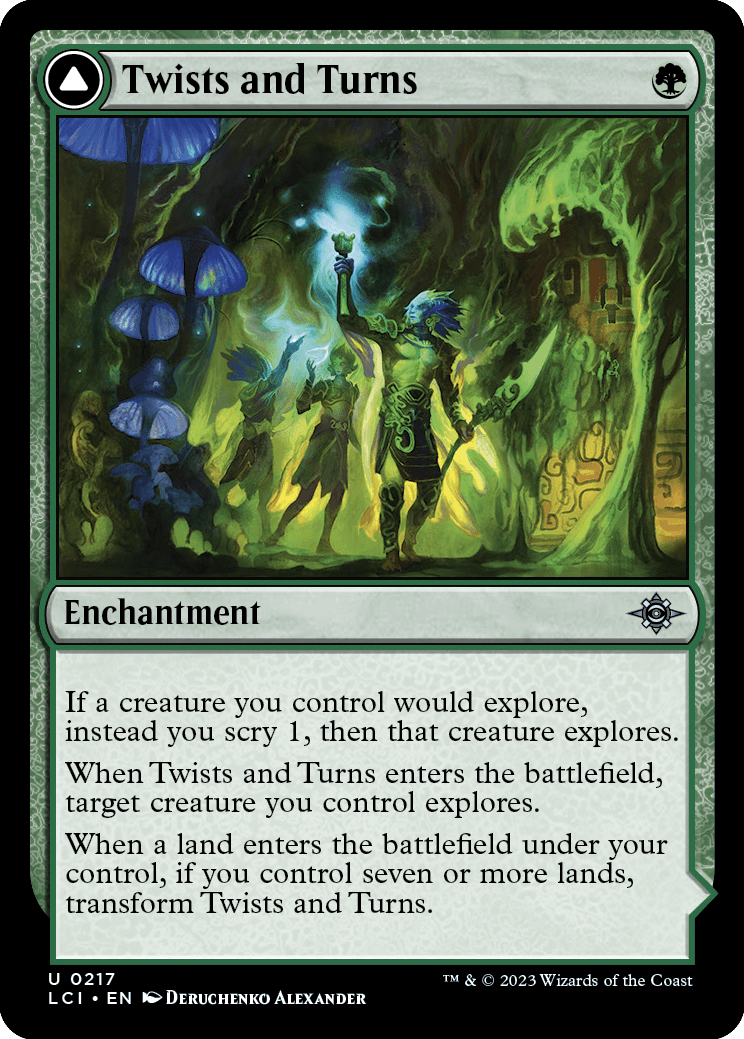
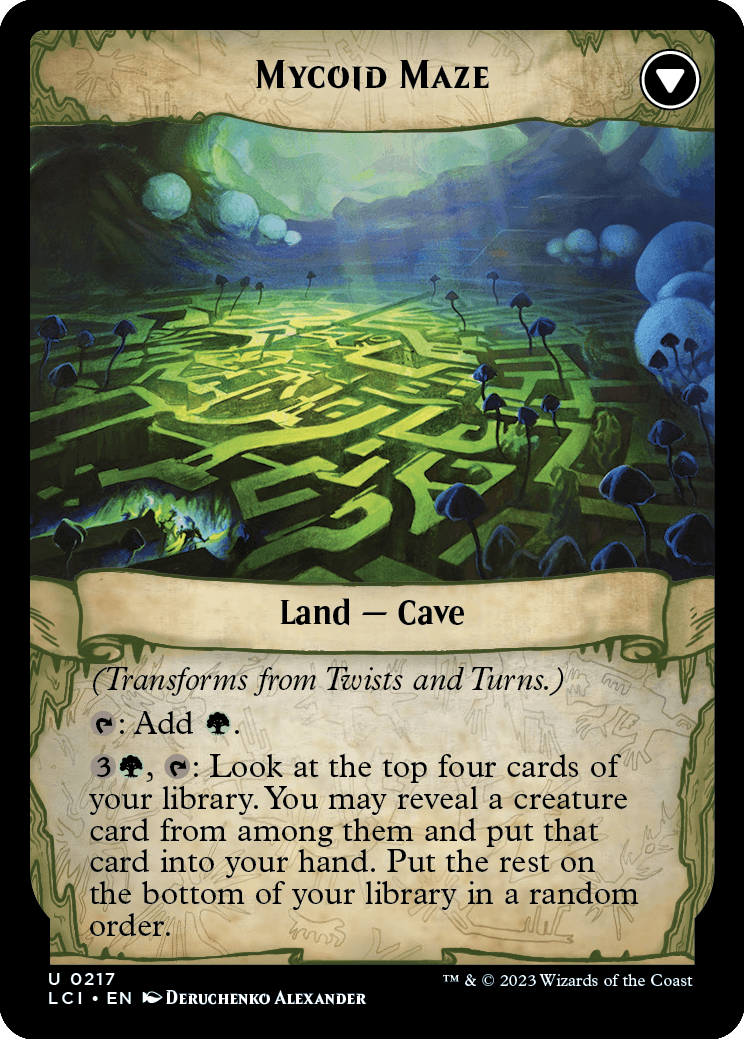
Twists and Turns
Enchantment
If a creature you control would explore, instead you scry 1, then that creature explores.
When Twists and Turns enters the battlefield, target creature you control explores.
When a land enters the battlefield under your control, if you control seven or more lands, transform Twists and Turns.
////
Mycoid Maze
Land — Cave
(Transforms from Twists and Turns.)
: Add .
, : Look at the top four cards of your library. You may reveal a creature card from among them and put that card into your hand. Put the rest on the bottom of your library in a random order.
- If you control two copies of Twists and Turns and a creature you control would explore, instead you scry 1, then scry 1 again, then that creature explores. If you control three copies of Twists and Turns, you'd scry 1 an additional time before that creature explores, and so on.
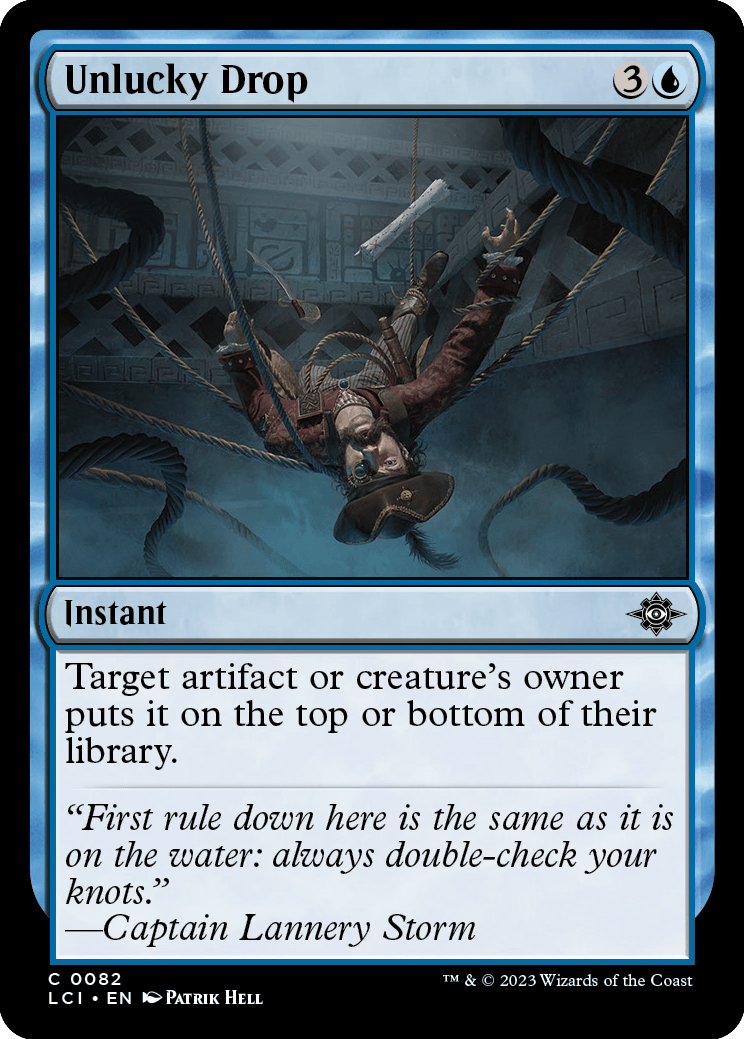
Unlucky Drop
Instant
Target artifact or creature's owner puts it on the top or bottom of their library.
- The permanent's owner chooses whether to put it on the top or bottom of their library. If multiple cards are put into the library this way (such as when the spell targets a melded permanent), that permanent's owner puts all the cards on top or all the cards on the bottom. They put them in whatever order they wish, and do not need to reveal the order.
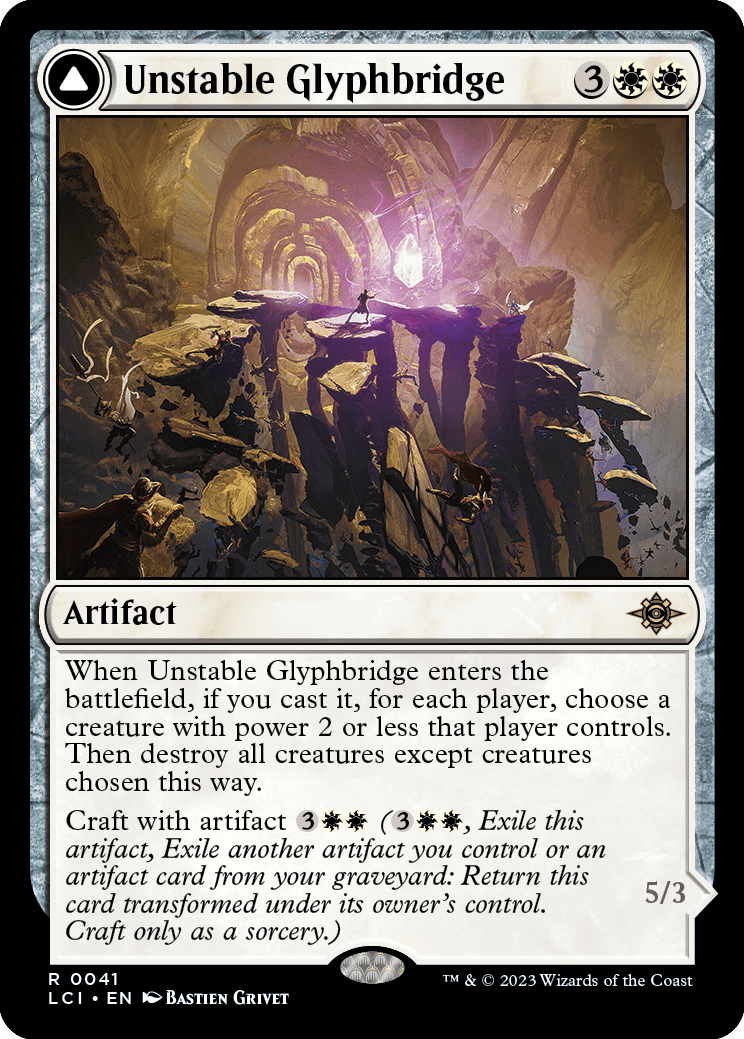
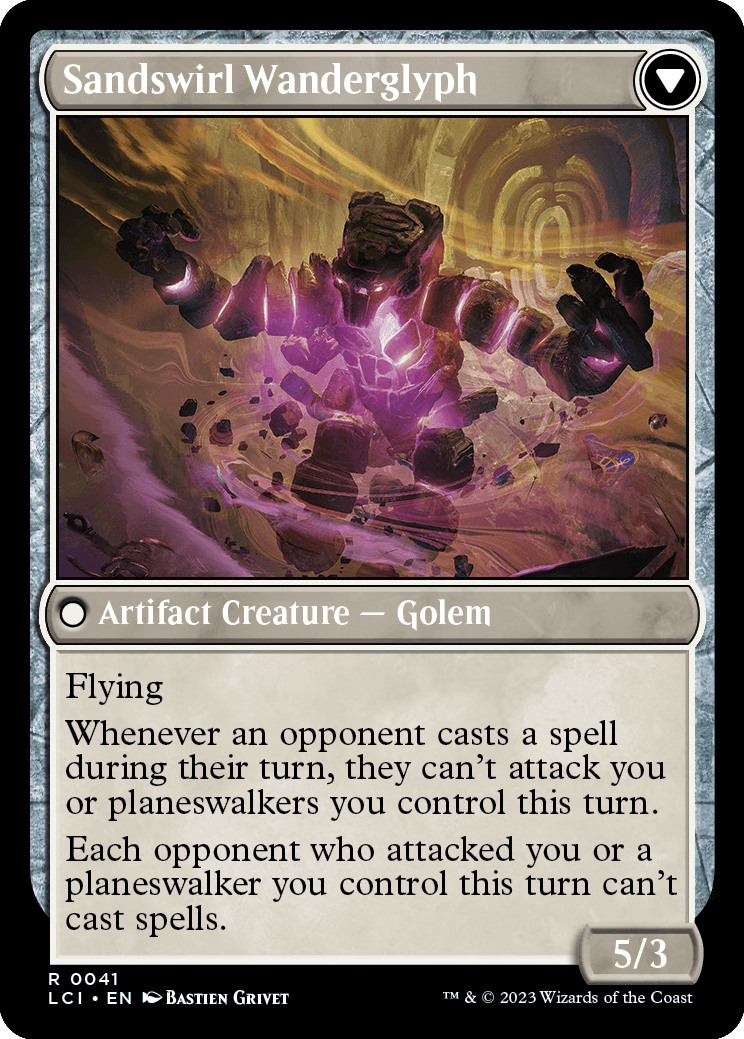
Unstable Glyphbridge
Artifact
When Unstable Glyphbridge enters the battlefield, if you cast it, for each player, choose a creature with power 2 or less that player controls. Then destroy all creatures except creatures chosen this way.
Craft with artifact (, Exile this artifact, Exile another artifact you control or an artifact card from your graveyard: Return this card transformed under its owner's control. Craft only as a sorcery.)
////
Sandswirl Wanderglyph
Artifact Creature — Golem
5/3
Flying
Whenever an opponent casts a spell during their turn, they can't attack you or planeswalkers you control this turn.
Each opponent who attacked you or a planeswalker you control this turn can't cast spells.
- Unstable Glyphbridge's first ability triggers if you cast it from any zone. It doesn't trigger if you put Unstable Glyphbridge onto the battlefield without casting it.
- For each player, including yourself, you must choose a creature with power 2 or less to save if you can.
- Once Sandswirl Wanderglyph's middle ability resolves, that opponent won't be able to attack you or planeswalkers you control that turn, even if Sandswirl Wanderglyph is no longer on the battlefield.
- If Sandswirl Wanderglyph leaves the battlefield on a turn in which an opponent attacked you or a planeswalker you control (perhaps because it died in combat or another player cast a spell that destroyed it), that opponent can cast spells.
- Sandswirl Wanderglyph's abilities won't stop opponents from attacking battles you protect or casting spells after attacking battles you protect.
- In Two-Headed Giant, for each attacking creature, the attacking team announces which defending player, planeswalker, or battle that creature is attacking when it's declared as an attacker. Sandswirl Wanderglyph's abilities care only about creatures that attack you or planeswalkers you control, not creatures that attack your teammate or planeswalkers they control.
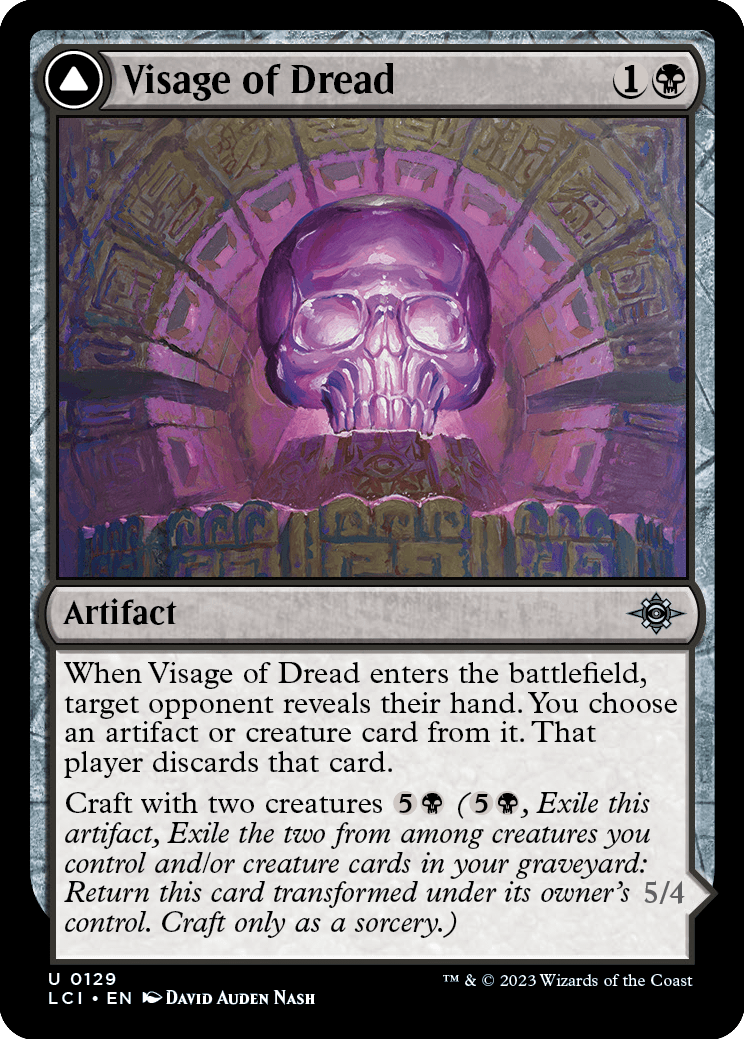
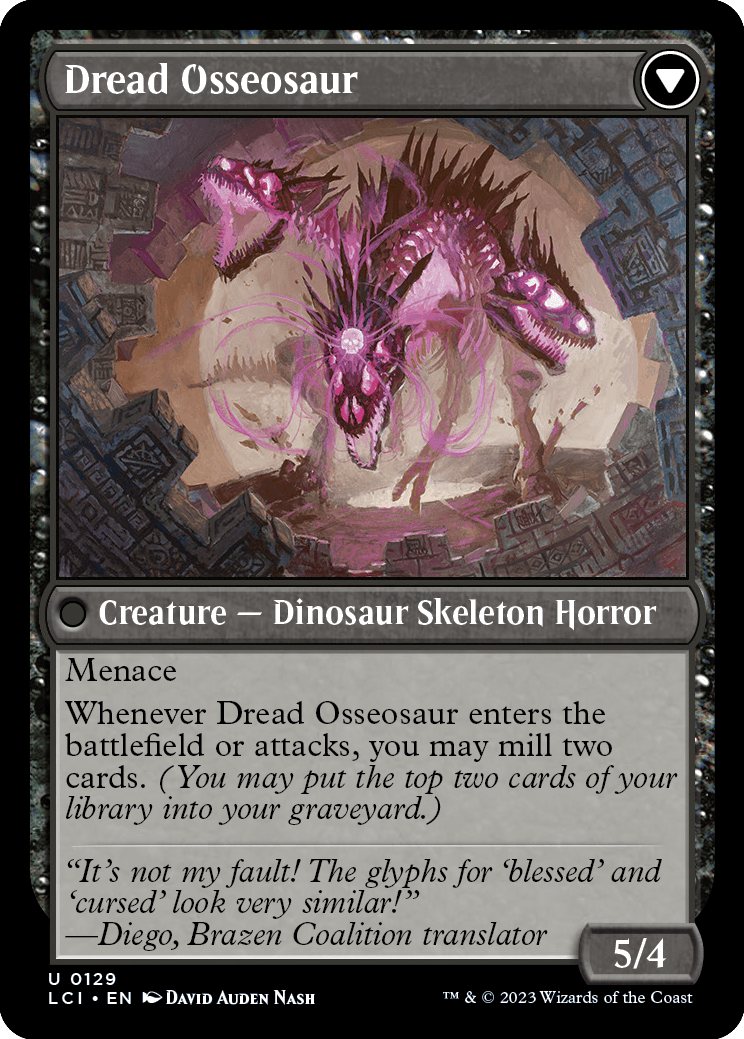
Visage of Dread
Artifact
When Visage of Dread enters the battlefield, target opponent reveals their hand. You choose an artifact or creature card from it. That player discards that card.
Craft with two creatures (, Exile this artifact, Exile the two from among creatures you control and/or creature cards in your graveyard: Return this card transformed under its owner's control. Craft only as a sorcery.)
////
Dread Osseosaur
Creature — Dinosaur Skeleton Horror
5/4
Menace
Whenever Dread Osseosaur enters the battlefield or attacks, you may mill two cards. (You may put the top two cards of your library into your graveyard.)
- If you don't have at least two cards in your library, you can't choose to mill two cards.
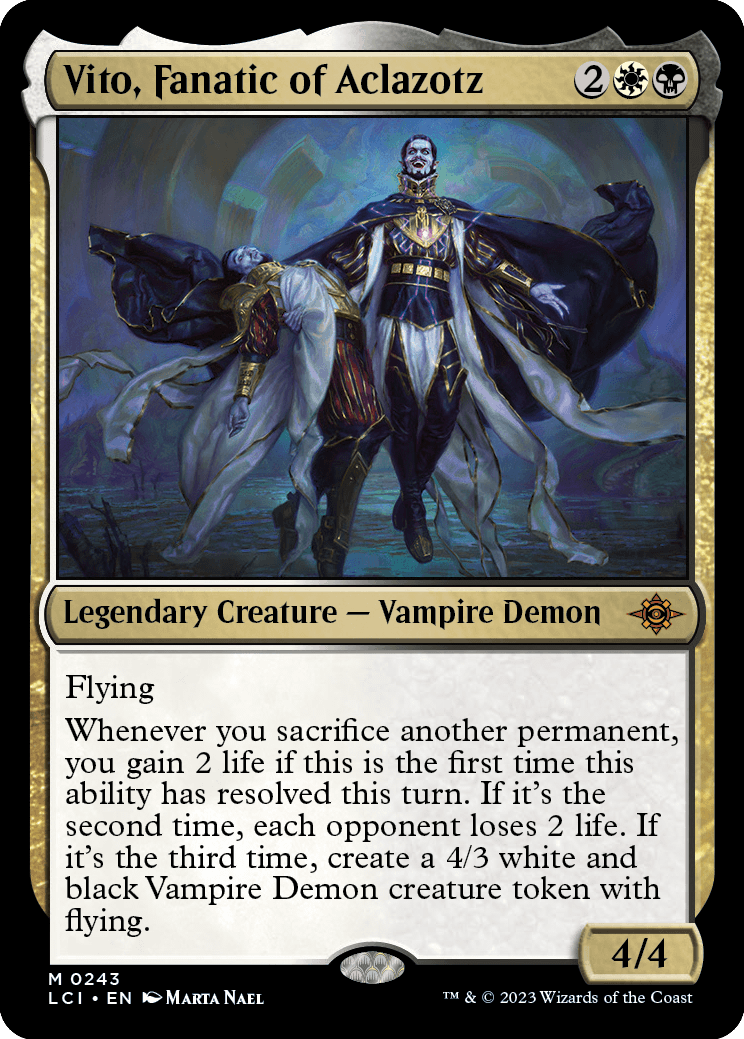
Vito, Fanatic of Aclazotz
Legendary Creature — Vampire Demon
4/4
Flying
Whenever you sacrifice another permanent, you gain 2 life if this is the first time this ability has resolved this turn. If it's the second time, each opponent loses 2 life. If it's the third time, create a 4/3 white and black Vampire Demon creature token with flying.
- Vito's triggered ability has no effect each time beyond the third it resolves in a turn.
- If you sacrifice Vito at the same time you sacrifice other permanents, Vito's ability will trigger for each of those other permanents.
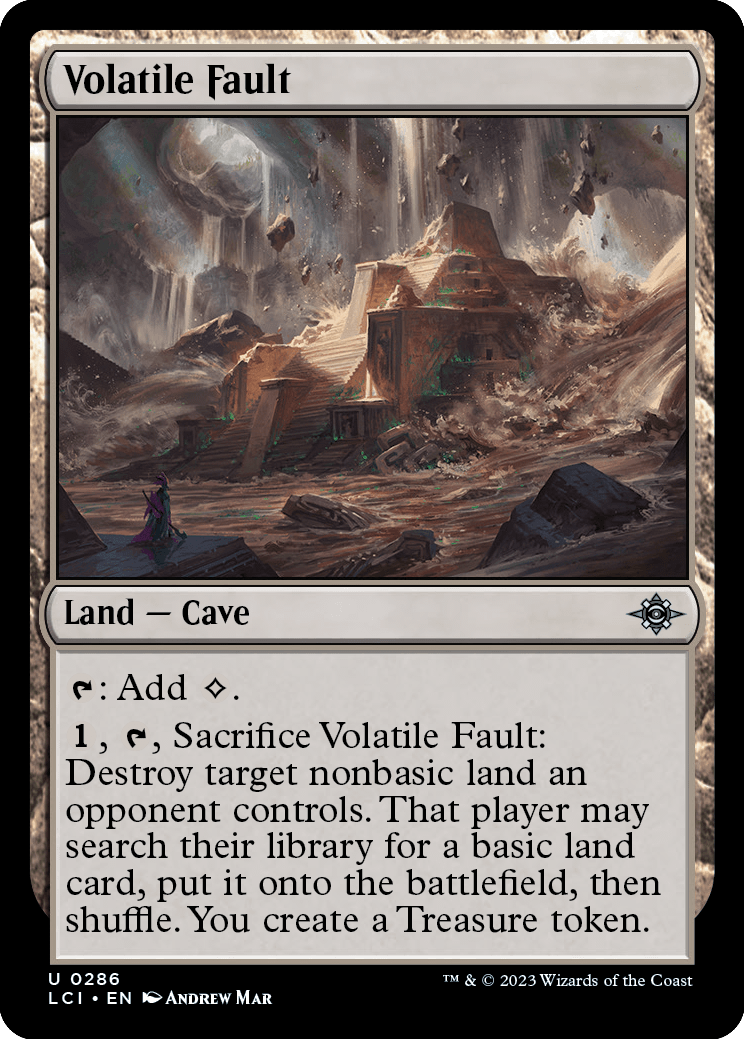
Volatile Fault
Land — Cave
: Add .
, , Sacrifice Volatile Fault: Destroy target nonbasic land an opponent controls. That player may search their library for a basic land card, put it onto the battlefield, then shuffle. You create a Treasure token.
- If the target of Volatile Fault's last ability is illegal as the ability tries to resolve, it won't resolve and none of its effects will happen. You won't create a Treasure token.
- If Volatile Fault's ability resolves, the target nonbasic land's controller gets to search for a basic land card even if the land wasn't destroyed by Volatile Fault's ability. This may happen because the land has indestructible. In this case, you'll still create a Treasure token.

Wail of the Forgotten
Sorcery
Descend 8 — Choose one. If there are eight or more permanent cards in your graveyard as you cast this spell, choose one or more instead.
• Return target nonland permanent to its owner's hand.
• Target opponent discards a card.
• Look at the top three cards of your library. Put one of them into your hand and the rest into your graveyard.
- If all targets for the chosen modes become illegal before Wail of the Forgotten resolves, the spell will be countered and none of its effects will happen. If at least one target is still legal, the spell will resolve but will have no effect on any illegal targets.
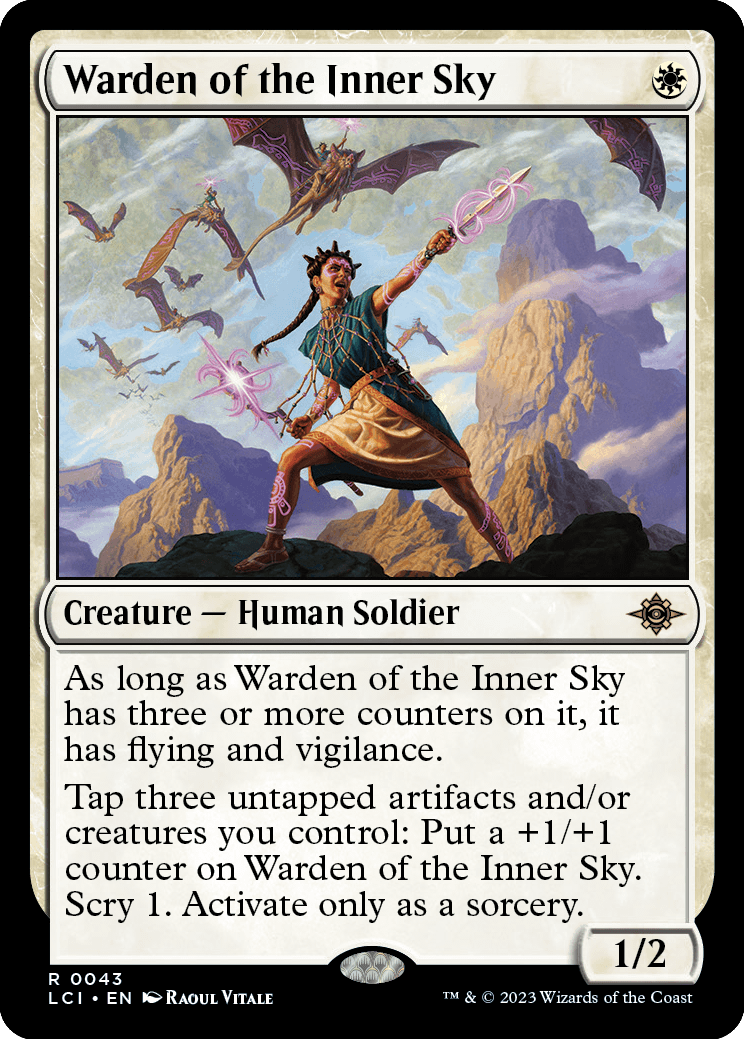
Warden of the Inner Sky
Creature — Human Soldier
1/2
As long as Warden of the Inner Sky has three or more counters on it, it has flying and vigilance.
Tap three untapped artifacts and/or creatures you control: Put a +1/+1 counter on Warden of the Inner Sky. Scry 1. Activate only as a sorcery.
- You can tap any three untapped artifacts and/or creatures you control, including Warden of the Inner Sky itself and other creatures you haven't controlled continuously since the beginning of your most recent turn, to pay the cost of Warden of the Inner Sky's activated ability.
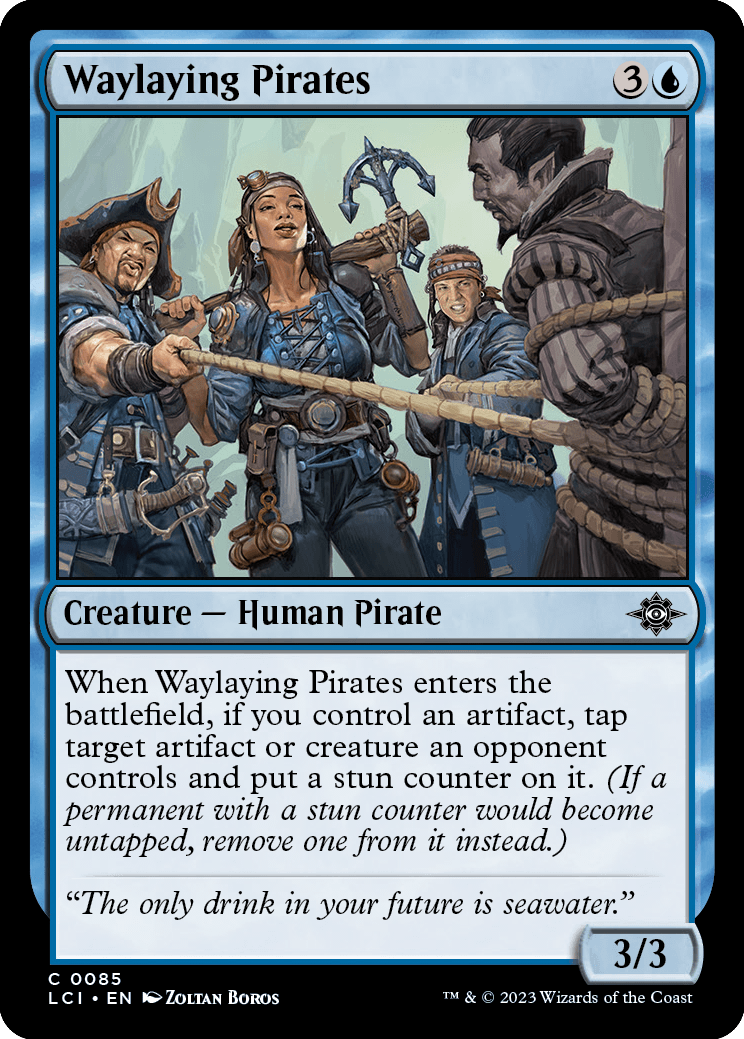
Waylaying Pirates
Creature — Human Pirate
3/3
When Waylaying Pirates enters the battlefield, if you control an artifact, tap target artifact or creature an opponent controls and put a stun counter on it. (If a permanent with a stun counter would become untapped, remove one from it instead.)
- The enters-the-battlefield ability can target an artifact or creature that's already tapped. If so, you'll just put a stun counter on that artifact or creature.
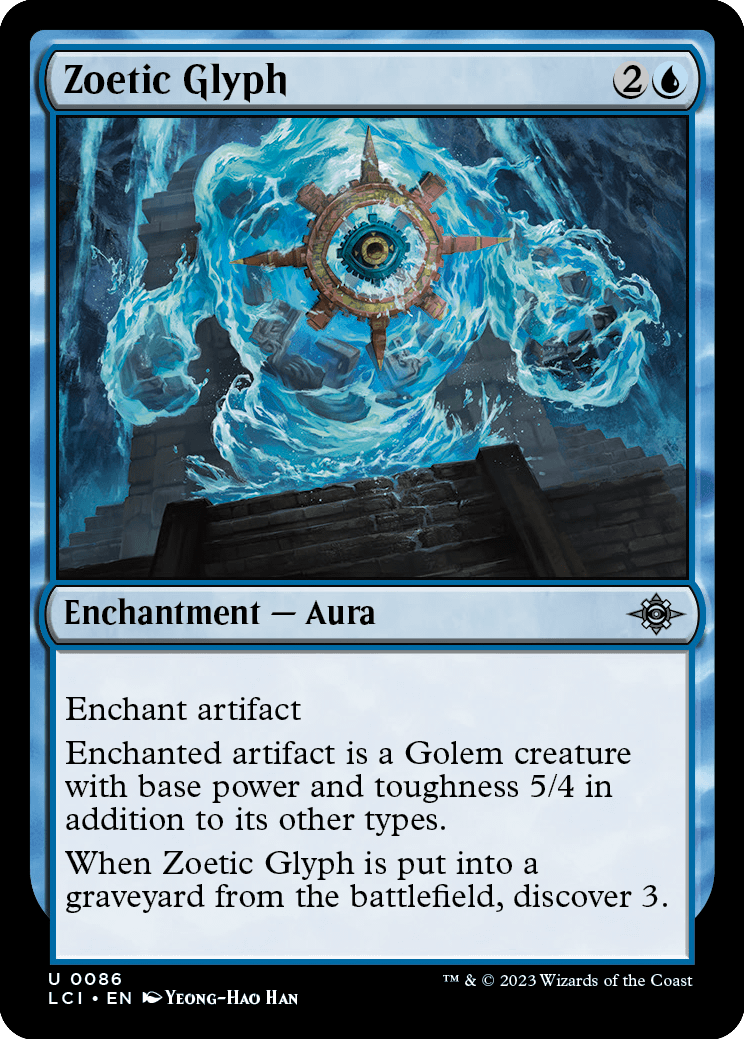
Zoetic Glyph
Enchantment — Aura
Enchant artifact
Enchanted artifact is a Golem creature with base power and toughness 5/4 in addition to its other types.
When Zoetic Glyph is put into a graveyard from the battlefield, discover 3.
- The artifact retains any types, subtypes, or supertypes it has. Notably, an Equipment that becomes an artifact creature usually can't be attached to another creature. If it was attached to a creature, it becomes unattached.
- If the artifact was already a creature, its base power and toughness will become 5/4. This overwrites any previous effects that set the creature's base power and toughness to specific values. Any power- or toughness-setting effects that start to apply after Zoetic Glyph becomes attached to the artifact will overwrite this effect.
- Effects that modify a creature's power and/or toughness, such as the ones created by Giant Growth, will apply to the creature no matter when they started to take effect. The same is true for any counters that change its power and/or toughness and effects that switch power and toughness.
- The resulting artifact creature will be able to attack on your turn if it's been under your control continuously since the turn began. That is, it doesn't matter how long it's been a creature, just how long it's been on the battlefield.
- If the creature Zoetic Glyph would enchant is an illegal target as Zoetic Glyph tries to resolve, it won't resolve. It's put into your graveyard from the stack, not the battlefield, so its last ability won't trigger.
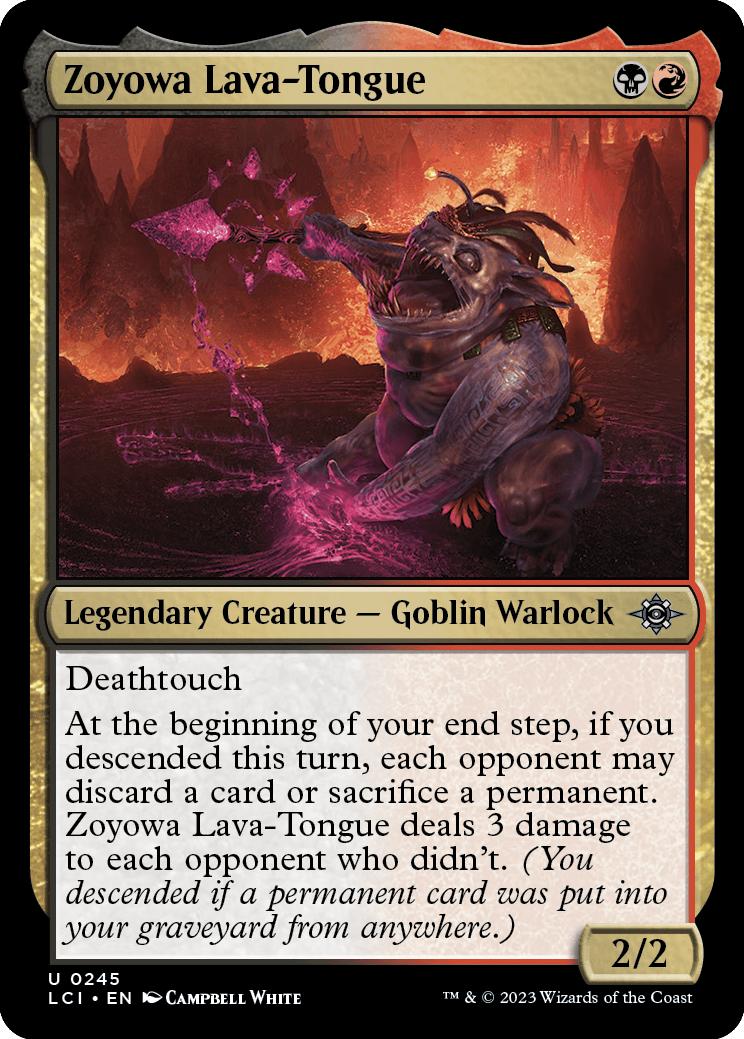
Zoyowa Lava-Tongue
Legendary Creature — Goblin Warlock
2/2
Deathtouch
At the beginning of your end step, if you descended this turn, each opponent may discard a card or sacrifice a permanent. Zoyowa Lava-Tongue deals 3 damage to each opponent who didn't. (You descended if a permanent card was put into your graveyard from anywhere.)
- An opponent with zero cards in hand can't choose to discard a card. Similarly, an opponent with no permanents can't choose to sacrifice a permanent.
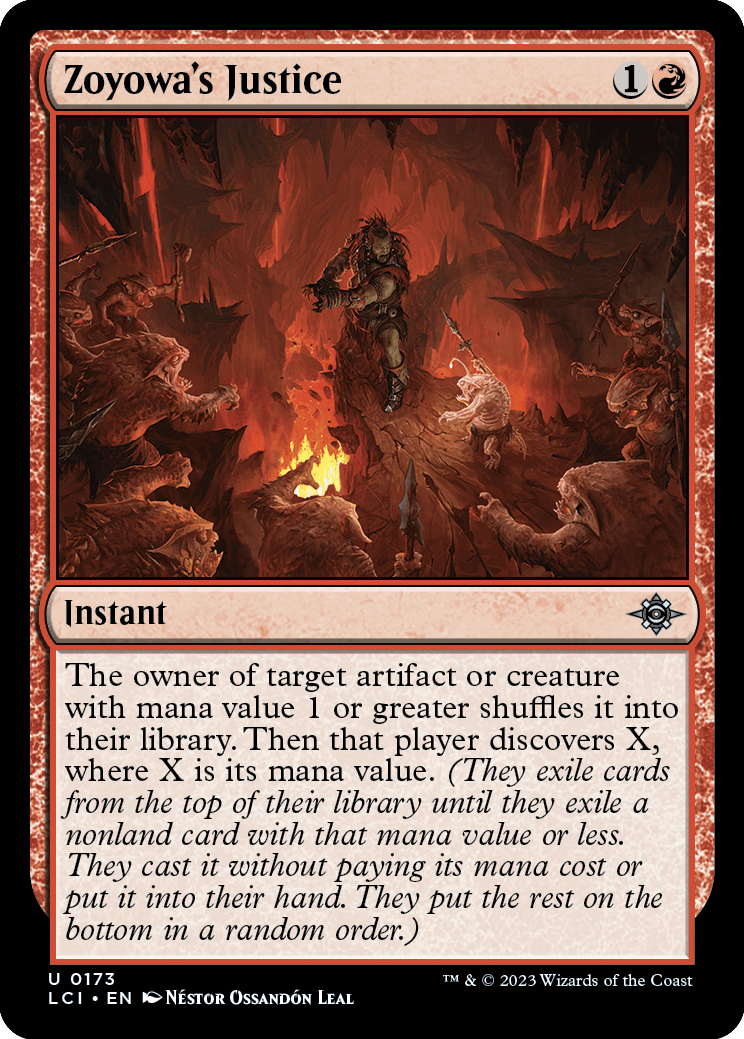
Zoyowa's Justice
Instant
The owner of target artifact or creature with mana value 1 or greater shuffles it into their library. Then that player discovers X, where X is its mana value. (They exile cards from the top of their library until they exile a nonland card with that mana value or less. They cast it without paying its mana cost or put it into their hand. They put the rest on the bottom in a random order.)
- If the target artifact or creature has X in its mana cost, that X is 0 when determining its mana value.
JURASSIC WORLD COLLECTION CARD-SPECIFIC NOTES
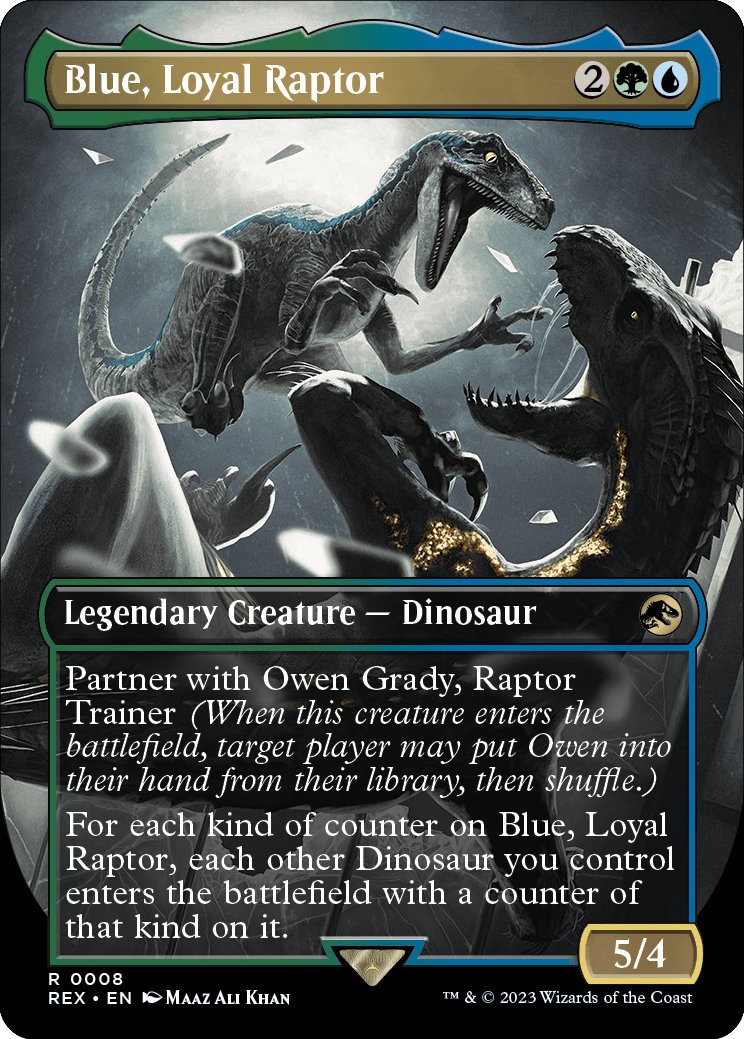
Blue, Loyal Raptor
Legendary Creature — Dinosaur
5/4
Partner with Owen Grady, Raptor Trainer (When this creature enters the battlefield, target player may put Owen into their hand from their library, then shuffle.)
For each kind of counter on Blue, Loyal Raptor, each other Dinosaur you control enters the battlefield with a counter of that kind on it.
- If Blue, Loyal Raptor enters the battlefield with one or more kinds of counters on it at the same time as other Dinosaurs you control, those other Dinosaurs won't get additional counters from Blue, Loyal Raptor's last ability.
- "Partner with [name]" represents two abilities. The first is a triggered ability: "When this permanent enters the battlefield, target player may search their library for a card named [name], reveal it, put it into their hand, then shuffle their library."
- Note that the target player searches their library (which may be affected by effects such as that of Stranglehold) and that the card they find is revealed, even though these words aren't included in the ability's reminder text.
- The second ability represented by the "partner with [name]" keyword modifies the rules for deck construction in the Commander variant and has no function outside of that variant. If a legendary creature card with "partner with [name]" is designated as your commander, the named legendary creature card can also be designated as your commander.
- If your Commander deck has two commanders, you can only include cards whose own color identities are also found in your commanders' combined color identities. If Blue, Loyal Raptor and Owen Grady, Raptor Trainer are your commanders, your deck may contain cards with green, blue, and/or red in their color identity, but not white or black.
- Both commanders start in the command zone, and the remaining 98 cards (or 58 cards in a Commander Draft game) of your deck are shuffled to become your library.
- To have two commanders, both must have the partner ability or corresponding "partner with" abilities as the game begins. A creature with a "partner with" ability can't partner with any creature other than its designated partner. Losing a partner ability during the game doesn't cause either to cease to be your commander.
- Once the game begins, your two commanders are tracked separately. If you cast one, you won't have to pay an additional the first time you cast the other. A player loses the game after having been dealt 21 damage from one of them, not from both of them combined. Command Beacon's effect puts one into your hand from the command zone, not both.
- An effect that checks whether you control your commander is satisfied if you control one or both of your two commanders.
- The triggered ability of the "partner with" keyword still triggers in a Commander game. If your other commander has somehow ended up in your library, you can find it. You can also target another player, whether or not they have that card in their library.
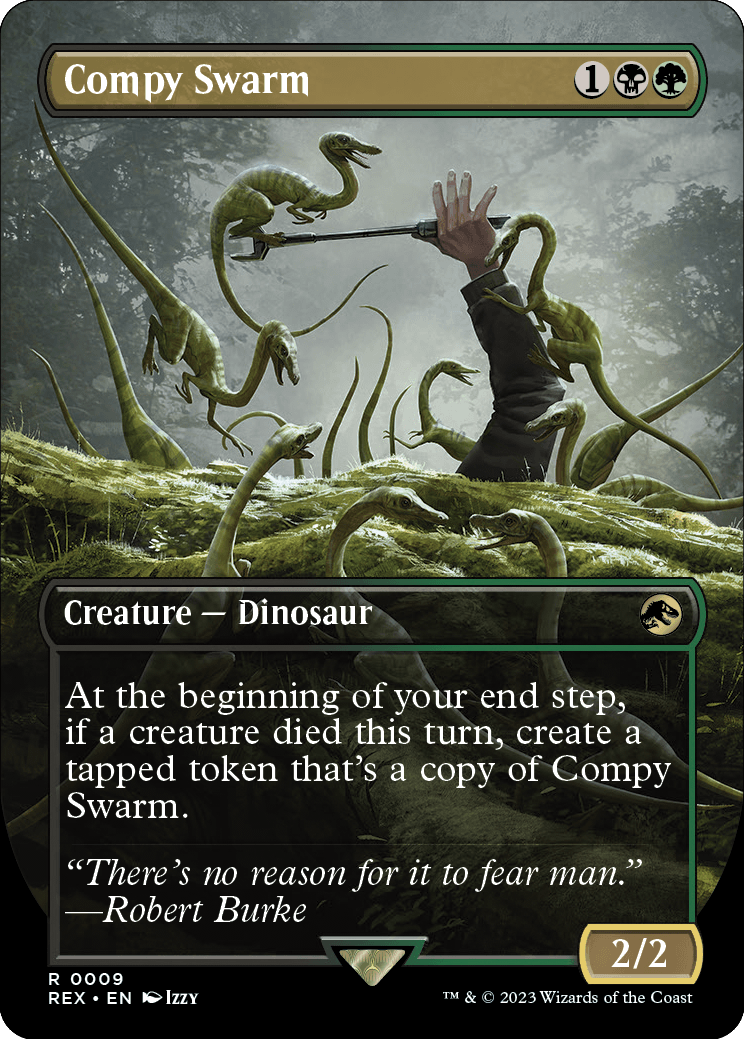
Compy Swarm
Creature — Dinosaur
2/2
At the beginning of your end step, if a creature died this turn, create a tapped token that's a copy of Compy Swarm.
- The token copy will have Compy Swarm's ability. It will also be able to create copies of itself.
- The token copy won't copy counters or damage marked on Compy Swarm, nor will it copy other effects that have changed Compy Swarm's power, toughness, types, color, and so on. Normally, this means the token will simply be a Compy Swarm, but if any copy effects have affected the original Compy Swarm, the token will take those into account.
- If Compy Swarm leaves the battlefield before its triggered ability resolves, the token will still enter the battlefield as a copy of Compy Swarm, using Compy Swarm's copiable values from when it was last on the battlefield.
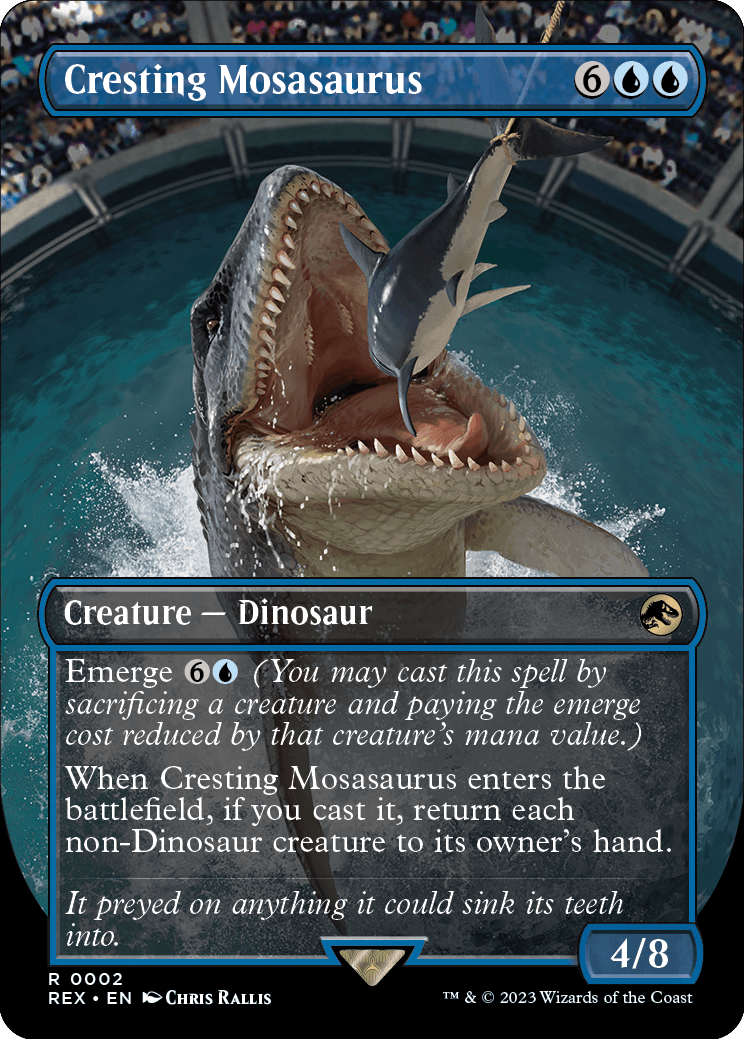
Cresting Mosasaurus
Creature — Dinosaur
4/8
Emerge (You may cast this spell by sacrificing a creature and paying the emerge cost reduced by that creature's mana value.)
When Cresting Mosasaurus enters the battlefield, if you cast it, return each non-Dinosaur creature to its owner's hand.
- Cresting Mosasaurus's last ability triggers if you cast it from any zone. It doesn't trigger if you put Cresting Mosasaurus onto the battlefield without casting it.
- If you sacrifice a creature with in its mana cost, that X is 0.
- A creature's mana value is determined solely by the mana symbols printed in its upper right corner (unless that creature is the back face of a double-faced card, is a melded permanent, or is copying something else; see below). If the mana cost includes , X is 0. If it's a single-faced card with no mana symbols in its upper right corner (because it's an animated land, for example), its mana value is 0. Ignore any alternative costs or additional costs (such as kicker) that were paid as the creature was cast.
- Colored mana components of emerge costs can't be reduced with emerge.
- You may sacrifice a creature with a mana value of 0, such as a token creature that's not a copy of another permanent, to cast a spell for its emerge cost. You'll just pay the full emerge cost with no reduction.
- You may sacrifice a creature with mana value greater than or equal to the emerge cost. If you do, you'll pay only the colored mana component of the emerge cost.
- The mana value of the back face of a double-faced card is the mana value of its front face. The mana value of a melded permanent is the sum of the mana values of its front faces. A creature that's a copy of either has a mana value of 0.
- The mana value of a creature spell with emerge isn't affected by whether its emerge cost is paid. For example, if you cast Cresting Mosasaurus for its emerge cost and sacrifice a creature whose mana value is 3, Cresting Mosasaurus's mana value remains 8.
- The creature chosen to be sacrificed is still on the battlefield up through the time that you activate mana abilities. Its abilities may affect the spell's cost, be activated to generate mana, and so on. However, if it has an ability that triggers when a spell is cast, it will have been sacrificed before that ability can trigger.
- Once you begin to cast a spell with emerge, no player may take actions until you're done. Notably, opponents can't try to remove the creature you wish to sacrifice.
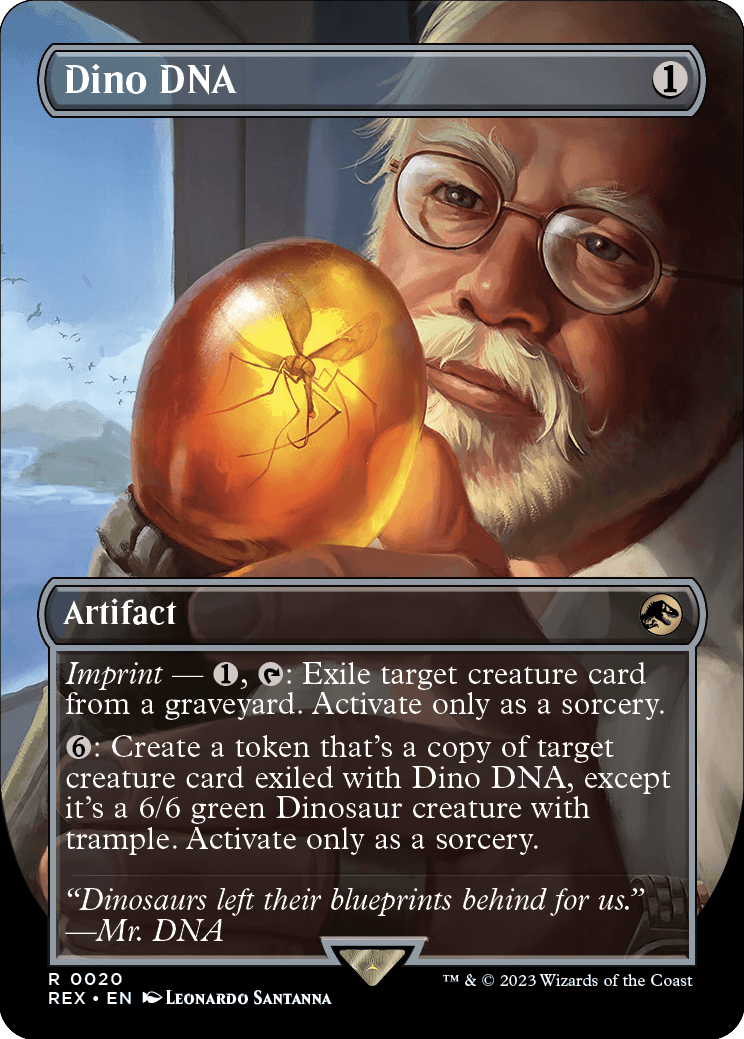
Dino DNA
Artifact
Imprint — , : Exile target creature card from a graveyard. Activate only as a sorcery.
: Create a token that's a copy of target creature card exiled with Dino DNA, except it's a 6/6 green Dinosaur creature with trample. Activate only as a sorcery.
- The token copies exactly what was printed on the original card and nothing else, except the characteristics it specifically modifies.
- If the copied card has in its mana cost, X is 0.
- Any enters-the-battlefield abilities of the copied card will trigger when the token enters the battlefield. Any "as [this creature] enters the battlefield" or "[this creature] enters the battlefield with" abilities of the copied card will also work.
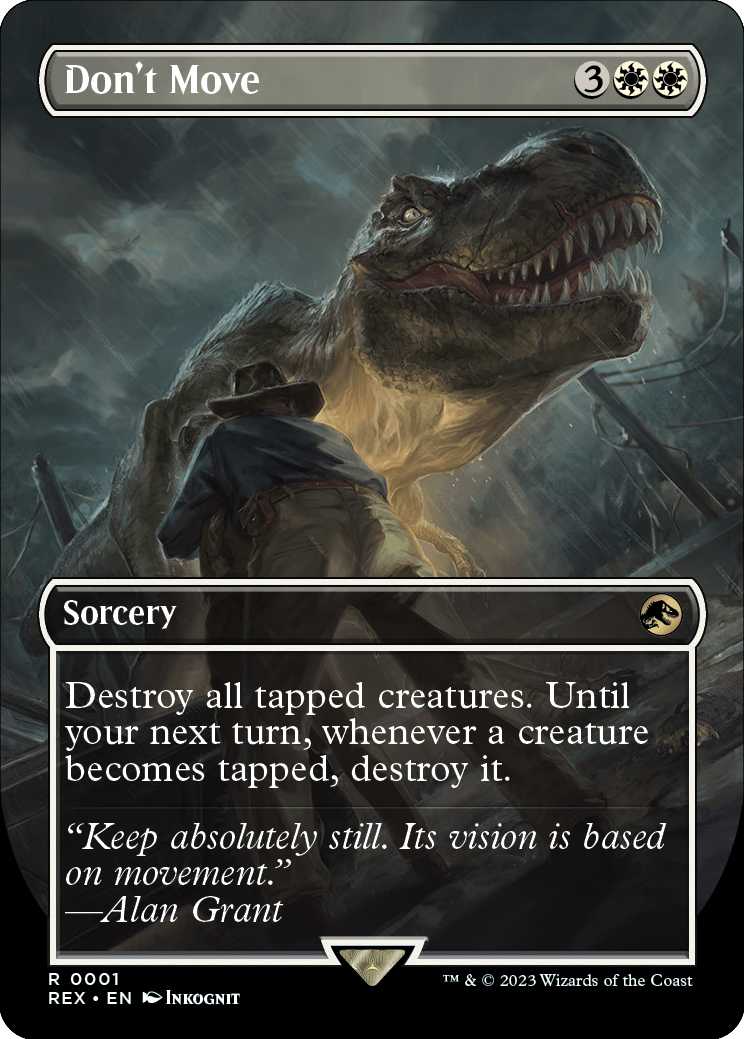
Don't Move
Sorcery
Destroy all tapped creatures. Until your next turn, whenever a creature becomes tapped, destroy it.
- Don't Move won't affect a creature that enters the battlefield tapped.
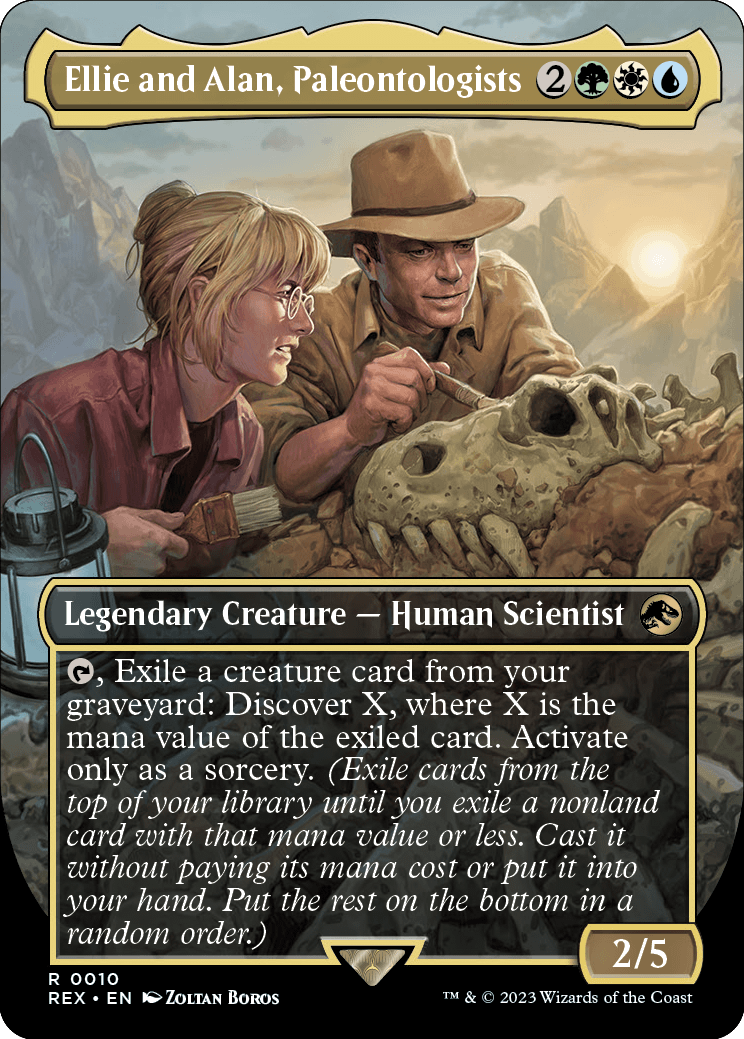
Ellie and Alan, Paleontologists
Legendary Creature — Human Scientist
2/5
, Exile a creature card from your graveyard: Discover X, where X is the mana value of the exiled card. Activate only as a sorcery. (Exile cards from the top of your library until you exile a nonland card with that mana value or less. Cast it without paying its mana cost or put it into your hand. Put the rest on the bottom in a random order.)
- If the exiled card has in its mana cost, X is 0.
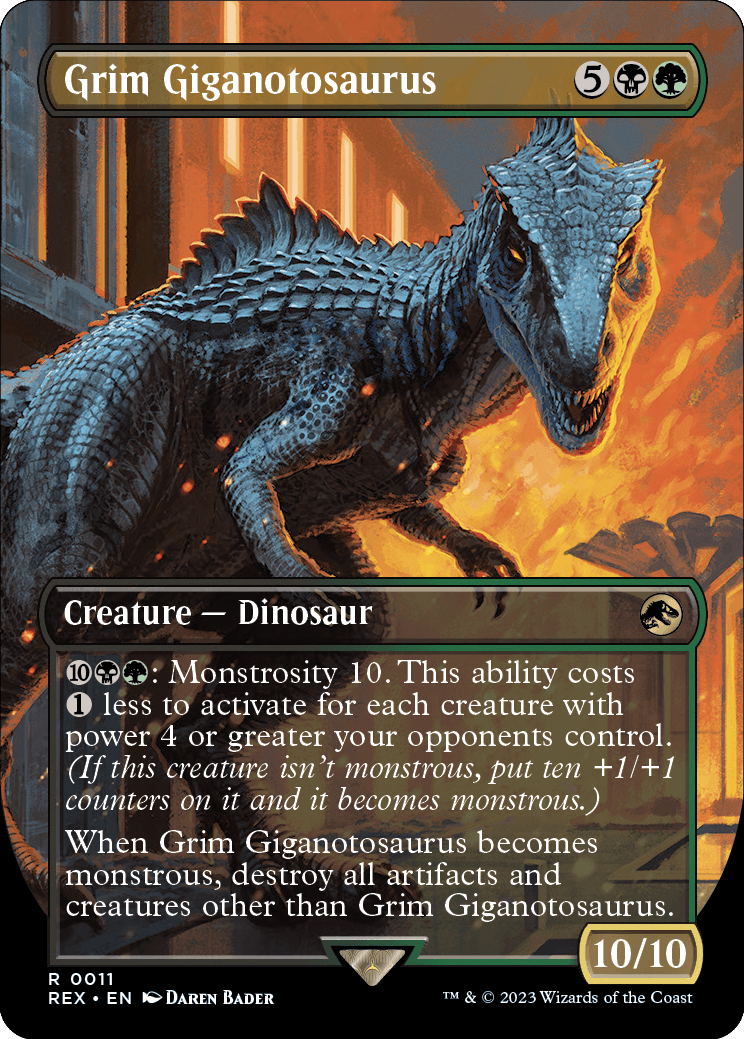
Grim Giganotosaurus
Creature — Dinosaur
10/10
: Monstrosity 10. This ability costs less to activate for each creature with power 4 or greater your opponents control. (If this creature isn't monstrous, put ten +1/+1 counters on it and it becomes monstrous.)
When Grim Giganotosaurus becomes monstrous, destroy all artifacts and creatures other than Grim Giganotosaurus.
- Once a creature becomes monstrous, it can't become monstrous again. If the creature is already monstrous when the monstrosity ability resolves, nothing happens.
- Monstrous isn't an ability that a creature has. It's just something true about that creature. If the creature stops being a creature or loses its abilities, it will continue to be monstrous.
- An ability that triggers when a creature becomes monstrous won't trigger if that creature isn't on the battlefield when its monstrosity ability resolves.
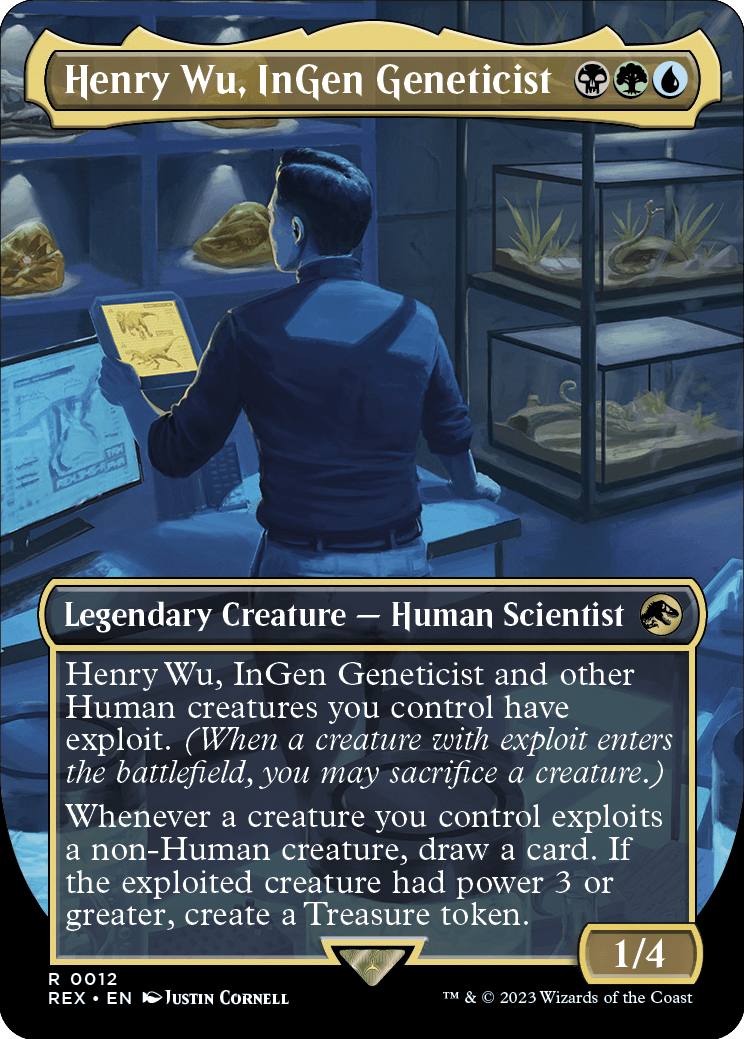
Henry Wu, InGen Geneticist
Legendary Creature — Human Scientist
1/4
Henry Wu, InGen Geneticist and other Human creatures you control have exploit. (When a creature with exploit enters the battlefield, you may sacrifice a creature.)
Whenever a creature you control exploits a non-Human creature, draw a card. If the exploited creature had power 3 or greater, create a Treasure token.
- If a creature you control exploits a Human creature with power 3 or greater, Henry Wu, InGen Geneticist's last ability still won't trigger. You won't create a Treasure token.
- A creature with exploit "exploits a creature" when the controller of the exploit ability sacrifices a creature as that ability resolves.
- You choose whether to sacrifice a creature and which creature to sacrifice as the exploit ability resolves.
- You can sacrifice the creature with exploit if it's still on the battlefield.
- You can't sacrifice more than one creature to any one exploit ability.
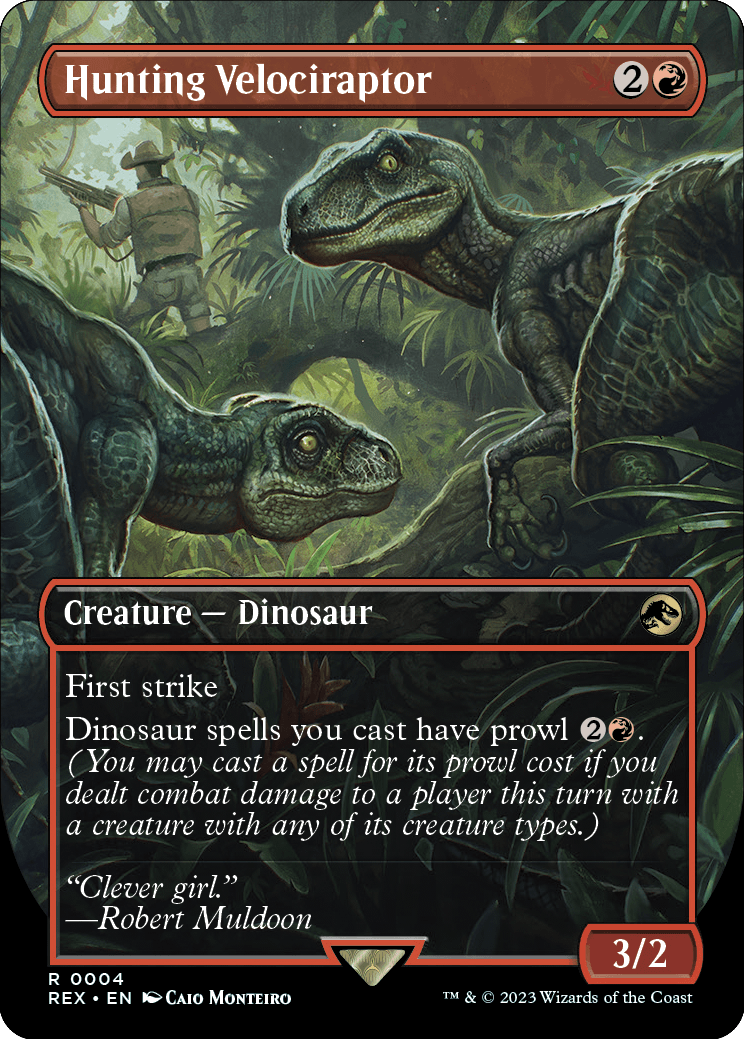
Hunting Velociraptor
Creature — Dinosaur
3/2
First strike
Dinosaur spells you cast have prowl . (You may cast a spell for its prowl cost if you dealt combat damage to a player this turn with a creature with any of its creature types.)
- You can cast a spell for its prowl cost any time in a turn after a creature you control of a matching type has dealt combat damage to a player. It doesn't matter if that player left the game, if that creature left the battlefield or left your control, or if that creature no longer has a matching type.
- Prowl compares the creature types of the spell with the creature types of the creatures that dealt combat damage to players this turn. For example, this means that normally, if you control Hunting Velociraptor, you can cast Grim Giganotosaurus for its prowl cost only if a Dinosaur dealt combat damage to a player, but if an effect causes the spell to have other creature types, the prowl ability is also satisfied by a creature with those additional types having dealt combat damage to a player.
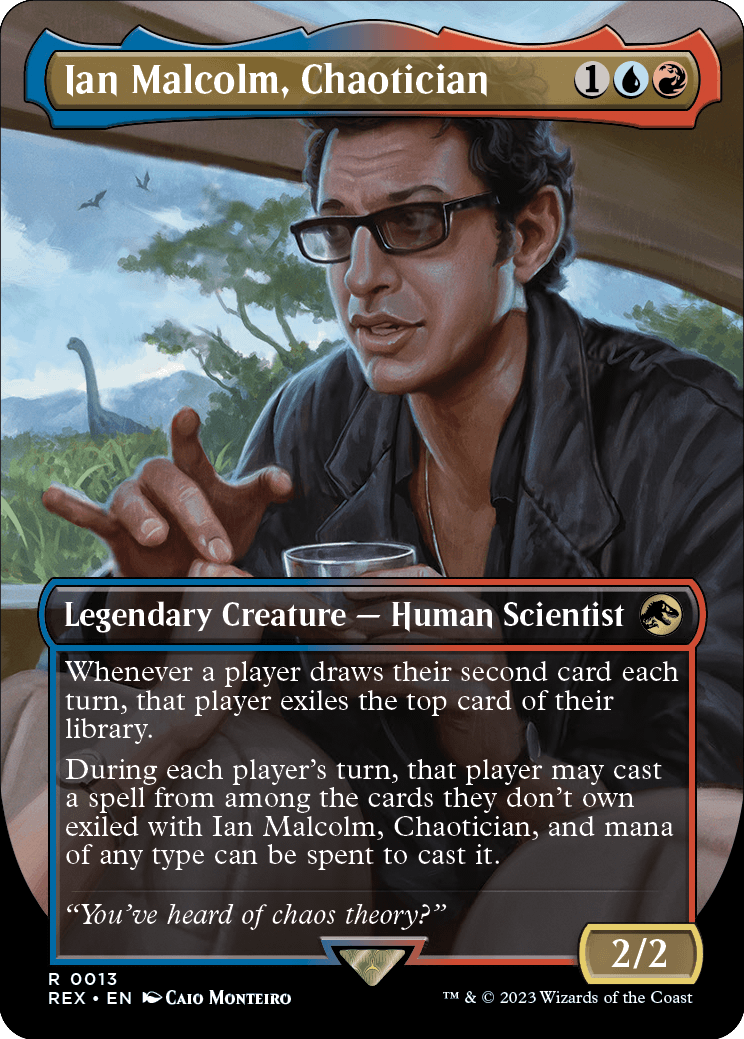
Ian Malcolm, Chaotician
Legendary Creature — Human Scientist
2/2
Whenever a player draws their second card each turn, that player exiles the top card of their library.
During each player's turn, that player may cast a spell from among the cards they don't own exiled with Ian Malcolm, Chaotician, and mana of any type can be spent to cast it.
- Ian Malcolm, Chaotician's first ability can trigger only once each turn for each player. It doesn't matter if Ian was on the battlefield when the first card was drawn. If you control it when a player draws their second card in a turn, that ability will trigger.
- Players must follow all applicable timing rules for casting spells with the permission granted by Ian Malcolm, Chaotician's last ability. For example, if the spell is a sorcery, it can only be cast during that player's main phase while the stack is empty.
- The six types of mana are white, blue, black, red, green, and colorless. Snow mana is not a type of mana. Ian Malcolm, Chaotician won't let you pay a snow cost using mana produced by a nonsnow source.
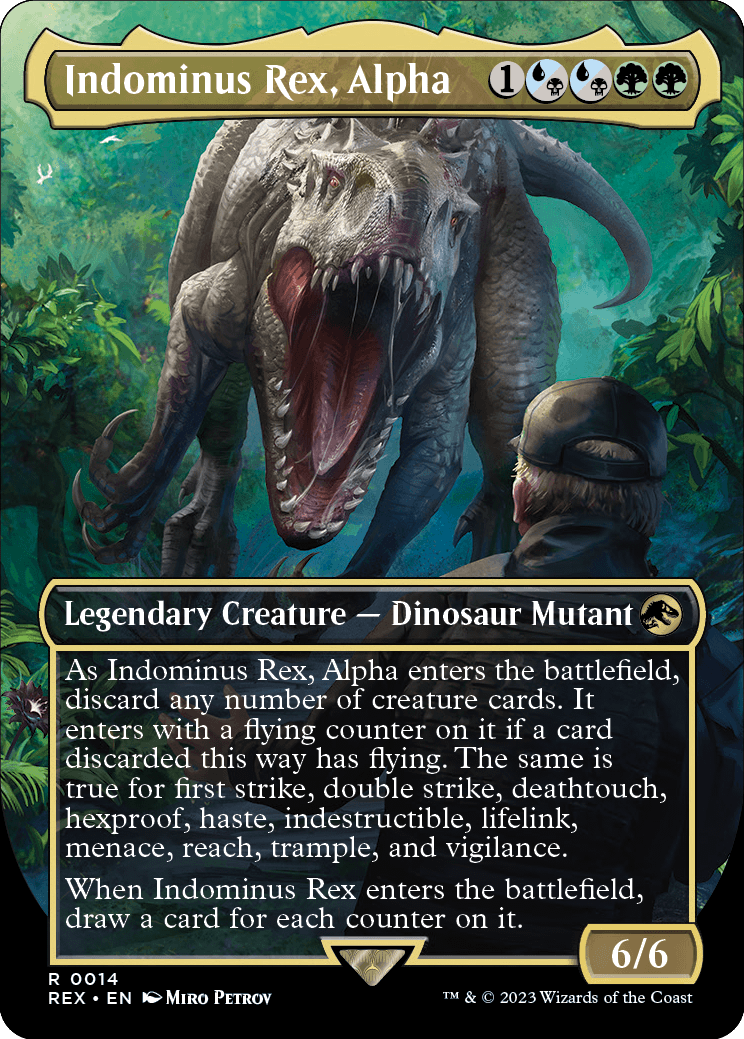
Indominus Rex, Alpha
Legendary Creature — Dinosaur Mutant
6/6
As Indominus Rex, Alpha enters the battlefield, discard any number of creature cards. It enters with a flying counter on it if a card discarded this way has flying. The same is true for first strike, double strike, deathtouch, hexproof, haste, indestructible, lifelink, menace, reach, trample, and vigilance.
When Indominus Rex enters the battlefield, draw a card for each counter on it.
- Indominus Rex's first ability will give it only one of each kind of counter, even if you discard more than one creature card with the relevant ability.
- If you put counters on Indominus Rex before its last ability resolves, those counters will count.
- If Indominus Rex isn't on the battlefield as its last ability resolves, use the number of counters that were on it when it was last on the battlefield to determine how many cards to draw.
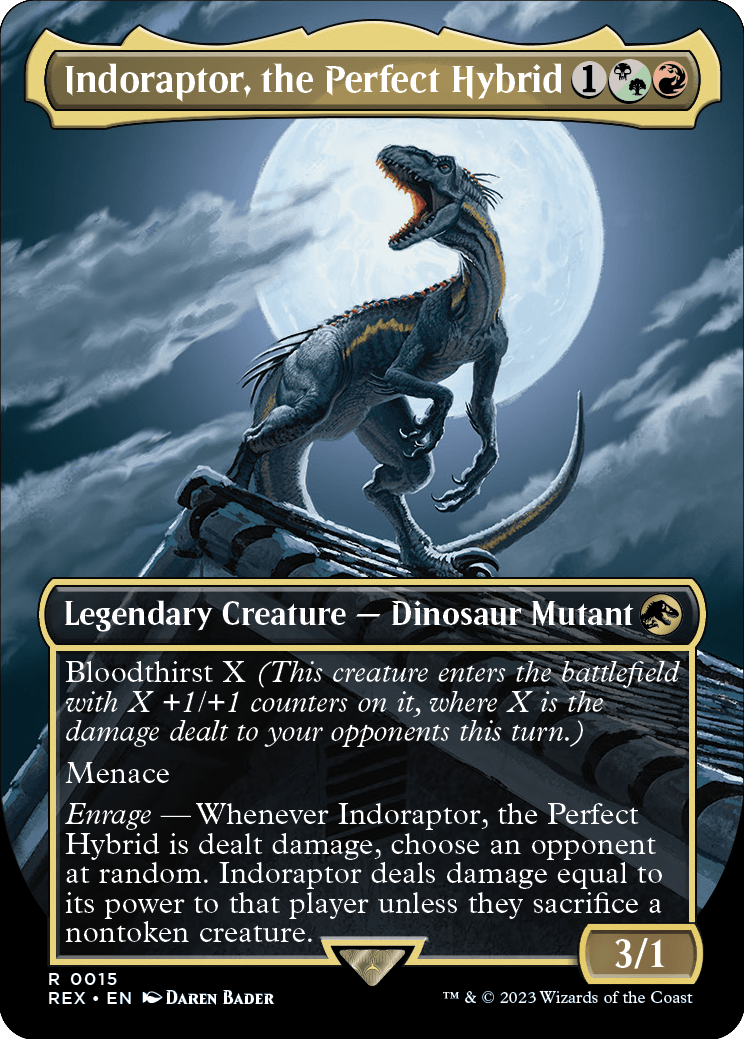
Indoraptor, the Perfect Hybrid
Legendary Creature — Dinosaur Mutant
3/1
Bloodthirst X (This creature enters the battlefield with X +1/+1 counters on it, where X is the damage dealt to your opponents this turn.)
Menace
Enrage — Whenever Indoraptor, the Perfect Hybrid is dealt damage, choose an opponent at random. Indoraptor deals damage equal to its power to that player unless they sacrifice a nontoken creature.
- Indoraptor, the Perfect Hybrid's bloodthirst ability counts all damage dealt to your opponents this turn, not just damage dealt by sources you control.
- If multiple sources deal damage to a creature with an enrage ability at the same time, most likely because multiple creatures blocked that creature, the enrage ability triggers only once.
- If lethal damage is dealt to Indoraptor, its enrage ability triggers. Use Indoraptor's power from when it was last on the battlefield to determine how much damage it deals to the chosen player if they don't sacrifice a nontoken creature.
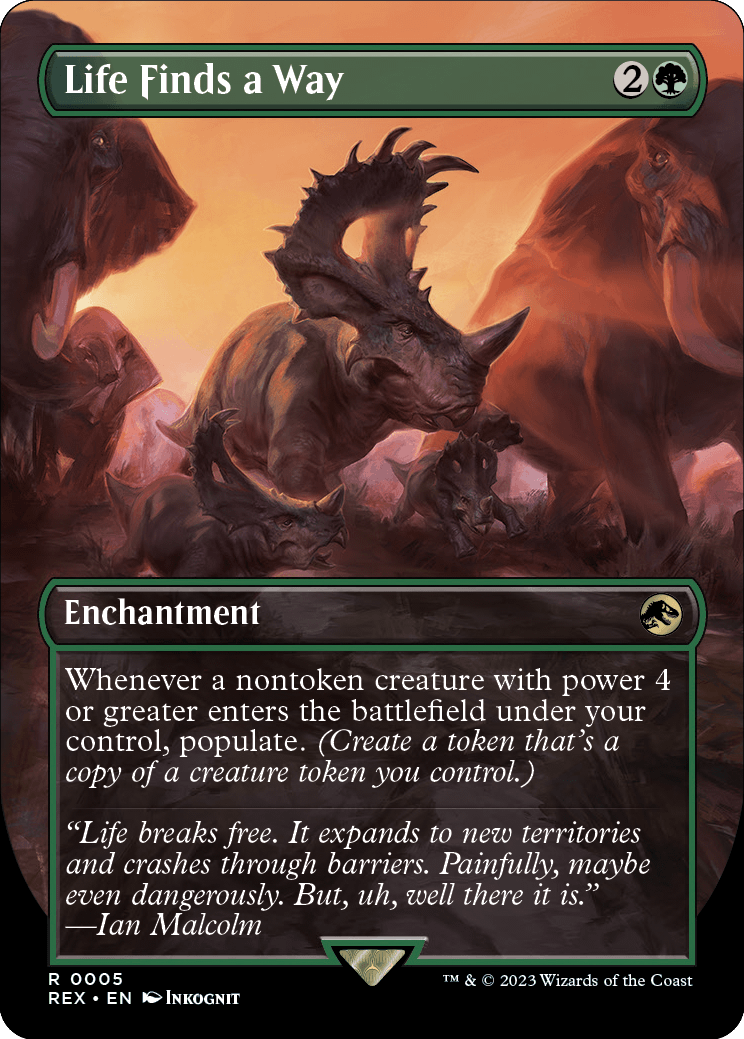
Life Finds a Way
Enchantment
Whenever a nontoken creature with power 4 or greater enters the battlefield under your control, populate. (Create a token that's a copy of a creature token you control.)
- If you control no creature tokens when you populate, nothing will happen.
- The new creature token copies the characteristics of the original token as stated by the effect that created the original token.
- The new token doesn't copy whether the original token is tapped or untapped, whether it has any counters on it or Auras and Equipment attached to it, or any non-copy effects that have changed its power, toughness, color, and so on.
- Any "as [this creature] enters the battlefield" or "[this creature] enters the battlefield with" abilities of the new token will work.
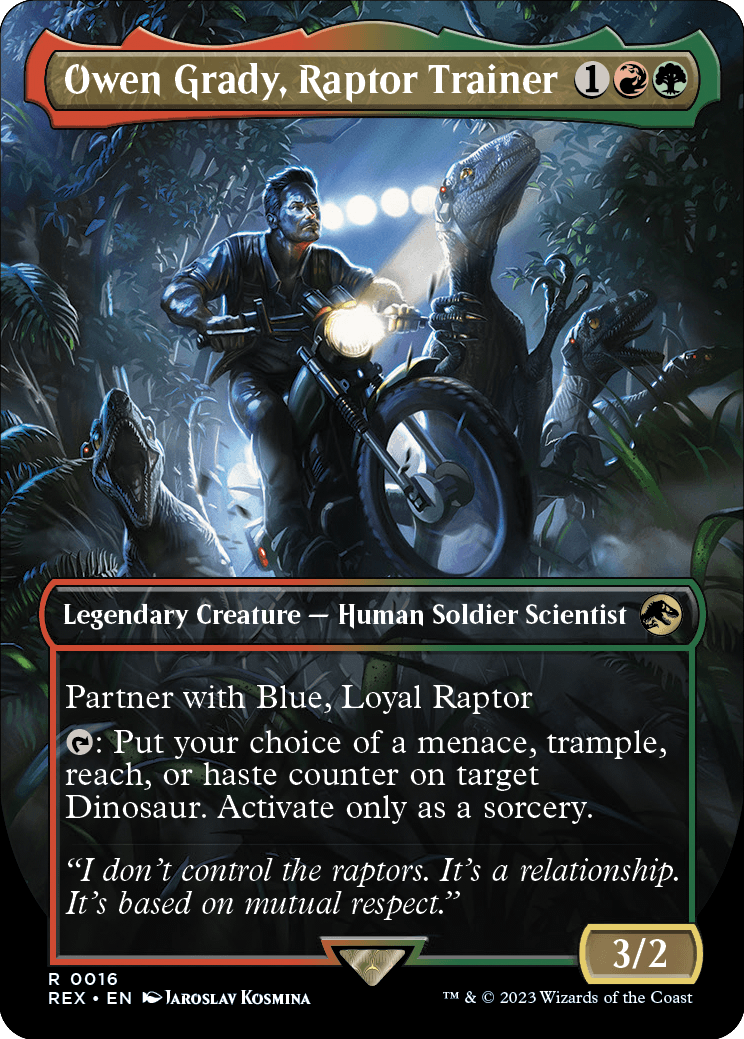
Owen Grady, Raptor Trainer
Legendary Creature — Human Soldier Scientist
3/2
Partner with Blue, Loyal Raptor
: Put your choice of a menace, trample, reach, or haste counter on target Dinosaur. Activate only as a sorcery.
- "Partner with [name]" represents two abilities. The first is a triggered ability: "When this permanent enters the battlefield, target player may search their library for a card named [name], reveal it, put it into their hand, then shuffle their library."
- Note that the target player searches their library (which may be affected by effects such as that of Stranglehold) and that the card they find is revealed, even though these words aren't included in the ability's reminder text.
- The second ability represented by the "partner with [name]" keyword modifies the rules for deck construction in the Commander variant and has no function outside of that variant. If a legendary creature card with "partner with [name]" is designated as your commander, the named legendary creature card can also be designated as your commander.
- If your Commander deck has two commanders, you can only include cards whose own color identities are also found in your commanders' combined color identities. If Blue, Loyal Raptor and Owen Grady, Raptor Trainer are your commanders, your deck may contain cards with green, blue, and/or red in their color identity, but not white or black.
- Both commanders start in the command zone, and the remaining 98 cards (or 58 cards in a Commander Draft game) of your deck are shuffled to become your library.
- To have two commanders, both must have the partner ability or corresponding "partner with" abilities as the game begins. A creature with a "partner with" ability can't partner with any creature other than its designated partner. Losing a partner ability during the game doesn't cause either to cease to be your commander.
- Once the game begins, your two commanders are tracked separately. If you cast one, you won't have to pay an additional the first time you cast the other. A player loses the game after having been dealt 21 damage from one of them, not from both of them combined. Command Beacon's effect puts one into your hand from the command zone, not both.
- An effect that checks whether you control your commander is satisfied if you control one or both of your two commanders.
- The triggered ability of the "partner with" keyword still triggers in a Commander game. If your other commander has somehow ended up in your library, you can find it. You can also target another player, whether or not they have that card in their library.
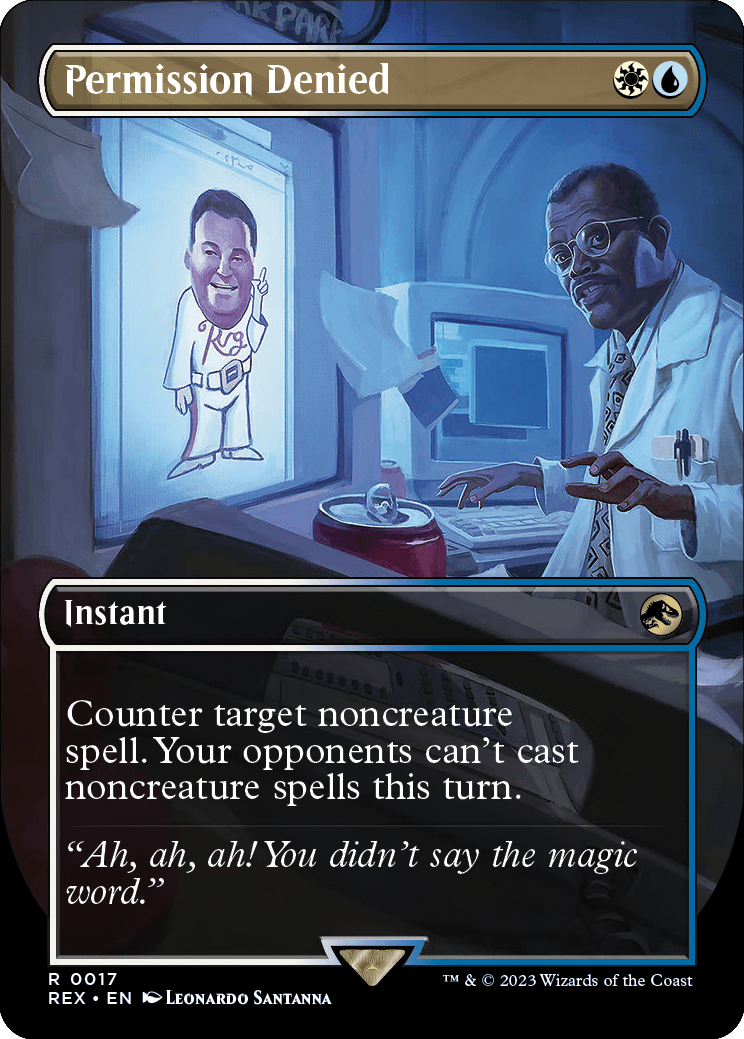
Permission Denied
Instant
Counter target noncreature spell. Your opponents can't cast noncreature spells this turn.
- If the spell is an illegal target as Permission Denied tries to resolve, it won't resolve and none of its effects will happen. Your opponents will still be able to cast noncreature spells this turn.
- Permission Denied's effect applies to all opponents, not just the player who controlled the spell targeted by Permission Denied.
- If Permission Denied resolves but the spell isn't countered (perhaps because it can't be countered), opponents will still be unable to cast noncreature spells this turn.
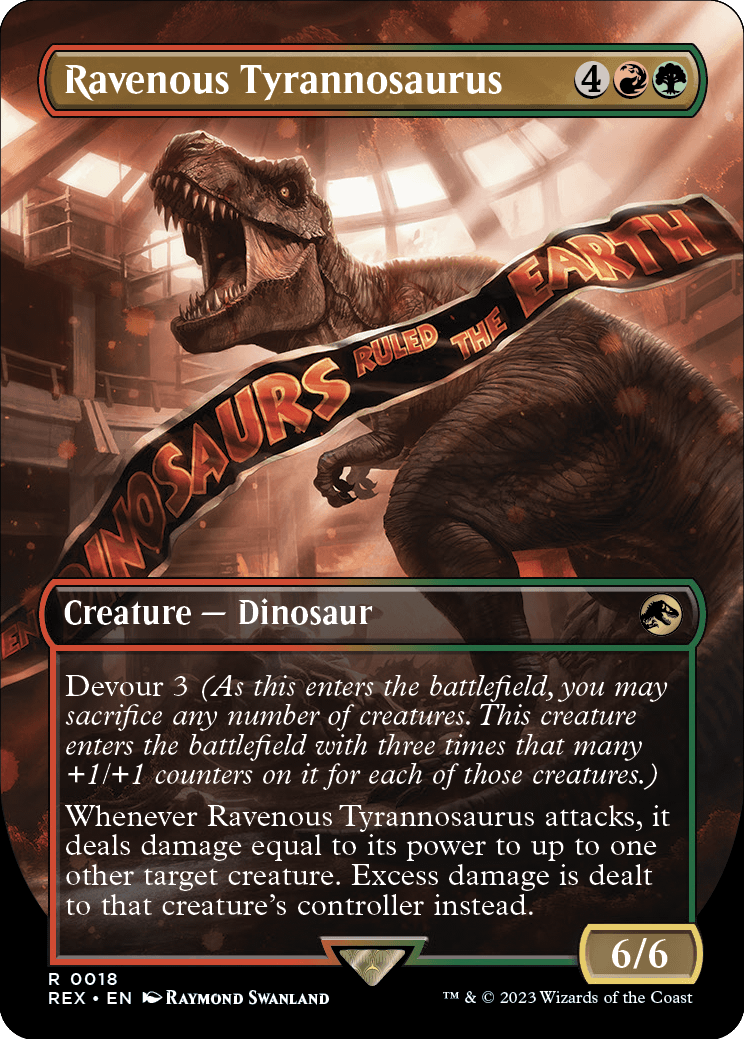
Ravenous Tyrannosaurus
Creature — Dinosaur
6/6
Devour 3 (As this enters the battlefield, you may sacrifice any number of creatures. This creature enters the battlefield with three times that many +1/+1 counters on it for each of those creatures.)
Whenever Ravenous Tyrannosaurus attacks, it deals damage equal to its power to up to one other target creature. Excess damage is dealt to that creature's controller instead.
- Ravenous Tyrannosaurus can't devour creatures entering the battlefield at the same time as it.
- Excess damage is calculated in a way similar to the way trample is handled. Start with the amount of damage being dealt to the creature and determine what is lethal. Usually, this is the creature's toughness minus the damage already marked on it, ignoring any replacement or prevention effects that will modify this damage. Also ignore whether the creature won't actually be destroyed by this damage, perhaps because it has indestructible.
- Once you've determined how much damage is excess, Ravenous Tyrannosaurus simultaneously deals damage to the target creature and its controller. This damage may be modified by replacement or prevention effects.
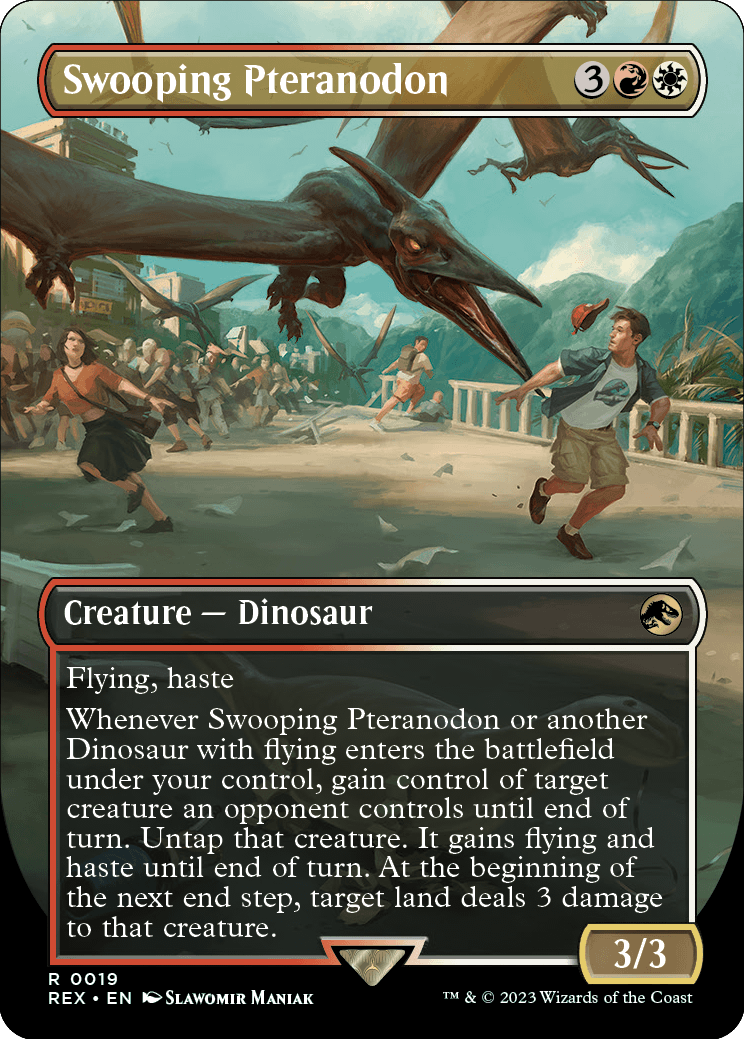
Swooping Pteranodon
Creature — Dinosaur
3/3
Flying, haste
Whenever Swooping Pteranodon or another Dinosaur with flying enters the battlefield under your control, gain control of target creature an opponent controls until end of turn. Untap that creature. It gains flying and haste until end of turn. At the beginning of the next end step, target land deals 3 damage to that creature.
- Swooping Pteranodon's triggered ability targets only the creature an opponent controls. You choose the target land (where the poor creature is going to drop) as the delayed triggered ability triggers at the beginning of the next end step.
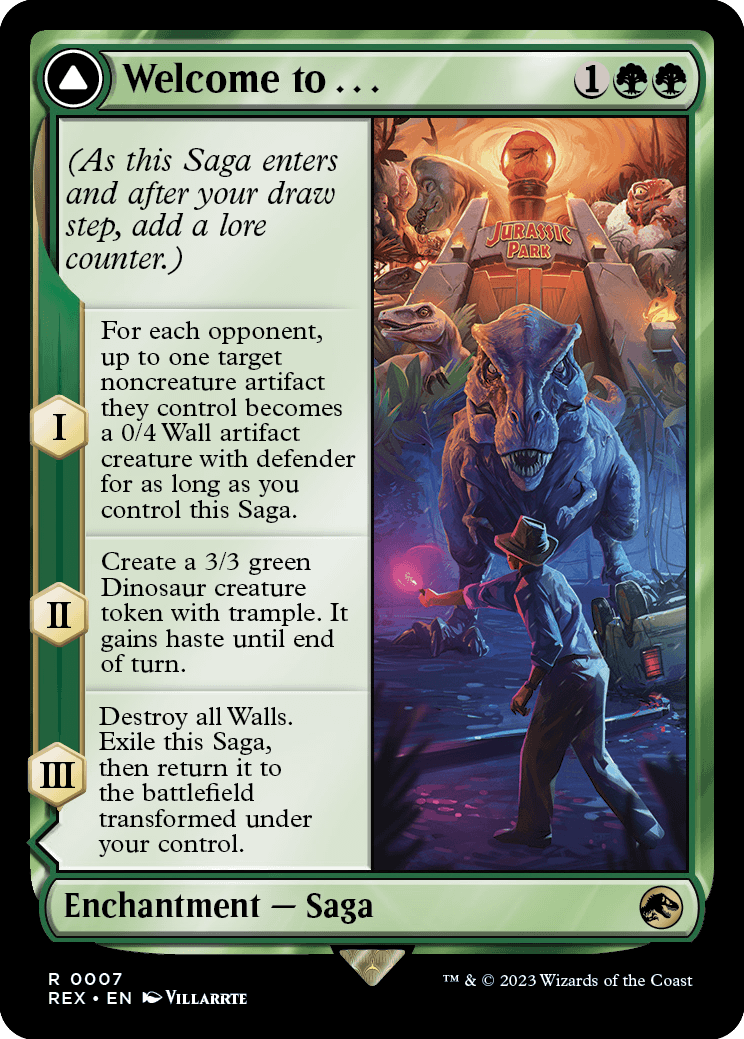
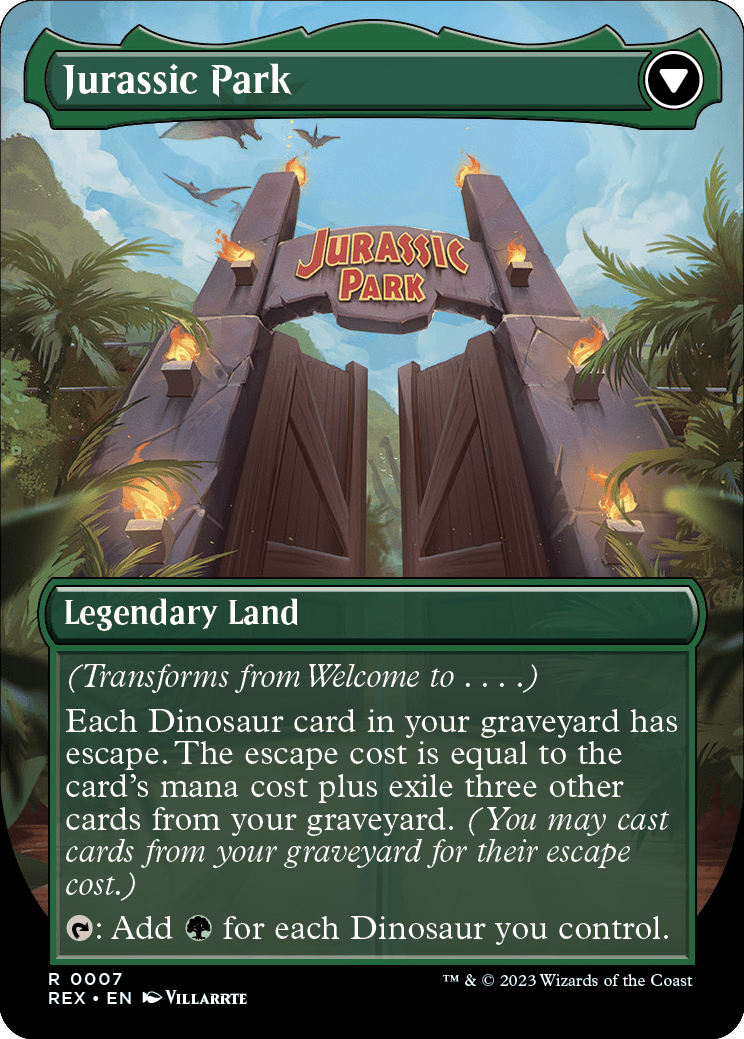
Welcome to . . .
Enchantment — Saga
(As this Saga enters and after your draw step, add a lore counter.)
I — For each opponent, up to one target noncreature artifact they control becomes a 0/4 Wall artifact creature with defender for as long as you control this Saga.
II — Create a 3/3 green Dinosaur creature token with trample. It gains haste until end of turn.
III — Destroy all Walls. Exile this Saga, then return it to the battlefield transformed under your control.
////
Jurassic Park
Legendary Land
(Transforms from Welcome to . . . .)
Each Dinosaur card in your graveyard has escape. The escape cost is equal to the card's mana cost plus exile three other cards from your graveyard. (You may cast cards from your graveyard for their escape cost.)
: Add for each Dinosaur you control.
- If Welcome to . . . leaves the battlefield before its first chapter ability resolves, that ability will have no effect. The target noncreature artifacts won't become Walls at all.
- A noncreature permanent that turns into a creature can attack, and its abilities can be activated, only if its controller has continuously controlled that permanent since the beginning of their most recent turn. It doesn't matter how long the permanent has been a creature.
- If you're casting an adventurer card or split card with escape, you choose how you wish to cast it, then pay the appropriate cost (for the Adventure, the creature, or the half of the split card you chose) plus exiling three cards.
- If a spell you're casting with escape has an additional cost of discarding cards or sacrificing permanents, you may exile cards discarded or sacrificed this way to pay that part of its escape cost.
- Escape's permission doesn't change when you may cast the spell from your graveyard.
- To determine the total cost of a spell, start with the mana cost or alternative cost you're paying (such as an escape cost), add any cost increases, then apply any cost reductions. The mana value of the spell remains unchanged, no matter what the total cost to cast it was and no matter whether an alternative cost was paid.
- After an escaped spell resolves, it returns to its owner's graveyard if it's not a permanent spell. If it is a permanent spell, it enters the battlefield and will return to its owner's graveyard if it dies later. Perhaps it will escape again—good underworld security is so hard to come by these days.
- If a card has multiple abilities giving you permission to cast it, such as two escape abilities or an escape ability and a flashback ability, you choose which one to apply. The others have no effect.
- If you cast a spell with its escape permission, you can't choose to apply any other alternative costs or to cast it without paying its mana cost. If it has any additional costs, you must pay those.
- If a card with escape is put into your graveyard during your turn, you'll be able to cast it right away if it's legal to do so, before an opponent can take any actions.
- Once you begin casting a spell with escape, it immediately moves to the stack. Players can't take any other actions until you're done casting the spell.
THE LOST CAVERNS OF IXALAN TREASURE TROVE AND SPECIAL GUESTS CARD-SPECIFIC NOTES
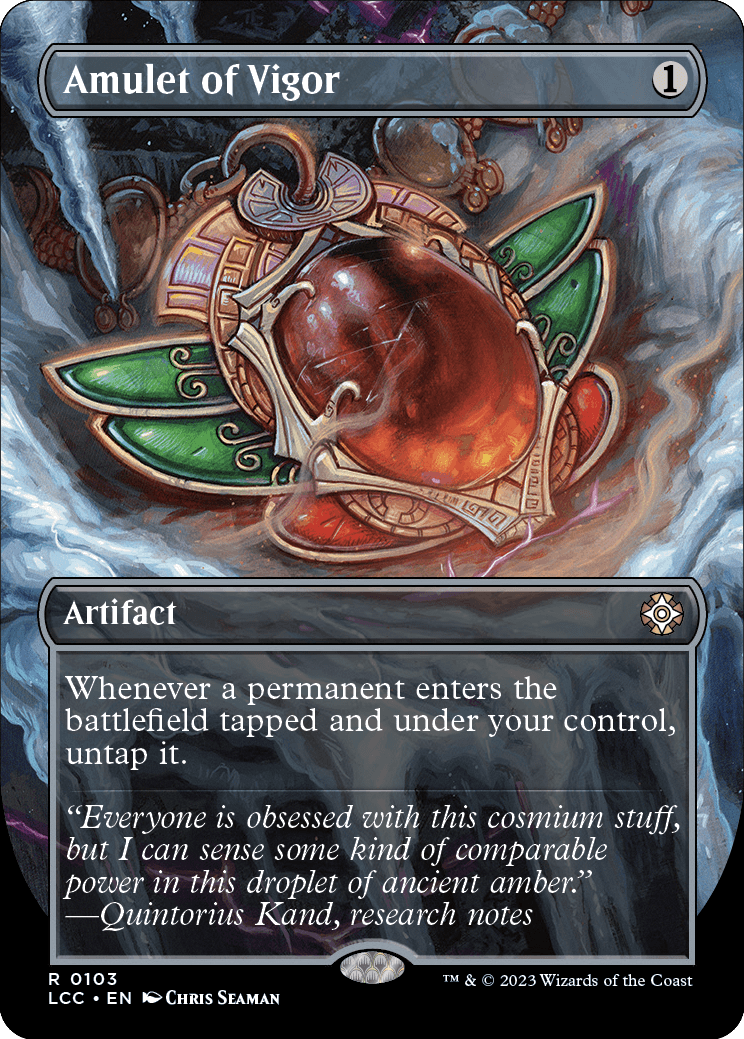
Amulet of Vigor
Artifact
Whenever a permanent enters the battlefield tapped and under your control, untap it.
- If you control more than one Amulet of Vigor, each Amulet's ability triggers when a permanent enters the battlefield tapped and under your control. The first ability that resolves will untap that permanent. If the permanent somehow becomes tapped again before the next ability resolves, the next ability will untap it as well, and so on.
- For Amulet of Vigor's ability to trigger, a permanent must enter the battlefield tapped due to an effect that says "put [the permanent] onto the battlefield tapped," "[this permanent] enters the battlefield tapped," or the like. If it enters the battlefield untapped, the ability won't trigger, even if you tap that permanent afterward.
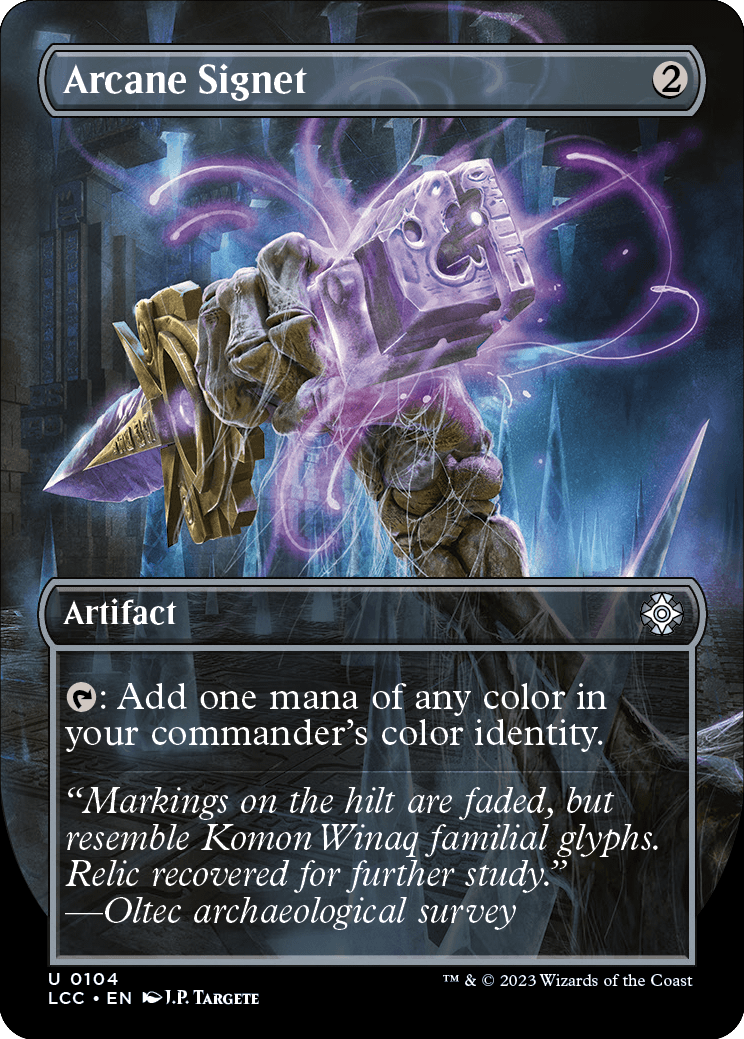
Arcane Signet
Artifact
: Add one mana of any color in your commander's color identity.
- If you have two commanders, the ability adds one mana of any color in their combined color identities.
- If your commander is a card that has no colors in its color identity, Arcane Signet's ability produces no mana. It doesn't produce .
- If you don't have a commander, Arcane Signet's ability produces no mana.
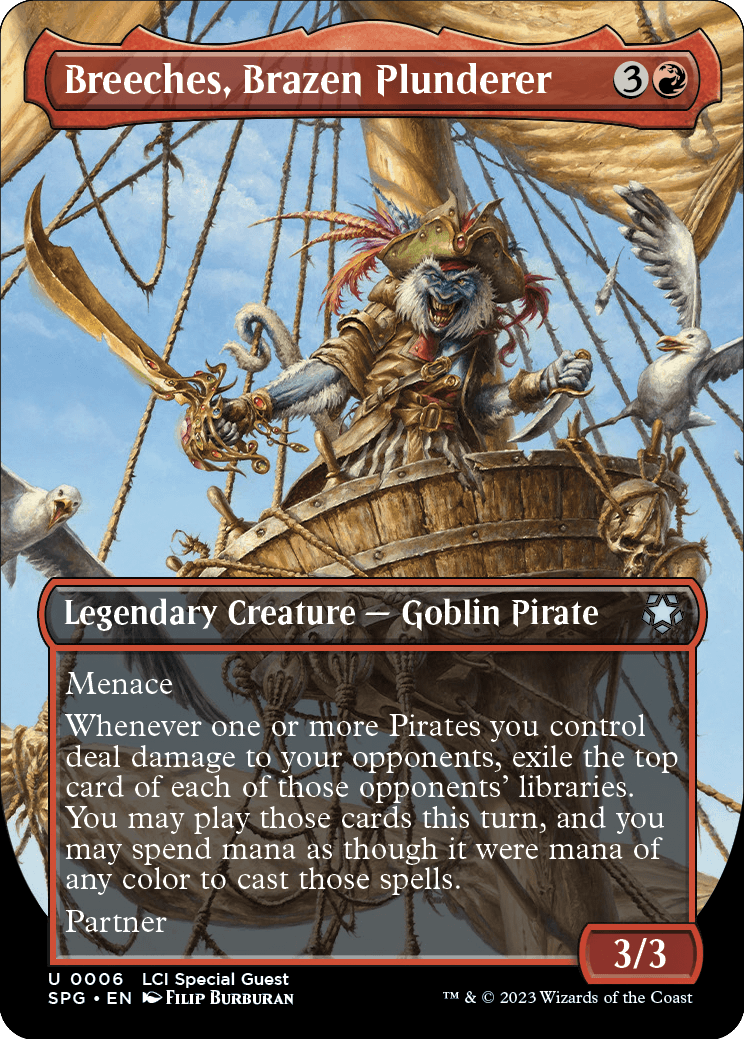
Breeches, Brazen Plunderer
Legendary Creature — Goblin Pirate
3/3
Menace
Whenever one or more Pirates you control deal damage to your opponents, exile the top card of each of those opponents' libraries. You may play those cards this turn, and you may spend mana as though it were mana of any color to cast those spells.
Partner
- You'll exile a card from each opponent who was dealt damage, not from all of your opponents.
- You must follow the normal timing permissions and restrictions for each exiled card. If one is a land, you can't play it unless you have land plays available.
- You'll still pay all costs for a spell cast this way, including additional costs. You may also pay alternative costs if any are available.
- If you don't play one of the exiled cards, it remains exiled. It won't be available to be played on future turns.
- In a multiplayer game, if a player leaves the game, all cards that player owns leave as well. If you leave the game, any spells and/or permanents you control from Breeches's brazen thievery are exiled.
- If your Commander deck has two commanders, you can only include cards whose own color identities are also found in your commanders' combined color identities.
- Both commanders start in the command zone, and the remaining 98 cards (or 58 cards in a Commander Draft game) of your deck are shuffled to become your library.
- To have two commanders, both must have the partner ability as the game begins. Losing the ability during the game doesn't cause either to cease to be your commander.
- Once the game begins, your two commanders are tracked separately. If you cast one, you won't have to pay an additional the first time you cast the other. A player loses the game after having been dealt 21 damage from any one of them, not from both of them combined.
- If something refers to your commander while you have two commanders, it refers to one of them of your choice. If you are instructed to perform an action on your commander (e.g. put it from the command zone into your hand due to Command Beacon), you choose one of your commanders at the time the effect happens.
- An effect that checks whether you control your commander is satisfied if you control one or both of your two commanders.
- You can choose two commanders with partner that are the same color or colors. In Commander Draft, you can even choose two of the same commander with partner if you drafted them. If you do this, make sure you keep the number of times you've cast each from the command zone clear for "commander tax" purposes.
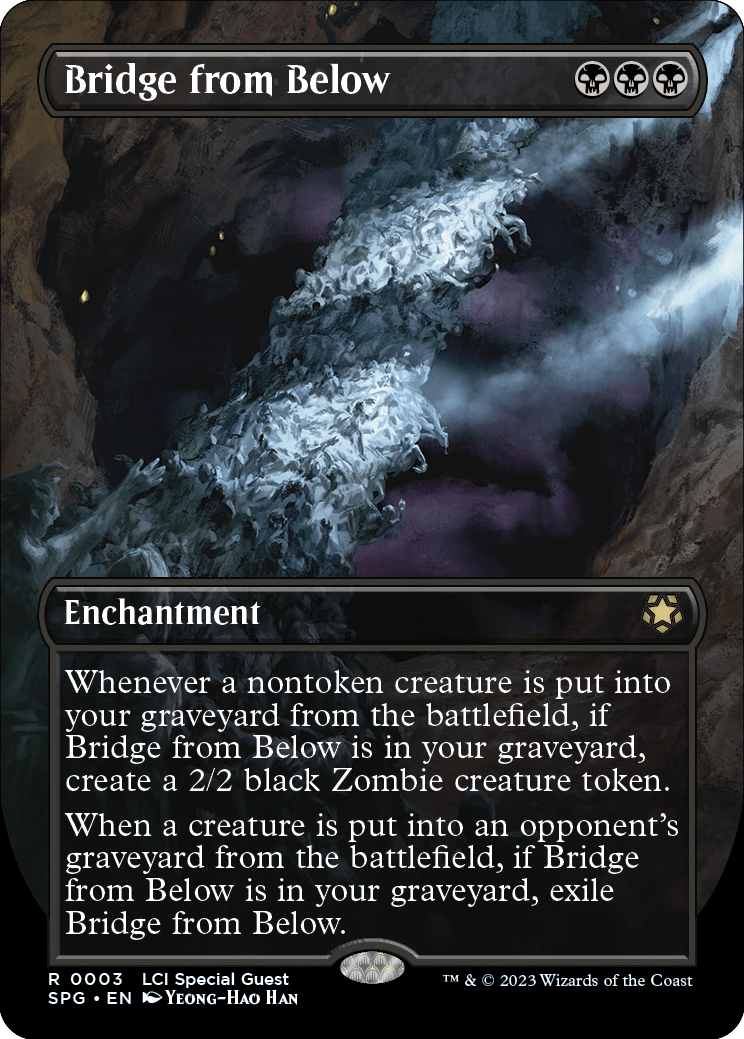
Bridge from Below
Enchantment
Whenever a nontoken creature is put into your graveyard from the battlefield, if Bridge from Below is in your graveyard, create a 2/2 black Zombie creature token.
When a creature is put into an opponent's graveyard from the battlefield, if Bridge from Below is in your graveyard, exile Bridge from Below.
- While Bridge from Below is on the battlefield, it has no effect. It does something only if it's in a graveyard. Yes, this is (still) a bit weird.
- Neither ability cares who controlled the creature that died, only which graveyard it was put into. This means that if an opponent controls a creature you own, its death causes Bridge from Below's first ability to trigger, not its second.
- If Bridge from Below isn't in your graveyard immediately before a creature dies, its abilities won't trigger at all. If Bridge from Below isn't still in your graveyard as its first ability resolves, you won't create a token.
- If a nontoken creature you control and a creature an opponent controls die at the same time, you choose the order in which Bridge from Below's triggered abilities resolve. You can create a token before you exile Bridge from Below.
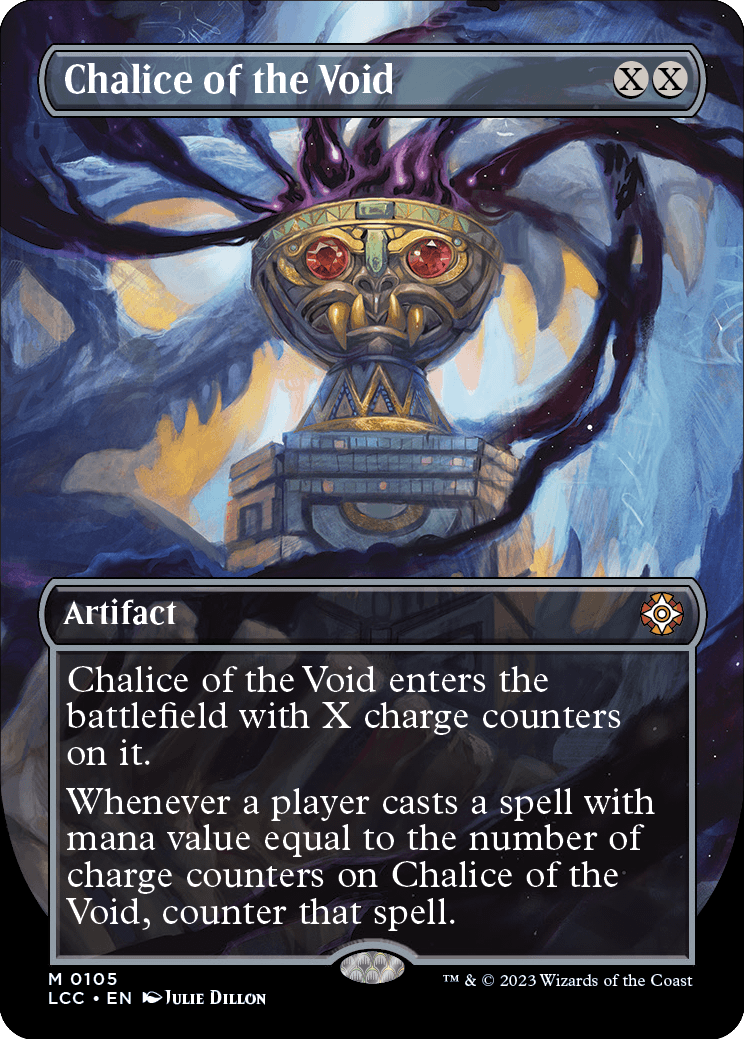
Chalice of the Void
Artifact
Chalice of the Void enters the battlefield with X charge counters on it.
Whenever a player casts a spell with mana value equal to the number of charge counters on Chalice of the Void, counter that spell.
- A mana cost of means that you pay twice X. For example, if you want X to be 3, you pay to cast Chalice of the Void.
- The number of charge counters on Chalice of the Void matters only at the time the spell is cast. Changing the number of charge counters on Chalice of the Void after a spell has been cast won't change whether the ability triggers or counters the spell.
- If there are zero charge counters on Chalice of the Void, it counters each spell with a mana value of 0. This includes face-down creature spells cast with morph's alternative cost.
- Chalice of the Void has to be on the battlefield at the end of casting a spell for the ability to trigger. If you sacrifice Chalice of the Void as a cost to cast a spell, its ability can't trigger. However, if it leaves the battlefield once its ability has triggered, that ability will still counter the spell.
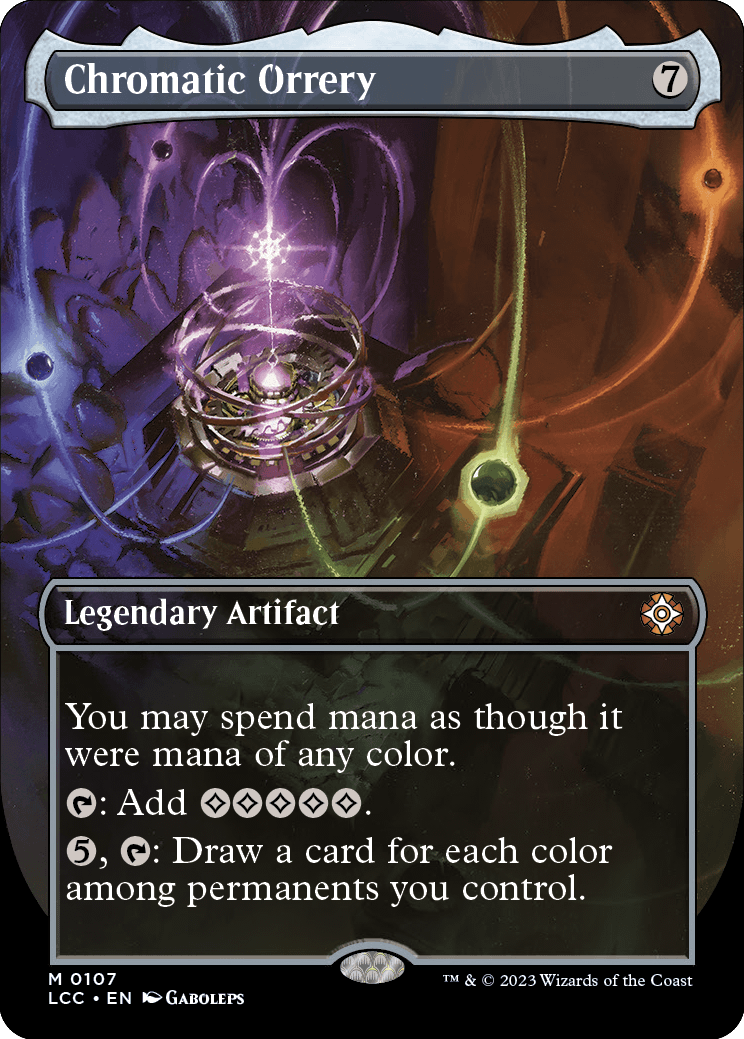
Chromatic Orrery
Legendary Artifact
You may spend mana as though it were mana of any color.
: Add .
, : Draw a card for each color among permanents you control.
- Chromatic Orrery's last ability can have you draw at most five cards. "Colorless," "artifact," and "gold" are not colors.
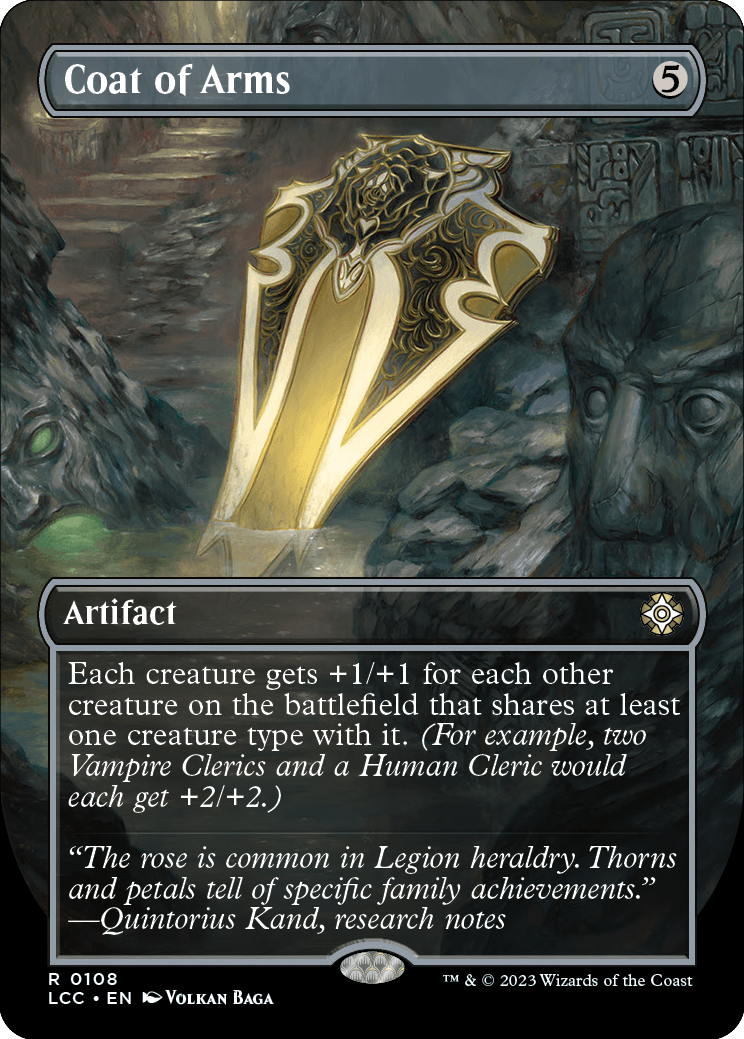
Coat of Arms
Artifact
Each creature gets +1/+1 for each other creature on the battlefield that shares at least one creature type with it. (For example, two Vampire Clerics and a Human Cleric would each get +2/+2.)
- If a creature has more than one creature type, and one of those types matches the creature you are calculating for, then count that creature. Only one type needs to match in order to get counted.
- If you have a creature with more than one creature type, count all creatures which have either creature type.
- Sharing multiple creature types doesn't give an additional bonus. Coat of Arms counts creatures, not creature types.
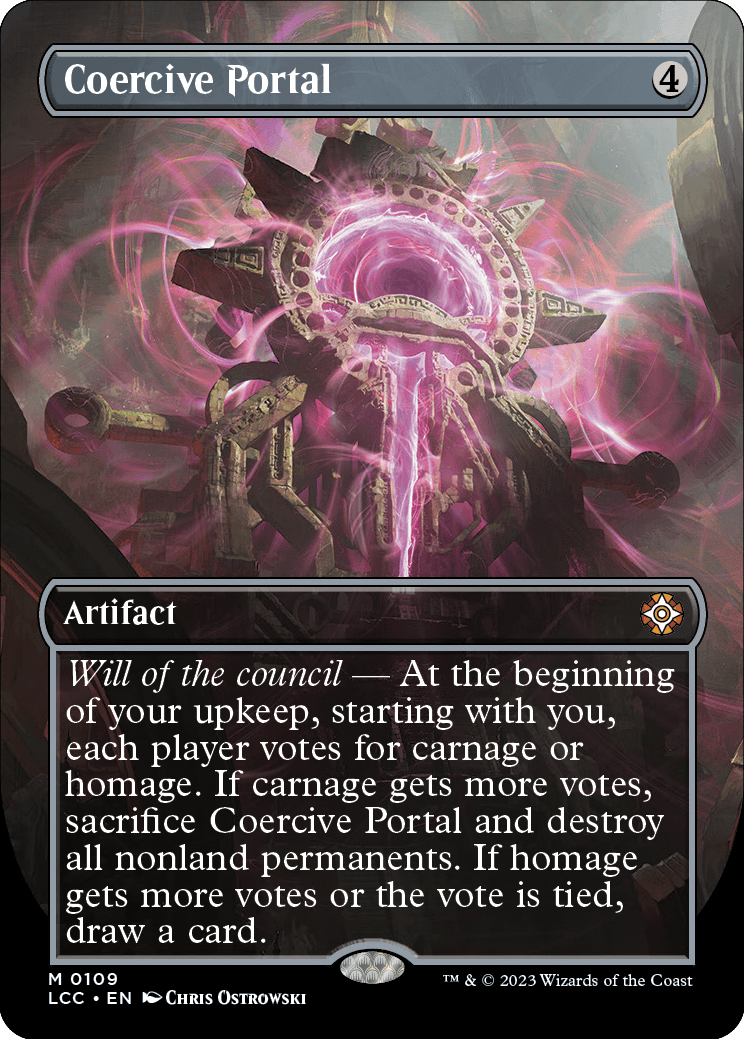
Coercive Portal
Artifact
Will of the council — At the beginning of your upkeep, starting with you, each player votes for carnage or homage. If carnage gets more votes, sacrifice Coercive Portal and destroy all nonland permanents. If homage gets more votes or the vote is tied, draw a card.
- Because the votes are cast in turn order, each player will know the votes of players who voted beforehand.
- You must vote for one of the available options. You can't abstain.
- No player votes until the spell or ability resolves. Any responses to that spell or ability must be made without knowing the outcome of the vote.
- Players can't do anything after they finish voting but before the spell or ability that included the vote finishes resolving.
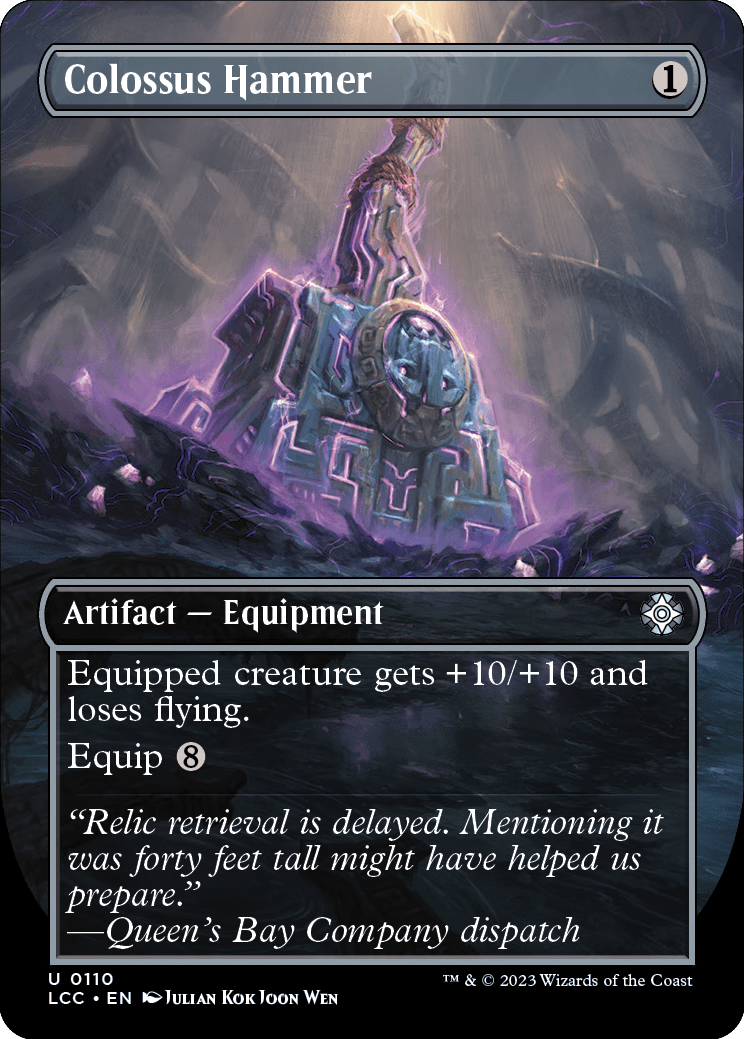
Colossus Hammer
Artifact — Equipment
Equipped creature gets +10/+10 and loses flying.
Equip
- Colossus Hammer can be attached to a creature that didn't have flying to begin with. It just won't lose flying.
- If the equipped creature gains flying after Colossus Hammer became attached to it, it will keep flying.
- If an ability of the equipped creature states that it has flying "as long as" a particular condition is true, that condition becoming true will not cause that creature to gain flying. For example, if the equipped creature "has flying as long as it's attacking," it will not gain flying, even if it attacks after Colossus Hammer becomes attached to it.
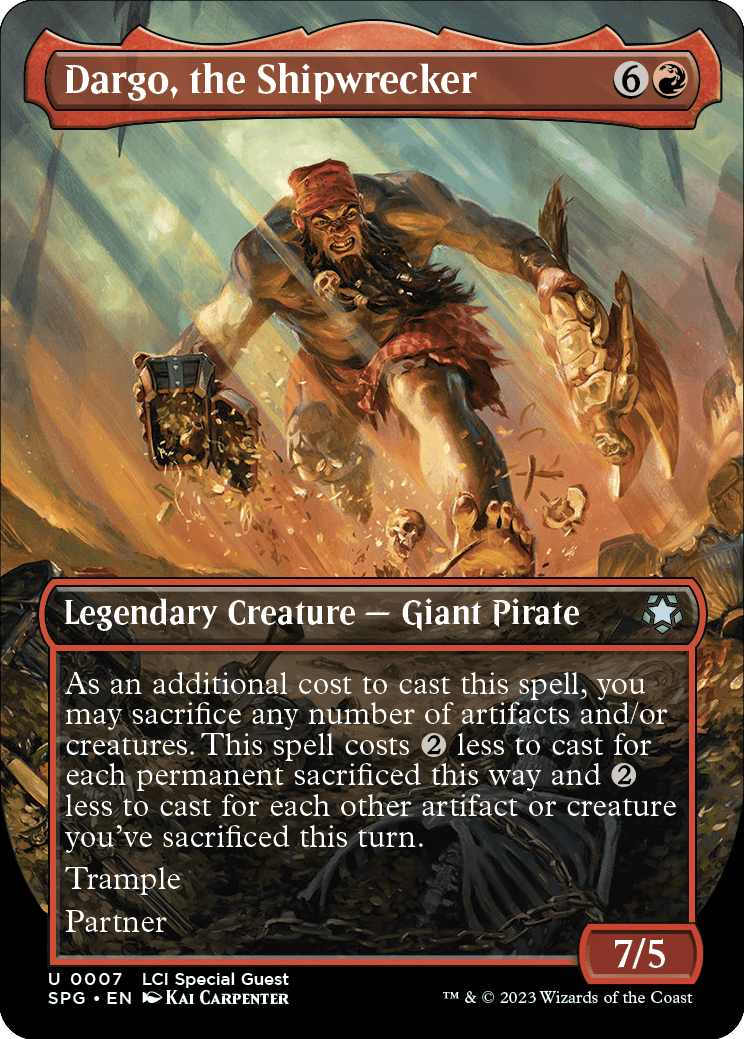
Dargo, the Shipwrecker
Legendary Creature — Giant Pirate
7/5
As an additional cost to cast this spell, you may sacrifice any number of artifacts and/or creatures. This spell costs less to cast for each permanent sacrificed this way and less to cast for each other artifact or creature you've sacrificed this turn.
Trample
Partner
- Dargo's first ability can't reduce its cost below . You can sacrifice any number of artifacts and creatures, even if they won't reduce Dargo's cost any further.
- The cost reduction for artifacts and creatures sacrificed earlier in the turn will apply even if you don't sacrifice any as an additional cost.
- The cost reduction is per sacrificed permanent, whether that permanent was an artifact, a creature, or both.
- To determine the total cost of a spell, start with the mana cost or alternative cost you're paying, add any cost increases (such as the commander tax), then apply any cost reductions (such as that of Dargo's first ability). Dargo's mana value is 7, no matter what the total cost to cast it was.
- If your Commander deck has two commanders, you can only include cards whose own color identities are also found in your commanders' combined color identities.
- Both commanders start in the command zone, and the remaining 98 cards (or 58 cards in a Commander Draft game) of your deck are shuffled to become your library.
- To have two commanders, both must have the partner ability as the game begins. Losing the ability during the game doesn't cause either to cease to be your commander.
- Once the game begins, your two commanders are tracked separately. If you cast one, you won't have to pay an additional the first time you cast the other. A player loses the game after having been dealt 21 damage from any one of them, not from both of them combined.
- If something refers to your commander while you have two commanders, it refers to one of them of your choice. If you are instructed to perform an action on your commander (e.g. put it from the command zone into your hand due to Command Beacon), you choose one of your commanders at the time the effect happens.
- An effect that checks whether you control your commander is satisfied if you control one or both of your two commanders.
- You can choose two commanders with partner that are the same color or colors. In Commander Draft, you can even choose two of the same commander with partner if you drafted them. If you do this, make sure you keep the number of times you've cast each from the command zone clear for "commander tax" purposes.
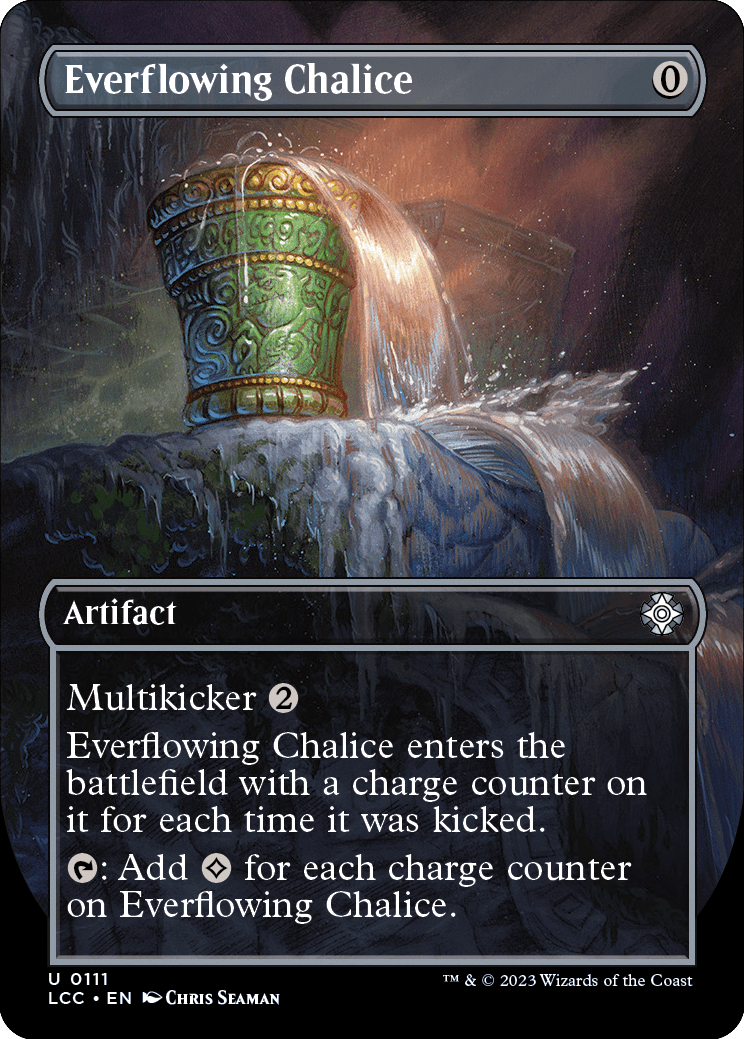
Everflowing Chalice
Artifact
Multikicker
Everflowing Chalice enters the battlefield with a charge counter on it for each time it was kicked.
: Add for each charge counter on Everflowing Chalice.
- You can cast Everflowing Chalice without kicking it at all if you wish. However, if Everflowing Chalice has no charge counters on it, activating its last ability won't produce any mana.
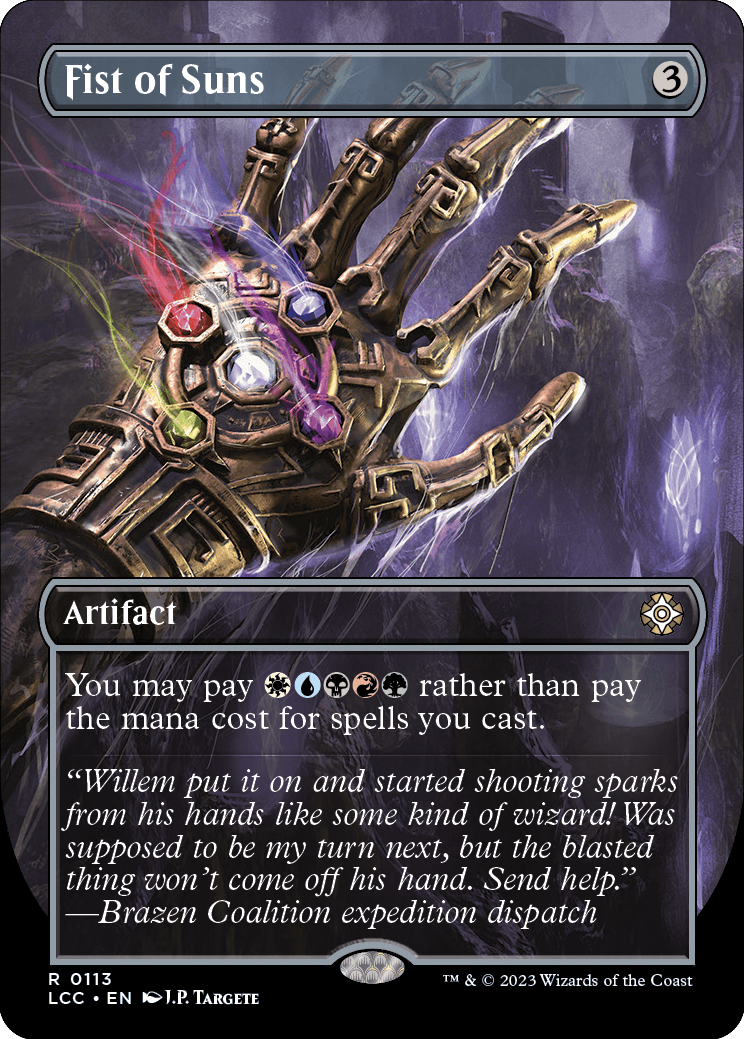
Fist of Suns
Artifact
You may pay rather than pay the mana cost for spells you cast.
- Fist of Suns's ability is an alternative cost to cast a spell. You can't combine this with other alternative costs, such as flashback. You can pay additional costs, such as kicker, in addition to this alternative cost.
- If you apply Fist of Suns's alternative cost to a spell with in its mana cost, X is 0.
- If you cast a spell for which mana of any color can be spent to cast it, you may cast it for Fist of Suns's alternative cost and still spend any color of mana to cover that cost.
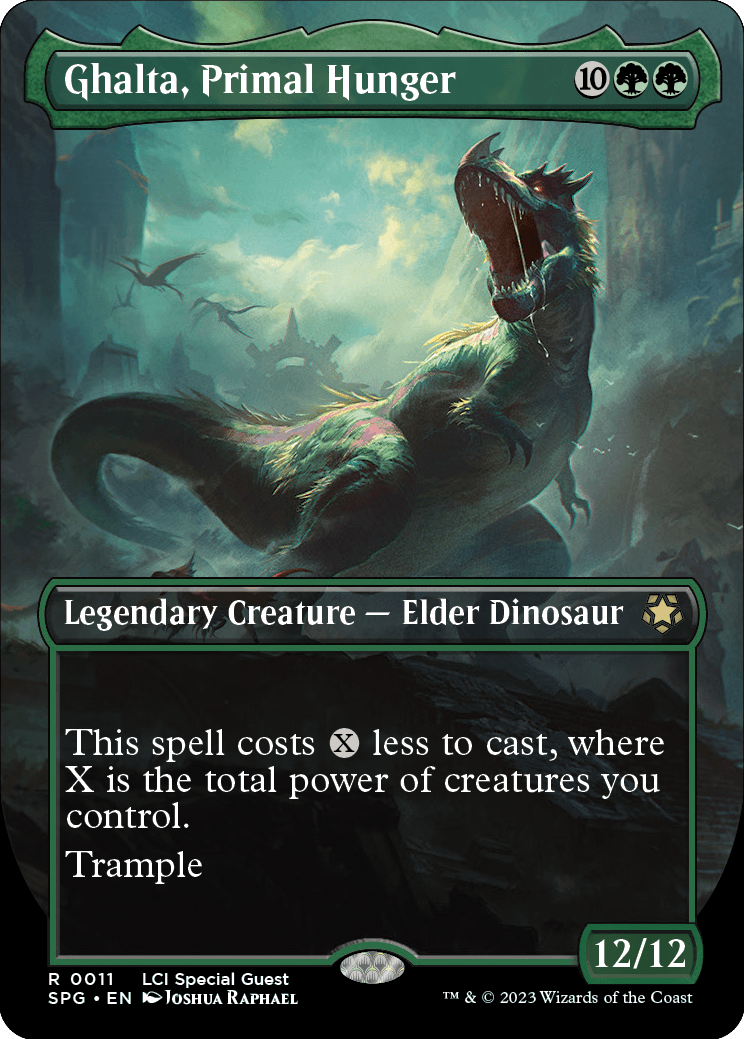
Ghalta, Primal Hunger
Legendary Creature — Elder Dinosaur
12/12
This spell costs less to cast, where X is the total power of creatures you control.
Trample
- To determine Ghalta's total cost, start with the mana cost (or an alternative cost if another card's effect allows you to pay one instead), add any cost increases, then apply any cost reductions. Ghalta's mana value remains unchanged, no matter what the total cost to cast it was.
- The total cost to cast Ghalta is locked in before you pay that cost. For example, if you control three 2/2 creatures, including one you can sacrifice to add to your mana pool, the total cost of Ghalta is . Then you can sacrifice the creature when you activate mana abilities just before paying the cost.
- If a creature's power is somehow less than 0, it subtracts from the total power of your other creatures. If the total power of your creatures is 0 or less, Ghalta's cost remains .
- Ghalta's first ability can't reduce its cost below .
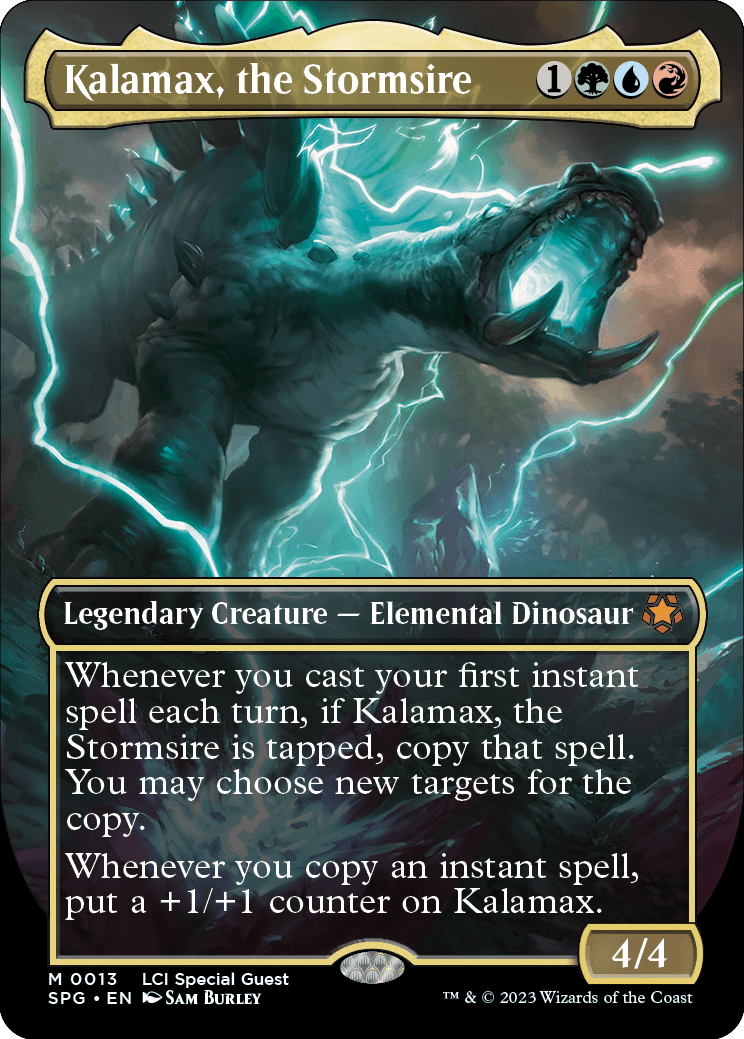
Kalamax, the Stormsire
Legendary Creature — Elemental Dinosaur
4/4
Whenever you cast your first instant spell each turn, if Kalamax, the Stormsire is tapped, copy that spell. You may choose new targets for the copy.
Whenever you copy an instant spell, put a +1/+1 counter on Kalamax.
- If Kalamax becomes tapped as a cost to cast your first instant spell in a turn, its first ability triggers.
- Kalamax's first ability considers the entire turn. If you cast an instant spell before Kalamax becomes tapped, its first ability won't trigger when you cast your second.
- A copy is created even if the spell that caused Kalamax's ability to trigger has been countered by the time that ability resolves. The copy resolves before the original spell.
- If the spell that's copied is modal (that is, it says "Choose one —" or the like), the copy created by Kalamax's first ability will have the same mode or modes. You can't choose different ones.
- If the spell that's copied has damage divided as it was cast, the division can't be changed, although the targets receiving that damage still can. The same is true of spells that distribute counters.
- You can't choose to pay any additional costs for the copy created by Kalamax's first ability. However, effects based on any additional costs that were paid for the original spell are copied as though those same costs were paid for the copy too.
- The copies that Kalamax's first ability creates are created on the stack, so they're not "cast." Abilities that trigger when a player casts a spell won't trigger.
- An ability that triggers when a player copies a spell resolves before the copy. It resolves even if that spell is countered.
- If an effect copies an instant spell multiple times, Kalamax's last ability triggers that many times.
- If an effect copies a card rather than a spell (such as that of God-Eternal Kefnet), this doesn't cause Kalamax's last ability to trigger.
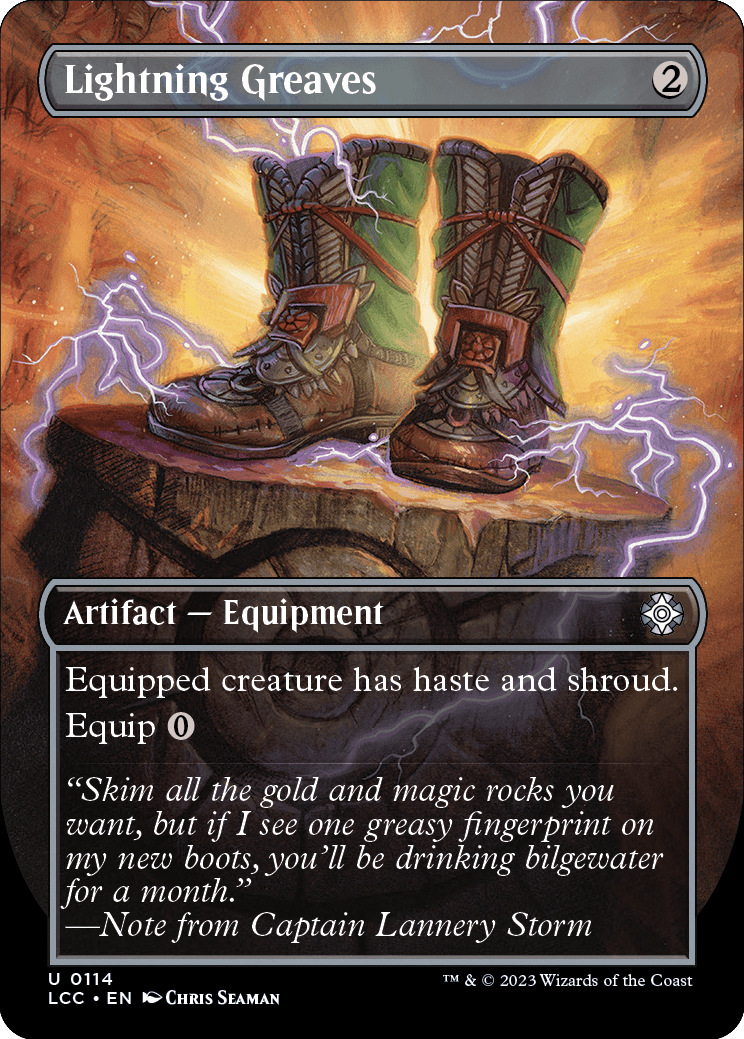
Lightning Greaves
Artifact — Equipment
Equipped creature has haste and shroud.
Equip
- You can't simply unequip Equipment from a creature. If Lightning Greaves is attached to the only creature you control, you won't be able to attach other Equipment to it (or target it with anything else) until you have another creature onto which you can move Lightning Greaves.
- If a creature enters the battlefield under your control and gains haste, but then loses it before attacking, it won't be able to attack that turn. This means that you can't use one Lightning Greaves to allow two new creatures to attack in the same turn.
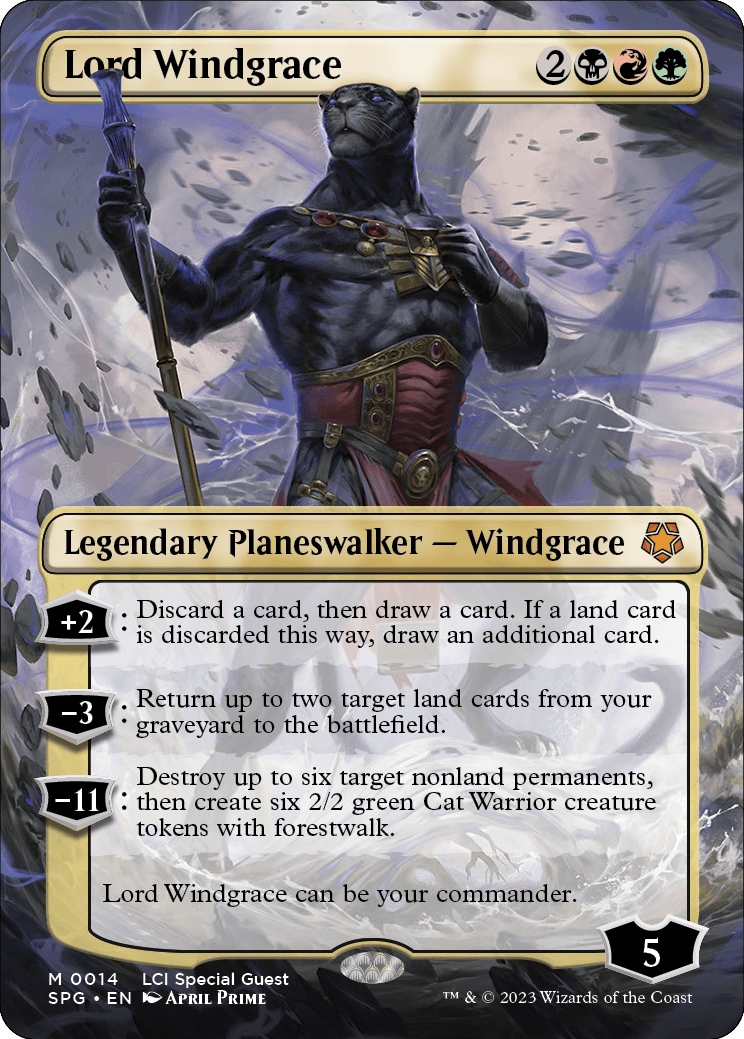
Lord Windgrace
Legendary Planeswalker — Windgrace
5
+2: Discard a card, then draw a card. If a land card is discarded this way, draw an additional card.
−3: Return up to two target land cards from your graveyard to the battlefield.
−11: Destroy up to six target nonland permanents, then create six 2/2 green Cat Warrior creature tokens with forestwalk.
Lord Windgrace can be your commander.
- If you have no cards in hand as Lord Windgrace's first ability resolves, you'll discard nothing then you'll draw one card.
- While resolving Lord Windgrace's last loyalty ability, you create six Cat Warrior tokens even if fewer than six nonland permanents are destroyed. However, if you choose any targets for the ability and each of them becomes an illegal target, the ability doesn't resolve and you don't create any tokens.
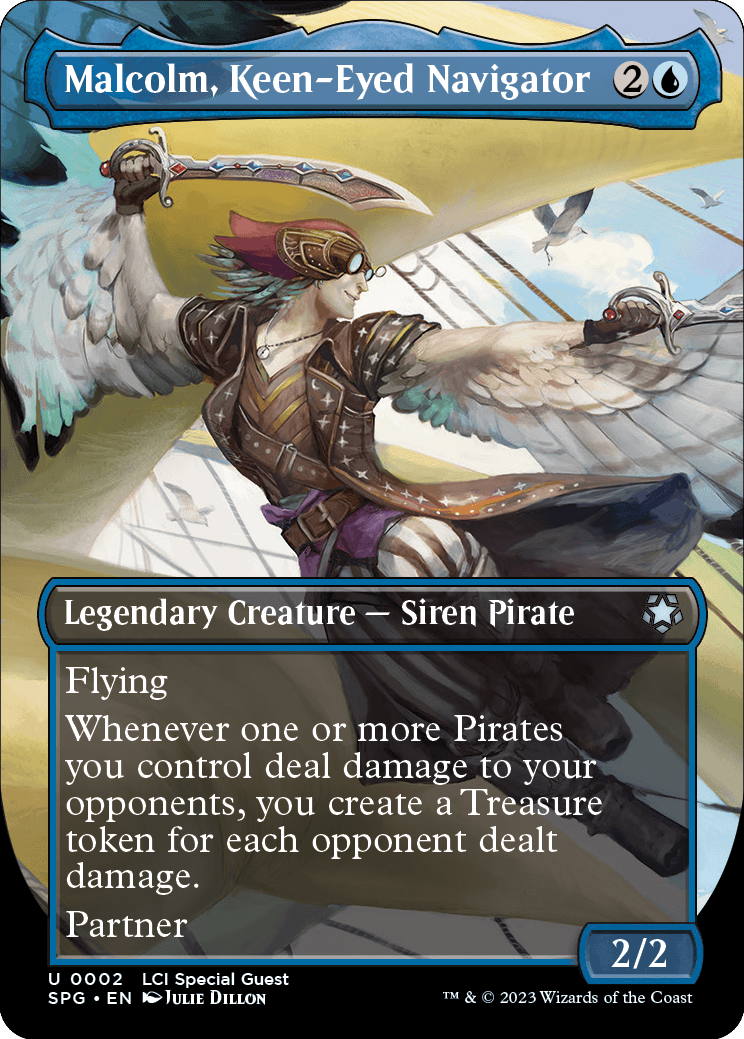
Malcolm, Keen-Eyed Navigator
Legendary Creature — Siren Pirate
2/2
Flying
Whenever one or more Pirates you control deal damage to your opponents, you create a Treasure token for each opponent dealt damage.
Partner
- Malcolm's triggered ability will trigger even if Pirates you control deal damage to only a single opponent. A single Treasure for you. Yarrr.
- Malcolm's triggered ability considers all damage dealt by Pirates you control to opponents, not just combat damage.
- If your Commander deck has two commanders, you can only include cards whose own color identities are also found in your commanders' combined color identities.
- Both commanders start in the command zone, and the remaining 98 cards (or 58 cards in a Commander Draft game) of your deck are shuffled to become your library.
- To have two commanders, both must have the partner ability as the game begins. Losing the ability during the game doesn't cause either to cease to be your commander.
- Once the game begins, your two commanders are tracked separately. If you cast one, you won't have to pay an additional the first time you cast the other. A player loses the game after having been dealt 21 damage from any one of them, not from both of them combined.
- If something refers to your commander while you have two commanders, it refers to one of them of your choice. If you are instructed to perform an action on your commander (e.g. put it from the command zone into your hand due to Command Beacon), you choose one of your commanders at the time the effect happens.
- An effect that checks whether you control your commander is satisfied if you control one or both of your two commanders.
- You can choose two commanders with partner that are the same color or colors. In Commander Draft, you can even choose two of the same commander with partner if you drafted them. If you do this, make sure you keep the number of times you've cast each from the command zone clear for "commander tax" purposes.
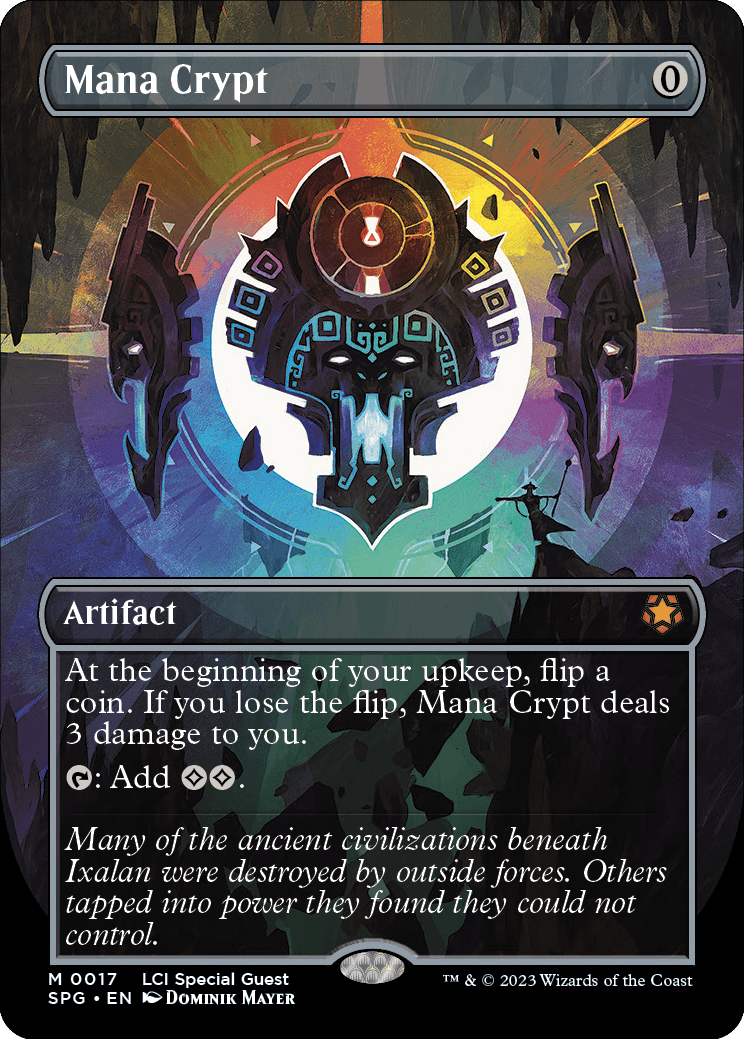
Mana Crypt
Artifact
At the beginning of your upkeep, flip a coin. If you lose the flip, Mana Crypt deals 3 damage to you.
: Add .
- No player may choose to take actions between determining the result of the flip and damage being dealt if you lost the flip.
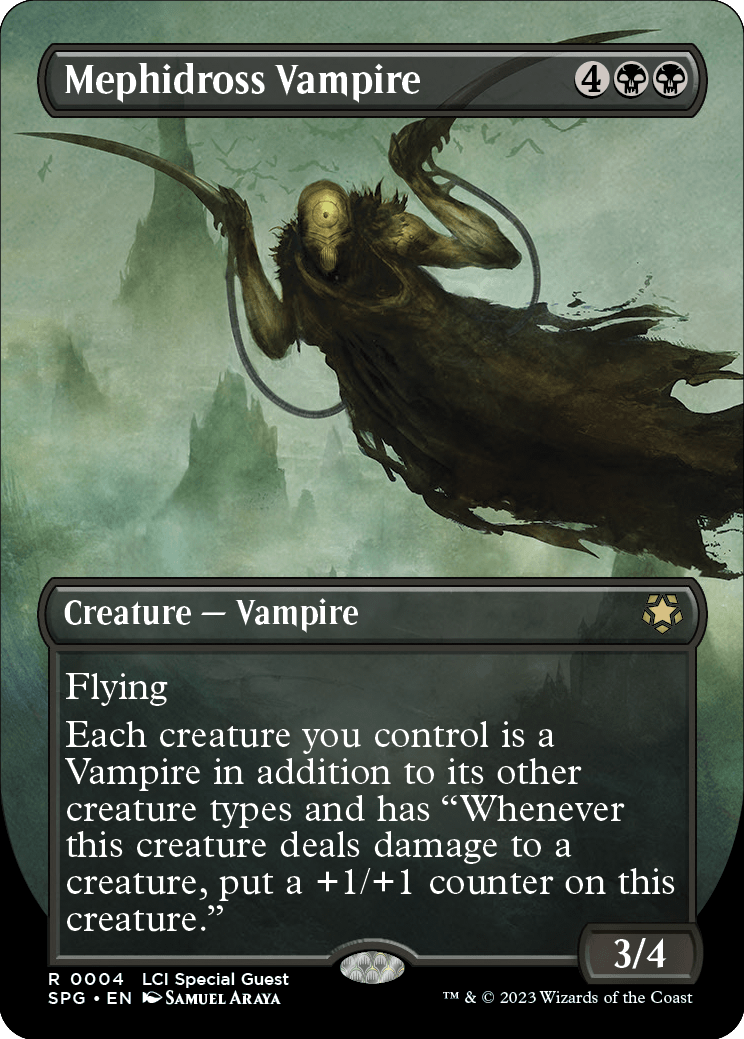
Mephidross Vampire
Creature — Vampire
3/4
Flying
Each creature you control is a Vampire in addition to its other creature types and has "Whenever this creature deals damage to a creature, put a +1/+1 counter on this creature."
- The triggered ability Mephidross Vampire grants to each creature you control triggers on any damage dealt to any creature, not just combat damage.
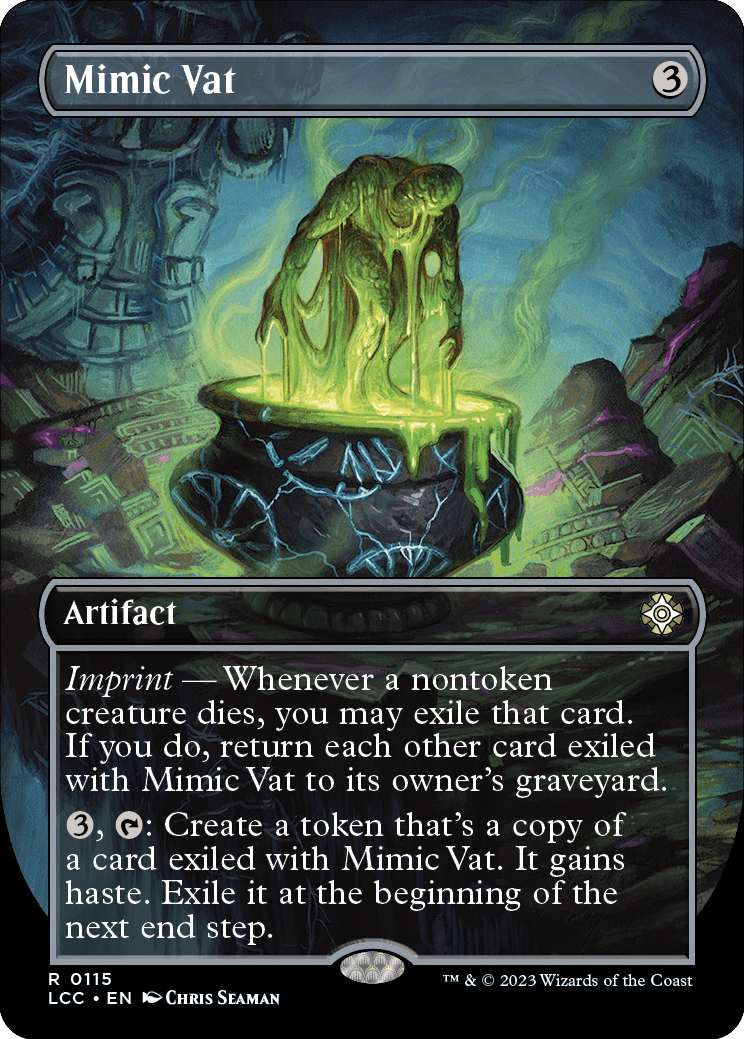
Mimic Vat
Artifact
Imprint — Whenever a nontoken creature dies, you may exile that card. If you do, return each other card exiled with Mimic Vat to its owner's graveyard.
, : Create a token that's a copy of a card exiled with Mimic Vat. It gains haste. Exile it at the beginning of the next end step.
- The imprint ability will trigger whenever a nontoken creature is put into any graveyard from the battlefield, not just your graveyard.
- Exiling the card as the first ability resolves is optional. If you choose not to exile it, or you can't exile it because the card has somehow left the graveyard before the ability resolves, the ability simply doesn't do anything as it resolves. Any card currently exiled by Mimic Vat remains exiled.
- If multiple nontoken creatures are put into their owners' graveyards from the battlefield at the same time, the imprint ability will trigger that many times. You put the triggered abilities on the stack in any order, so you'll determine in which order they resolve. However, since exiling those cards is optional, and choosing to exile a card this way causes the previously exiled cards to return to their owners' graveyards, the order generally doesn't matter: You'll wind up with at most one of those cards exiled, and the rest will be in the appropriate graveyards.
- You may exile a noncreature card with Mimic Vat's first ability. For example, if a nontoken artifact that's become a creature is put into a graveyard from the battlefield, Mimic Vat's first ability triggers and you may exile that card.
- The token created by the second ability will be a copy of whatever card is exiled with Mimic Vat at the time the ability resolves. This might not be the same card that was exiled with Mimic Vat at the time the ability was activated. It also might not be a creature card.
- If the token is a copy of a noncreature card, it will still have haste, though that won't matter unless that token somehow becomes a creature.
- You may activate the second ability even if no card has been exiled with Mimic Vat. If no card has been exiled with Mimic Vat by the time the ability resolves, no token will be created.
- If the exiled card has in its mana cost, X is 0.
- Any enters-the-battlefield abilities of the exiled card will trigger when the token is put onto the battlefield. Any "as [this permanent] enters the battlefield" or "[this permanent] enters the battlefield with" abilities of the exiled card will also work.
- The token is exiled at the beginning of the next end step regardless of who controls it at that time, whether the exiled card is still exiled at that time, or whether Mimic Vat is still on the battlefield at that time.
- If Mimic Vat's second ability is activated during a turn's end step, the token will be exiled at the beginning of the following turn's end step.
- If the token isn't exiled when the delayed triggered ability resolves (due to Stifle, perhaps), it remains on the battlefield indefinitely. It continues to have haste.
- If a melded permanent dies and triggers Mimic Vat's triggered ability, both of its component cards are exiled. As Mimic Vat's second ability resolves, its controller chooses one of those cards to make a token copy of.
- If the creature that dies is an instant or sorcery card that's been manifested, Mimic Vat may have a nonpermanent card exiled. You can't create a token that's a copy of a nonpermanent card. No token is created in this case.
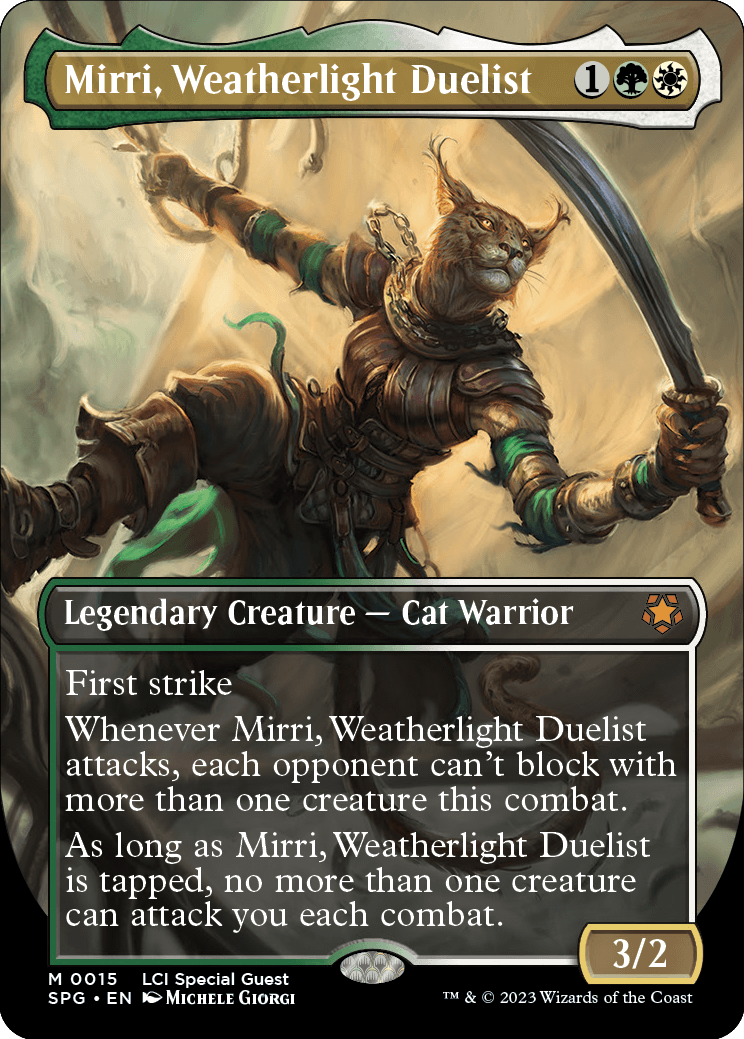
Mirri, Weatherlight Duelist
Legendary Creature — Cat Warrior
3/2
First strike
Whenever Mirri, Weatherlight Duelist attacks, each opponent can't block with more than one creature this combat.
As long as Mirri, Weatherlight Duelist is tapped, no more than one creature can attack you each combat.
- Tapping Mirri after creatures have attacked will not remove creatures from combat.
- While Mirri is tapped, there's no restriction on how many creatures can attack planeswalkers you control or battles you protect.
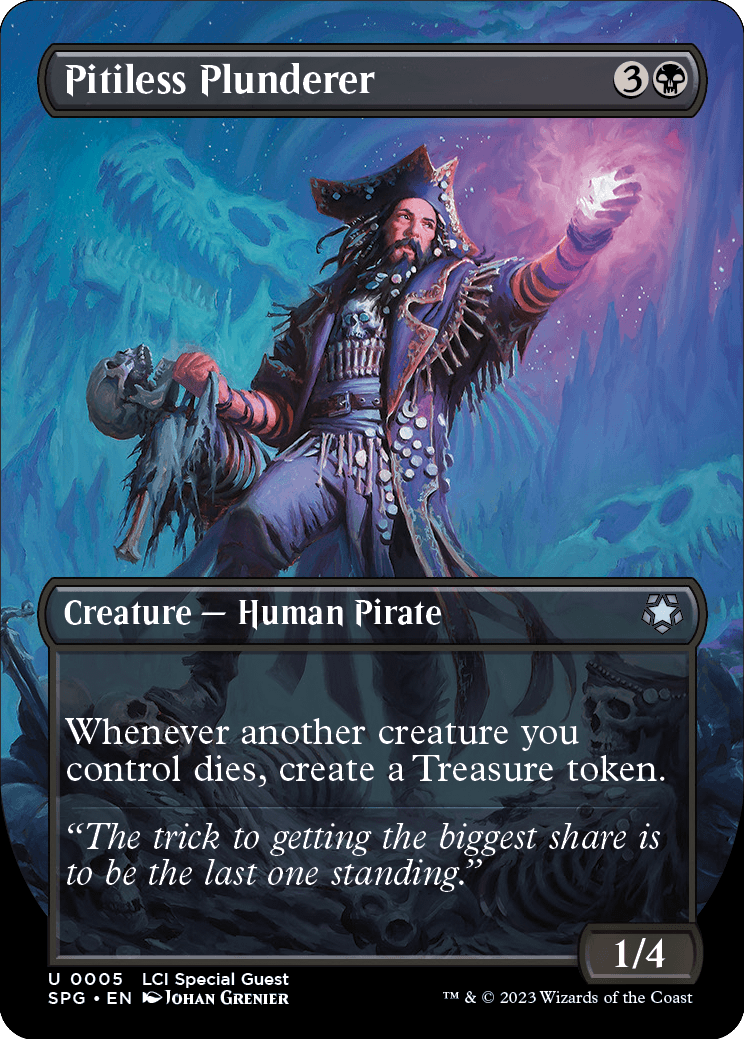
Pitiless Plunderer
Creature — Human Pirate
1/4
Whenever another creature you control dies, create a Treasure token.
- If another creature you control dies at the same time as Pitiless Plunderer does, you'll get a Treasure.
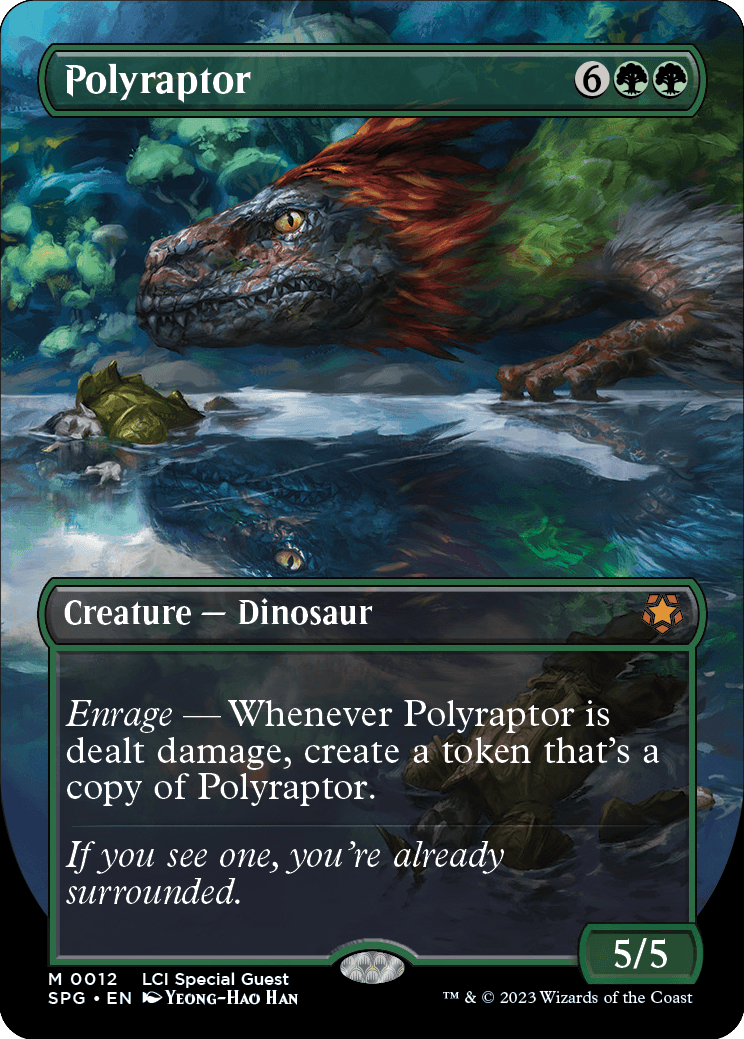
Polyraptor
Creature — Dinosaur
5/5
Enrage — Whenever Polyraptor is dealt damage, create a token that's a copy of Polyraptor.
- The token will have Polyraptor's ability. It will also be able to create copies of itself.
- The token won't copy counters or damage marked on Polyraptor, nor will it copy other effects that have changed Polyraptor's power, toughness, types, color, or so on. Normally, this means the token will simply be a Polyraptor. But if any copy effects have affected that Polyraptor, they're taken into account.
- If Polyraptor leaves the battlefield before its triggered ability resolves, most likely because it was dealt lethal damage, the token will still enter the battlefield as a copy of Polyraptor, using Polyraptor's copiable values from when it was last on the battlefield.
- If multiple sources deal damage to a creature with an enrage ability at the same time, most likely because multiple creatures blocked that creature, the enrage ability triggers only once.
- If lethal damage is dealt to a creature with an enrage ability, that ability triggers.
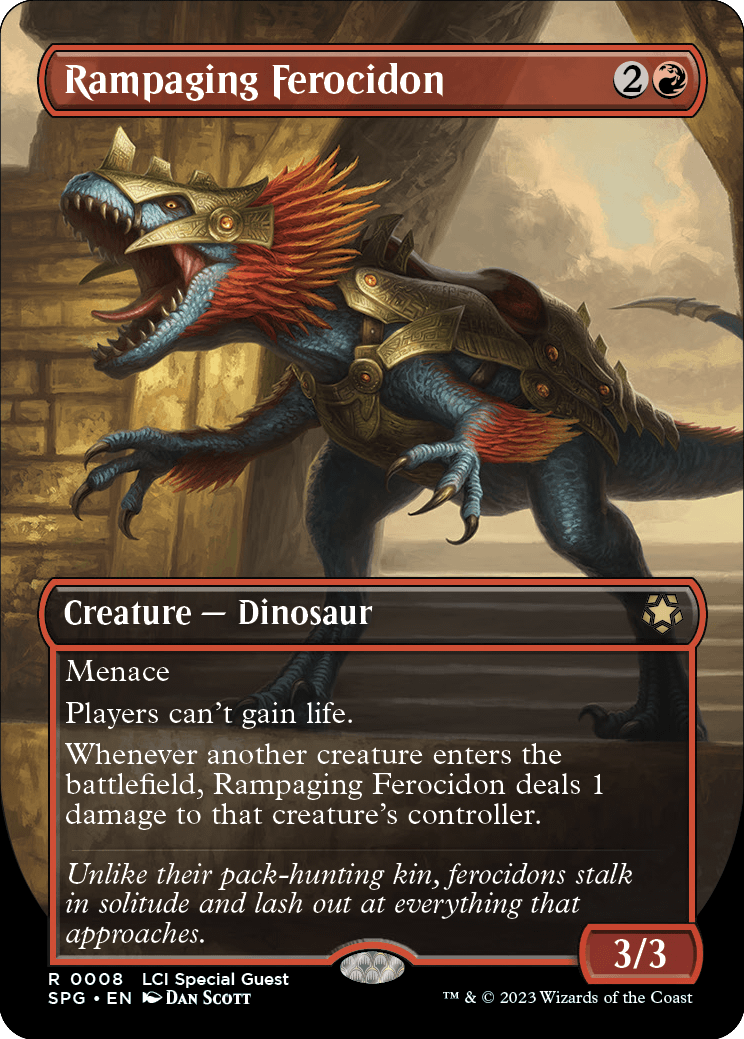
Rampaging Ferocidon
Creature — Dinosaur
3/3
Menace
Players can't gain life.
Whenever another creature enters the battlefield, Rampaging Ferocidon deals 1 damage to that creature's controller.
- Spells and abilities that cause players to gain life still resolve while Rampaging Ferocidon is on the battlefield. No player will gain life, but any other effects of that spell or ability will happen.
- If an effect says to set a player's life total to a number that's higher than the player's current life total while Rampaging Ferocidon is on the battlefield, the player's life total doesn't change.
- Rampaging Ferocidon's last ability triggers whenever any player has a creature enter the battlefield, including you.
- If another creature enters the battlefield at the same time as Rampaging Ferocidon, its last ability triggers.
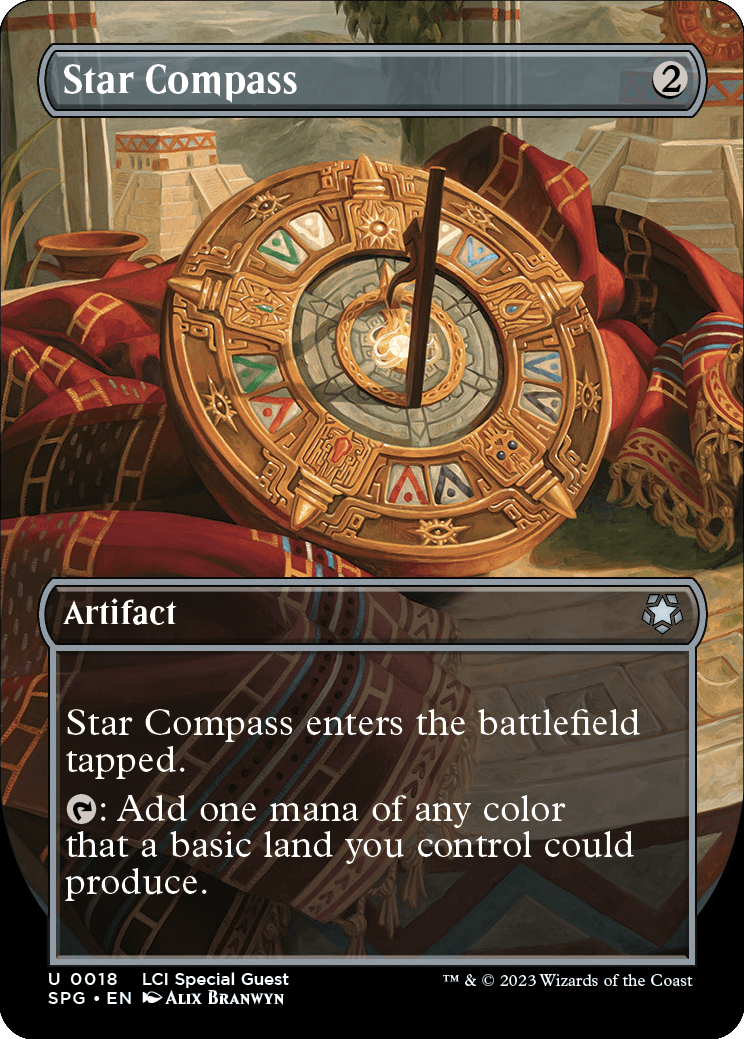
Star Compass
Artifact
Star Compass enters the battlefield tapped.
: Add one mana of any color that a basic land you control could produce.
- If a basic land you control gains another basic land type or gains another ability that lets it produce mana, consider those effects when determining what colors of mana that land can produce.
- The colors of mana are white, blue, black, red, and green. Colorless is a type but not a color.
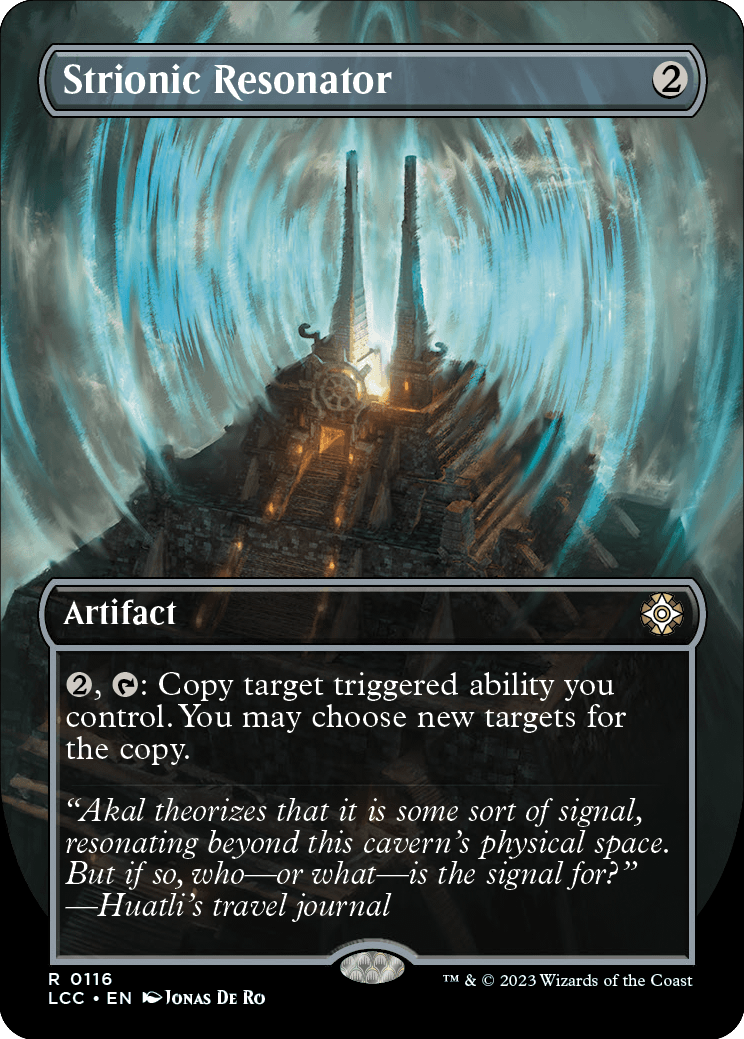
Strionic Resonator
Artifact
, : Copy target triggered ability you control. You may choose new targets for the copy.
- Triggered abilities use the word "when," "whenever," or "at." They're often written as "[Trigger condition], [effect]."
- Strionic Resonator targets a triggered ability that has triggered and is on the stack and creates another instance of that ability on the stack. It doesn't cause any object to gain an ability.
- The source of the copy is the same as the source of the original ability.
- If the triggered ability is modal (that is, if it says, "Choose one —" or similar), the mode is copied and can't be changed.
- If the triggered ability divides damage or distributes counters among a number of targets (for example, the ability of Bogardan Hellkite), the division and number of targets can't be changed. If you choose new targets, you must choose the same number of targets.
- Any choices made when the triggered ability resolves won't have been made yet when it's copied. Any such choices will be made separately when the copy resolves. If the triggered ability asks you to pay a cost (such as that of Frenzied Goblin), you pay that cost for the copy.
- If a triggered ability is linked to a second ability, copies of that triggered ability are also linked to that second ability. If the second ability refers to "the exiled card," it refers to all cards exiled by the triggered ability and the copy. For example, if Fiend Hunter's enters-the-battlefield ability is copied and two creatures are exiled, they both return when Fiend Hunter leaves the battlefield.
- In some cases involving linked abilities, an ability requires information about "the exiled card." When this happens, the ability gets multiple answers. If these answers are being used to determine the value of a variable, the sum is used. For example, if Elite Arcanist's enters-the-battlefield ability is copied, two cards are exiled. The value of X in the activation cost of Elite Arcanist's other ability is the sum of the two cards' mana values. As the ability resolves, you create copies of both cards and can cast none, one, or both of the copies in any order.
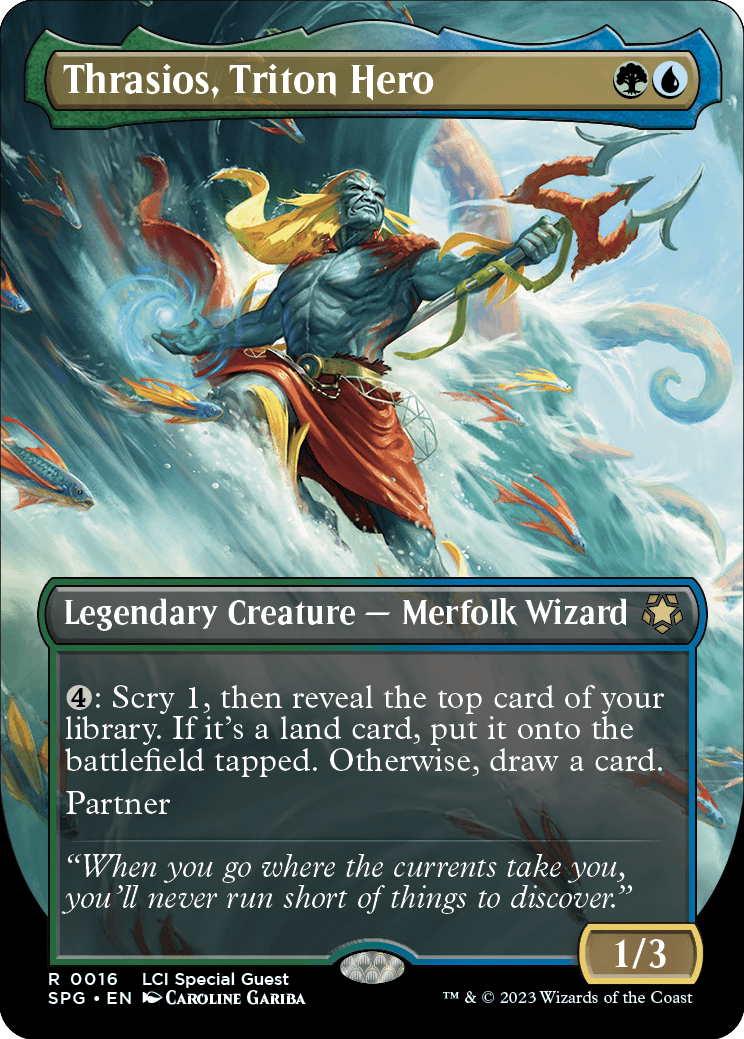
Thrasios, Triton Hero
Legendary Creature — Merfolk Wizard
1/3
: Scry 1, then reveal the top card of your library. If it's a land card, put it onto the battlefield tapped. Otherwise, draw a card.
Partner
- No player may take another action while you're resolving the activated ability.
- The nonland card you reveal will be the card you draw.
- If your Commander deck has two commanders, you can only include cards whose own color identities are also found in your commanders' combined color identities.
- Both commanders start in the command zone, and the remaining 98 cards (or 58 cards in a Commander Draft game) of your deck are shuffled to become your library.
- To have two commanders, both must have the partner ability as the game begins. Losing the ability during the game doesn't cause either to cease to be your commander.
- Once the game begins, your two commanders are tracked separately. If you cast one, you won't have to pay an additional the first time you cast the other. A player loses the game after having been dealt 21 damage from any one of them, not from both of them combined.
- If something refers to your commander while you have two commanders, it refers to one of them of your choice. If you are instructed to perform an action on your commander (e.g. put it from the command zone into your hand due to Command Beacon), you choose one of your commanders at the time the effect happens.
- An effect that checks whether you control your commander is satisfied if you control one or both of your two commanders.
- You can choose two commanders with partner that are the same color or colors. In Commander Draft, you can even choose two of the same commander with partner if you drafted them. If you do this, make sure you keep the number of times you've cast each from the command zone clear for "commander tax" purposes.
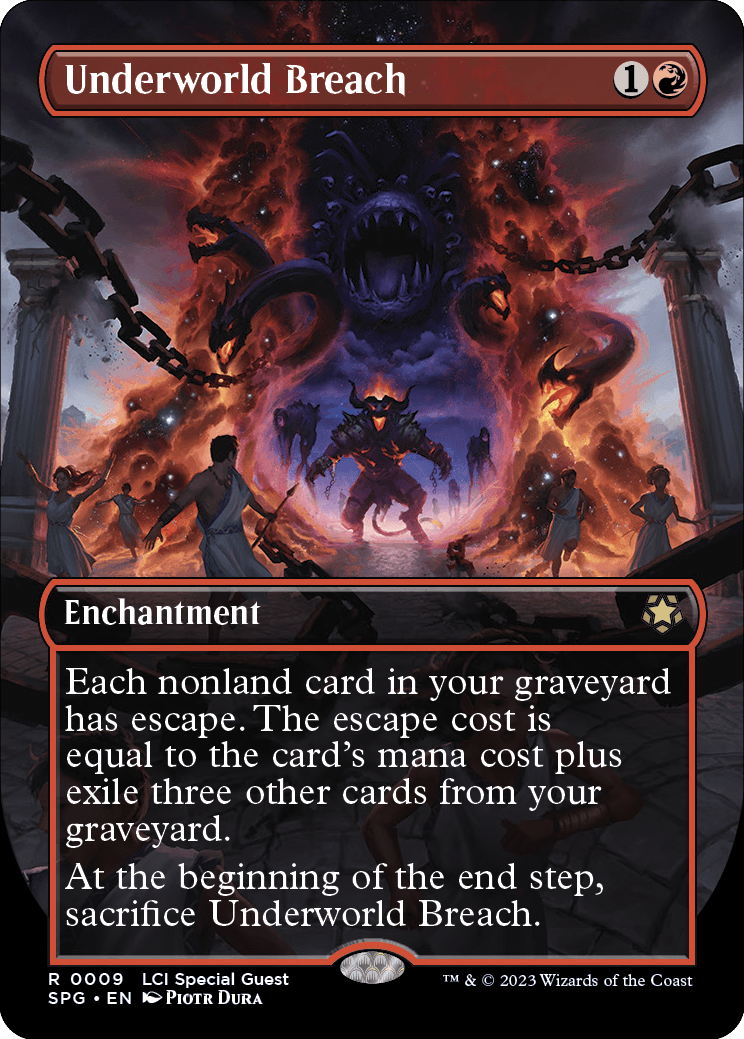
Underworld Breach
Enchantment
Each nonland card in your graveyard has escape. The escape cost is equal to the card's mana cost plus exile three other cards from your graveyard.
At the beginning of the end step, sacrifice Underworld Breach.
- If a card has no mana cost, its escape cost is an unpayable cost, so you can't cast it for that cost.
- If you're casting an adventurer card or split card with escape, you choose how you wish to cast it, then pay the appropriate cost (for the Adventure, the creature, or the half of the split card you chose) plus exiling three cards.
- If a spell you're casting with escape has an additional cost of discarding cards or sacrificing permanents, you may exile cards discarded or sacrificed this way to pay that part of its escape cost.
- Escape's permission doesn't change when you may cast the spell from your graveyard.
- To determine the total cost of a spell, start with the mana cost or alternative cost you're paying (such as an escape cost), add any cost increases, then apply any cost reductions. The mana value of the spell remains unchanged, no matter what the total cost to cast it was and no matter whether an alternative cost was paid.
- After an escaped spell resolves, it returns to its owner's graveyard if it's not a permanent spell. If it is a permanent spell, it enters the battlefield and will return to its owner's graveyard if it dies later. Perhaps it will escape again—good underworld security is so hard to come by these days.
- If a card has multiple abilities giving you permission to cast it, such as two escape abilities or an escape ability and a flashback ability, you choose which one to apply. The others have no effect.
- If you cast a spell with its escape permission, you can't choose to apply any other alternative costs or to cast it without paying its mana cost. If it has any additional costs, you must pay those.
- If a card with escape is put into your graveyard during your turn, you'll be able to cast it right away if it's legal to do so, before an opponent can take any actions.
- Once you begin casting a spell with escape, it immediately moves to the stack. Players can't take any other actions until you're done casting the spell.
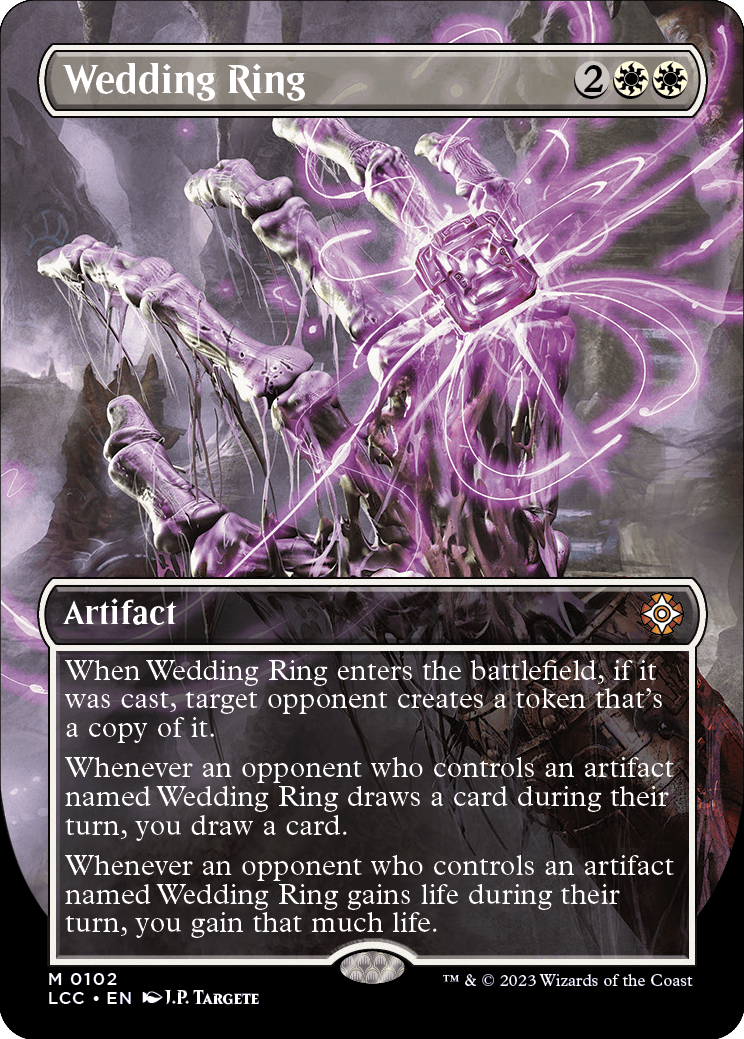
Wedding Ring
Artifact
When Wedding Ring enters the battlefield, if it was cast, target opponent creates a token that's a copy of it.
Whenever an opponent who controls an artifact named Wedding Ring draws a card during their turn, you draw a card.
Whenever an opponent who controls an artifact named Wedding Ring gains life during their turn, you gain that much life.
- The trigger conditions of Wedding Ring's second and third abilities care about opponents who control any artifact named Wedding Ring, not just the token copy created by its first ability.
THE LOST CAVERNS OF IXALAN COMMANDER CARD-SPECIFIC NOTES
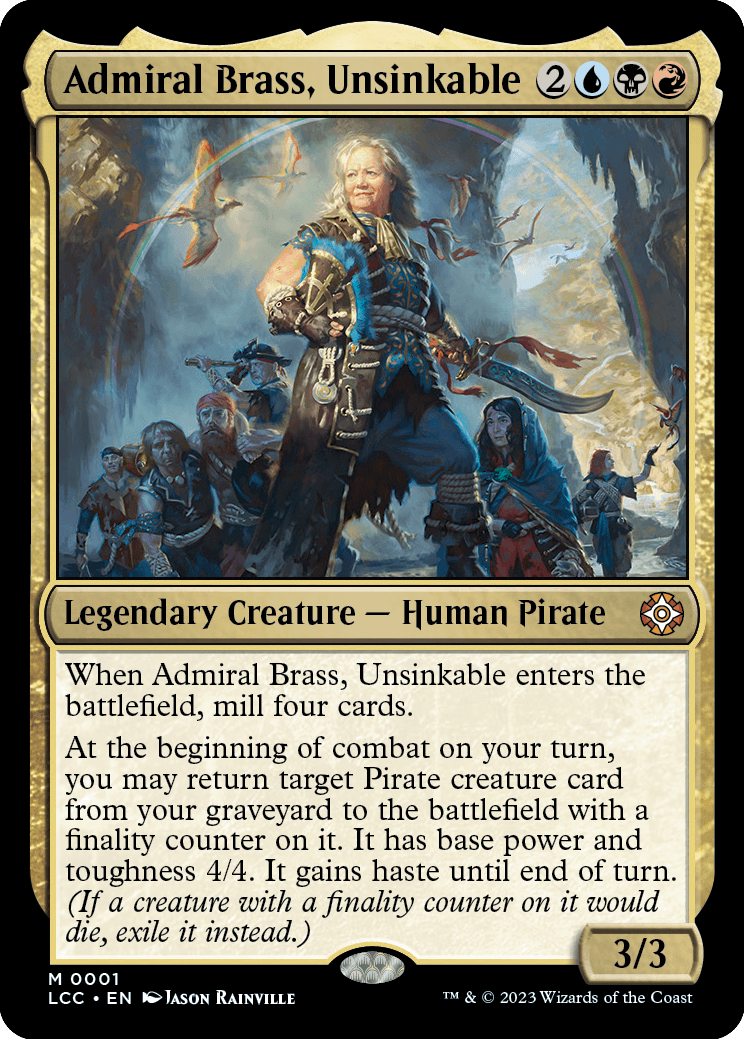
Admiral Brass, Unsinkable
Legendary Creature — Human Pirate
3/3
When Admiral Brass, Unsinkable enters the battlefield, mill four cards.
At the beginning of combat on your turn, you may return target Pirate creature card from your graveyard to the battlefield with a finality counter on it. It has base power and toughness 4/4. It gains haste until end of turn. (If a creature with a finality counter on it would die, exile it instead.)
- Admiral Brass, Unsinkable's effect will overwrite any previous effects that set the returned creature's power and toughness to specific numbers. Effects that otherwise modify the returned creature's power and toughness will still apply no matter when they took effect. The same is true for +1/+1 counters.
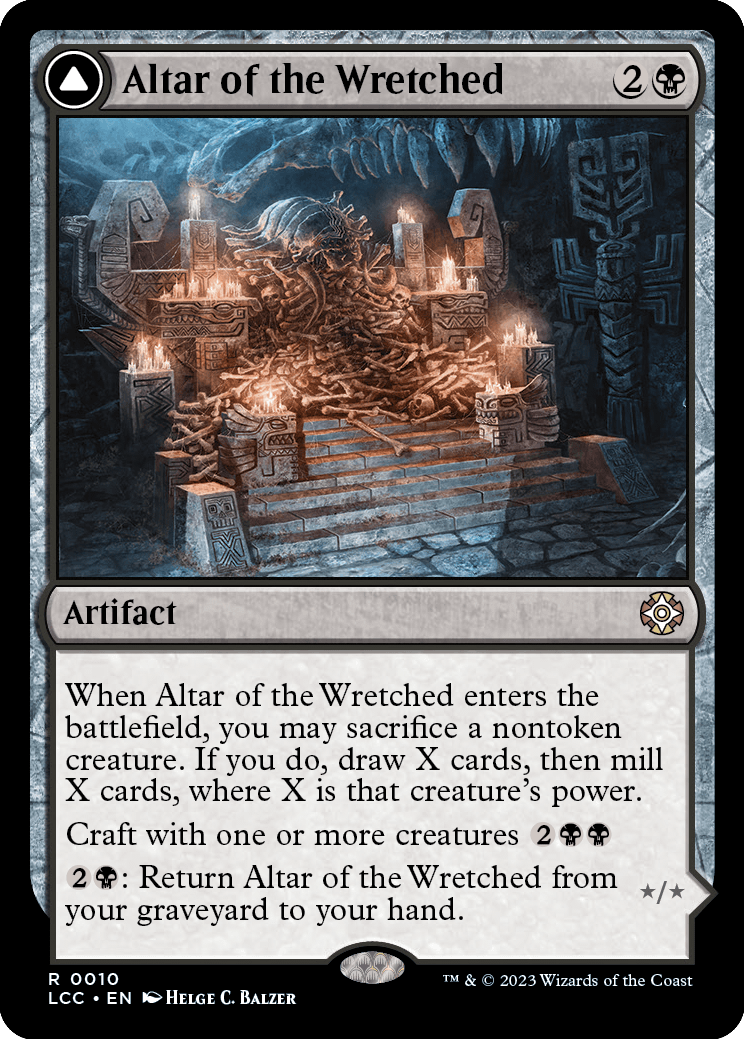
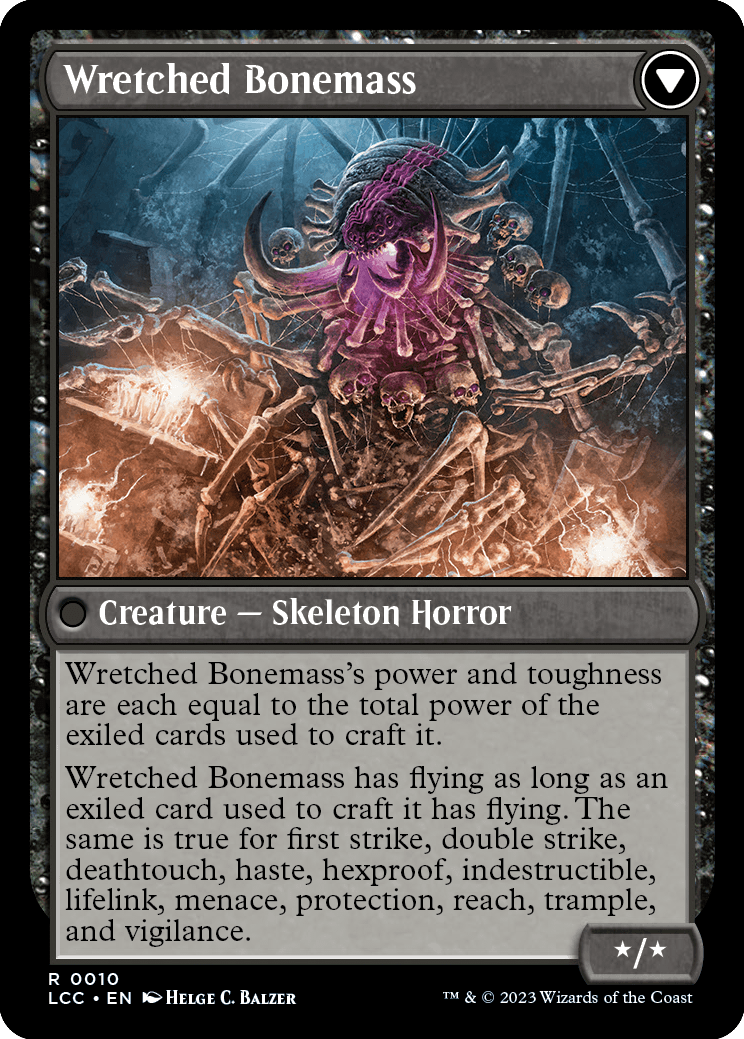
Altar of the Wretched
Artifact
When Altar of the Wretched enters the battlefield, you may sacrifice a nontoken creature. If you do, draw X cards, then mill X cards, where X is that creature's power.
Craft with one or more creatures
: Return Altar of the Wretched from your graveyard to your hand.
////
Wretched Bonemass
Creature — Skeleton Horror
*/*
Wretched Bonemass's power and toughness are each equal to the total power of the exiled cards used to craft it.
Wretched Bonemass has flying as long as an exiled card used to craft it has flying. The same is true for first strike, double strike, deathtouch, haste, hexproof, indestructible, lifelink, menace, protection, reach, trample, and vigilance.
- If any of the exiled cards has a characteristic-defining ability that defines its power and/or toughness, that ability will apply. For example, if you used Souls of the Lost to craft Wretched Bonemass, its power and toughness while in exile are determined by the number of permanent cards in your graveyard, and Wretched Bonemass's power and toughness will change as the number of permanent cards in your graveyard changes. If the characteristic-defining ability can't be applied, then use 0.
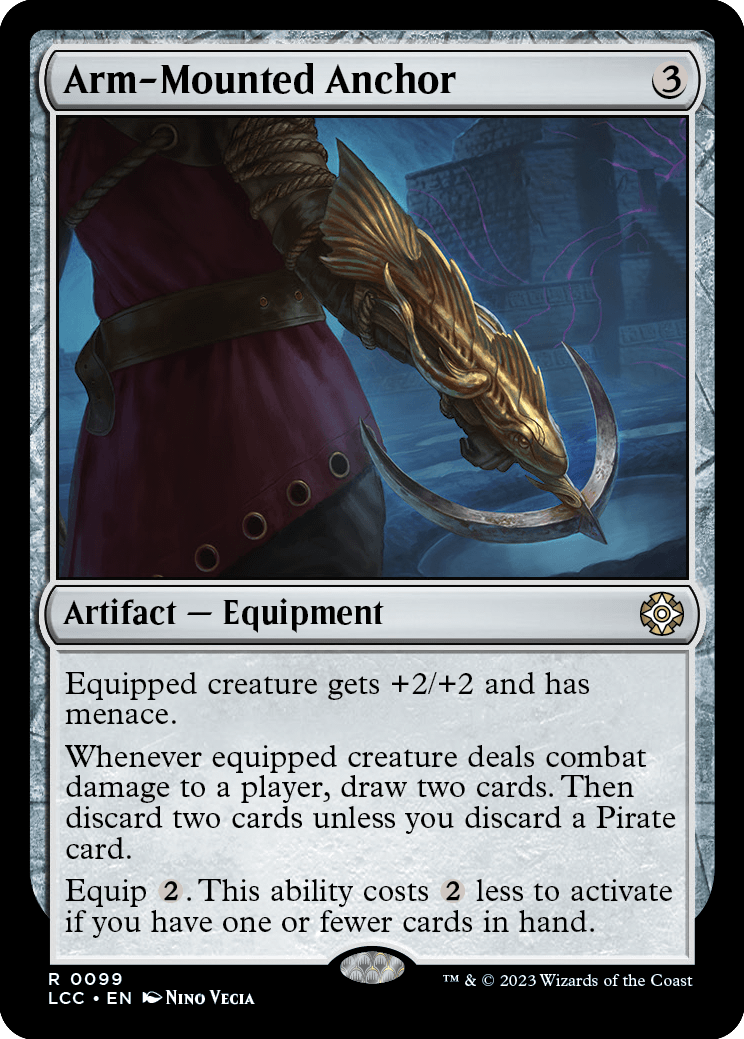
Arm-Mounted Anchor
Artifact — Equipment
Equipped creature gets +2/+2 and has menace.
Whenever equipped creature deals combat damage to a player, draw two cards. Then discard two cards unless you discard a Pirate card.
Equip . This ability costs less to activate if you have one or fewer cards in hand.
- You can discard either one Pirate card or two cards which may or may not be Pirates. If you really want to, you can discard two Pirate cards. (Admiral Brass will remember this.)
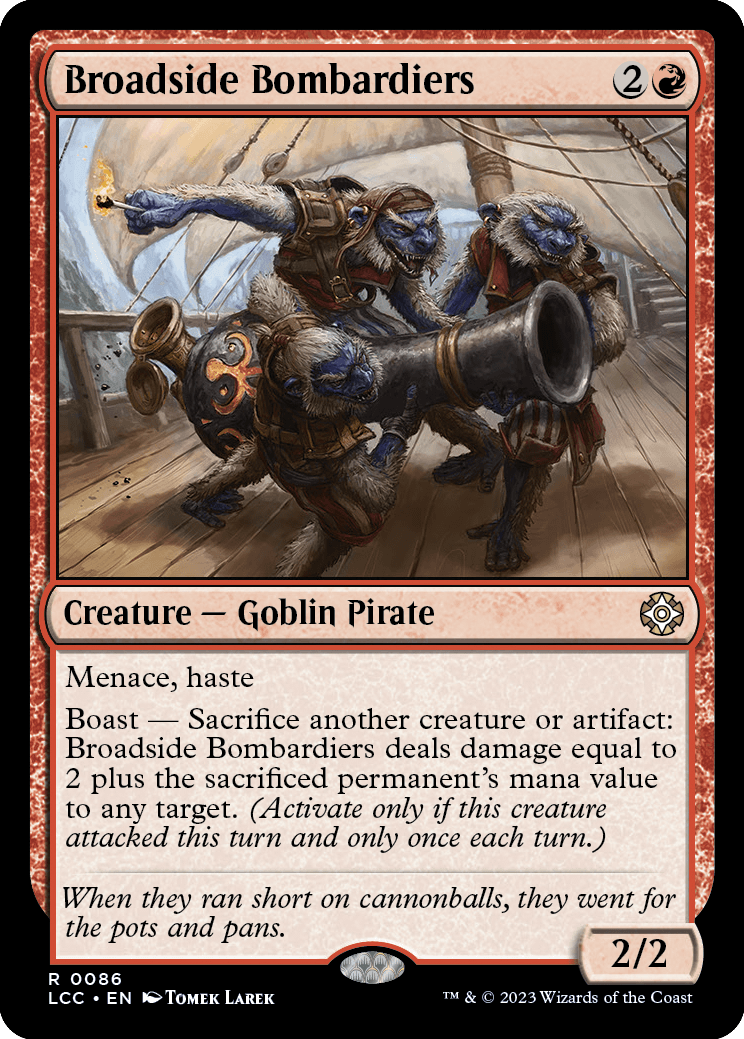
Broadside Bombardiers
Creature — Goblin Pirate
2/2
Menace, haste
Boast — Sacrifice another creature or artifact: Broadside Bombardiers deals damage equal to 2 plus the sacrificed permanent's mana value to any target. (Activate only if this creature attacked this turn and only once each turn.)
- A boast ability can be activated at any point after the creature with that ability has been declared as an attacker. This can be before blockers are declared, after blockers are declared but before combat damage is dealt, during combat after combat damage is dealt, during the postcombat main phase, during the end step, or, in some unusual cases, during the cleanup step.
- If it's not your turn and you gain control of a creature with a boast ability after that creature attacked, you can activate that creature's boast ability if it hasn't been activated yet that turn.
- If a creature with a boast ability is put onto the battlefield attacking, it was never declared as an attacker. Its boast ability can't be activated that turn.
- If an effect adds additional combat phases to a turn and a creature with a boast ability attacks more than once during that turn, its boast ability can still be activated only once.
- The back face of a double-faced card doesn't have a mana cost. A double-faced permanent with its back face up has a mana value equal to the mana value of its front face.
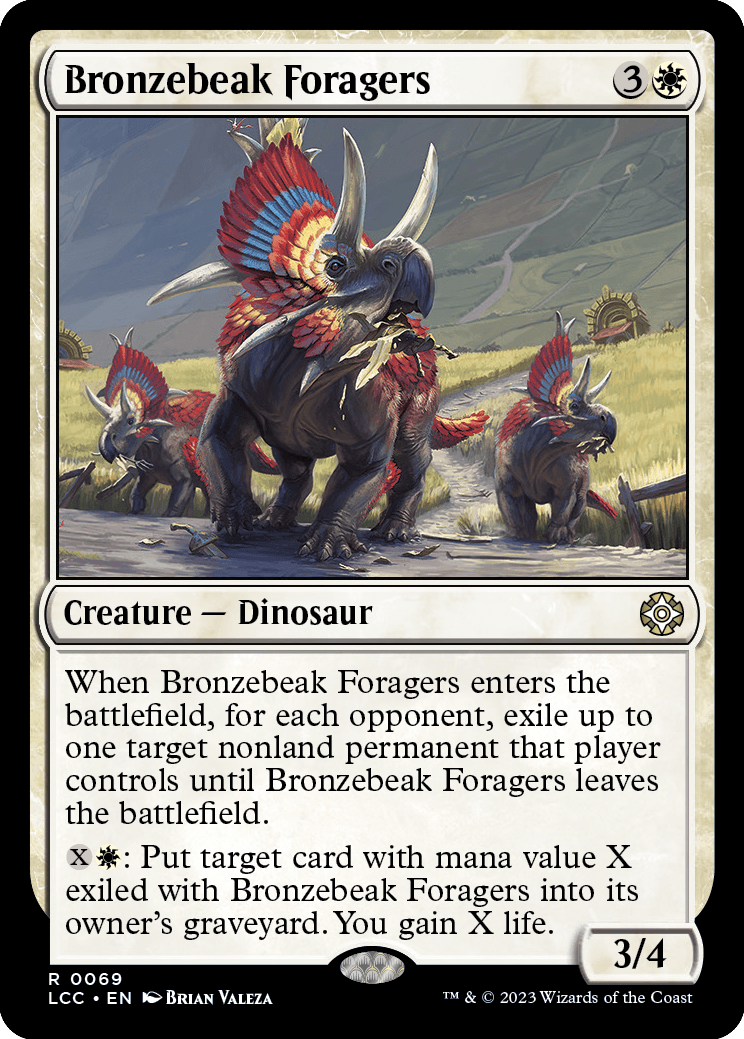
Bronzebeak Foragers
Creature — Dinosaur
3/4
When Bronzebeak Foragers enters the battlefield, for each opponent, exile up to one target nonland permanent that player controls until Bronzebeak Foragers leaves the battlefield.
: Put target card with mana value X exiled with Bronzebeak Foragers into its owner's graveyard. You gain X life.
- If Bronzebeak Foragers leaves the battlefield before its first ability resolves, none of the target permanents will be exiled.
- Auras attached to the exiled permanents will be put into their owners' graveyards. Any Equipment will become unattached and remain on the battlefield. Any counters on the exiled permanents will cease to exist. When the cards return to the battlefield, they will be new objects with no connections to the cards that were exiled.
- If a token is exiled this way, it will cease to exist and won't return to the battlefield.
- If an exiled permanent card leaves exile, perhaps because of Bronzebeak Foragers's last ability, it won't return to the battlefield after Bronzebeak Foragers leaves the battlefield.
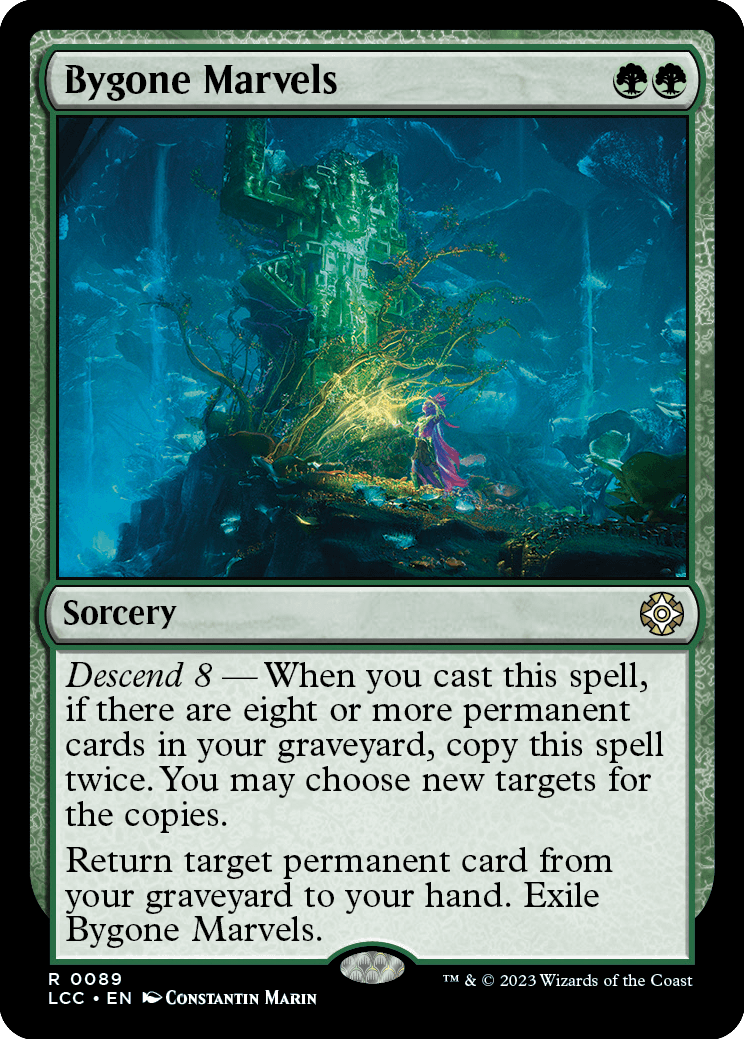
Bygone Marvels
Sorcery
Descend 8 — When you cast this spell, if there are eight or more permanent cards in your graveyard, copy this spell twice. You may choose new targets for the copies.
Return target permanent card from your graveyard to your hand. Exile Bygone Marvels.
- The triggered ability will resolve before Bygone Marvels does. If Bygone Marvels is countered in response to its own triggered ability, you will still copy Bygone Marvels twice.
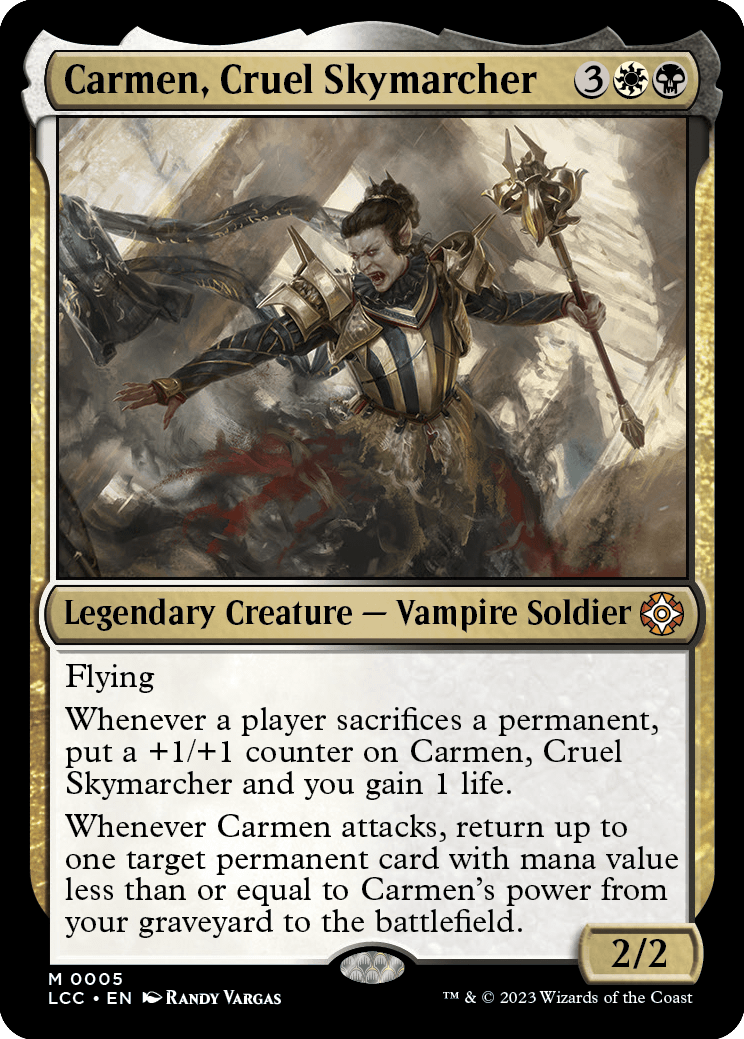
Carmen, Cruel Skymarcher
Legendary Creature — Vampire Soldier
2/2
Flying
Whenever a player sacrifices a permanent, put a +1/+1 counter on Carmen, Cruel Skymarcher and you gain 1 life.
Whenever Carmen attacks, return up to one target permanent card with mana value less than or equal to Carmen's power from your graveyard to the battlefield.
- If a permanent is sacrificed to pay a cost of a spell or ability, Carmen, Cruel Skymarcher's second ability will resolve before that spell or ability. Conversely, if a permanent is sacrificed during the resolution of a spell or ability, that spell or ability will finish resolving before Carmen, Cruel Skymarcher's second ability is put onto the stack.
- If you sacrifice Carmen, Cruel Skymarcher, its second ability will still trigger.
- If another effect causes Carmen, Cruel Skymarcher's power to be less than the mana value of the target card as its last ability tries to resolve, the target is illegal. You won't return the target card to the battlefield.
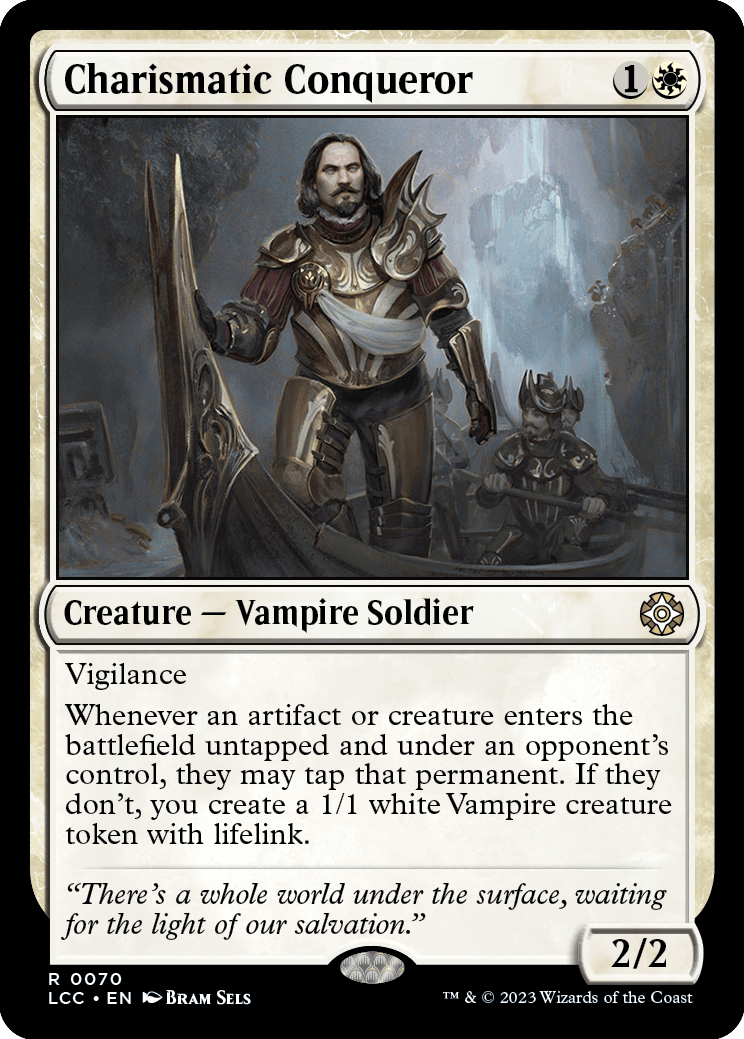
Charismatic Conqueror
Creature — Vampire Soldier
2/2
Vigilance
Whenever an artifact or creature enters the battlefield untapped and under an opponent's control, they may tap that permanent. If they don't, you create a 1/1 white Vampire creature token with lifelink.
- If the permanent is tapped as the ability resolves, the opponent can't choose to tap it, so you'll create a Vampire token. Similarly, if it's no longer on the battlefield as the ability resolves, they can't choose to tap it, and you'll create a Vampire token.
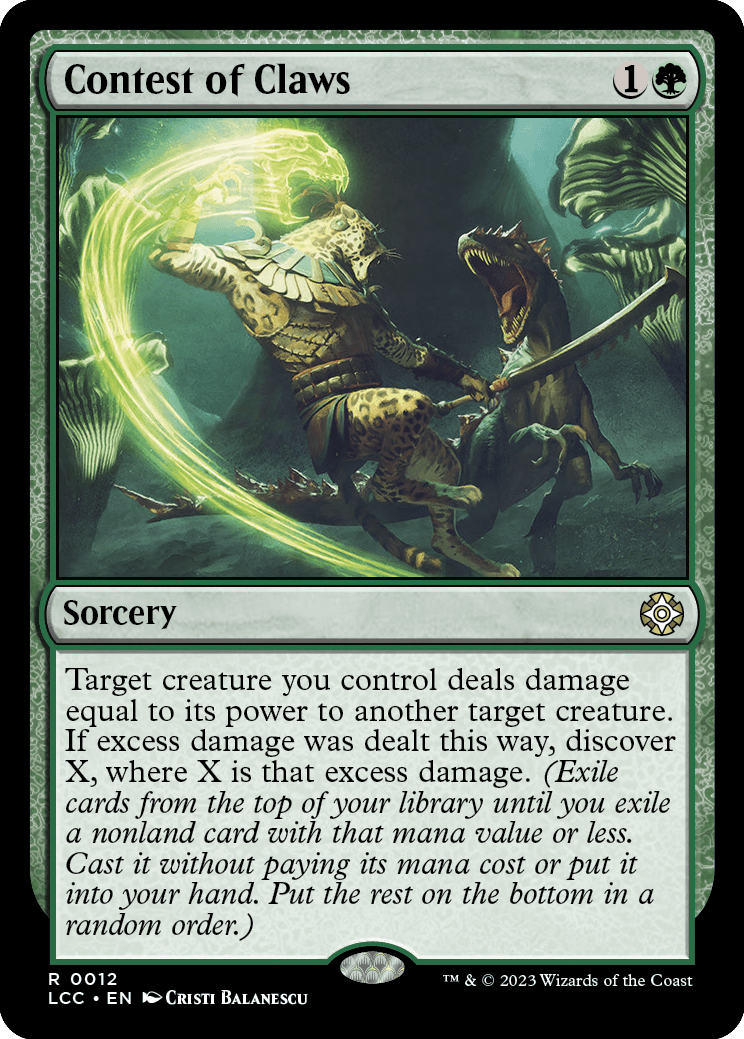
Contest of Claws
Sorcery
Target creature you control deals damage equal to its power to another target creature. If excess damage was dealt this way, discover X, where X is that excess damage. (Exile cards from the top of your library until you exile a nonland card with that mana value or less. Cast it without paying its mana cost or put it into your hand. Put the rest on the bottom in a random order.)
- Excess damage has been dealt to a creature if the damage dealt to it is greater than lethal damage. Usually, this means damage greater than its toughness, although damage already marked on the creature is taken into account.
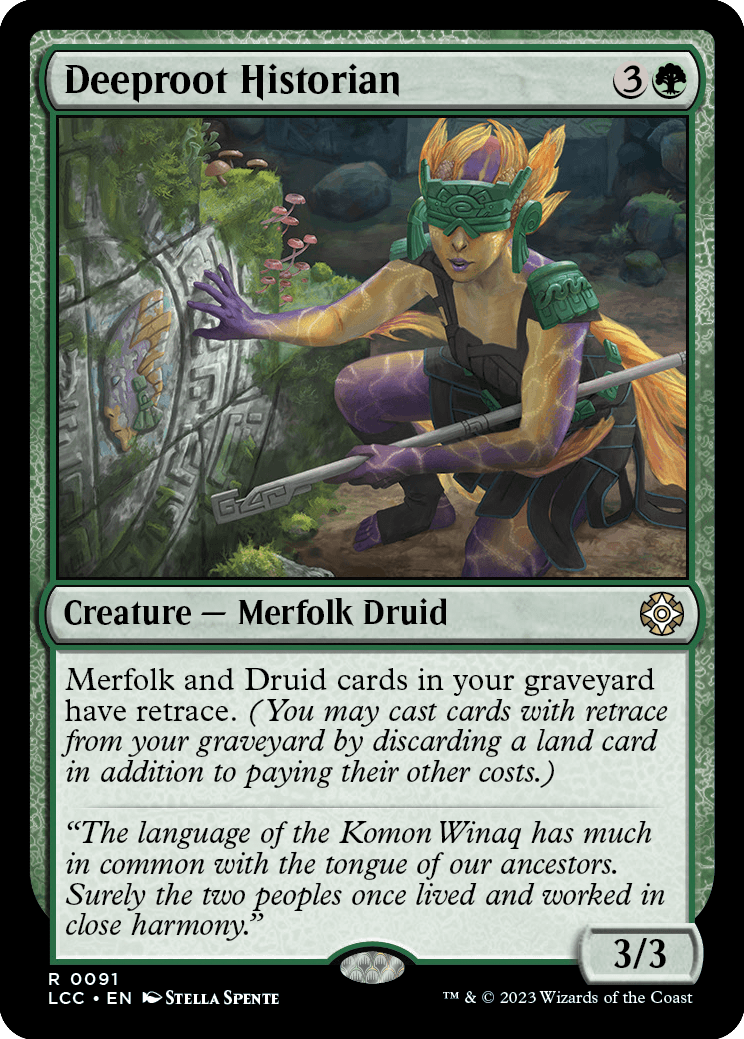
Deeproot Historian
Creature — Merfolk Druid
3/3
Merfolk and Druid cards in your graveyard have retrace. (You may cast cards with retrace from your graveyard by discarding a land card in addition to paying their other costs.)
- If a spell you cast with retrace is countered, it's put back into your graveyard. You may use the retrace ability to cast it again.
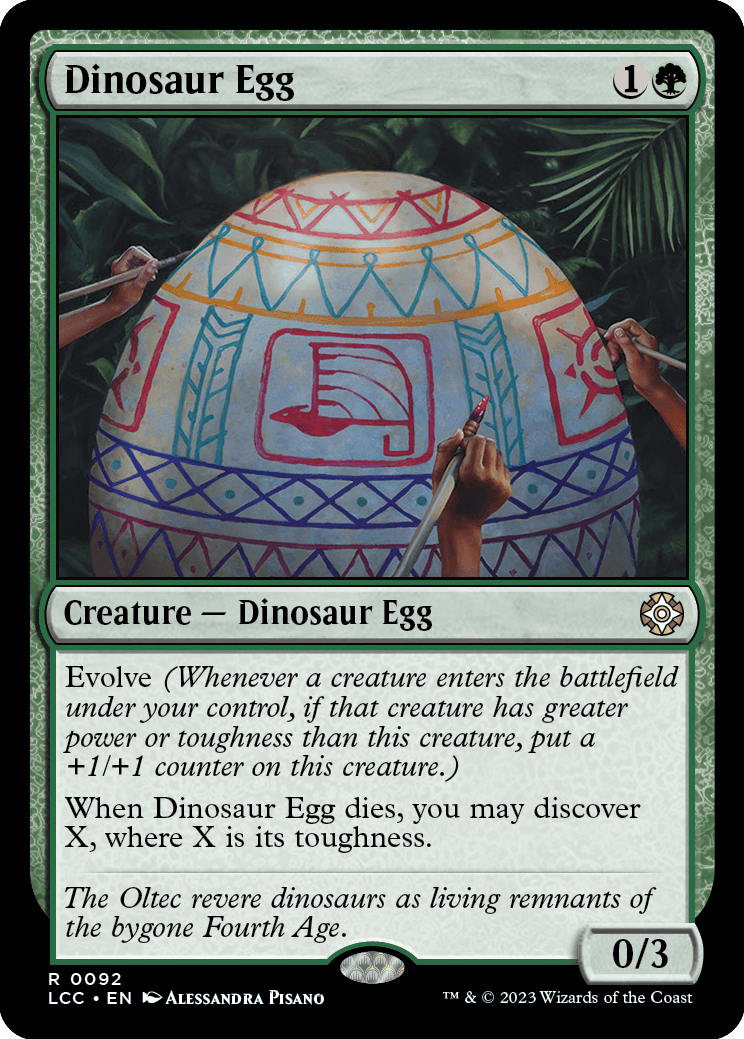
Dinosaur Egg
Creature — Dinosaur Egg
0/3
Evolve (Whenever a creature enters the battlefield under your control, if that creature has greater power or toughness than this creature, put a +1/+1 counter on this creature.)
When Dinosaur Egg dies, you may discover X, where X is its toughness.
- When comparing the stats of the two creature for evolve, you always compare power to power and toughness to toughness.
- Whenever a creature enters the battlefield under your control, check its power and toughness against the power and toughness of the creature with evolve. If neither stat of the new creature is greater, evolve won't trigger at all.
- If evolve triggers, the stat comparison will happen again when the ability tries to resolve. If neither stat of the new creature is greater, the ability will do nothing. If the creature that entered the battlefield leaves the battlefield before evolve tries to resolve, use its last known power and toughness to compare the stats.
- If multiple creatures enter the battlefield at the same time, evolve may trigger multiple times, although the stat comparison will take place each time one of those abilities tries to resolve. For example, if you control a 2/2 creature with evolve and two 3/3 creatures enter the battlefield, evolve will trigger twice. The first ability will resolve and put a +1/+1 counter on the creature with evolve. When the second ability tries to resolve, neither the power nor the toughness of the new creature is greater than that of the creature with evolve, so that ability does nothing.
- Multiple instances of evolve trigger separately and, similar to above, the stat comparison takes place for each one independently as they try to resolve.
- When comparing the stats as the evolve ability resolves, it's possible that the stat that's greater changes from power to toughness or vice versa. If this happens, the ability will still resolve and you'll put a +1/+1 counter on the creature with evolve. For example, if you control a 2/2 creature with evolve and a 1/3 creature enters the battlefield under your control, its toughness is greater so evolve will trigger. In response, the 1/3 creature gets +2/-2. When the evolve trigger tries to resolve, its power is greater. You'll put a +1/+1 counter on the creature with evolve.
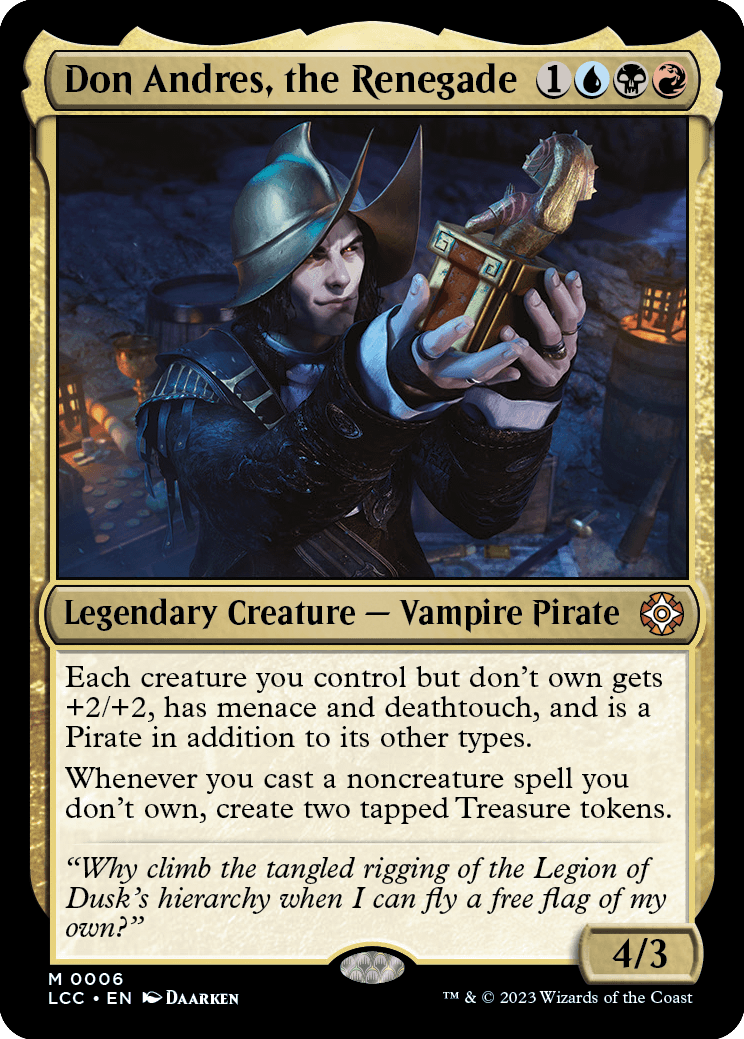
Don Andres, the Renegade
Legendary Creature — Vampire Pirate
4/3
Each creature you control but don't own gets +2/+2, has menace and deathtouch, and is a Pirate in addition to its other types.
Whenever you cast a noncreature spell you don't own, create two tapped Treasure tokens.
- The player who creates a token is its owner.
- The owner of a copy of a spell is the player under whose control it was put onto the stack.
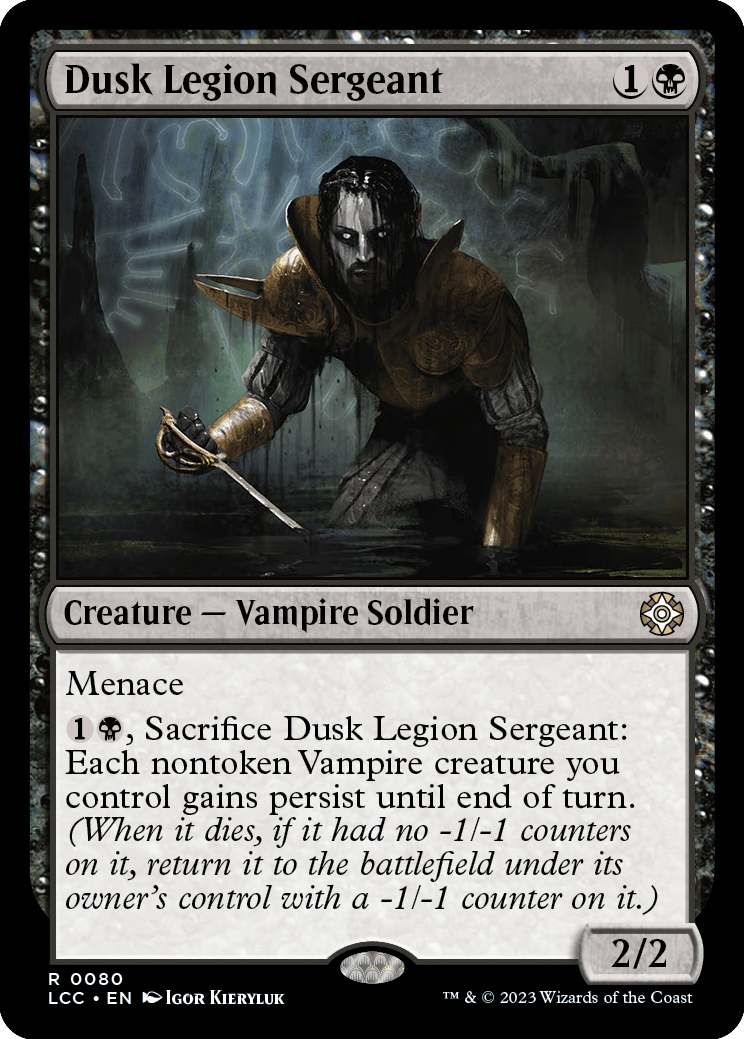
Dusk Legion Sergeant
Creature — Vampire Soldier
2/2
Menace
, Sacrifice Dusk Legion Sergeant: Each nontoken Vampire creature you control gains persist until end of turn. (When it dies, if it had no -1/-1 counters on it, return it to the battlefield under its owner's control with a -1/-1 counter on it.)
- If a card with persist is removed from the graveyard after it dies but before the ability trigger resolves, it won't be returned to the battlefield.
- Once persist returns the creature, it's considered a new object with no relation to the object that it was. Auras that were attached to it won't return to the battlefield. Equipment that was attached to it will remain unattached. Any counters that were on it won't be put on the new creature.
- If a creature has +1/+1 counters and -1/-1 counters on it, state-based actions remove the same number of each so that it has only one kind of those counters on it. A creature's persist ability can bring it back again if its -1/-1 counters are removed this way.
- If a creature with persist that has +1/+1 counters on it receives enough -1/-1 counters to cause it to be destroyed by lethal damage or put into its owner's graveyard for having 0 or less toughness, persist won't trigger and the card won't return to the battlefield. That's because persist checks the creature as it last existed on the battlefield, and it still had -1/-1 counters on it at that point.
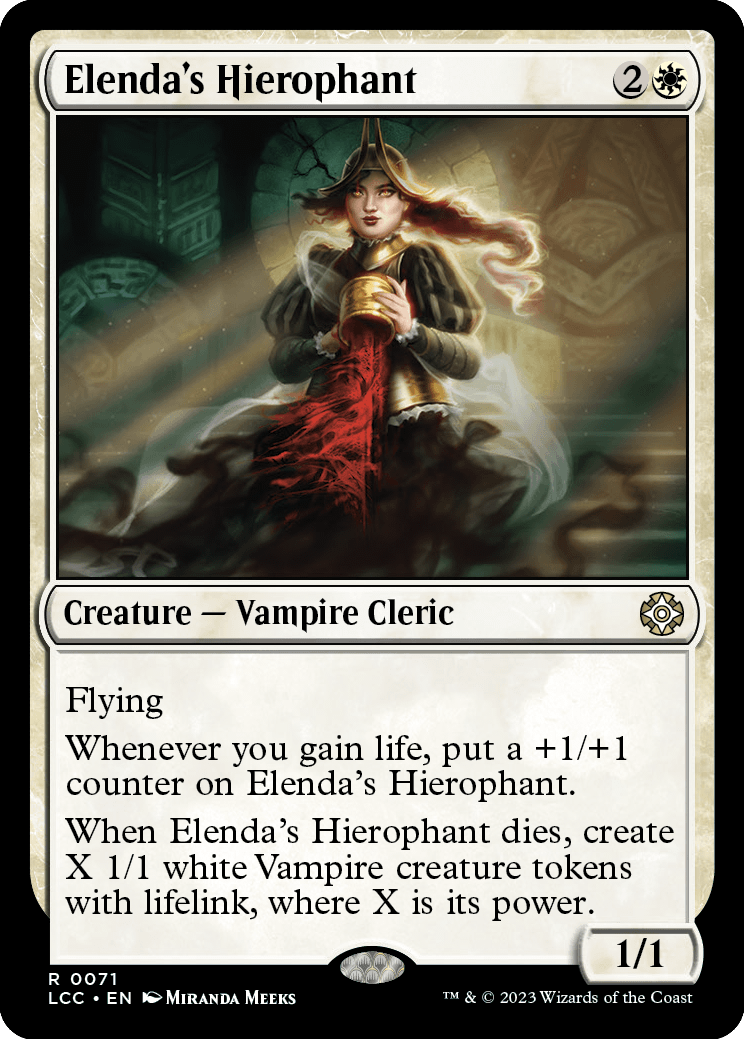
Elenda's Hierophant
Creature — Vampire Cleric
1/1
Flying
Whenever you gain life, put a +1/+1 counter on Elenda's Hierophant.
When Elenda's Hierophant dies, create X 1/1 white Vampire creature tokens with lifelink, where X is its power.
- The second ability of Elenda's Hierophant triggers just once for each life-gaining event, no matter how much life was gained.
- If Elenda's Hierophant is dealt lethal damage at the same time that you gain life, it won't receive a counter from its second ability in time to save it.
- Each creature with lifelink dealing combat damage causes a separate life-gaining event. For example, if two creatures you control with lifelink deal combat damage at the same time, Elenda's Hierophant's second ability will trigger twice. However, if a single creature you control with lifelink deals combat damage to multiple creatures, players, and/or planeswalkers at the same time (perhaps because it has trample or was blocked by more than one creature), the ability will trigger only once.
- If you gain an amount of life "for each" of something, that life is gained as one event and the second ability of Elenda's Hierophant triggers only once.
- In a Two-Headed Giant game, life gained by your teammate won't cause the second ability of Elenda's Hierophant to trigger even though it caused your team's life total to increase.
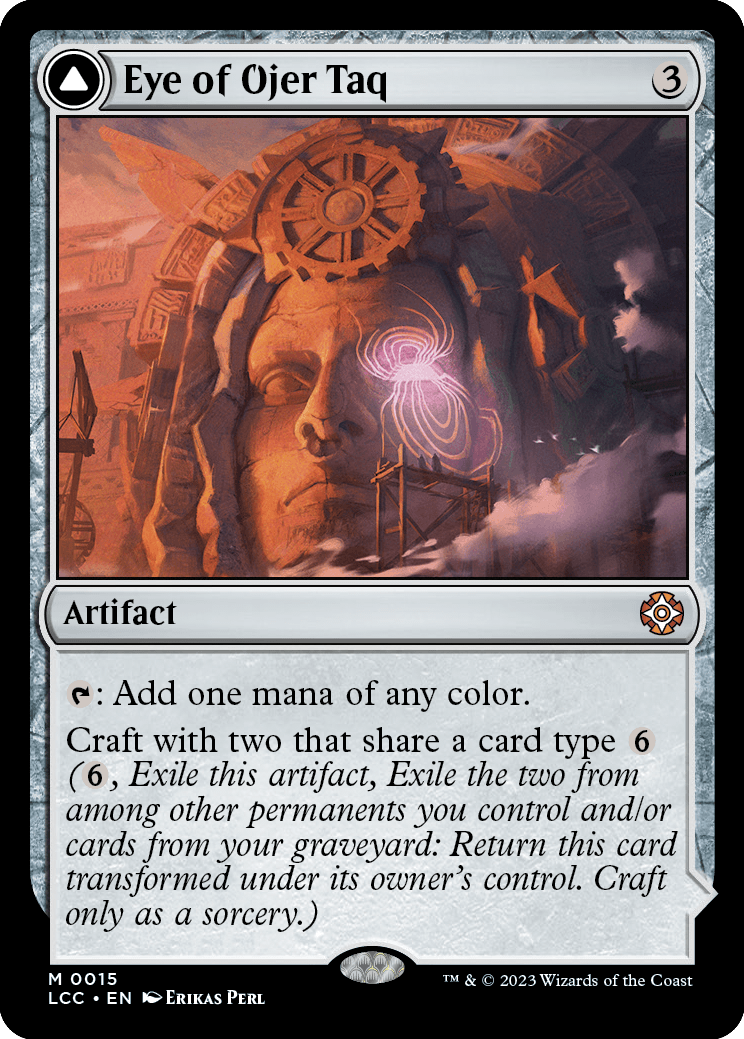
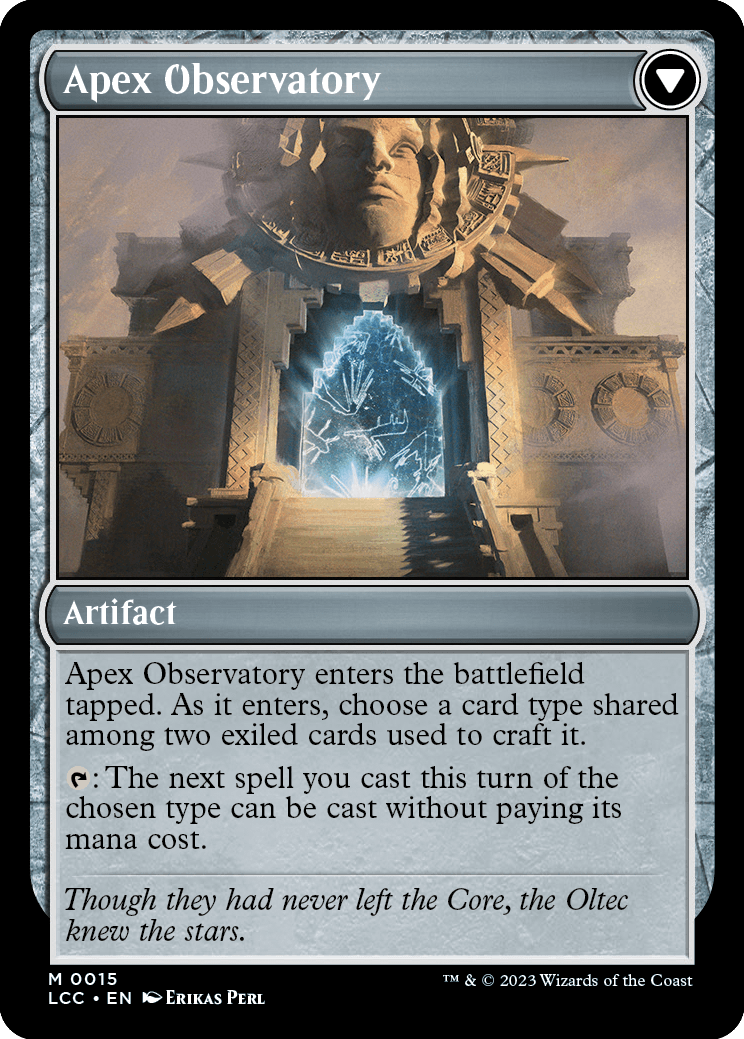
Eye of Ojer Taq
Artifact
: Add one mana of any color.
Craft with two that share a card type (, Exile this artifact, Exile the two from among other permanents you control and/or cards from your graveyard: Return this card transformed under its owner's control. Craft only as a sorcery.)
////
Apex Observatory
Artifact
Apex Observatory enters the battlefield tapped. As it enters, choose a card type shared among two exiled cards used to craft it.
: The next spell you cast this turn of the chosen type can be cast without paying its mana cost.
- Card types that may appear in a normal game of Magic are artifact, battle, creature, enchantment, instant, land, planeswalker, sorcery, and tribal (a card type found on some older cards). Supertypes such as snow and basic may not be chosen. Subtypes such as Bird, Equipment, and Forest also may not be chosen. Land may be chosen, but it's not a good idea.
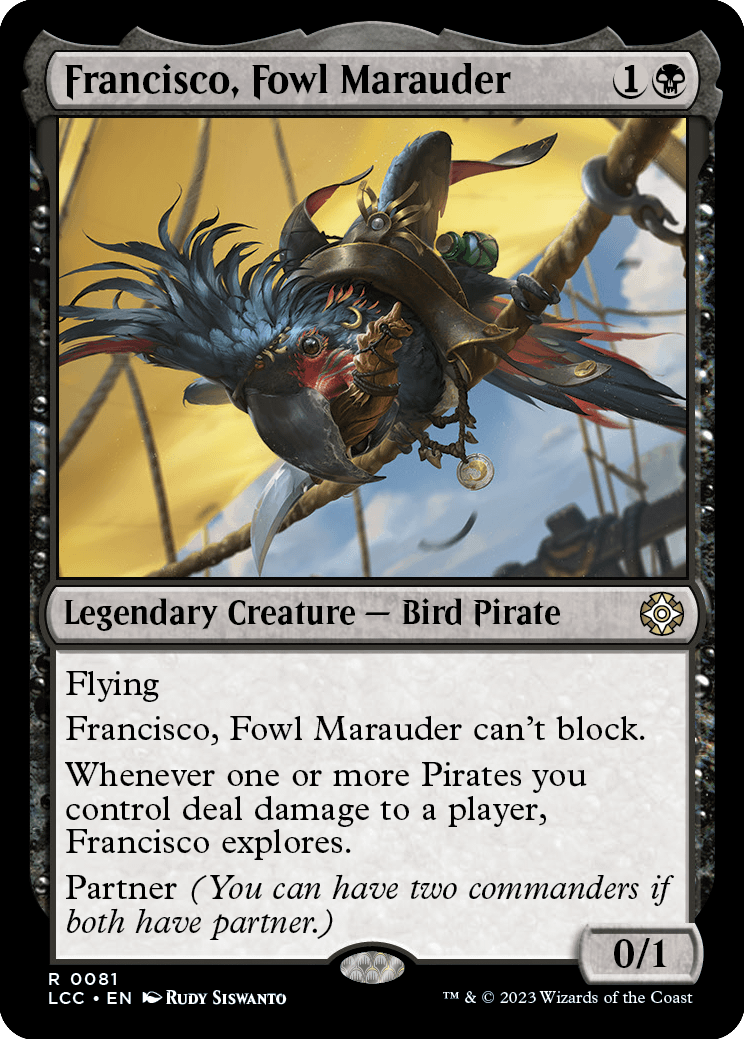
Francisco, Fowl Marauder
Legendary Creature — Bird Pirate
0/1
Flying
Francisco, Fowl Marauder can't block.
Whenever one or more Pirates you control deal damage to a player, Francisco explores.
Partner (You can have two commanders if both have partner.)
- If one or more Pirates you control deal damage to multiple players at once (for example, in combat, or with an ability such as that of Lightning-Rig Crew), Francisco, Fowl Marauder's ability triggers once for each of those players.
- If your Commander deck has two commanders, you can only include cards whose own color identities are also found in your commanders' combined color identities.
- Both commanders start in the command zone, and the remaining 98 cards (or 58 cards in a Commander Draft game) of your deck are shuffled to become your library.
- To have two commanders, both must have the partner ability as the game begins. Losing the ability during the game doesn't cause either to cease to be your commander.
- Once the game begins, your two commanders are tracked separately. If you cast one, you won't have to pay an additional the first time you cast the other. A player loses the game after having been dealt 21 damage from any one of them, not from both of them combined.
- If something refers to your commander while you have two commanders, it refers to one of them of your choice. If you are instructed to perform an action on your commander (e.g. put it from the command zone into your hand due to Command Beacon), you choose one of your commanders at the time the effect happens.
- An effect that checks whether you control your commander is satisfied if you control one or both of your two commanders.
- You can choose two commanders with partner that are the same color or colors. In Commander Draft, you can even choose two of the same commander with partner if you drafted them. If you do this, make sure you keep the number of times you've cast each from the command zone clear for "commander tax" purposes.
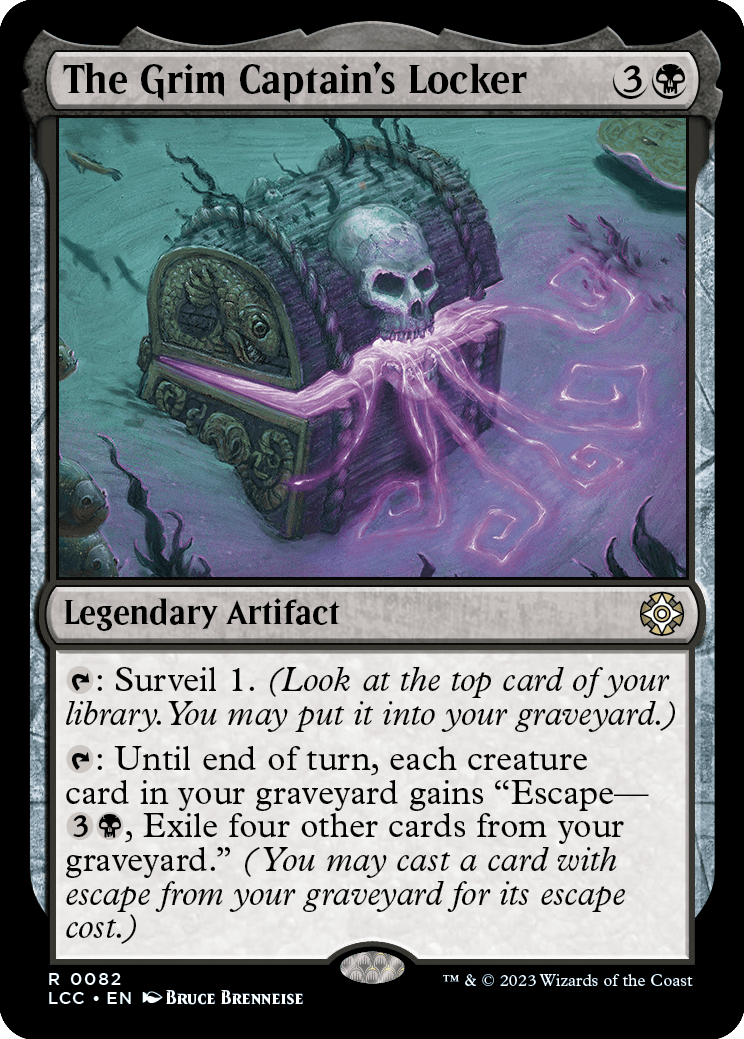
The Grim Captain's Locker
Legendary Artifact
: Surveil 1. (Look at the top card of your library. You may put it into your graveyard.)
: Until end of turn, each creature card in your graveyard gains "Escape—, Exile four other cards from your graveyard." (You may cast a card with escape from your graveyard for its escape cost.)
- Escape's permission doesn't change when you may cast the spell from your graveyard.
- To determine the total cost of a spell, start with the mana cost or alternative cost you're paying (such as an escape cost), add any cost increases, then apply any cost reductions. The mana value of the spell remains unchanged, no matter what the total cost to cast it was and no matter whether an alternative cost was paid.
- If a card has multiple abilities giving you permission to cast it, such as two escape abilities or an escape ability and a flashback ability, you choose which one to apply. The others have no effect.
- If you cast a spell with its escape permission, you can't choose to apply any other alternative costs or to cast it without paying its mana cost. If it has any additional costs, you must pay those.
- Once you begin casting a spell with escape, it immediately moves to the stack. Players can't take any other actions until you're done casting the spell.
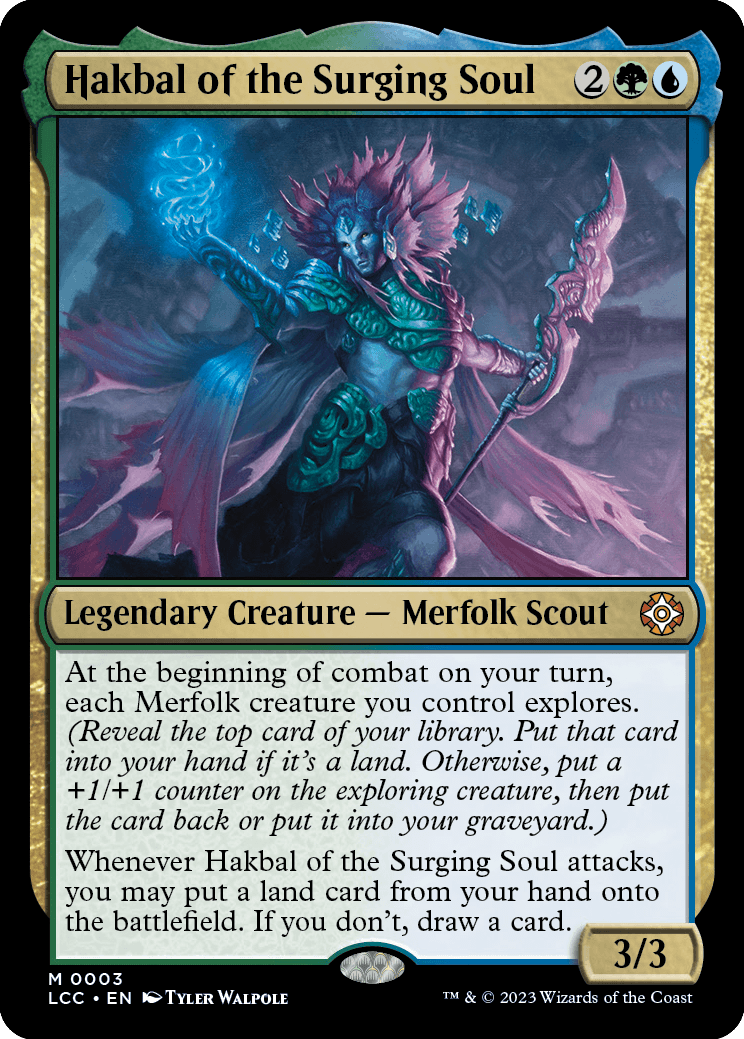
Hakbal of the Surging Soul
Legendary Creature — Merfolk Scout
3/3
At the beginning of combat on your turn, each Merfolk creature you control explores. (Reveal the top card of your library. Put that card into your hand if it's a land. Otherwise, put a +1/+1 counter on the exploring creature, then put the card back or put it into your graveyard.)
Whenever Hakbal of the Surging Soul attacks, you may put a land card from your hand onto the battlefield. If you don't, draw a card.
- Each of your Merfolk creatures will explore during the resolution of Hakbal of the Surging Soul's first ability. Players won't be able to respond between the explores.
- If you control multiple Merfolk, you choose the order in which they explore. Make sure it's clear which Merfolk is exploring before you reveal any cards.
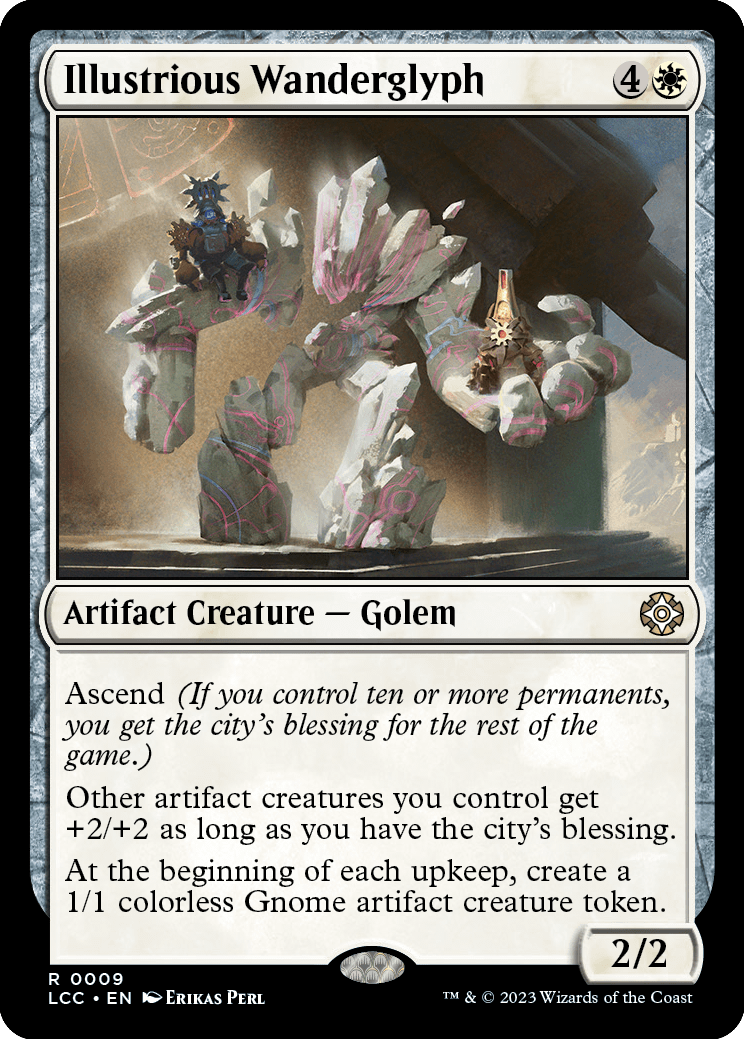
Illustrious Wanderglyph
Artifact Creature — Golem
2/2
Ascend (If you control ten or more permanents, you get the city's blessing for the rest of the game.)
Other artifact creatures you control get +2/+2 as long as you have the city's blessing.
At the beginning of each upkeep, create a 1/1 colorless Gnome artifact creature token.
- If you cast a spell with ascend, you don't get the city's blessing until it resolves. Players may respond to that spell by trying to change whether you get the city's blessing.
- Once you have the city's blessing, you have it for the rest of the game, even if you lose control of some or all of your permanents. The city's blessing isn't a permanent itself and can't be removed by any effect.
- A permanent is any object on the battlefield, including tokens and lands. Spells and emblems aren't permanents.
- If you control ten permanents but don't control a permanent or resolving spell with ascend, you don't get the city's blessing. For example, if you control ten permanents, lose control of two, then cast Illustrious Wanderglyph, you won't have the city's blessing.
- If your tenth permanent enters the battlefield and then a permanent leaves the battlefield immediately afterwards (most likely due to the "legend rule" or due to being a creature with 0 toughness), you get the city's blessing before it leaves the battlefield.
- Ascend on a permanent isn't a triggered ability and doesn't use the stack. Players can respond to a spell that will give you your tenth permanent, but they can't respond to you getting the city's blessing once you control that tenth permanent. This means that if your tenth permanent is a land you play, players can't respond before you get the city's blessing.
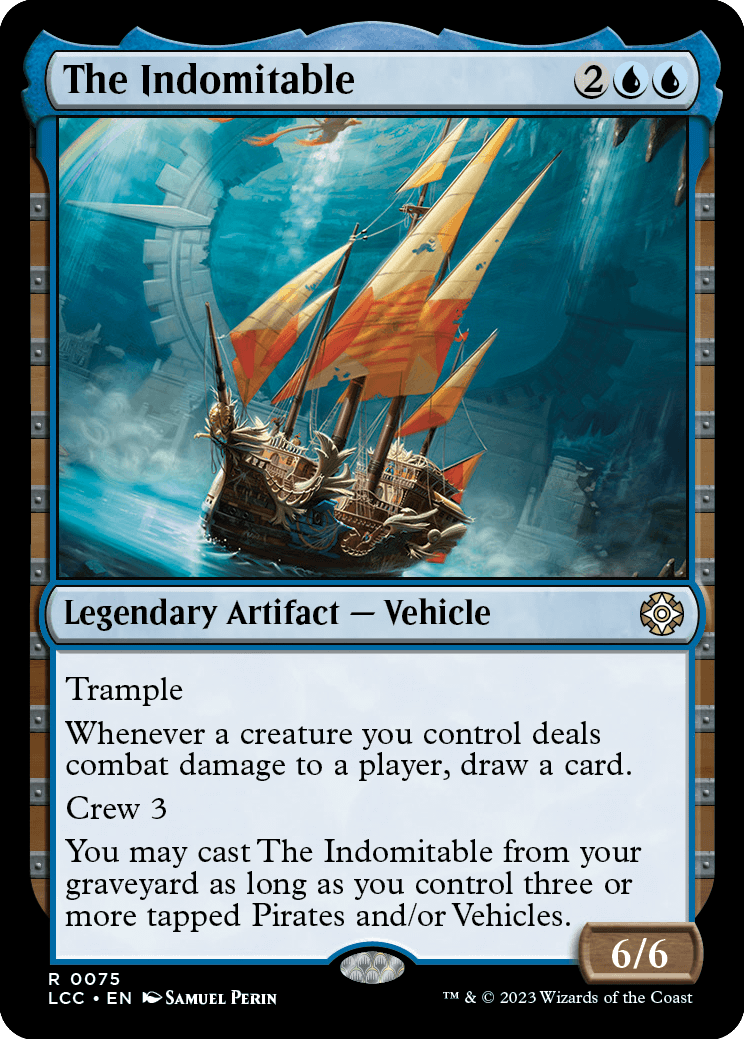
The Indomitable
Legendary Artifact — Vehicle
6/6
Trample
Whenever a creature you control deals combat damage to a player, draw a card.
Crew 3
You may cast The Indomitable from your graveyard as long as you control three or more tapped Pirates and/or Vehicles.
- The casting permission granted by The Indomitable's last ability doesn't change when you may cast it from your graveyard.
- You still pay The Indomitable's costs when casting it from your graveyard.
- If The Indomitable is countered or dies after being cast from your graveyard, it returns to the graveyard. It may be cast this way again later.
- Once you begin casting a spell from your graveyard, it immediately moves to the stack. Players can't take any actions until you've finished casting the spell.
- Only tapped Pirates and tapped Vehicles count toward the casting permission from The Indomitable's last ability.
- The Indomitable checks if you control three or more tapped Pirates and/or Vehicles only as you begin to cast it. Once you begin to cast The Indomitable from your graveyard, it doesn't matter what happens to the tapped Pirates and/or Vehicles you control.
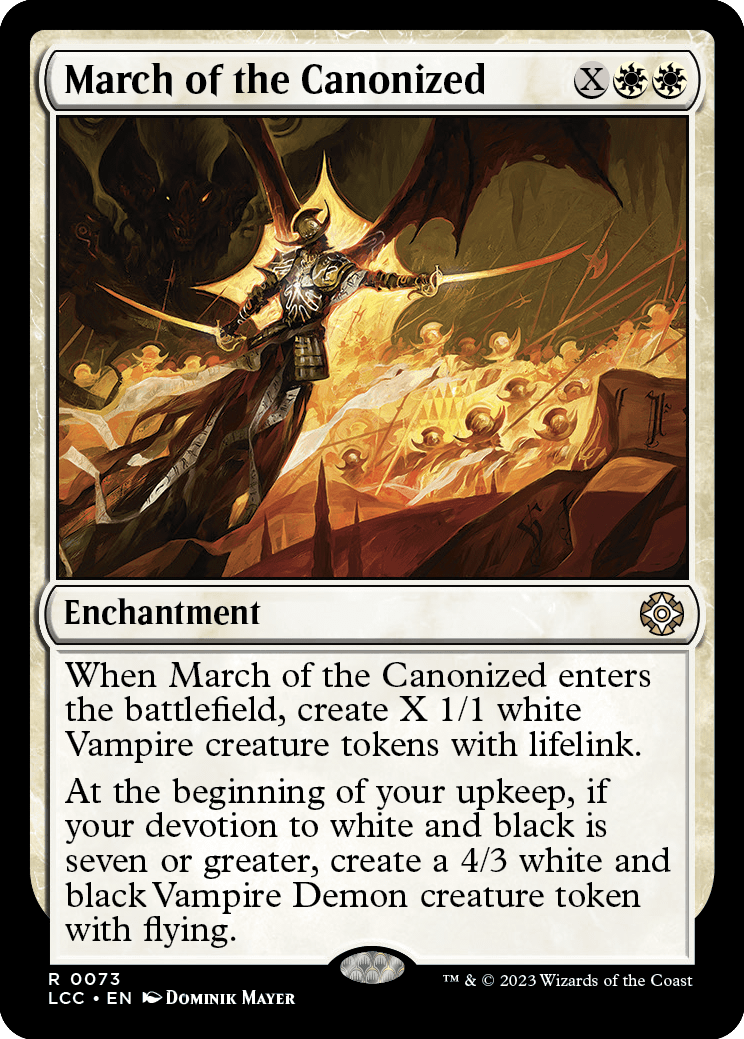
March of the Canonized
Enchantment
When March of the Canonized enters the battlefield, create X 1/1 white Vampire creature tokens with lifelink.
At the beginning of your upkeep, if your devotion to white and black is seven or greater, create a 4/3 white and black Vampire Demon creature token with flying.
- Your devotion to two colors is the number of mana symbols among mana costs of permanents you control that are the first color, the second, or both. If an effect counts your devotion to two colors, a hybrid symbol that is both of those colors is counted just once.
- March of the Canonized's last ability will trigger only if your devotion to white and black is seven or greater at the beginning of your upkeep. As the triggered ability tries to resolve, if your devotion to white and black is no longer at least seven, the ability won't do anything.
- Colorless and generic mana symbols (, , , , , and so on) in mana costs of permanents you control don't count toward your devotion to any color.
- Mana symbols in the text boxes of permanents you control don't count toward your devotion to any color.
- Hybrid mana symbols, monocolored hybrid mana symbols, and Phyrexian mana symbols do count toward your devotion to their color(s).
- If you put an Aura on an opponent's permanent, you still control the Aura, and mana symbols in its mana cost count toward your devotion.
- The back face of a transforming double-faced permanent has no mana cost. Mana symbols on a transforming double-faced permanent's front face don't count toward your devotion to any color while it's on the battlefield with its back face up.
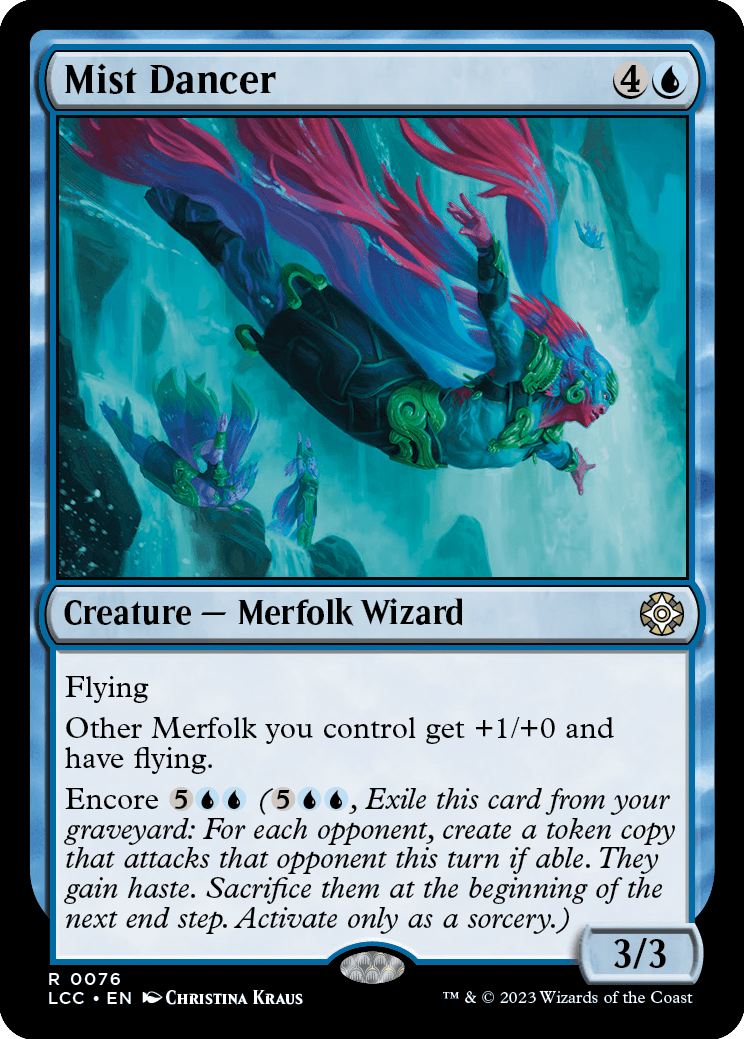
Mist Dancer
Creature — Merfolk Wizard
3/3
Flying
Other Merfolk you control get +1/+0 and have flying.
Encore (, Exile this card from your graveyard: For each opponent, create a token copy that attacks that opponent this turn if able. They gain haste. Sacrifice them at the beginning of the next end step. Activate only as a sorcery.)
- Exiling the card with encore is a cost to activate the ability. Once you announce that you're activating it, no player may take actions until you've finished. They can't try to remove the card from your graveyard to stop you from paying the cost.
- Opponents who have left the game aren't counted when determining how many tokens to create.
- The tokens copy only what's on the original card. Effects that modified that creature when it was previously on the battlefield won't be copied.
- Each token must attack the appropriate player if able.
- If one of the tokens can't attack for any reason (such as being tapped), then it doesn't attack. If there's a cost associated with having it attack, you aren't forced to pay that cost, so it doesn't have to attack in that case either.
- If an effect stops a token from attacking a specific player, that token can attack any player, planeswalker, or battle, or not attack at all. If the effect stops the token from attacking a specific player unless a cost is paid, you don't have to pay that cost unless you want to attack that player.
- If one of the tokens somehow is under another player's control as the delayed triggered ability resolves, you can't sacrifice that token. It remains on the battlefield indefinitely, even if you regain control of it later.
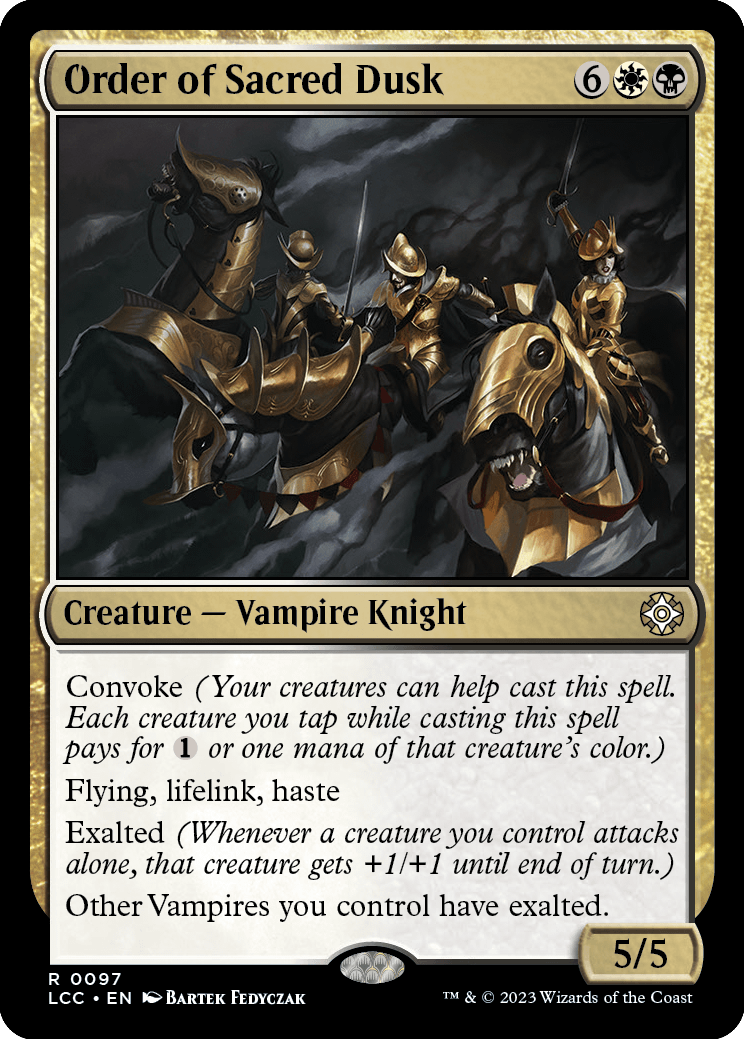
Order of Sacred Dusk
Creature — Vampire Knight
5/5
Convoke (Your creatures can help cast this spell. Each creature you tap while casting this spell pays for or one mana of that creature's color.)
Flying, lifelink, haste
Exalted (Whenever a creature you control attacks alone, that creature gets +1/+1 until end of turn.)
Other Vampires you control have exalted.
- You can tap any untapped creature you control to convoke a spell, even one you haven't controlled continuously since the beginning of your most recent turn.
- When calculating a spell's total cost, include any alternative costs, additional costs, or anything else that increases or reduces the cost to cast the spell. Convoke applies after the total cost is calculated. Convoke doesn't change a spell's mana cost or converted mana cost.
- If a creature you control has a mana ability with in the cost, activating that ability while casting a spell with convoke will result in the creature being tapped before you pay the spell's costs. You won't be able to tap it again for convoke. Similarly, if you sacrifice a creature to activate a mana ability while casting a spell with convoke, that creature won't be on the battlefield when you pay the spell's costs, so you won't be able to tap it for convoke.
- A creature attacks alone if it's the only creature declared as an attacker during the declare attackers step (including creatures controlled by your teammates, if applicable). For example, exalted won't trigger if you attack with multiple creatures and all but one of them are removed from combat.
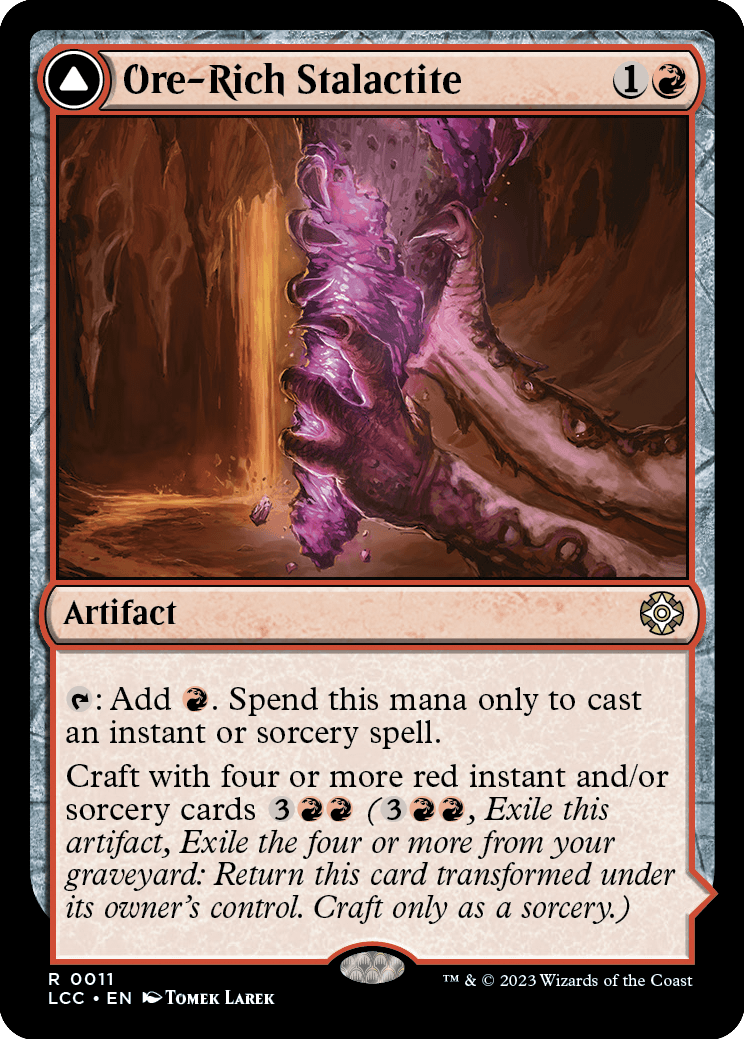
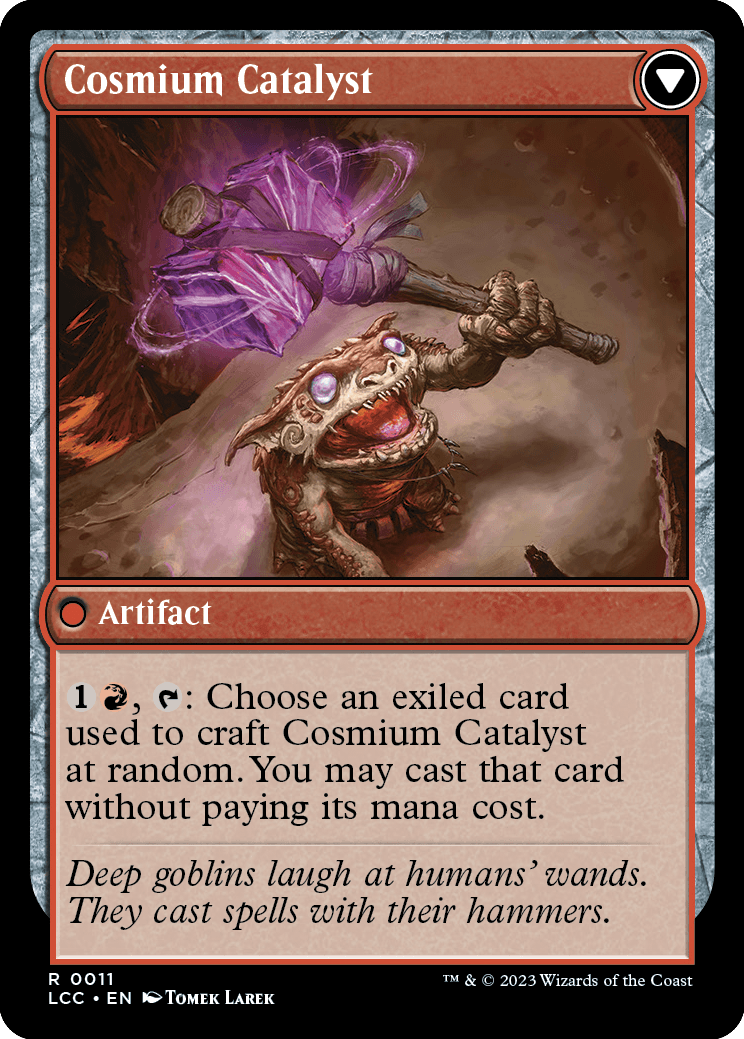
Ore-Rich Stalactite
Artifact
: Add . Spend this mana only to cast an instant or sorcery spell.
Craft with four or more red instant and/or sorcery cards (, Exile this artifact, Exile the four or more from your graveyard: Return this card transformed under its owner's control. Craft only as a sorcery.)
////
Cosmium Catalyst
Artifact
, : Choose an exiled card used to craft Cosmium Catalyst at random. You may cast that card without paying its mana cost.
- You choose whether or not to cast the exiled card as Cosmium Catalyst's activated ability resolves. If you do, you do so as part of the resolution of that ability. You can't wait to cast it later in the turn. Timing restrictions based on the card's type are ignored.
- If you cast a card "without paying its mana cost," you can't pay any alternative costs. You can, however, pay additional costs. If the card has any mandatory additional costs, those must be paid to cast the card.
- If the card has in its mana cost, you must choose 0 as the value of X when casting it without paying its mana cost.
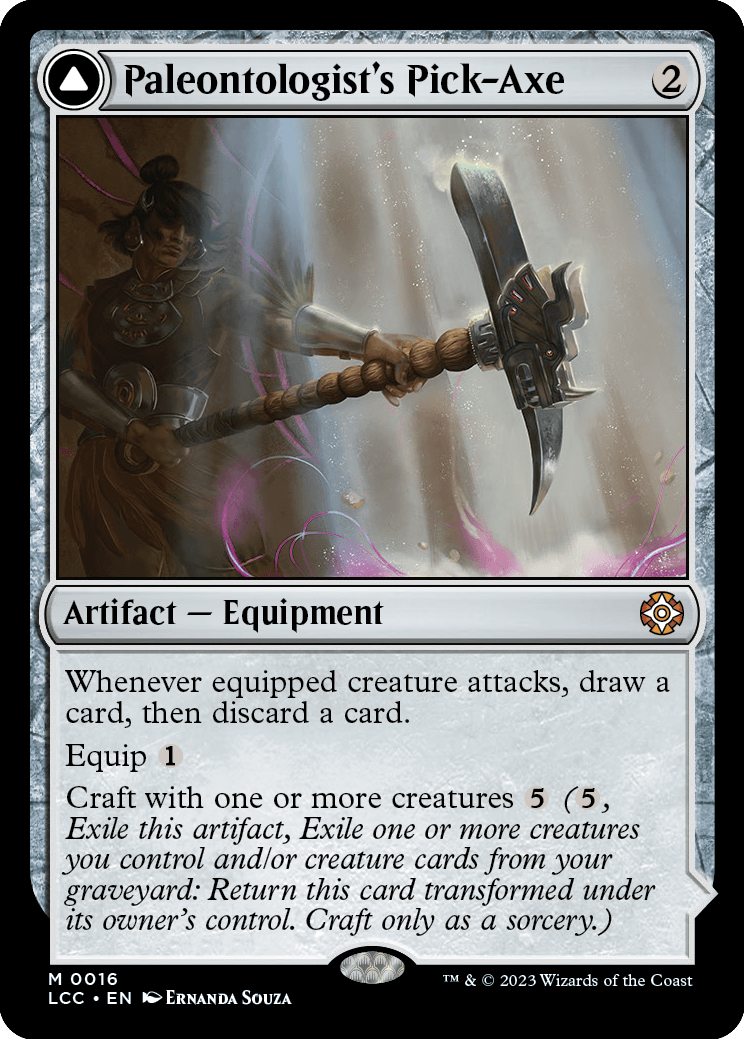
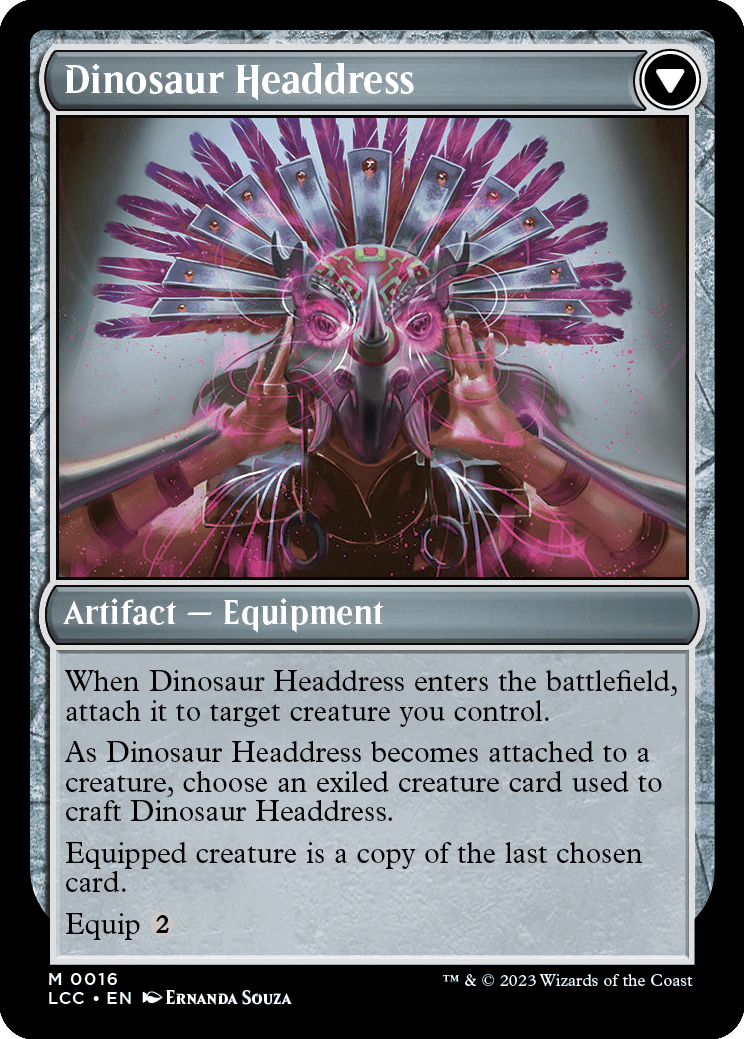
Paleontologist's Pick-Axe
Artifact — Equipment
Whenever equipped creature attacks, draw a card, then discard a card.
Equip
Craft with one or more creatures (, Exile this artifact, Exile one or more creatures you control and/or creature cards from your graveyard: Return this card transformed under its owner's control. Craft only as a sorcery.)
////
Dinosaur Headdress
Artifact — Equipment
When Dinosaur Headdress enters the battlefield, attach it to target creature you control.
As Dinosaur Headdress becomes attached to a creature, choose an exiled creature card used to craft Dinosaur Headdress.
Equipped creature is a copy of the last chosen card.
Equip
- Each time Dinosaur Headdress becomes attached to a creature, you choose one of the exiled creature cards used to craft it. You may choose the same card you chose the last time you had to choose.
- The equipped creature copies exactly what's printed on the exiled card and nothing else. It doesn't copy any information about the object the card was before it was put into exile.
- If the chosen card has in its mana cost, X is 0.
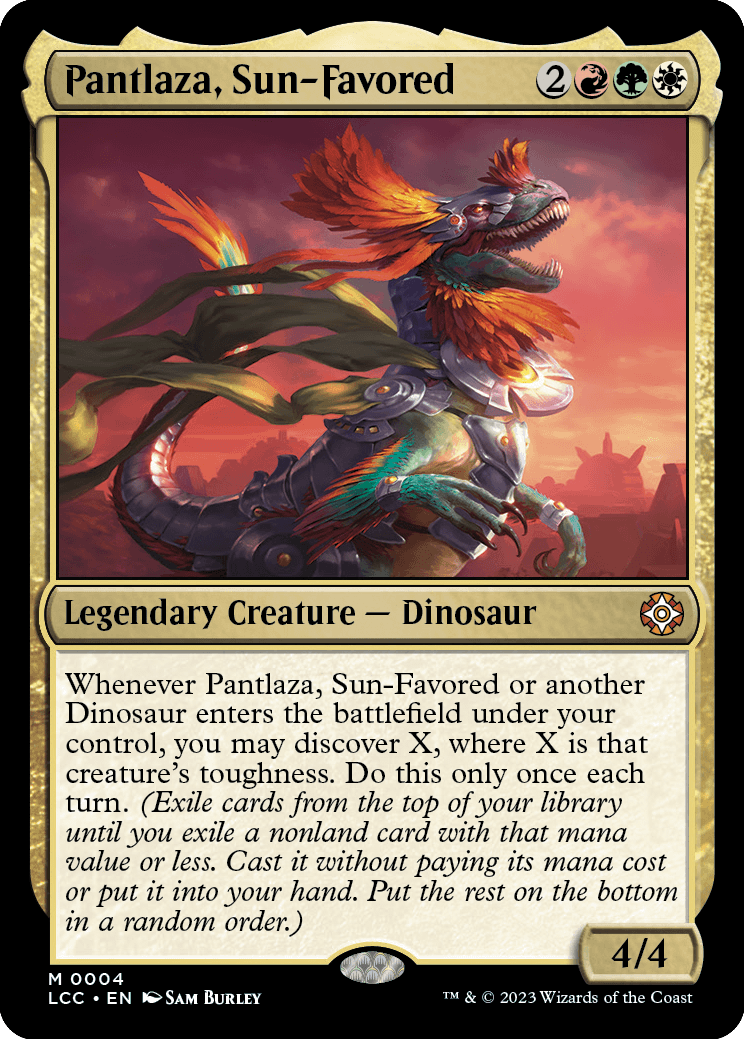
Pantlaza, Sun-Favored
Legendary Creature — Dinosaur
4/4
Whenever Pantlaza, Sun-Favored or another Dinosaur enters the battlefield under your control, you may discover X, where X is that creature's toughness. Do this only once each turn. (Exile cards from the top of your library until you exile a nonland card with that mana value or less. Cast it without paying its mana cost or put it into your hand. Put the rest on the bottom in a random order.)
- The value of X is calculated only once, as the ability resolves. If the creature has left the battlefield, use its toughness as it last existed on the battlefield.
- Once you decide to discover using Pantlaza's ability, that ability will stop triggering for the duration of that turn.
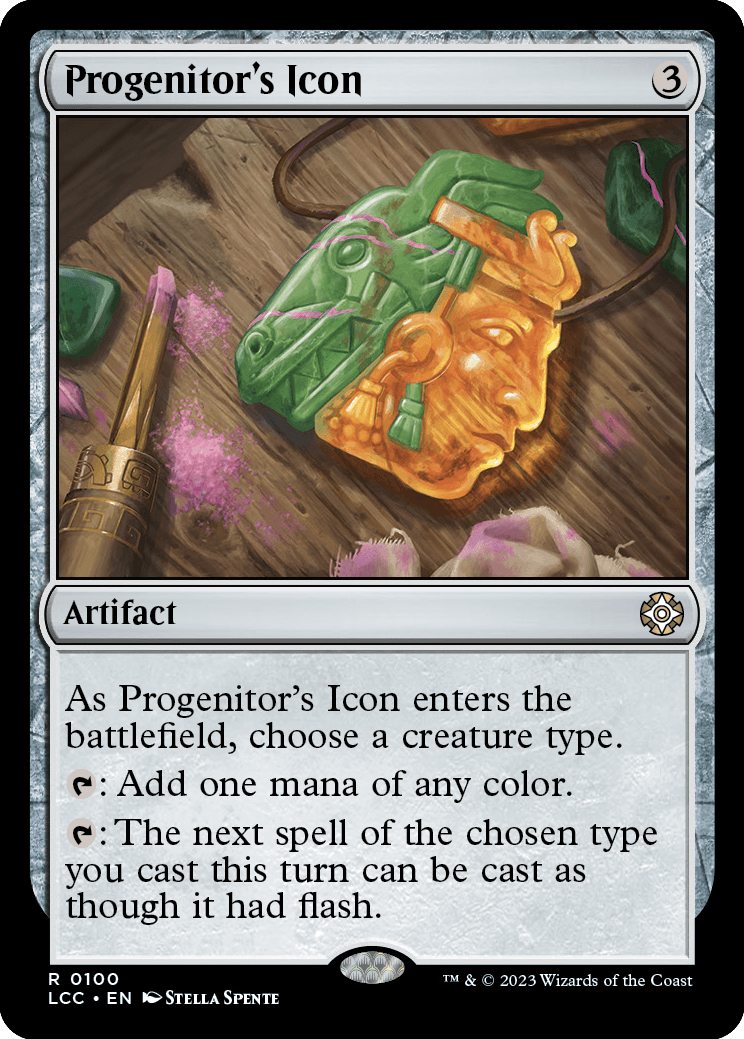
Progenitor's Icon
Artifact
As Progenitor's Icon enters the battlefield, choose a creature type.
: Add one mana of any color.
: The next spell of the chosen type you cast this turn can be cast as though it had flash.
- If Progenitor's Icon is somehow on the battlefield without a chosen type, its last ability won't do anything.
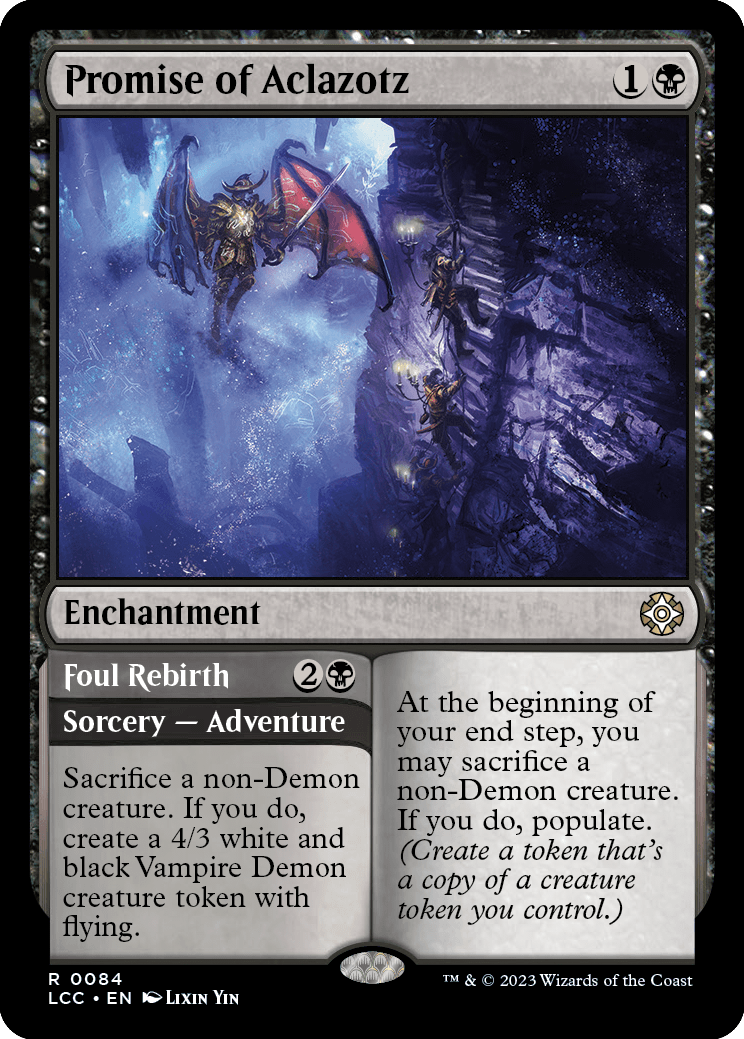
Promise of Aclazotz
Enchantment
At the beginning of your end step, you may sacrifice a non-Demon creature. If you do, populate. (Create a token that's a copy of a creature token you control.)
//ADV//
Foul Rebirth
Sorcery — Adventure
Sacrifice a non-Demon creature. If you do, create a 4/3 white and black Vampire Demon creature token with flying.
- If you control no creature tokens when you populate, nothing will happen.
- The new creature token copies the characteristics of the original token as stated by the effect that created the original token.
- The new token doesn't copy whether the original token is tapped or untapped, whether it has any counters on it or Auras and Equipment attached to it, or any non-copy effects that have changed its power, toughness, color, and so on.
- Any "as [this creature] enters the battlefield" or "[this creature] enters the battlefield with" abilities of the new token will work.
- An adventurer card is a permanent card in every zone except the stack, as well as while on the stack if not cast as an Adventure. Ignore its alternative characteristics in those cases. For example, while it's in your graveyard, Promise of Aclazotz is a black enchantment card whose mana value is 2. While there, it can't be the target of a spell or ability that targets only instant or sorcery cards.
- When casting a spell as an Adventure, use the alternative characteristics and ignore all of the card's normal characteristics. The spell's color, mana cost, mana value, and so on are determined by only those alternative characteristics. If the spell leaves the stack, it immediately resumes using its normal characteristics.
- If you cast an adventurer card as an Adventure, use only its alternative characteristics to determine whether it's legal to cast that spell. For example, if you control Johann, Apprentice Sorcerer ("Once each turn, you may cast an instant or sorcery spell from the top of your library") and Promise of Aclazotz is on top of your library, you can cast Foul Rebirth, but not Promise of Aclazotz.
- If a spell is cast as an Adventure, its controller exiles it instead of putting it into its owner's graveyard as it resolves. For as long as it remains exiled, that player may cast it as a permanent spell. If an Adventure spell leaves the stack in any way other than resolving (most likely by being countered or by failing to resolve because its targets have all become illegal), that card won't be exiled and the spell's controller won't be able to cast it as a permanent later.
- If an adventurer card ends up in exile for any other reason than by exiling itself while resolving, it won't give you permission to cast it as a permanent spell.
- You must still follow any timing restrictions and permissions for the permanent spell you cast from exile. Normally, you'll be able to cast it only during your main phase while the stack is empty.
- If an effect copies an Adventure spell, that copy is exiled as it resolves. It ceases to exist as a state-based action; it's not possible to cast the copy as a permanent.
- An effect may refer to a card, spell, or permanent that "has an Adventure." This refers to a card, spell, or permanent that has an adventurer card's set of alternative characteristics, even if they're not being used and even if that card was never cast as an Adventure.
- If an effect refers to a card, spell, or permanent that has an Adventure, it won't find an instant or sorcery spell on the stack that's been cast as an Adventure.
- If an object becomes a copy of an object that has an Adventure, the copy also has an Adventure. If it changes zones, it will either cease to exist (if it's a token) or cease to be a copy (if it's a nontoken permanent), and so you won't be able to cast it as an Adventure.
- If an effect instructs you to choose a card name, you may choose the alternative Adventure name. Consider only the alternative characteristics to determine whether that is an appropriate name to choose.
- Casting a card as an Adventure isn't casting it for an alternative cost. Effects that allow you to cast a spell for an alternative cost or without paying its mana cost may allow you to apply those to the Adventure.
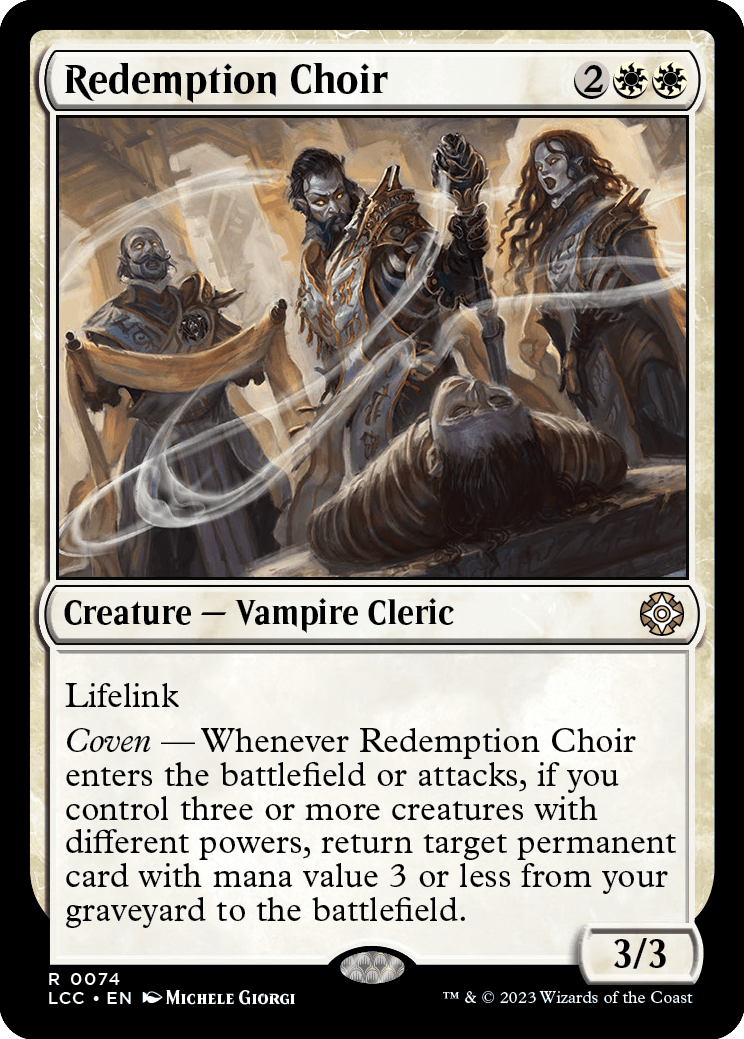
Redemption Choir
Creature — Vampire Cleric
3/3
Lifelink
Coven — Whenever Redemption Choir enters the battlefield or attacks, if you control three or more creatures with different powers, return target permanent card with mana value 3 or less from your graveyard to the battlefield.
- For three creatures to have different powers from one another, each of their powers needs to be different. A 1/1 creature, a 2/1 creature, and another 2/1 creature aren't three creatures with different powers, even though both 2/1 creatures have different power than the 1/1 creature.
- You must control three or more creatures with different powers at the time the coven ability triggers and at the time the ability tries to resolve. They do not, however, need to be the same set of creatures in both cases.
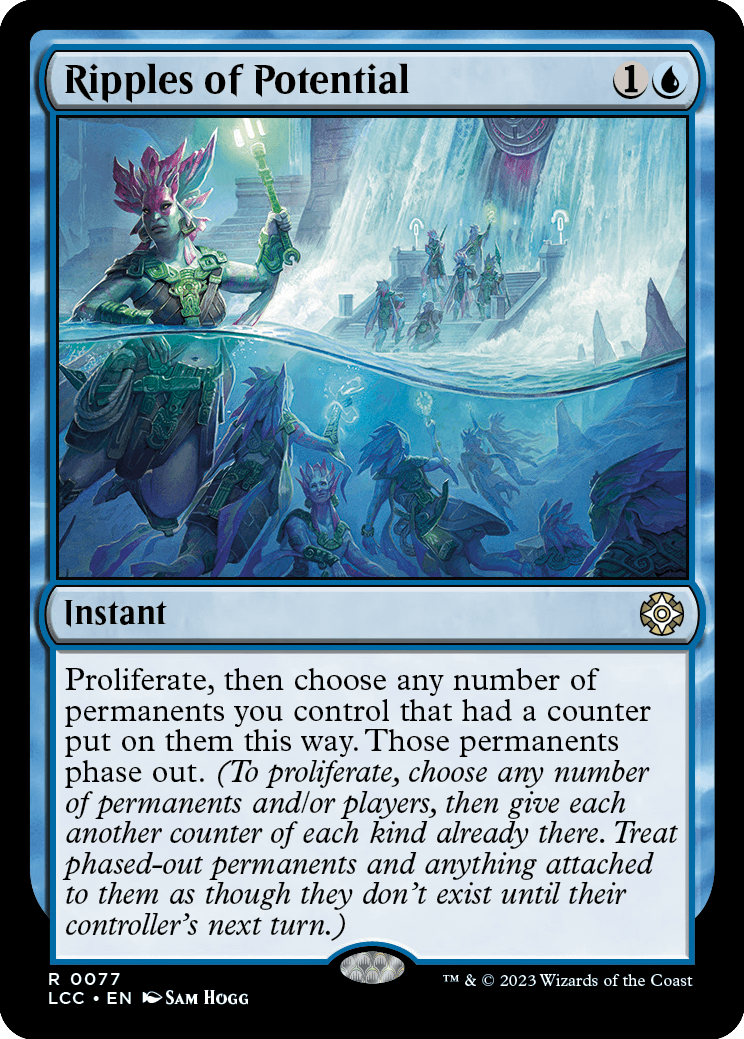
Ripples of Potential
Instant
Proliferate, then choose any number of permanents you control that had a counter put on them this way. Those permanents phase out. (To proliferate, choose any number of permanents and/or players, then give each another counter of each kind already there. Treat phased-out permanents and anything attached to them as though they don't exist until their controller's next turn.)
- To proliferate, you can choose any permanent that has a counter, including ones controlled by opponents. You can choose any player who has a counter, including opponents. You can't choose cards in any zone other than the battlefield, even if they have counters on them.
- You don't have to choose every permanent or player that has a counter, only the ones you want to add another counter to. Since "any number" includes zero, you don't have to choose any permanents at all, and you don't have to choose any players at all.
- If a player or permanent has more than one kind of counter on it, and you choose for it to get additional counters, it must get one of each kind of counter it already has. You can't have it get just one kind of counter it already has and not the others.
- An ability that triggers "Whenever you proliferate" triggers even if you chose no permanents or players while doing so.
- Players can respond to a spell or ability whose effect includes proliferating. Once that spell or ability starts to resolve, however, and its controller chooses which permanents and players will get new counters, it's too late for anyone to respond.
- Phased-out permanents are treated as though they don't exist. They can't be the target of spells or abilities, their static abilities have no effect on the game, their triggered abilities can't trigger, they can't attack or block, and so on.
- A phased-out token will phase in at the beginning of its controller's untap step just like a nontoken permanent would.
- As a creature is phased out, Auras and Equipment attached to it also phase out at the same time. Those Auras and Equipment will phase in at the same time that creature does, and they'll phase in still attached to that creature.
- Permanents phase back in during their controller's untap step, immediately before that player untaps their permanents. Creatures that phase in this way are able to attack and pay a cost of during that turn. If a permanent had counters on it when it phased out, it will have those counters when it phases back in.
- An attacking or blocking creature that phases out is removed from combat.
- Phasing out doesn't cause any "leaves the battlefield" abilities to trigger. Similarly, phasing in won't cause any "enters the battlefield" abilities to trigger.
- Any continuous effects with a "for as long as" duration ignore phased-out objects. If ignoring those objects causes the effect's conditions to no longer be met, the duration will expire.
- Choices made for permanents as they entered the battlefield are remembered even after they phase in.
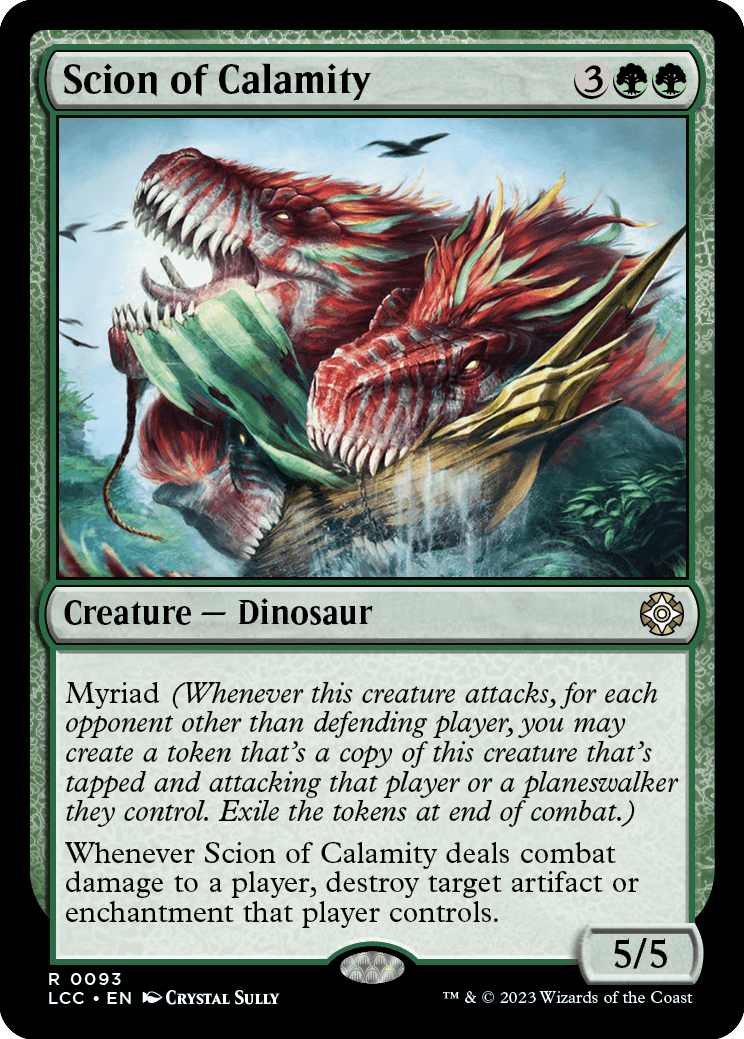
Scion of Calamity
Creature — Dinosaur
5/5
Myriad (Whenever this creature attacks, for each opponent other than defending player, you may create a token that's a copy of this creature that's tapped and attacking that player or a planeswalker they control. Exile the tokens at end of combat.)
Whenever Scion of Calamity deals combat damage to a player, destroy target artifact or enchantment that player controls.
- The term "defending player" in the myriad rules (or any other ability of an attacking creature) refers to the player the creature with myriad was attacking, the controller of the planeswalker it was attacking, or the protector of the battle it was attacking at the time the ability resolves. If that creature is no longer attacking, it refers to the appropriate player based on who or what the creature was last attacking.
- If the defending player is your only opponent, no tokens are put onto the battlefield.
- You choose whether each token is attacking the player or a planeswalker they control as the token is created. If it's attacking a planeswalker, you choose which one. You can't have any of the tokens attack a battle.
- Although the tokens enter the battlefield attacking, they were never declared as attackers. Abilities that trigger whenever a creature attacks won't trigger, including the myriad ability of the tokens. If there are any costs to have a creature attack, those costs won't apply to the tokens.
- The tokens all enter the battlefield at the same time.
- Each token copies exactly what was printed on the original creature and nothing else. It doesn't copy whether that creature is tapped or untapped, whether it has any counters on it or Auras and Equipment attached to it, or any non-copy effects that have changed its power, toughness, types, color, and so on.
- Any enters-the-battlefield abilities of the copied creature will trigger when the tokens enter the battlefield. Any "as [this permanent] enters the battlefield" or "[this permanent] enters the battlefield with" abilities of the copied creature will also work.
- If myriad creates more than one token for any given player (due to an effect such as the one Doubling Season creates), you may choose separately for each token whether it's attacking the player or a planeswalker they control.
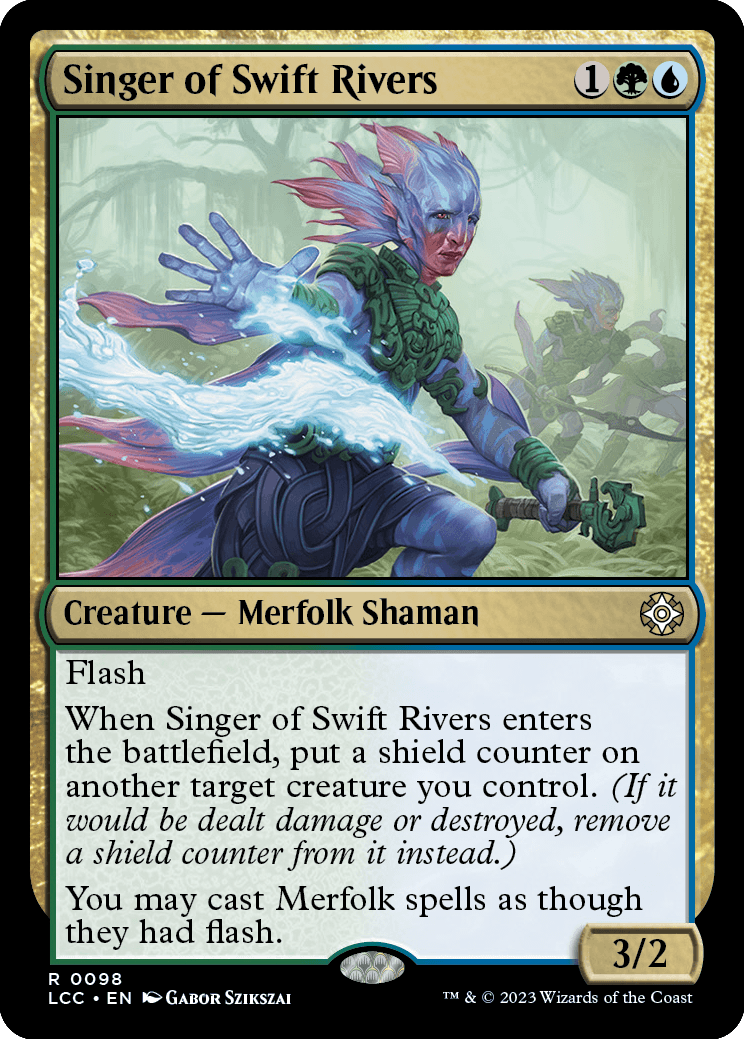
Singer of Swift Rivers
Creature — Merfolk Shaman
3/2
Flash
When Singer of Swift Rivers enters the battlefield, put a shield counter on another target creature you control. (If it would be dealt damage or destroyed, remove a shield counter from it instead.)
You may cast Merfolk spells as though they had flash.
- Shield counters don't prevent players from sacrificing creatures.
- Removing a shield counter in this way isn't the same as regenerating a creature.
- If a permanent that would be dealt damage has more than one shield counter on it, that damage is prevented and only one shield counter is removed.
- If a permanent with a shield counter is dealt unpreventable damage, that damage will be dealt and a shield counter will still be removed.
- A creature with a shield counter on it may still be destroyed by state-based actions if it has damage marked on it equal to its toughness or has been dealt unpreventable damage by a source with deathtouch.
- "Shield" is not an ability that creatures have and shield counters are not keyword counters. If a creature with a shield counter loses its abilities, the shield counter will still protect it as normal.
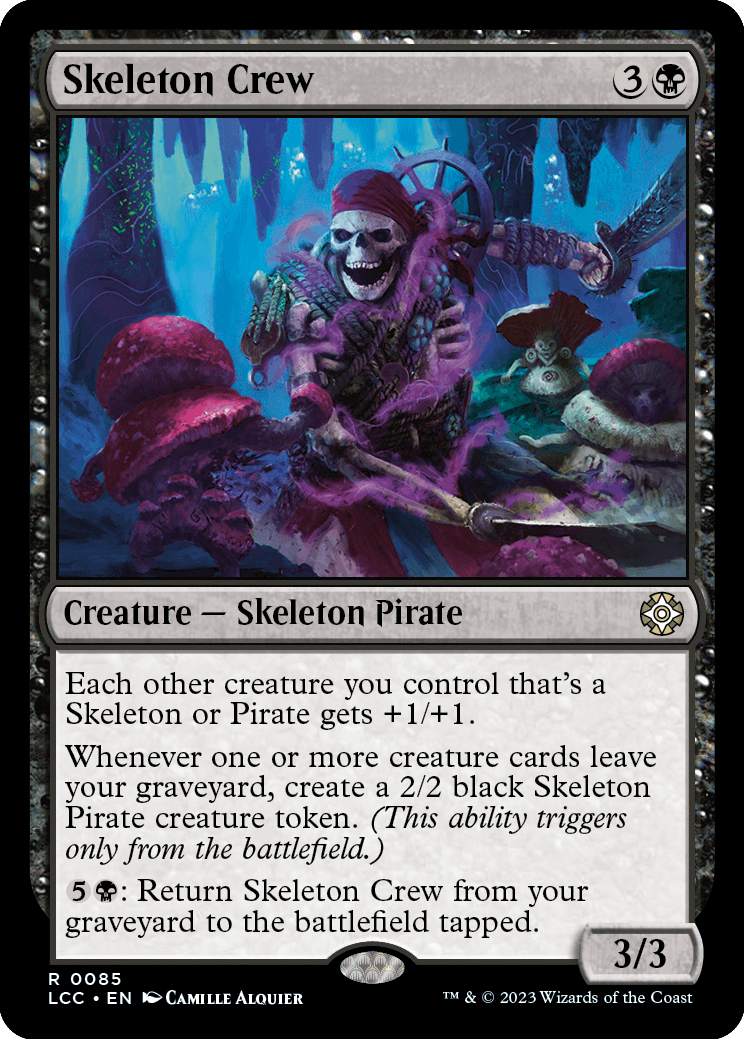
Skeleton Crew
Creature — Skeleton Pirate
3/3
Each other creature you control that's a Skeleton or Pirate gets +1/+1.
Whenever one or more creature cards leave your graveyard, create a 2/2 black Skeleton Pirate creature token. (This ability triggers only from the battlefield.)
: Return Skeleton Crew from your graveyard to the battlefield tapped.
- If two or more creature cards leave your graveyard as a single event, Skeleton Crew's second ability will trigger once. If they leave your graveyard as separate events, it will trigger once for each event.
- Resolving Skeleton Crew's last ability won't cause its second ability to trigger.
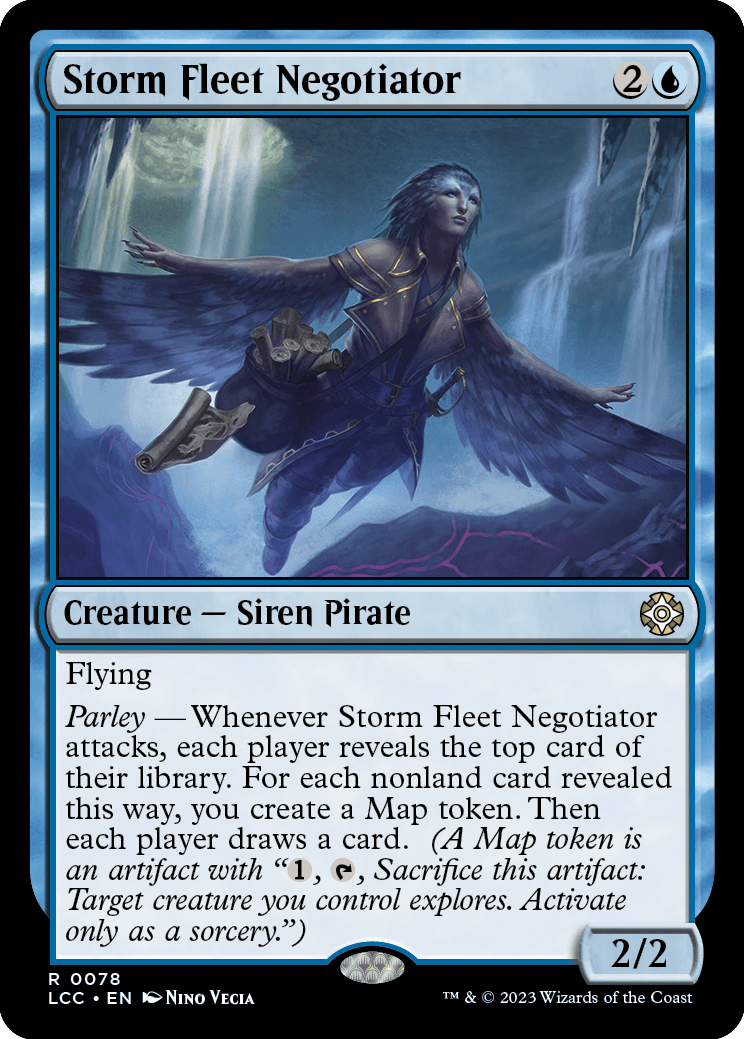
Storm Fleet Negotiator
Creature — Siren Pirate
2/2
Flying
Parley — Whenever Storm Fleet Negotiator attacks, each player reveals the top card of their library. For each nonland card revealed this way, you create a Map token. Then each player draws a card. (A Map token is an artifact with ", , Sacrifice this artifact: Target creature you control explores. Activate only as a sorcery.")
- Except in some very unusual cases, the card each player reveals is the one they'll draw.
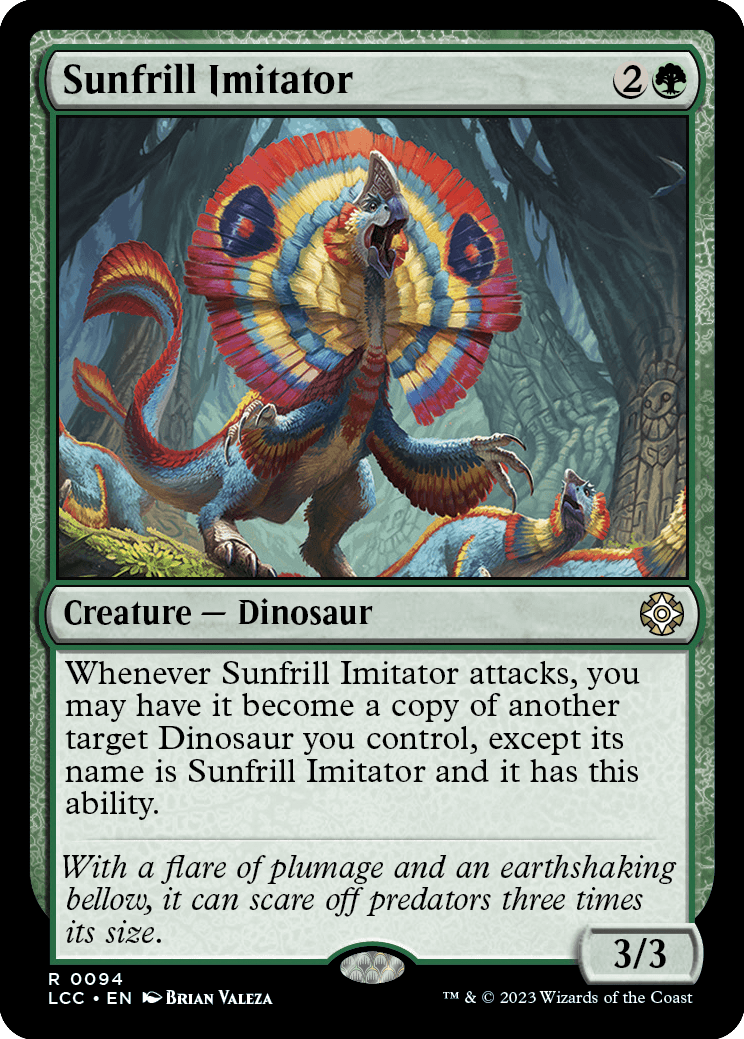
Sunfrill Imitator
Creature — Dinosaur
3/3
Whenever Sunfrill Imitator attacks, you may have it become a copy of another target Dinosaur you control, except its name is Sunfrill Imitator and it has this ability.
- Sunfrill Imitator copies exactly what was printed on the original creature, with the listed exceptions (unless that creature is copying something else or is a token; see below). It doesn't copy whether that creature is tapped or untapped, whether it has any counters on it or any Auras or Equipment attached to it, or any non-copy effects that have changed its types, color, power and toughness, and so on.
- if Sunfrill Imitator copies a legendary creature, Sunfrill Imitator will also be legendary, but because its name remains Sunfrill Imitator, the "legend rule" won't cause either of them to be put into the graveyard.
- If the copied creature has in its mana cost, X is 0.
- If the copied creature is copying something else, then Sunfrill Imitator becomes a copy of whatever that creature is copying.
- If the copied creature is a token, Sunfrill Imitator copies the original characteristics of that token as stated by the effect that created the token. Copying a token doesn't make Sunfrill Imitator a token. Similarly, if Sunfrill Imitator itself is a token, copying a nontoken permanent doesn't make it stop being a token.
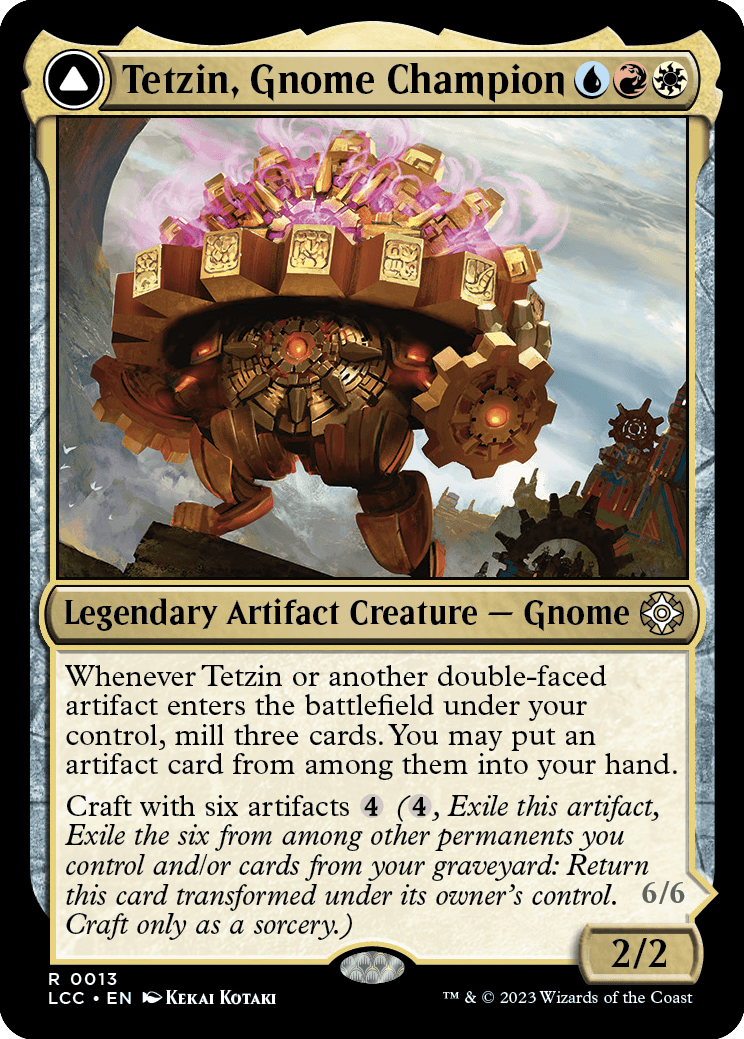
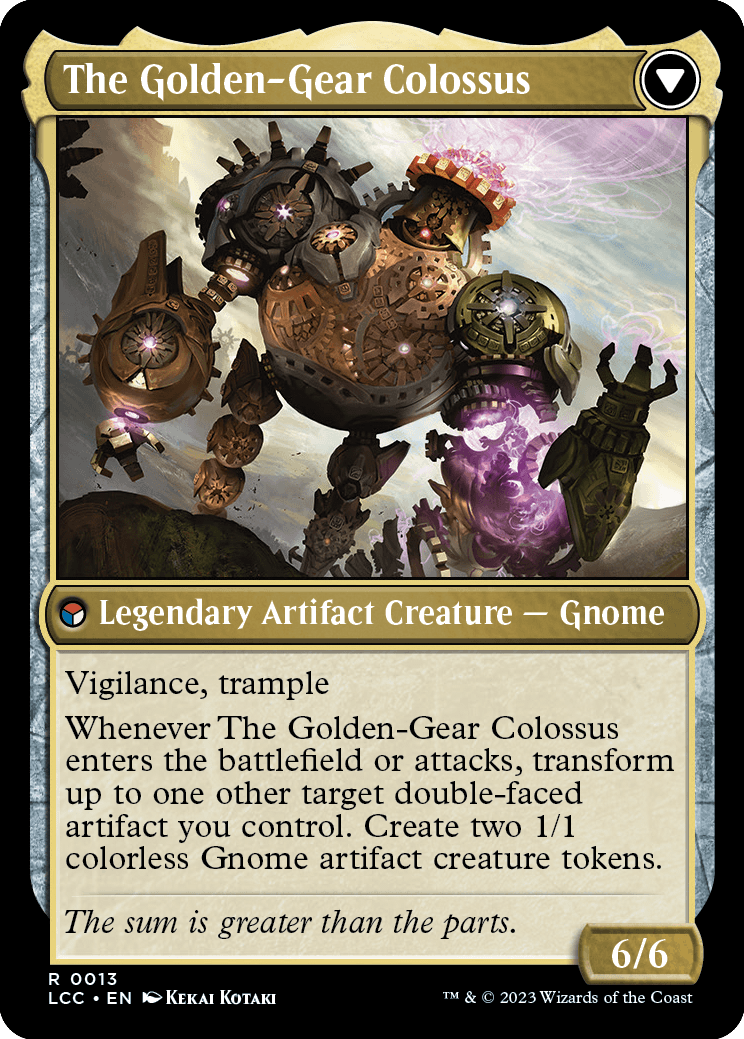
Tetzin, Gnome Champion
Legendary Artifact Creature — Gnome
2/2
Whenever Tetzin or another double-faced artifact enters the battlefield under your control, mill three cards. You may put an artifact card from among them into your hand.
Craft with six artifacts (, Exile this artifact, Exile the six from among other permanents you control and/or cards from your graveyard: Return this card transformed under its owner's control. Craft only as a sorcery.)
////
The Golden-Gear Colossus
Legendary Artifact Creature — Gnome
6/6
Vigilance, trample
Whenever The Golden-Gear Colossus enters the battlefield or attacks, transform up to one other target double-faced artifact you control. Create two 1/1 colorless Gnome artifact creature tokens.
- You can target any double-faced artifact you control with The Golden-Gear Colossus's triggered ability, but only transforming double-faced cards and transforming tokens can transform. Choosing an artifact represented by a modal double-faced card (Pestilent Cauldron from Strixhaven, for example) won't cause that permanent to transform.
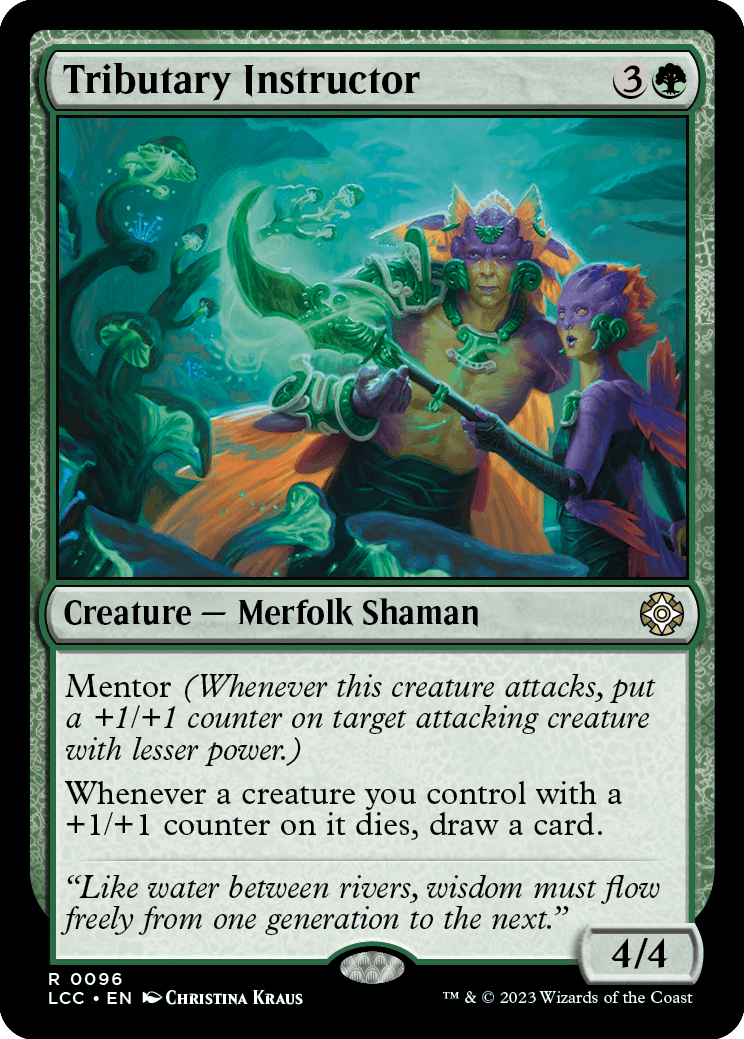
Tributary Instructor
Creature — Merfolk Shaman
4/4
Mentor (Whenever this creature attacks, put a +1/+1 counter on target attacking creature with lesser power.)
Whenever a creature you control with a +1/+1 counter on it dies, draw a card.
- Mentor compares the power of the creature with mentor with that of the target creature at two different times: once as the triggered ability is put onto the stack, and once as the triggered ability resolves. If you wish to raise a creature's power so its mentor ability can target a bigger creature, the last chance you have to do so is during the beginning of combat step.
- If the target creature's power is no longer less than the attacking creature's power as the ability resolves, mentor doesn't add a +1/+1 counter. For example, if two 3/3 creatures with mentor attack and both mentor triggers target the same 2/2 creature, the first to resolve puts a +1/+1 counter on it and the second does nothing.
- If the creature with mentor leaves the battlefield with mentor on the stack, use its power as that creature last existed on the battlefield to determine whether the target creature has less power.
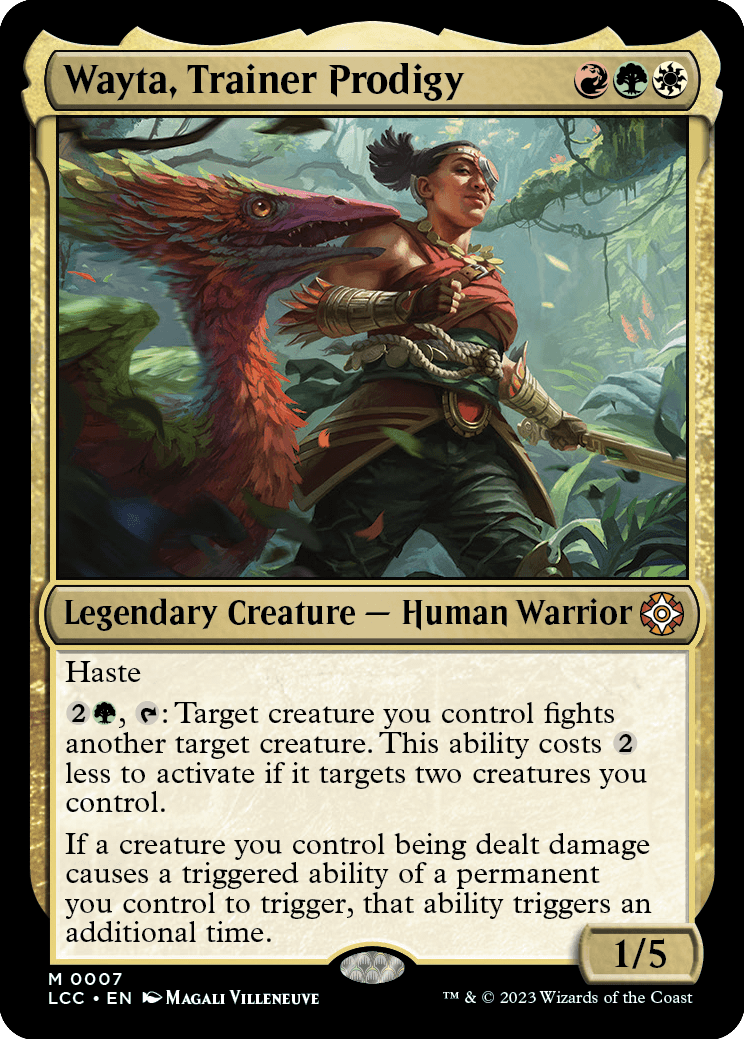
Wayta, Trainer Prodigy
Legendary Creature — Human Warrior
1/5
Haste
, : Target creature you control fights another target creature. This ability costs less to activate if it targets two creatures you control.
If a creature you control being dealt damage causes a triggered ability of a permanent you control to trigger, that ability triggers an additional time.
- Wayta, Trainer Prodigy's last ability affects only triggered abilities whose trigger conditions refer specifically to damage being dealt, such as the ability granted by Mephidross Vampire or the last ability of Wrathful Raptors. It does not affect triggered abilities that would trigger because of the results of that damage. For example, if you control an Ajani's Pridemate ("Whenever you gain life, put a +1/+1 counter on Ajani's Pridemate") and you activate Wayta, Trainer Prodigy's second ability targeting a creature you control with lifelink and another creature you control, the triggered ability of Ajani's Pridemate will still trigger only once.
- Wayta, Trainer Prodigy's last ability doesn't copy the triggered ability; it just causes the ability to trigger twice. Any choices made as you put the ability onto the stack, such as modes and targets, are made separately for each instance of the ability. Any choices made on resolution, such as whether to put counters on a permanent, are also made individually.
- If you somehow control two copies of Wayta, Trainer Prodigy, a creature you control being dealt damage causes abilities to trigger three times, not four. A third Wayta, Trainer Prodigy causes abilities to trigger four times, a fourth causes abilities to trigger five times, and so on.

Wrathful Raptors
Creature — Dinosaur
5/5
Trample
Whenever a Dinosaur you control is dealt damage, it deals that much damage to any target that isn't a Dinosaur.
- "Any target that isn't a Dinosaur" means any non-Dinosaur creature, any planeswalker or battle, or any player (no matter how old they are).
- If multiple sources deal damage to a Dinosaur you control while you control Wrathful Raptors, most likely because multiple creatures blocked that Dinosaur, Wrathful Raptors's last ability triggers only once.
- If lethal damage is dealt to a Dinosaur you control while you control Wrathful Raptors, Wrathful Raptors's last ability still triggers.
- If Wrathful Raptors and one or more other Dinosaurs you control are dealt damage at the same time, Wrathful Raptors's ability triggers for itself and for each of those Dinosaurs, regardless of whether or not Wrathful Raptors was dealt lethal damage.
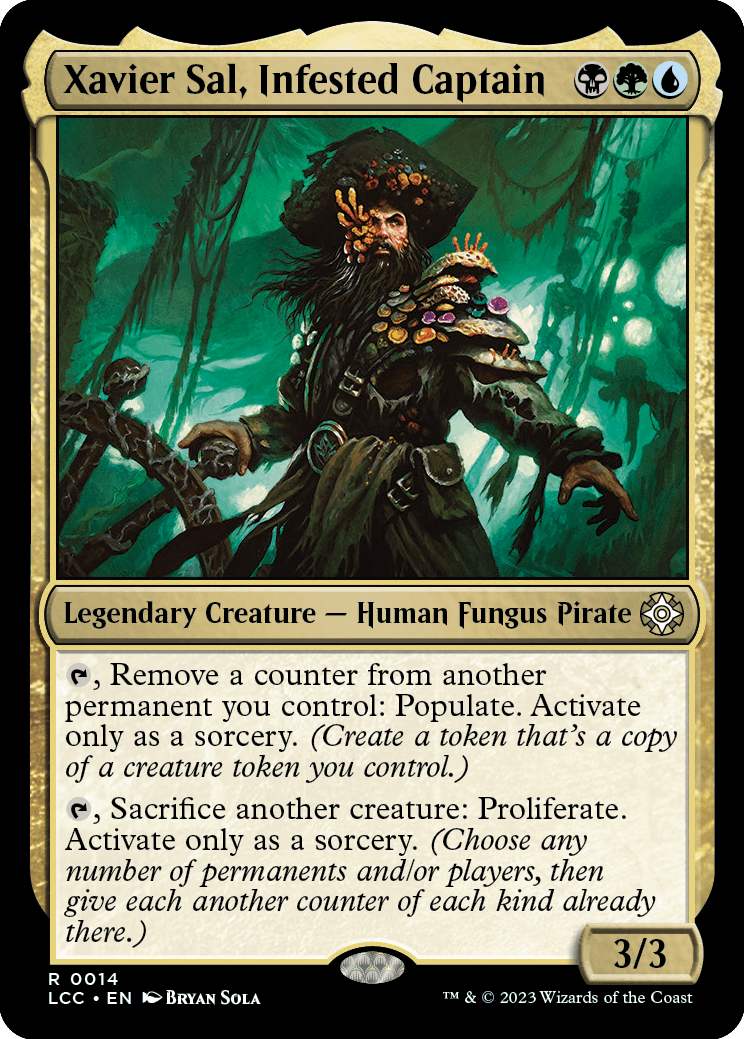
Xavier Sal, Infested Captain
Legendary Creature — Human Fungus Pirate
3/3
, Remove a counter from another permanent you control: Populate. Activate only as a sorcery. (Create a token that's a copy of a creature token you control.)
, Sacrifice another creature: Proliferate. Activate only as a sorcery. (Choose any number of permanents and/or players, then give each another counter of each kind already there.)
- If you control no creature tokens when you populate, nothing will happen.
- The new creature token copies the characteristics of the original token as stated by the effect that created the original token.
- The new token doesn't copy whether the original token is tapped or untapped, whether it has any counters on it or Auras and Equipment attached to it, or any non-copy effects that have changed its power, toughness, color, and so on.
- Any "as [this creature] enters the battlefield" or "[this creature] enters the battlefield with" abilities of the new token will work.
- To proliferate, you can choose any permanent that has a counter, including ones controlled by opponents. You can choose any player who has a counter, including opponents. You can't choose cards in any zone other than the battlefield, even if they have counters on them.
- You don't have to choose every permanent or player that has a counter, only the ones you want to add another counter to. Since "any number" includes zero, you don't have to choose any permanents at all, and you don't have to choose any players at all.
- If a player or permanent has more than one kind of counter on it, and you choose for it to get additional counters, it must get one of each kind of counter it already has. You can't have it get just one kind of counter it already has and not the others.
- An ability that triggers "Whenever you proliferate" triggers even if you chose no permanents or players while doing so.
- Players can respond to a spell or ability whose effect includes proliferating. Once that spell or ability starts to resolve, however, and its controller chooses which permanents and players will get new counters, it's too late for anyone to respond.
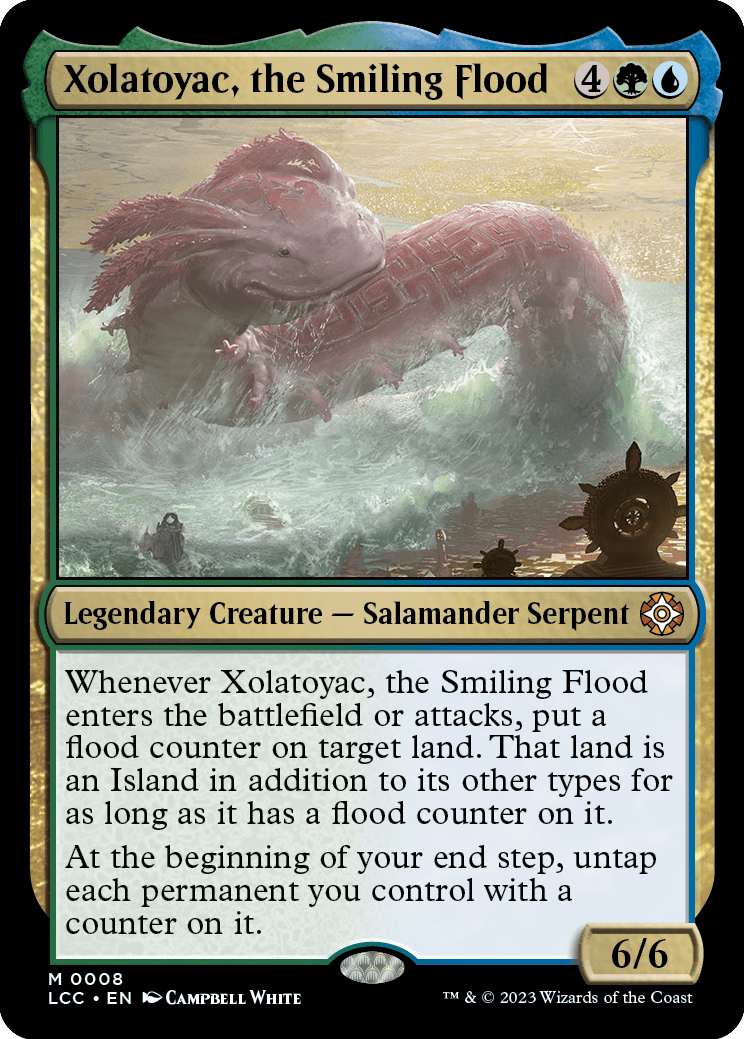
Xolatoyac, the Smiling Flood
Legendary Creature — Salamander Serpent
6/6
Whenever Xolatoyac, the Smiling Flood enters the battlefield or attacks, put a flood counter on target land. That land is an Island in addition to its other types for as long as it has a flood counter on it.
At the beginning of your end step, untap each permanent you control with a counter on it.
- The land stays an Island until the flood counter is removed, even if Xolatoyac, the Smiling Flood leaves the battlefield.
- The land retains any land types and abilities it already had. An Island has the ability ": Add ."
©2023 Wizards of the Coast LLC Wizards of the Coast, Magic: The Gathering, their logos, Magic, and the WUBRGCT symbols are property of Wizards in the USA and other countries. U.S. Pat. No. RE 37,957.
© Universal City Studios LLC and Amblin Entertainment, Inc. All Rights Reserved.














































































































































































































































































